長話短說 ---- 在本文中,您將了解如何建立 Vercel 的 V0.dev 的克隆。這是一個很棒的專案,可以加入到您的投資組合中並磨練您的人工智慧能力。 我們將介紹使用: - 用於應用程式框架的 Next.js 🖥️ - 法學碩士 OpenAI 🧠 - v0 👾 的應用程式邏輯 - 使用 CopilotKit 將 AI 整合到您的應用程式中 🪁  --- CopilotKit:應用內人工智慧的作業系統框架 ========================= CopilotKit 是[開源人工智慧副駕駛平台。](https://github.com/CopilotKit/CopilotKit)我們可以輕鬆地將強大的人工智慧整合到您的 React 應用程式中。 建造: - ChatBot:上下文感知的應用內聊天機器人,可以在應用程式內執行操作 💬 - CopilotTextArea:人工智慧驅動的文字字段,具有上下文感知自動完成和插入功能📝 - 聯合代理:應用程式內人工智慧代理,可以與您的應用程式和使用者互動🤖  {% cta https://github.com/CopilotKit/CopilotKit %} Star CopilotKit ⭐️ {% endcta %} (原諒人工智慧的拼字錯誤並給一顆星:) 現在回到文章。 --- 先決條件 ---- 要開始學習本教程,您需要具備以下條件: - 文字編輯器(VS Code、遊標) - React、Next.js、Typescript 和 Tailwind CSS 的基本知識。 - Node.js 安裝在您的 PC/Mac 上 - 套件管理器 (npm) - [OpenAI](https://platform.openai.com/docs/overview) API 金鑰 - [CopilotKit](https://docs.copilotkit.ai/getting-started/quickstart-textarea)安裝在您的 React 專案中 v0是什麼? ------ **v0**是[Vercel 開發的](https://vercel.com/blog/announcing-v0-generative-ui)生成式使用者介面 (UI) 工具,允許使用者給予提示並描述他們的想法,然後將其轉換為用於建立 Web 介面的 UI 程式碼。它利用[生成式 AI](https://medium.com/data-science-at-microsoft/generative-ai-openai-and-chatgpt-what-are-they-3c80397062c4)以及[React](https://developer.mozilla.org/en-US/docs/Learn/Tools_and_testing/Client-side_JavaScript_frameworks/React_getting_started) 、 [Tailwind CSS](https://tailwindcss.com/)和[Shadcn UI](https://ui.shadcn.com/)等開源工具,根據使用者提供的描述產生程式碼。 *這是使用 v0 產生的 Web 應用程式 UI 的範例* https://v0.dev/t/nxGnMd1uVGc 了解專案要求 ------ 在本逐步教程結束時,克隆將具有以下專案要求: 1. **使用者輸入:**使用者輸入文字作為提示,描述他們想要產生的 UI。這將使用 CopilotKit 聊天機器人來完成,該聊天機器人由[CopilotSidebar](https://docs.copilotkit.ai/reference/CopilotSidebar)提供。 2. **CopilotKit 整合:** CopilotKit 將用於為 Web 應用程式提供 AI 功能以產生 UI。 3. **渲染 UI:**在 UI React/JSX 程式碼和渲染 UI 之間切換的切換開關。 使用 CopilotKit 建立 v0 克隆 ---------------------- **第 1 步:建立一個新的 Next.JS 應用程式** 在終端機中開啟工作區資料夾並執行以下命令建立新的 Next.js 應用程式: ``` npx create-next-app@latest copilotkit-v0-clone ``` 這將建立一個名為`copilotkit-v0-clone`新目錄,其中包含 Next.JS 專案結構,並安裝了所需的依賴項。它將在您的終端中顯示這一點,並對除最後一個之外的所有選項都選擇**“是”** ,因為建議使用預設`import alias` 。其他提示安裝我們將在專案中使用的 Typescript 和 TailwindCSS。  使用`cd`指令導航到專案目錄,如下所示: ``` cd copilotkit-v0-clone ``` **步驟 2:設定 CopilotKit 後端端點。閱讀[文件](https://docs.copilotkit.ai/getting-started/quickstart-backend)以了解更多資訊。** 執行以下命令來安裝 CopilotKit 後端軟體包: ``` npm i @copilotkit/backend ``` 然後造訪 https://platform.openai.com/api-keys 以取得您的**GPT 4** OpenAI API 金鑰。 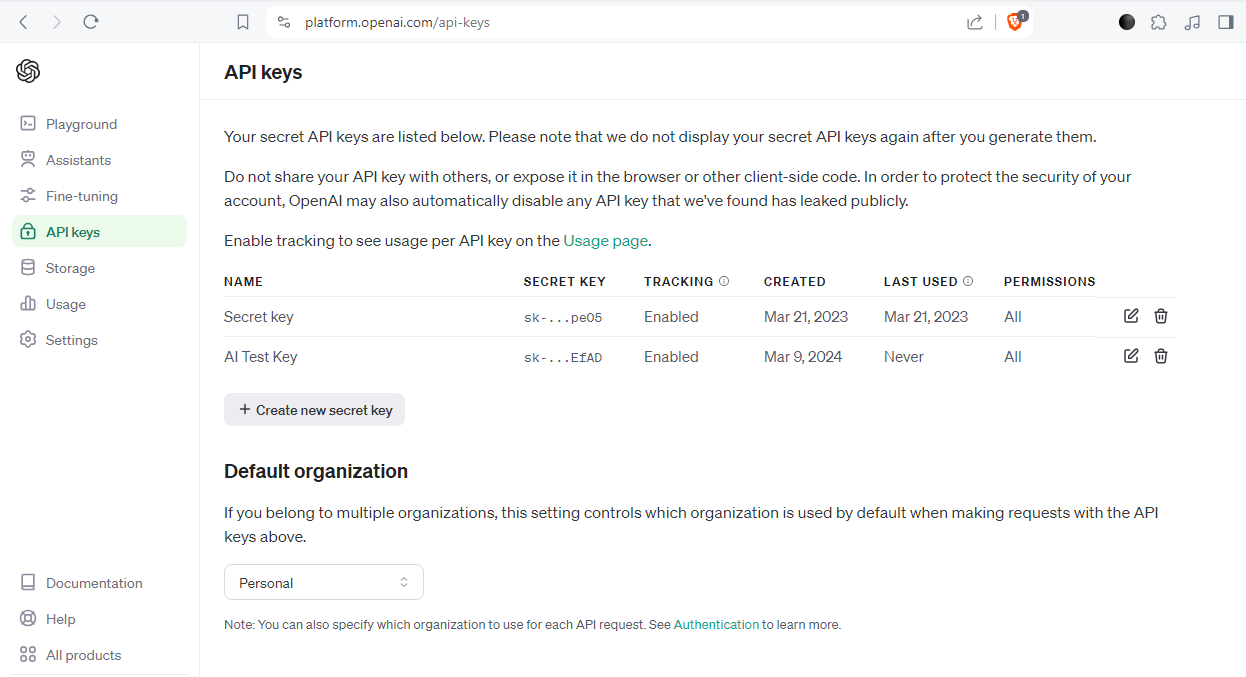 取得 API 金鑰後,在根目錄中建立一個`.env.local`檔案。 `.env.local`檔案應該是這樣的: ``` OPENAI_API_KEY=Your OpenAI API key ``` 在**app**目錄下建立該目錄; `api/copilot/openai`並建立一個名為`route.ts`的檔案。該檔案用作 CopilotKit 請求和 OpenAI 互動的**後端**端點。它處理傳入的請求,使用 CopilotKit 處理它們,並傳回適當的回應。 我們將在`route.ts`檔案中建立一個POST請求函數,在post請求內部建立一個`CopilotBackend`類別的新實例,該類別提供了處理CopilotKit請求的方法。 然後,我們呼叫`CopilotBackend`實例的`response`方法,並傳遞請求物件 ( `req` ) 和`OpenAIAdapter`類別的新實例作為參數。此方法使用 CopilotKit 和 OpenAI API 處理請求並回傳回應。 如下面的程式碼所示,我們從`@copilotkit/backend`套件導入`CopilotBackend`和`OpenAIAdapter`類別。這些類別對於與 CopilotKit 和 OpenAI API 互動是必需的。 ``` import { CopilotBackend, OpenAIAdapter } from "@copilotkit/backend"; export const runtime = "edge"; export async function POST(req: Request): Promise<Response> { const copilotKit = new CopilotBackend(); return copilotKit.response(req, new OpenAIAdapter()); } ``` **步驟 3:為 v0 克隆建立元件** 我們將使用 Shadcn UI 庫中的元件。要處理這個問題,讓我們透過執行`shadcn-ui init`命令來設定 Shadcn UI 庫來設定您的專案 ``` npx shadcn-ui@latest init ``` 然後我們將用這個問題來配置components.json ``` Which style would you like to use? › Default Which color would you like to use as base color? › Slate Do you want to use CSS variables for colors? › no / yes ``` 我們在 Shadcn UI 中使用的元件是**按鈕**和**對話框**。那麼讓我們來安裝它們吧! 對於[按鈕](https://ui.shadcn.com/docs/components/button),執行此命令 ``` npx shadcn-ui@latest add button ``` 若要安裝[對話](https://ui.shadcn.com/docs/components/dialog)方塊元件,請執行以下命令 ``` npx shadcn-ui@latest add dialog ``` **第 4 步:設定 CopilotKit 前端。閱讀[文件](https://docs.copilotkit.ai/getting-started/quickstart-textarea)以了解更多資訊。** 若要安裝 CopilotKit 前端軟體包,請執行以下命令: ``` npm i @copilotkit/react-core @copilotkit/react-ui ``` 根據[CopilotKit 文件](https://docs.copilotkit.ai/getting-started/quickstart-textarea),要使用 CopilotKit,我們必須設定前端包裝器以透過 Copilot 傳遞任何 React 應用程式。當提示傳遞到 CopilotKit 時,它會透過 URL 將其傳送到 OpenAI,後者會回傳回應。 在**應用程式**目錄中,讓我們更新`layout.tsx`檔案。該文件將定義我們應用程式的佈局結構並將 CopilotKit 整合到前端。 輸入以下程式碼: ``` "use client"; import { CopilotKit } from "@copilotkit/react-core"; import "@copilotkit/react-textarea/styles.css"; // also import this if you want to use the CopilotTextarea component import "@copilotkit/react-ui/styles.css"; import { Inter } from "next/font/google"; import "./globals.css"; import { CopilotSidebar, } from "@copilotkit/react-ui"; const inter = Inter({ subsets: ["latin"] }); export default function RootLayout({ children, }: Readonly<{ children: React.ReactNode; }>) { return ( <html lang="en"> <body className={inter.className}> <CopilotKit url="/api/copilotkit/openai/"> <CopilotSidebar defaultOpen>{children}</CopilotSidebar> </CopilotKit> </body> </html> ); } ``` 該元件代表我們應用程式的根佈局。它使用 CopilotKit 包裝整個應用程式,根據我們在**步驟 2**中為後端建立的內容指定 CopilotKit 後端端點的 URL ( `/api/copilotkit/openai/` )。此外,它還包括一個 CopilotSidebar 元件,可作為 CopilotKit 的側邊欄,並將 Children 屬性作為其內容傳遞。 **第 5 步:設定主應用程式** 讓我們建立應用程式的結構。它將有一個標題、側邊欄和預覽畫面。 對於**Header** ,導航到**元件**目錄,如下所示, `src/components`然後建立一個`header.tsx`檔案並輸入以下程式碼: ``` import { CodeXmlIcon } from "lucide-react"; import { Button } from "./ui/button"; const Header = (props: { openCode: () => void }) => { return ( <div className="w-full h-20 bg-white flex justify-between items-center px-4"> <h1 className="text-xl font-bold">Copilot Kit</h1> <div className="flex gap-x-2"> <Button className=" px-6 py-1 rounded-md space-x-1" variant={"default"} onClick={props.openCode} > <span>Code</span> <CodeXmlIcon size={20} /> </Button> </div> </div> ); }; export default Header; ``` 對於**側欄,**建立一個`sidebar.tsx`檔案並輸入以下程式碼: ``` import { ReactNode } from "react"; const Sidebar = ({ children }: { children: ReactNode }) => { return ( <div className="w-[12%] min-h-full bg-white rounded-md p-4"> <h1 className="text-sm mb-1">History</h1> {children} </div> ); }; export default Sidebar; ``` 然後對於**預覽**螢幕,建立一個`preview-screen.tsx`檔案並輸入程式碼: ``` const PreviewScreen = ({ html_code }: { html_code: string }) => { return ( <div className="w-full h-full bg-white rounded-lg shadow-lg p-2 border"> <div dangerouslySetInnerHTML={{ __html: html_code }} /> </div> ); }; export default PreviewScreen; ``` 現在讓我們將它們放在一起,打開`page.tsx`檔案並貼上以下程式碼: ``` "use client"; import { useState } from "react"; import { Dialog, DialogContent, DialogDescription, DialogHeader, DialogTitle, } from "@/components/ui/dialog"; import Header from "@/components/header"; import Sidebar from "@/components/sidebar"; import PreviewScreen from "@/components/preview-screen"; import { Input } from "@/components/ui/input"; export default function Home() { const [code, setCode] = useState<string[]>([ `<h1 class="text-red-500">Hello World</h1>`, ]); const [codeToDisplay, setCodeToDisplay] = useState<string>(code[0] || ""); const [showDialog, setShowDialog] = useState<boolean>(false); const [codeCommand, setCodeCommand] = useState<string>(""); return ( <> <main className="bg-white min-h-screen px-4"> <Header openCode={() => setShowDialog(true)} /> <div className="w-full h-full min-h-[70vh] flex justify-between gap-x-1 "> <Sidebar> <div className="space-y-2"> {code.map((c, i) => ( <div key={i} className="w-full h-20 p-1 rounded-md bg-white border border-blue-600" onClick={() => setCodeToDisplay(c)} > v{i} </div> ))} </div> </Sidebar> <div className="w-10/12"> <PreviewScreen html_code={readableCode || ""} /> </div> </div> <div className="w-8/12 mx-auto p-1 rounded-full bg-primary flex my-4 outline-0"> <Input type="text" placeholder="Enter your code command" className="w-10/12 p-6 rounded-l-full outline-0 bg-primary text-white" value={codeCommand} onChange={(e) => setCodeCommand(e.target.value)} /> <button className="w-2/12 bg-white text-primary rounded-r-full" onClick={() => generateCode.run(context)} > Generate </button> </div> </main> <Dialog open={showDialog} onOpenChange={setShowDialog}> <DialogContent> <DialogHeader> <DialogTitle>View Code.</DialogTitle> <DialogDescription> You can use the following code to start integrating into your application. </DialogDescription> <div className="p-4 rounded bg-primary text-white my-2"> {readableCode} </div> </DialogHeader> </DialogContent> </Dialog> </> ); } ``` 我們來分解一下上面的程式碼: `const [code, setCode] = useState<string[]>([]);`將用於保存生成的程式碼 `const [codeToDisplay, setCodeToDisplay] = useState<string>(code[0] || "");`將用於保存預覽畫面上顯示的程式碼。 `const [showDialog, setShowDialog] = useState<boolean>(false);`這將保持對話框的狀態,該對話框顯示您可以複製的生成程式碼。 在下面的程式碼中,我們循環產生的程式碼(一串陣列)將其顯示在側邊欄上,這樣當我們選擇一個程式碼時,它就會顯示在預覽畫面上。 ``` <Sidebar> <div className="space-y-2"> {code.map((c, i) => ( <div key={i} className="w-full h-20 p-1 rounded-md bg-white border border-blue-600" onClick={() => setCodeToDisplay(c)} > v{i} </div> ))} </div> </Sidebar> ``` `<PreviewScreen html_code={codeToDisplay} />`在這裡,我們發送要在預覽畫面上顯示的程式碼。預覽畫面元件採用 CopilotKit 產生的程式碼字串,並使用`dangerouslySetInnerHTML`來呈現產生的程式碼。 下面我們有一個`Dialog`元件,它將顯示 CoplilotKit 產生的程式碼,可以將其複製並加入到您的程式碼中。 ``` <Dialog open={showDialog} onOpenChange={setShowDialog}> <DialogContent> <DialogHeader> <DialogTitle>View Code.</DialogTitle> <DialogDescription> You can use the following code to start integrating into your application. </DialogDescription> <div className="p-4 rounded bg-primary text-white my-2"> {readableCode} </div> </DialogHeader> </DialogContent> </Dialog> ``` **步驟6:實作主要應用程式邏輯** 在這一步驟中,我們將 CopilotKit 整合到我們的 v0 克隆應用程式中,以促進人工智慧驅動的 UI 生成。我們將使用 CopilotKit 的 React hook 來管理狀態,使元件可供 Copilot 讀取和操作,並與 OpenAI API 互動。 在您的`page.tsx`檔案中,匯入以下內容: ``` import { CopilotTask, useCopilotContext, useMakeCopilotReadable, } from "@copilotkit/react-core"; ``` 然後我們在`Home`元件中使用`CopilotTask`定義一個`generateCode`任務: ``` const readableCode = useMakeCopilotReadable(codeToDisplay); const generateCode = new CopilotTask({ instructions: codeCommand, actions: [ { name: "generateCode", description: "Create Code Snippet with React.js, tailwindcss.", parameters: [ { name: "code", type: "string", description: "Code to be generated", required: true, }, ], handler: async ({ code }) => { setCode((prev) => [...prev, code]); setCodeToDisplay(code); }, }, ], }); const context = useCopilotContext(); ``` 我們使用`useMakeCopilotReadable`來傳遞現有程式碼並確保可讀性。然後我們使用`CopilotTask`產生UI,並將`generateCode`任務綁定到**生成**按鈕,這樣就可以透過與按鈕元件互動來產生程式碼片段。 此操作由使用者互動觸發,並在呼叫時執行非同步`handler`函數。 `handler`將產生的程式碼新增至程式碼陣列中,更新應用程式狀態以包含新產生的程式碼片段,並將產生的程式碼傳送到預覽畫面上顯示和呈現,預覽畫面也可以複製。 此外, `instructions`屬性指定提供給 Copilot 的命令,該命令儲存在`codeCommand`狀態變數中。 有關`CopilotTask`運作方式的完整說明,請查看此處的文件:https://docs.copilotkit.ai/reference/CopilotTask **第 6 步:執行 v0 克隆應用程式** 至此,我們已經完成了 v0 克隆設置,然後可以透過執行來啟動開發伺服器 ``` npm run dev ``` 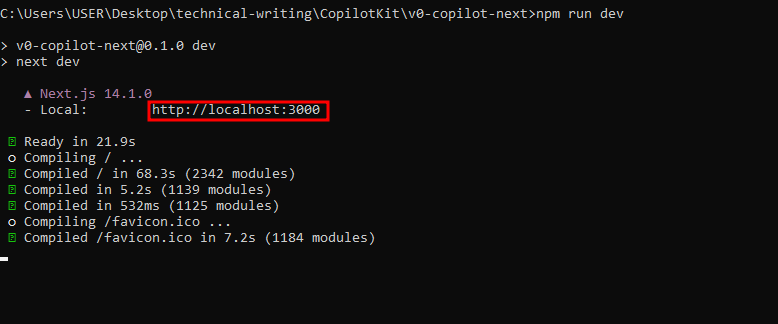 可以使用此 URL 在瀏覽器中存取該 Web 應用程式 [http://本地主機:3000](http://localhost:3000/) 然後您可以輸入提示並點擊**“生成”。**這裡有些例子: - **定價頁面:**如下所示,這是產生的UI,有一個切換按鈕可以在UI和React程式碼之間切換:  如果點擊右上角的**Code** </> 按鈕,它會切換到產生的 UI 的 React 程式碼,如下所示:  - 註冊頁面 UI 範例: 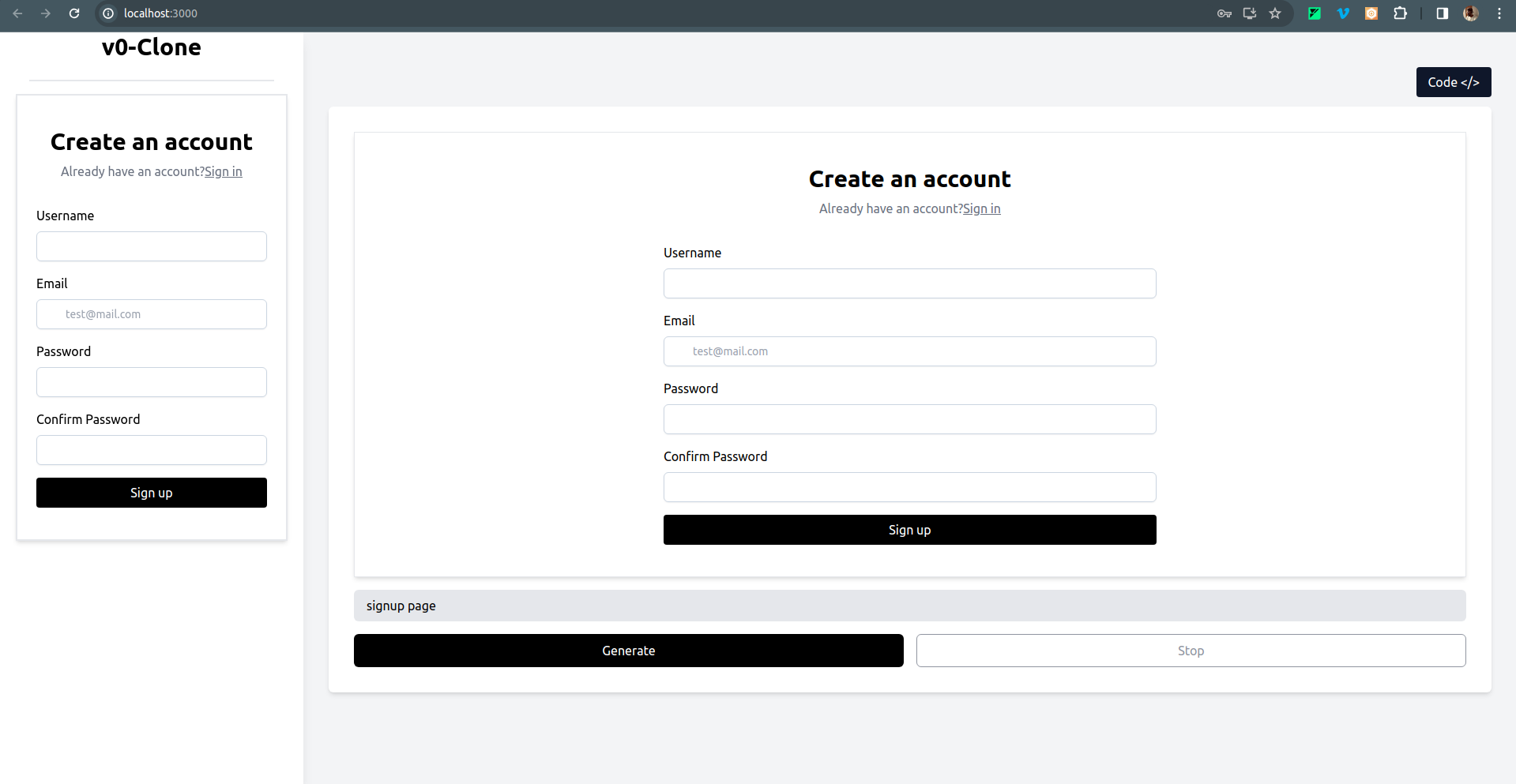 - 還有一個結帳頁面 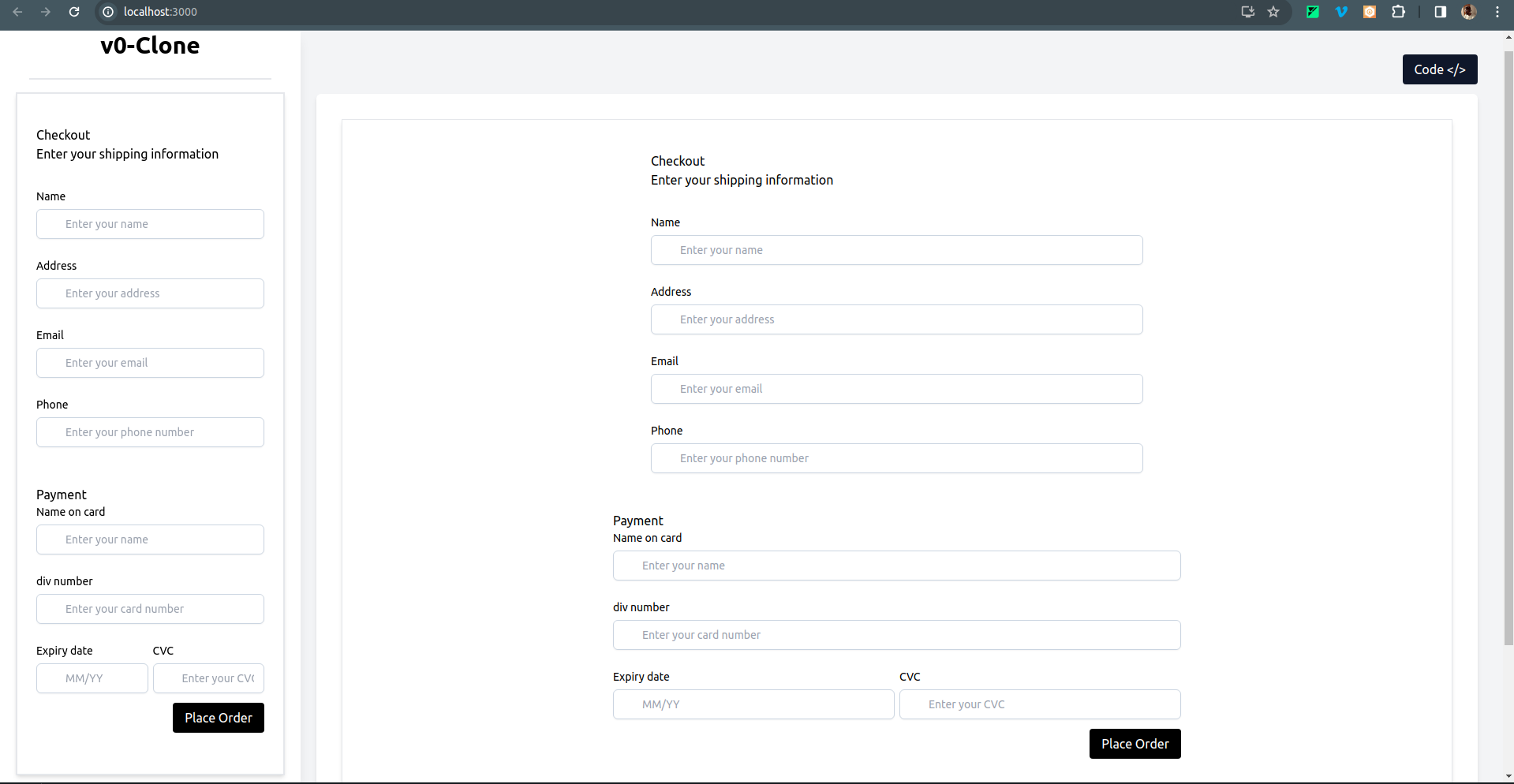 要克隆專案並在本地執行它,請打開終端並執行以下命令: ``` git clone https://github.com/Tabintel/v0-copilot-next ``` 然後執行`npm install`以安裝專案所需的所有依賴項,並`npm run dev`來執行 Web 應用程式。 結論 -- 總而言之,您可以使用[CopilotKit](https://github.com/CopilotKit/CopilotKit)建立 v0 克隆,為您的設計提供 UI 提示。 CopilotKit 不僅適用於 UI 提示,它還可以用於建立[AI 驅動的 PowerPoint 生成器](https://dev.to/copilotkit/how-to-build-ai-powered-powerpoint-app-nextjs-openai-copilotkit-ji2)、 [AI 簡歷產生器](https://dev.to/copilotkit/how-to-build-the-with-nextjs-openai-1mhb)等應用程式。 可能性是無限的,立即查看 CopilotKit,將您的 AI 想法變為現實。 在[GitHub](https://github.com/Tabintel/v0-copilot-next)上取得完整原始碼。 從[文件](https://docs.copilotkit.ai/getting-started/quickstart-textarea)中了解有關如何使用 CopilotKit 的更多資訊。 另外,別忘了[Star CopilotKit!](https://github.com/CopilotKit/CopilotKit) ⭐ --- 原文出處:https://dev.to/copilotkit/i-created-a-v0-clone-with-nextjs-gpt4-copilotkit-3cmb
React 的類型系統與 TypeScript 一起使用時,為開發人員提供了建構類型安全應用程式的強大框架。了解各種 React 類型之間的細微差別對於就其使用做出明智的決策至關重要。讓我們深入詳細比較這些類型,以了解它們的差異和適當的用例。 1️⃣ React.FC 與 React.ElementType -------------------------------- ### React.FC(React.FunctionComponent) `React.FC`是React中專門用來定義函數元件的類型。當 React Hooks 被引入並廣泛採用時,它開始變得更加流行。 在 React 18 之前,它曾經包含一個隱式的`children`屬性,使其適合預期有孩子的元件。但很長一段時間以來,隱式的`children` prop類型已經根據[React 18的類型變化](https://github.com/DefinitelyTyped/DefinitelyTyped/pull/56210)被刪除了。 這是一個使用範例: ``` interface SomeComponentProps { title: string; children?: React.ReactNode; } export const SomeComponent: React.FC<SomeComponentProps> = ({ title, children }) => { return ( <article> <h2>{title}</h2> {children} </article> ); }; ``` 然而,由於刪除了隱`children` prop 類型,現在使用`React.FC`的人少了很多,因為與直接將介面分配給 props 物件相比,它很笨重並且沒有提供任何真正的好處: ``` interface SomeComponentProps { title: string; children?: React.ReactNode; } export const SomeComponent = ({ title, children }: SomeComponentProps) => { return ( <article> <h2>{title}</h2> {children} </article> ); }; ``` ### React.ElementType 另一方面, `React.ElementType`是一種更廣泛的類型,表示可以由 React 呈現的任何元件類型。這不僅包括 React 函數和類別元件,還包括 HTML 元素的字串標籤(例如「div」、「span」)。當您想要接受元件作為 prop 並渲染它時, `React.ElementType`特別有用,允許動態元件使用。 ``` const DynamicComponent: React.ElementType = 'div'; export const Container = () => ( <DynamicComponent className="container">Hello, world!</DynamicComponent> ); ``` 在這裡, `DynamicComponent`的類型為`React.ElementType` ,允許它動態分配給不同類型的元件或 HTML 元素。 ### 比較筆記 - `React.FC`主要用於定義功能元件。從 React 18 開始,它不再那麼有用了。 - `React.ElementType`在接受各種可渲染實體方面提供了更大的靈活性。當您需要可以動態接受不同類型的 React 元件或 HTML 元素的東西時,請使用`React.ElementType` 2️⃣ React.ReactNode vs React.ReactElement vs JSX.Element -------------------------------------------------------- ### React.ReactElement `React.ReactElement`是一個具有`type` 、 `props`和`key`屬性的物件,由`React.createElement()`函數建立。與`React.ReactNode`相比,它是一種更具體的類型,表示可以由 React 直接渲染的元素。 ``` const elementContent: React.ReactElement = <div>Hello, React.ReactElement!</div>; export const Container = () => <>{elementContent}</>; ``` ### React.ReactNode `React.ReactNode`是最具包容性的類型,代表任何可以由 React 渲染的東西。這包括原始類型(字串、數字、布林值)、 `JSX.Element` 、 `React.ReactElement` 、這些類型的陣列等等。這是道具的首選類型,可以接受各種內容,例如`children` 。 ``` const multiElementContent: React.ReactNode = ( <div> <p>This is a paragraph.</p> {'This is a text node.'} {null} </div> ); const primitiveTypeContent: React.ReactNode = "I'm a primitive-type React.ReactNode"; export const Container = () => { return ( <> {multiElementContent} {primitiveTypeContent} </> ); }; ``` 下面的維恩圖描述了`React.ReactNode`和`React.ReactElement`之間的關係: 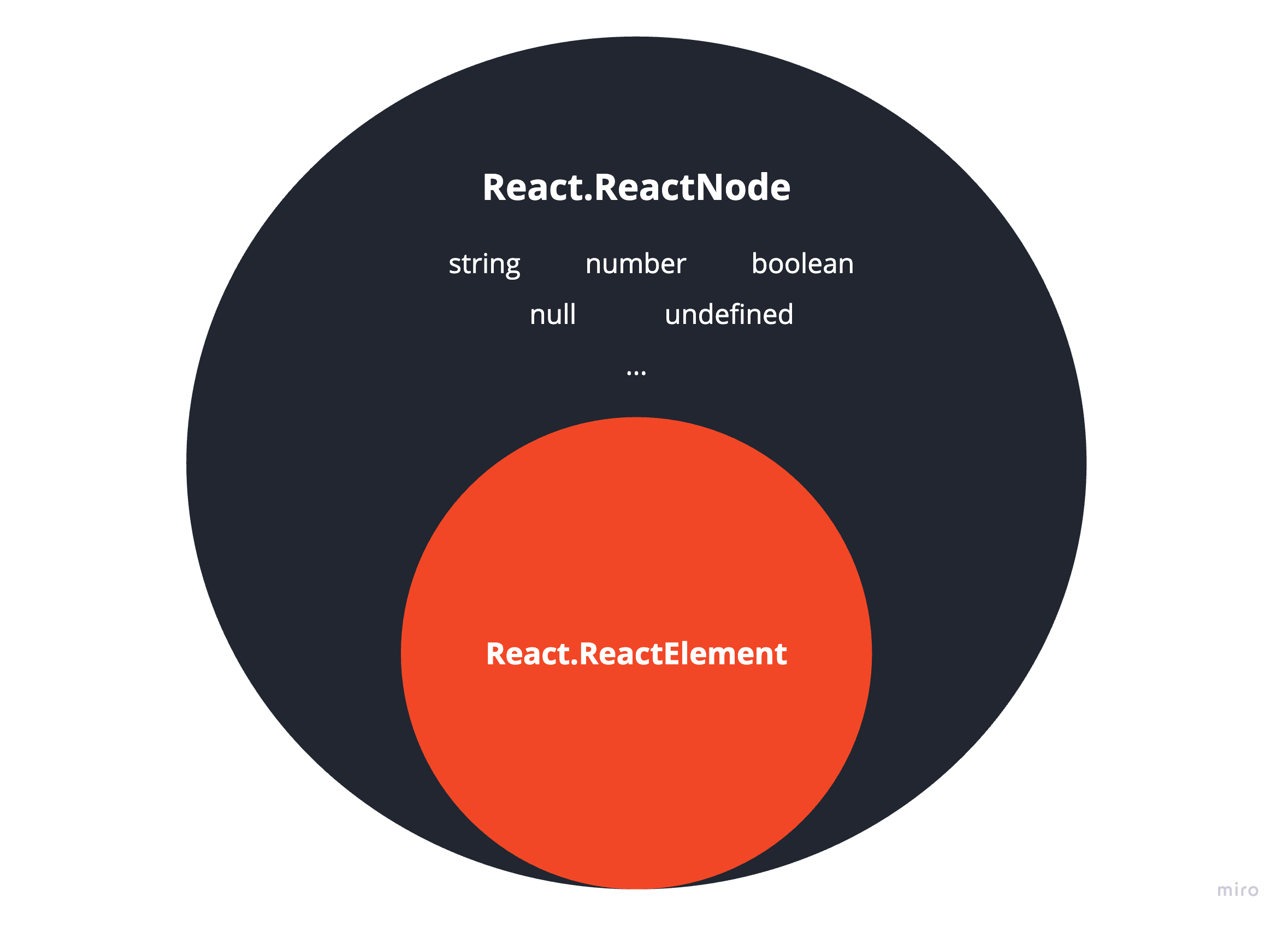 ### JSX.Element `JSX.Element`本質上是一個具有更廣泛定義的`React.ReactElement` ,允許各種程式庫以自己的方式實作 JSX。它是 TypeScript 內部使用的類型,用於表示 JSX 表達式的傳回類型。 ``` const jsxElement: JSX.Element = <span>Hello, JSX.Element!</span>; export const Container = () => <>{jsxElement}</>; ``` ### 比較筆記 - `React.ReactNode`是最靈活、最具包容性的,適合像孩子一樣可以接受多樣化內容的打字props。 - `React.ReactElement`和`JSX.Element`更具體, `React.ReactElement`適用於 React 建立的元素,而`JSX.Element`適用於使用 JSX 語法定義的元素。 💡有趣的事實 ------ - 函數元件的傳回值(也稱為渲染過程的結果)始終是`React.ReactNode`或`React.ReactElement` / `JSX.Element` 。基本上,函陣列件可以理解為: ``` type ReactFC<P = {}> = (props: P) => React.ReactNode; ``` - 像任何常規函數一樣呼叫函數元件會得到與使用 JSX 語法相同的結果,這意味著: ``` const MyComponent = ({ children }: { children: React.ReactNode }) => { return <div>{children}</div>; }; export const App = () => { return ( <div> <MyComponent> Rendering MyComponent with <strong>JSX Syntax</strong> </MyComponent> </div> ); } ``` 是相同的: ``` const MyComponent = ({ children }: { children: React.ReactNode }) => { return <div>{children}</div>; }; export const App = () => { return ( <div> {MyComponent({ children: ( <> Rendering MyComponent by <strong>Invoking Function Component</strong> </> ), })} </div> ); } ``` 🏁 結論 ---- 了解這些 React 類型和介面之間的差異可以讓開發人員做出更明智的決策,從而產生更乾淨、更易於維護的程式碼。無論您是定義元件、接受動態內容還是處理子元件,選擇正確的類型對於充分發揮 React 和 TypeScript 的潛力至關重要。 請期待我即將發表的文章,這些文章將更深入地探討利用這些類型的理解的模式。 --- 原文出處:https://dev.to/itswillt/explaining-reacts-types-940
React 設計模式是開發人員用來解決使用 React 建立應用程式時遇到的常見問題和挑戰的既定實踐和解決方案。這些模式封裝了針對重複出現的設計問題的可重複使用解決方案,從而提高了可維護性、可擴展性和效率。它們提供了一種結構化的方法來組織元件、管理狀態、處理資料流和最佳化效能。 **請考慮以下 6 種 React 設計模式:** 1. 容器和呈現模式 2. HOC(高階元件)模式 3. 複合元件模式 4. 提供者模式(使用提供者進行資料管理) 5. 狀態減速器模式 6. 元件組成模式 1. 容器和呈現模式 ---------- 在此模式中,容器元件負責管理資料和狀態邏輯。它們從外部來源獲取資料,在必要時對其進行操作,並將其作為 props 傳遞給展示元件。它們通常連接到外部服務、Redux 儲存或上下文提供者。 另一方面,展示元件僅專注於 UI 元素的展示。他們透過 props 從容器元件接收資料,並以視覺上吸引人的方式呈現它。展示元件通常是無狀態的功能元件或純元件,這使得它們更容易測試和重複使用。 **讓我們考慮一個複雜的範例來說明這些模式:** 假設我們正在建立一個社群媒體儀表板,用戶可以在其中查看朋友的貼文並與他們互動。以下是我們建立元件的方式: **容器元件(FriendFeedContainer):** 該元件將負責從 API 獲取有關好友貼文的資料、處理任何必要的資料轉換以及管理提要的狀態。它將相關資料傳遞給展示元件。 ``` import React, { useState, useEffect } from 'react'; import FriendFeed from './FriendFeed'; const FriendFeedContainer = () => { const [friendPosts, setFriendPosts] = useState([]); useEffect(() => { // Fetch friend posts from API const fetchFriendPosts = async () => { const posts = await fetch('https://api.example.com/friend-posts'); const data = await posts.json(); setFriendPosts(data); }; fetchFriendPosts(); }, []); return <FriendFeed posts={friendPosts} />; }; export default FriendFeedContainer; ``` **展示元件(FriendFeed):** 該元件將從其父容器元件 (FriendFeedContainer) 接收好友貼文資料作為 props,並以視覺上吸引人的方式呈現它們。 ``` import React from 'react'; const FriendFeed = ({ posts }) => { return ( <div> <h2>Friend Feed</h2> <ul> {posts.map(post => ( <li key={post.id}> <p>{post.content}</p> <p>Posted by: {post.author}</p> </li> ))} </ul> </div> ); }; export default FriendFeed; ``` 透過以這種方式建立我們的元件,我們將獲取資料和管理狀態的問題與 UI 渲染邏輯分開。這種分離使得我們的 React 應用程式在擴充時可以更輕鬆地進行測試、重複使用和維護。 2.HOC(高階元件)模式 ------------- 高階元件 (HOC) 是 React 中的一種模式,可讓您跨多個元件重複使用元件邏輯。它們是接受元件並傳回具有附加功能的新元件的函數。 為了示範 HOC 在具有 React hook 的社群媒體儀表板範例中的使用,讓我們考慮一個場景,其中您有多個元件需要從 API 取得使用者資料。您可以建立一個 HOC 來處理資料獲取並將獲取的資料作為 props 傳遞給包裝的元件,而不是在每個元件中重複取得邏輯。 這是一個基本範例: ``` import React, { useState, useEffect } from 'react'; // Define a higher-order component for fetching user data const withUserData = (WrappedComponent) => { return (props) => { const [userData, setUserData] = useState(null); const [loading, setLoading] = useState(true); useEffect(() => { // Simulate fetching user data from an API const fetchData = async () => { try { const response = await fetch('https://api.example.com/user'); const data = await response.json(); setUserData(data); setLoading(false); } catch (error) { console.error('Error fetching user data:', error); setLoading(false); } }; fetchData(); }, []); return ( <div> {loading ? ( <p>Loading...</p> ) : ( <WrappedComponent {...props} userData={userData} /> )} </div> ); }; }; // Create a component to display user data const UserProfile = ({ userData }) => { return ( <div> <h2>User Profile</h2> {userData && ( <div> <p>Name: {userData.name}</p> <p>Email: {userData.email}</p> {/* Additional user data fields */} </div> )} </div> ); }; // Wrap the UserProfile component with the withUserData HOC const UserProfileWithUserData = withUserData(UserProfile); // Main component where you can render the wrapped component const SocialMediaDashboard = () => { return ( <div> <h1>Social Media Dashboard</h1> <UserProfileWithUserData /> </div> ); }; export default SocialMediaDashboard; ``` 在這個例子中: - `withUserData`是一個高階元件,用於處理從 API 取得使用者資料。它包裝傳遞的元件 ( `WrappedComponent` ) 並將取得的使用者資料作為 prop ( `userData` ) 提供給它。 - `UserProfile`是一個功能元件,它接收`userData`屬性並顯示使用者設定檔資訊。 - `UserProfileWithUserData`是透過使用`withUserData`包裝`UserProfile`傳回的元件。 - `SocialMediaDashboard`是主要元件,您可以在其中呈現`UserProfileWithUserData`或任何其他需要使用者資料的元件。 使用此模式,您可以輕鬆地跨社交媒體儀表板應用程式中的多個元件重複使用資料取得邏輯,而無需重複程式碼。 3. 複合元件模式 --------- React 中的複合元件模式是一種設計模式,可讓您建立協同工作以形成有凝聚力的 UI 的元件,同時仍保持明確的關注點分離並提供自訂元件行為和外觀的靈活性。 在此模式中,父元件充當一個或多個子元件(稱為「複合元件」)的容器。這些子元件協同工作以實現特定的功能或行為。複合元件的關鍵特徵是它們透過父元件彼此共享狀態和功能。 以下是使用 hooks 在 React 中實作複合元件模式的簡單範例: ``` import React, { useState } from 'react'; // Parent component that holds the compound components const Toggle = ({ children }) => { const [isOn, setIsOn] = useState(false); // Function to toggle the state const toggle = () => { setIsOn((prevIsOn) => !prevIsOn); }; // Clone the children and pass the toggle function and state to them const childrenWithProps = React.Children.map(children, (child) => { if (React.isValidElement(child)) { return React.cloneElement(child, { isOn, toggle }); } return child; }); return <div>{childrenWithProps}</div>; }; // Child component for the toggle button const ToggleButton = ({ isOn, toggle }) => { return ( <button onClick={toggle}> {isOn ? 'Turn Off' : 'Turn On'} </button> ); }; // Child component for the toggle status const ToggleStatus = ({ isOn }) => { return <p>The toggle is {isOn ? 'on' : 'off'}.</p>; }; // Main component where you use the compound components const App = () => { return ( <Toggle> <ToggleStatus /> <ToggleButton /> </Toggle> ); }; export default App; ``` 在這個例子中: - `Toggle`是保存複合元件( `ToggleButton`和`ToggleStatus` )的父元件。 - `ToggleButton`是負責渲染切換按鈕的子元件。 - `ToggleStatus`是另一個負責顯示切換狀態的子元件。 - `Toggle`元件管理狀態 ( `isOn` ) 並提供`toggle`功能來控制狀態。它克隆其子級並將`isOn`狀態和`toggle`函數作為 props 傳遞給它們。 透過使用複合元件模式,您可以建立可重複使用和可組合的元件,封裝複雜的 UI 邏輯,同時仍允許自訂和靈活性。 ### 4. Provider Pattern(使用Provider進行資料管理) React 中的提供者模式是一種設計模式,用於跨多個元件管理和共用應用程式狀態或資料。它涉及建立一個封裝狀態或資料的提供者元件,並透過 React 的上下文 API 將其提供給其後代元件。 讓我們透過一個範例來說明 React 中用於管理使用者身份驗證資料的 Provider 模式: ``` // UserContext.js import React, { createContext, useState } from 'react'; // Create a context for user data const UserContext = createContext(); // Provider component export const UserProvider = ({ children }) => { const [user, setUser] = useState(null); // Function to login user const login = (userData) => { setUser(userData); }; // Function to logout user const logout = () => { setUser(null); }; return ( <UserContext.Provider value={{ user, login, logout }}> {children} </UserContext.Provider> ); }; export default UserContext; ``` 在這個例子中: - 我們使用 React 的`createContext`函數來建立一個名為`UserContext`上下文。此上下文將用於跨元件共享用戶資料和與身份驗證相關的功能。 - 我們定義一個`UserProvider`元件作為`UserContext`的提供者。該元件使用`useState`鉤子管理使用者狀態,並提供`login`和`logout`等方法來更新使用者狀態。 - 在`UserProvider`內部,我們用`UserContext.Provider`包裝`children` ,並將`user`狀態以及`login`和`logout`函數作為提供者的值傳遞。 - 現在,任何需要存取使用者資料或驗證相關功能的元件都可以使用`useContext`掛鉤來使用`UserContext` 。 讓我們建立一個使用上下文中的使用者資料的元件: ``` // UserProfile.js import React, { useContext } from 'react'; import UserContext from './UserContext'; const UserProfile = () => { const { user, logout } = useContext(UserContext); return ( <div> {user ? ( <div> <h2>Welcome, {user.username}!</h2> <button onClick={logout}>Logout</button> </div> ) : ( <div> <h2>Please log in</h2> </div> )} </div> ); }; export default UserProfile; ``` 在此元件中: 我們匯入`UserContext`並使用`useContext`鉤子來存取`UserProvider`提供的使用者資料和`logout`功能。 根據使用者是否登錄,我們呈現不同的 UI 元素。 最後,我們用`UserProvider`包裝我們的應用程式,以使用戶資料和身份驗證相關的功能可供所有元件使用: ``` // App.js import React from 'react'; import { UserProvider } from './UserContext'; import UserProfile from './UserProfile'; const App = () => { return ( <UserProvider> <div> <h1>My App</h1> <UserProfile /> </div> </UserProvider> ); }; export default App; ``` 透過這種方式,Provider 模式允許我們跨多個元件管理和共享應用程式狀態或資料,而無需進行 prop 鑽取,從而使我們的程式碼更乾淨、更易於維護。 --- 原文出處:https://dev.to/fpaghar/react-component-design-patterns-part-1-5f0g
大家好, 請問使用 `zod` 來定義元件 props 的型別,要怎麼樣達到這樣的形式呢? ``` type Props { title: string; description?: string; } ``` 我想要做的是:description 不一定要傳入元件 用 zod 的 `.optional()` 來定義: ``` const postProps = z.object({ title: z.string(), description: z.string().optional() }); type Props = z.infer<typeof postProps>; ``` 這樣產生的型別是: ``` type Props { title: string; description: string | undefined; } ``` 要使用這個元件的時候,如果只傳入 `title`, ``` <Component title="標題字串" /> ``` 就出現錯誤: ``` Property 'description' is missing in type '{ title: string; }' but required in type '{ title: string; description: string | undefined; }' ``` Google 一陣後,有人用 `.partial({ description: true })`,但是改寫後也還是得到 `string | undefined` 想知道應該如何設定型別?謝謝!
今天,我們將學習如何使用 Wing 作為後端建立全端應用程式。 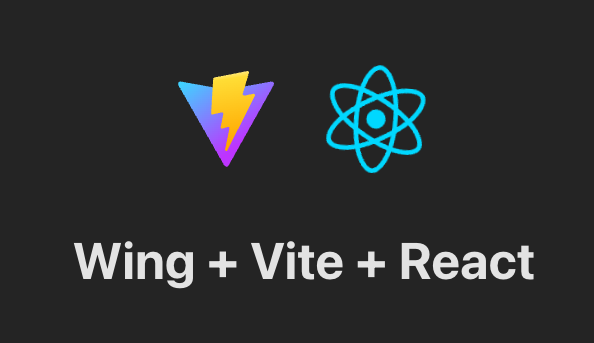 我們將使用 React 和 Vite 作為前端。 我知道還有其他框架,如 Vue、Angular 和 Next,但 React 仍然是最常見的,並且迄今為止有大量值得信賴的新創公司使用它。 如果您不知道, [React](https://github.com/facebook/react)是 Facebook 建立的開源程式庫,用於建立 Web 和本機使用者介面。正如您從儲存庫中看到的,它被超過 2040 萬開發人員使用。所以,這是值得的。 讓我們看看如何使用 Wing 作為後端。  --- [Wing](https://git.new/wing-repo) - 一種雲端程式語言。 ---------------------------------------------  Winglang 是一種專為雲端(又稱「面向雲端」)設計的新型開源程式語言。它允許您在雲端中建立應用程式,並且具有相當簡單的語法。 Wing 程式可以使用功能齊全的模擬器在本地執行(是的,不需要網路),也可以部署到任何雲端供應商。  Wing 需要 Node `v20 or higher` 。 建立一個父目錄(我們使用的`shared-counter` )並使用 Vite 使用新的 React 應用程式設定前端。您可以使用這個 npm 指令。 ``` npm create -y vite frontend -- --template react-ts // once installed, you can check if it's running properly. cd frontend npm install npm run dev ``` 您可以使用此 npm 命令安裝 Wing。 ``` npm install -g winglang ``` 您可以使用`wing -V`驗證安裝。 Wing 還提供官方[VSCode 擴充功能](https://marketplace.visualstudio.com/items?itemName=Monada.vscode-wing)和[IntelliJ](https://plugins.jetbrains.com/plugin/22353-wing) ,後者提供語法突出顯示、補全、轉到定義和嵌入式 Wing 控制台支援。您可以在建立應用程式之前安裝它! 建立後端目錄。 ``` mkdir ~/shared-counter/backend cd ~/shared-counter/backend ``` 建立一個新的空 Wing 專案。 ``` wing new empty // This will generate three files: package.json, package-lock.json and main.w file with a simple "hello world" program wing it // to run it in the Wing simulator // The Wing Simulator will be opened in your browser and will show a map of your app with a single function. //You can invoke the function from the interaction panel and check out the result. ``` 使用指令`wing new empty`後的結構如下。 ``` bring cloud; // define a queue, a bucket, and a counter let bucket = new cloud.Bucket(); let counter = new cloud.Counter(initial: 1); let queue = new cloud.Queue(); // When a message is received in the queue -> it should be consumed // by the following closure queue.setConsumer(inflight (message: str) => { // Increment the distributed counter, the index variable will // store the value before the increment let index = counter.inc(); // Once two messages are pushed to the queue, e.g. "Wing" and "Queue". // Two files will be created: // - wing-1.txt with "Hello Wing" // - wing-2.txt with "Hello Queue" bucket.put("wing-{index}.txt", "Hello, {message}"); log("file wing-{index}.txt created"); }); ``` 您可以安裝`@winglibs/vite`來啟動開發伺服器,而不是使用`npm run dev`來啟動本機 Web 伺服器。 ``` // in the backend directory npm i @winglibs/vite ``` 您可以使用`backend/main.w`中提供的 publicEnv 將資料傳送到前端。 讓我們來看一個小例子。 ``` // backend/main.w bring vite; new vite.Vite( root: "../frontend", publicEnv: { TITLE: "Wing + Vite + React" } ); // import it in frontend // frontend/src/App.tsx import "../.winglibs/wing-env.d.ts" //You can access that value like this. <h1>{window.wing.env.TITLE}</h1> ``` 你還可以做更多: - 讀取/更新 API 路線並使用 Wing Simulator 檢查它。 - 使用後端獲取值。 - 使用`@winglibs/websockets`同步瀏覽器,它在後端部署一個 WebSocket 伺服器,您可以連接此 WebSocket 來接收即時通知。 您可以閱讀完整的逐步指南,以了解[如何使用 React 作為前端和 Wing 作為後端建立簡單的 Web 應用程式](https://www.winglang.io/docs/guides/react-vite-websockets)。測試是使用 Wing Simulator 完成的,並使用 Terraform 部署到 AWS。 部署後的AWS架構是這樣的。 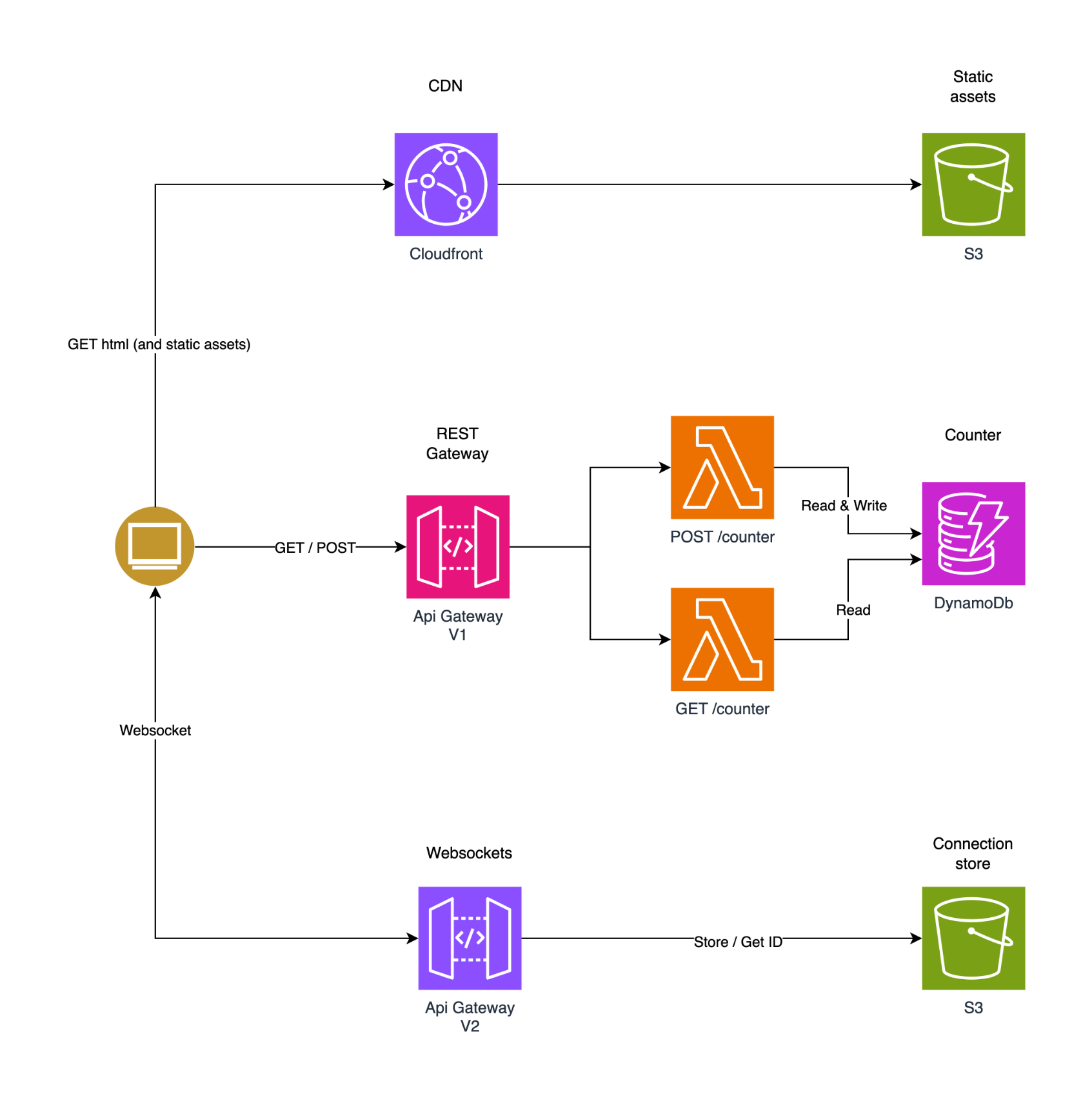 為了提供開發者選擇和更好的體驗,Wing 推出了對[TypeScript (Wing)](https://www.winglang.io/docs/typescript/)等其他語言的全面支援。唯一強制性的事情是您必須安裝 Wing SDK。 這也將使控制台完全可用於本地偵錯和測試,而無需學習 Wing 語言。 Wing 甚至還有其他[指南](https://www.winglang.io/docs/category/guides),因此更容易遵循。 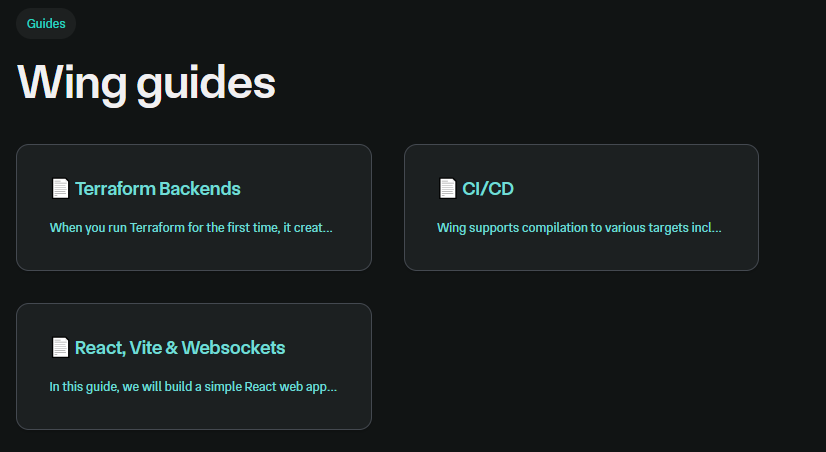 您可以閱讀[文件](https://www.winglang.io/docs)並查看[範例](https://www.winglang.io/docs/category/examples)。 您也可以在[Playground](https://www.winglang.io/play/?code=LwAvACAAVABoAGkAcwAgAGkAcwAgAHQAaABlACAAaQBtAHAAbwByAHQAIABzAHQAYQB0AGUAbQBlAG4AdAAgAGkAbgAgAFcAaQBuAGcALgAKAC8ALwAgAEgAZQByAGUAIAB3AGUAIABiAHIAaQBuAGcAIAB0AGgAZQAgAFcAaQBuAGcAIABzAHQAYQBuAGQAYQByAGQAIABsAGkAYgByAGEAcgB5ACAAdABoAGEAdAAgAAoALwAvACAAYwBvAG4AdABhAGkAbgBzACAAYQBiAHMAdAByAGEAYwB0AGkAbwBuAHMAIABvAGYAIABwAG8AcAB1AGwAYQByACAAYwBsAG8AdQBkACAAcwBlAHIAdgBpAGMAZQBzAC4ACgBiAHIAaQBuAGcAIABjAGwAbwB1AGQAOwAKAAoALwAvACAAVABoAGkAcwAgAGMAbwBkAGUAIABkAGUAZgBpAG4AZQBzACAAYQAgAGIAdQBjAGsAZQB0ACAAYQBzACAAcABhAHIAdAAgAG8AZgAgAHkAbwB1AHIAIABhAHAAcAAuAAoALwAvACAAVwBoAGUAbgAgAGMAbwBtAHAAaQBsAGkAbgBnACAAdABvACAAYQAgAHMAcABlAGMAaQBmAGkAYwAgAGMAbABvAHUAZAAgAHAAcgBvAHYAaQBkAGUAcgAKAC8ALwAgAGkAdAAgAHcAaQBsAGwAIABiAGUAIABzAHUAYgBzAHQAaQB0AHUAdABlAGQAIABiAHkAIABhAG4AIABpAG0AcABsAGUAbQBlAG4AdABhAHQAaQBvAG4AIABmAG8AcgAKAC8ALwAgAHQAaABhAHQAIABjAGwAbwB1AGQALgAgAEkALgBlACwAIABmAG8AcgAgAEEAVwBTACAAaQB0ACAAdwBpAGwAbAAgAGIAZQAgAGEAbgAgAFMAMwAgAEIAdQBjAGsAZQB0AC4ACgBsAGUAdAAgAGIAdQBjAGsAZQB0ACAAPQAgAG4AZQB3ACAAYwBsAG8AdQBkAC4AQgB1AGMAawBlAHQAKAApADsACgAKAC8ALwAgACEAIQAhACEAIQAhACEAIQAhACEAIQAhACEAIQAhACEAIQAhACEAIQAhACEAIQAhACEAIQAhACEAIQAhACEAIQAhACEAIQAhACEAIQAhACEAIQAhACEAIQAhACEAIQAhACEAIQAKAC8ALwAgAFkAbwB1ACAAYwBhAG4AIABpAG4AdABlAHIAYQBjAHQAIAB3AGkAdABoACAAdABoAGUAIABhAHAAcAAgAGkAbgAgAHQAaABlACAAYwBvAG4AcwBvAGwAZQAgAC0ALQA%2BAAoALwAvACAACgAvAC8AIABDAGwAaQBjAGsAIABvAG4AIAB0AGgAZQAgAEYAdQBuAGMAdABpAG8AbgAsACAAYQBuAGQAIAB0AGgAZQBuACAAaQBuAHYAbwBrAGUAIABpAHQAIABpAG4AIAB0AGgAZQAKAC8ALwAgAGwAbwB3AGUAcgAgAHIAaQBnAGgAdAAgAHAAYQBuAGUAbAAsACAAbwByACAAYwBsAGkAYwBrACAAbwBuACAAdABoAGUAIABCAHUAYwBrAGUAdAAKAC8ALwAgAHQAbwAgAHMAZQBlACAAaQB0AHMAIABjAG8AbgB0AGUAbgB0AHMAIABpAG4AIAB0AGgAZQAgAHAAYQBuAGUAbAAsACAAZQB0AGMALgAKAC8ALwAgACEAIQAhACEAIQAhACEAIQAhACEAIQAhACEAIQAhACEAIQAhACEAIQAhACEAIQAhACEAIQAhACEAIQAhACEAIQAhACEAIQAhACEAIQAhACEAIQAhACEAIQAhACEAIQAhACEAIQAKAAoALwAvACAAYABpAG4AZgBsAGkAZwBoAHQAcwBgACAAcgBlAHAAcgBlAHMAZQBuAHQAIABjAG8AZABlACAAdABoAGEAdAAgAHIAdQBuAHMAIABsAGEAdABlAHIALAAgAG8AbgAKAC8ALwAgAG8AdABoAGUAcgAgAG0AYQBjAGgAaQBuAGUAcwAsACAAaQBuAHQAZQByAGEAYwB0AGkAbgBnACAAdwBpAHQAaAAgAGMAYQBwAHQAdQByAGUAZAAgAGQAYQB0AGEAIABhAG4AZAAKAC8ALwAgAHIAZQBzAG8AdQByAGMAZQBzACAAZgByAG8AbQAgAHQAaABlACAAcAByAGUALQBmAGwAaQBnAGgAdAAgAHAAaABhAHMAZQAuAAoAbABlAHQAIABoAGUAbABsAG8AXwB3AG8AcgBsAGQAIAA9ACAAaQBuAGYAbABpAGcAaAB0ACAAKAApACAAPQA%2BACAAewAKACAAIABiAHUAYwBrAGUAdAAuAHAAdQB0ACgAIgBoAGUAbABsAG8ALgB0AHgAdAAiACwAIAAiAEgAZQBsAGwAbwAsACAAVwBvAHIAbABkACEAIgApADsACgB9ADsACgAKAC8ALwAgAEkAbgBmAGwAaQBnAGgAdABzACAAYwBhAG4AIABiAGUAIABkAGUAcABsAG8AeQBlAGQAIABhAHMAIABzAGUAcgB2AGUAcgBsAGUAcwBzACAAZgB1AG4AYwB0AGkAbwBuAHMACgBuAGUAdwAgAGMAbABvAHUAZAAuAEYAdQBuAGMAdABpAG8AbgAoAGgAZQBsAGwAbwBfAHcAbwByAGwAZAApADsACgAgACAAIAAgACAAIAAgACAAIAAgACAAIAAgACAAIAAgACAAIAAgACAAIAAgACAAIAAgACAAIAAgACAAIAAgACAAIAAgACAAIAAgACAACgAvAC8AIACRISAAUwB3AGkAdABjAGgAIABmAGkAbABlAHMAIABhAG4AZAAgAHMAZQBlACAAbwB0AGgAZQByACAAZQB4AGEAbQBwAGwAZQBzACAAdwBpAHQAaAAgAG0AbwByAGUACgAvAC8AIABlAHgAcABsAGUAbgBhAHQAaQBvAG4AcwAgAGEAYgBvAHYAZQAuAA%3D%3D)中使用 Wing 查看結構和範例。 如果你比較像輔導員。看這個! https://www.youtube.com/watch?v=wzqCXrsKWbo Wing 在 GitHub 上擁有超過 3500 個 Star,發布了 1500 多個版本,但仍未進入 v1 版本,這意味著意義重大。 去嘗試一下,做一些很酷的事情吧! https://git.new/wing-repo 星翼 ⭐️ --- 開發者生態系統不斷發展,許多開發者圍繞 React 建置了一些獨特的東西。 我不會介紹如何使用 React,因為這是一個非常廣泛的主題,我在最後貼了一些資源來幫助您學習 React。 但為了幫助您建立出色的 React 專案,我們介紹了 25 個開源專案,您可以使用它們來使您的工作更輕鬆。 這將有大量的資源、想法和概念。 我甚至會給你一些學習資源,以及一些產品的專案範例來學習 React。 一切都是免費的,而且只有 React。 讓我們涵蓋這一切! --- 1. [Mantine Hooks](https://www.npmjs.com/package/@mantine/hooks) - 用於狀態和 UI 管理的 React hooks。 -------------------------------------------------------------------------------------------- 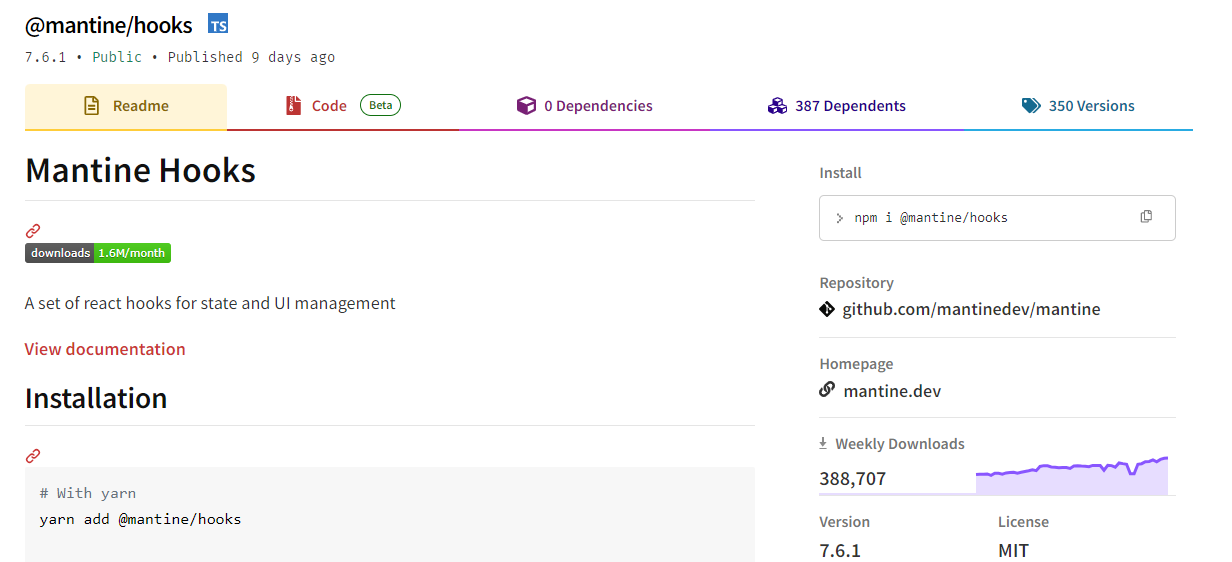 這可能不是專門針對 React 的,但是您可以使用這些鉤子來使您的工作更輕鬆。這些鉤子隨時可用,每個鉤子都有許多選項。 如果我必須評價的話,這將是每個人都可以使用的最有用的專案,而不是從頭開始編寫程式碼。 相信我,獲得 60 多個 Hooks 是一件大事,因為他們有一個簡單的方法讓您可以透過簡單的文件查看每個 Hooks 的演示。 開始使用以下 npm 指令。 ``` npm install @mantine/hooks ``` 這就是如何使用`useScrollIntoView`作為 mantine 掛鉤的一部分。 ``` import { useScrollIntoView } from '@mantine/hooks'; import { Button, Text, Group, Box } from '@mantine/core'; function Demo() { const { scrollIntoView, targetRef } = useScrollIntoView<HTMLDivElement>({ offset: 60, }); return ( <Group justify="center"> <Button onClick={() => scrollIntoView({ alignment: 'center', }) } > Scroll to target </Button> <Box style={{ width: '100%', height: '50vh', backgroundColor: 'var(--mantine-color-blue-light)', }} /> <Text ref={targetRef}>Hello there</Text> </Group> ); } ``` 它們幾乎擁有從本地儲存到分頁、滾動視圖、交叉點,甚至一些非常酷的實用程式(例如滴管和文字選擇)的所有功能。這實在太有幫助了! 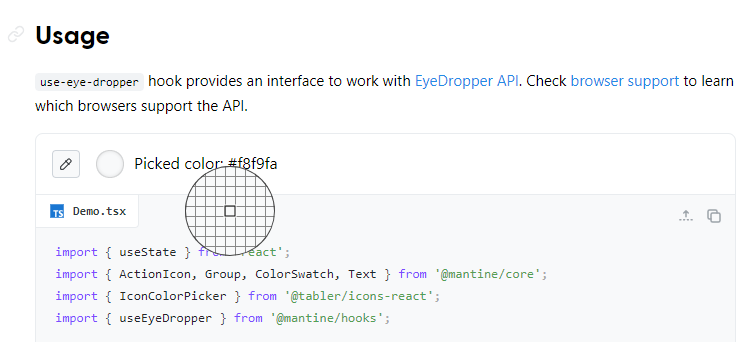 您可以閱讀[文件](https://mantine.dev/hooks/use-click-outside/)。 如果您正在尋找更多選項,您也可以使用[替代庫](https://antonioru.github.io/beautiful-react-hooks/)。 他們在 GitHub 上擁有超過 23k star,但這不僅僅是為了 hooks,因為他們是 React 的元件庫。 隨著`v7`版本的發布,它的每週下載量已超過 38 萬次,這表明它們正在不斷改進且值得信賴。 https://github.com/mantinedev/mantine Star Mantine Hooks ⭐️ --- 2. [React Grid Layout](https://github.com/react-grid-layout/react-grid-layout) - 可拖曳且可調整大小的網格佈局,具有響應式斷點。 --------------------------------------------------------------------------------------------------------  React-Grid-Layout 是專為 React 應用程式建構的響應式網格佈局系統。 透過支援可拖曳、可調整大小和靜態小部件,它提供了使用網格的簡單解決方案。 與 Packery 或 Gridster 等類似系統不同,React-Grid-Layout 不含 jQuery,確保輕量級且高效的實作。 它與伺服器渲染應用程式的無縫整合以及序列化和恢復佈局的能力使其成為開發人員在 React 專案中使用網格佈局的寶貴工具。 開始使用以下 npm 指令。 ``` npm install react-grid-layout ``` 這就是如何使用響應式網格佈局。 ``` import { Responsive as ResponsiveGridLayout } from "react-grid-layout"; class MyResponsiveGrid extends React.Component { render() { // {lg: layout1, md: layout2, ...} const layouts = getLayoutsFromSomewhere(); return ( <ResponsiveGridLayout className="layout" layouts={layouts} breakpoints={{ lg: 1200, md: 996, sm: 768, xs: 480, xxs: 0 }} cols={{ lg: 12, md: 10, sm: 6, xs: 4, xxs: 2 }} > <div key="1">1</div> <div key="2">2</div> <div key="3">3</div> </ResponsiveGridLayout> ); } } ``` 您可以閱讀[文件](https://github.com/react-grid-layout/react-grid-layout?tab=readme-ov-file#installation)並查看[演示](https://react-grid-layout.github.io/react-grid-layout/examples/0-showcase.html)。有一系列[演示](https://github.com/react-grid-layout/react-grid-layout?tab=readme-ov-file#demos),甚至可以透過點擊“查看下一個範例”來獲得。 您也可以嘗試[codesandbox](https://codesandbox.io/p/devbox/github/gilbarbara/react-joyride-demo/tree/main/?embed=1)上的東西。 該專案在 GitHub 上有超過 19k+ 的星星,有超過 16k+ 的開發者使用,並且[npm 套件](https://www.npmjs.com/package/react-grid-layout)的每週下載量超過 600k+。 https://github.com/react-grid-layout/react-grid-layout 明星 React 網格佈局 ⭐️ --- 3. [React Spectrum](https://github.com/adobe/react-spectrum) - 提供出色使用者體驗的程式庫和工具的集合。 -----------------------------------------------------------------------------------  React Spectrum 是一個庫和工具的集合,可幫助您建立自適應、可存取且強大的使用者體驗。 它們提供了太多的東西,以至於很難在一篇文章中涵蓋所有內容。 總的來說,他們提供了這四個庫。 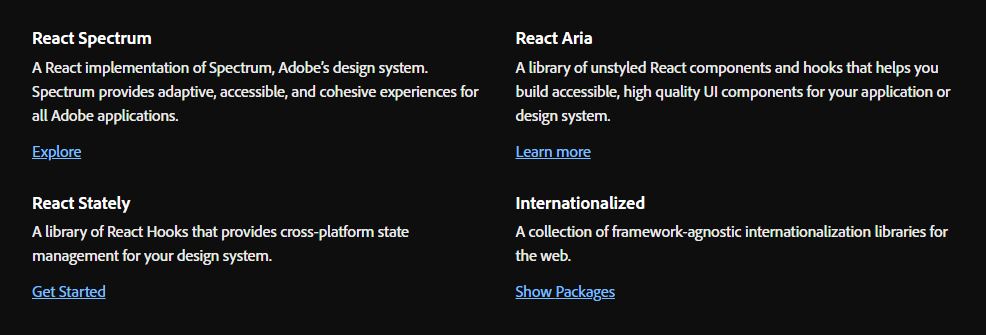 - [反應譜](https://react-spectrum.adobe.com/react-spectrum/index.html) - [React Stately](https://react-spectrum.adobe.com/react-stately/index.html) - 一組龐大的 React Hooks,為您的設計系統提供跨平台狀態管理。 - [反應詠嘆調](https://react-spectrum.adobe.com/react-aria/index.html) - [國際化](https://react-spectrum.adobe.com/internationalized/index.html) 我們將了解一些有關 React Aria 的內容,它是一個無樣式 React 元件和鉤子庫,可幫助您為應用程式建立可存取的、高品質的 UI 元件。 它經過了各種設備、互動方式和輔助技術的精心測試,以確保為所有用戶提供最佳體驗。 開始使用以下 npm 指令。 ``` npm i react-aria-components ``` 這就是建立自訂`select`的方法。 ``` import {Button, Label, ListBox, ListBoxItem, Popover, Select, SelectValue} from 'react-aria-components'; <Select> <Label>Favorite Animal</Label> <Button> <SelectValue /> <span aria-hidden="true">▼</span> </Button> <Popover> <ListBox> <ListBoxItem>Cat</ListBoxItem> <ListBoxItem>Dog</ListBoxItem> <ListBoxItem>Kangaroo</ListBoxItem> </ListBox> </Popover> </Select> ``` 相信我,出於學習目的,這是一座金礦。  他們使用自己強大的[40 多個樣式元件](https://opensource.adobe.com/spectrum-css/),這比通常提供的要多得多。他們也有自己的一套[設計系統,](https://spectrum.adobe.com/)例如字體、UI、版面、動作等等。  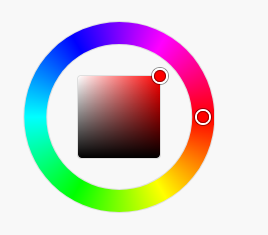 您可以詳細了解[Spectrum](https://react-spectrum.adobe.com/index.html)及其[架構](https://react-spectrum.adobe.com/architecture.html)。 他們在 GitHub 上擁有超過 11,000 顆星,這表明了他們的質量,儘管他們並不廣為人知。研究它們可以為您建立圖書館提供寶貴的見解。 https://github.com/adobe/react-spectrum Star React Spectrum ⭐️ --- 4.[保留 React](https://github.com/StaticMania/keep-react) - Tailwind CSS 和 React.js 的 UI 元件庫。 -------------------------------------------------------------------------------------------  Keep React 是一個基於 Tailwind CSS 和 React.js 建立的開源元件庫。它提供了一組多功能的預先設計的 UI 元件,使開發人員能夠簡化現代、響應式且具有視覺吸引力的 Web 應用程式的建立。 開始使用以下 npm 指令。 ``` npm i keep-react ``` 這就是使用時間軸的方法。 ``` "use client"; import { Timeline } from "keep-react"; import { CalendarBlank } from "phosphor-react"; export const TimelineComponent = () => { return ( <Timeline horizontal={true}> <Timeline.Item> <Timeline.Point icon={<CalendarBlank size={16} />} /> <Timeline.Content> <Timeline.Title>Keep Library v1.0.0</Timeline.Title> <Timeline.Time>Released on December 2, 2021</Timeline.Time> <Timeline.Body> Get started with dozens of web components and interactive elements. </Timeline.Body> </Timeline.Content> </Timeline.Item> <Timeline.Item> <Timeline.Point icon={<CalendarBlank size={16} />} /> <Timeline.Content> <Timeline.Title>Keep Library v1.1.0</Timeline.Title> <Timeline.Time>Released on December 23, 2021</Timeline.Time> <Timeline.Body> Get started with dozens of web components and interactive elements. </Timeline.Body> </Timeline.Content> </Timeline.Item> <Timeline.Item> <Timeline.Point icon={<CalendarBlank size={16} />} /> <Timeline.Content> <Timeline.Title>Keep Library v1.3.0</Timeline.Title> <Timeline.Time>Released on January 5, 2022</Timeline.Time> <Timeline.Body> Get started with dozens of web components and interactive elements. </Timeline.Body> </Timeline.Content> </Timeline.Item> </Timeline> ); } ``` 輸出如下。 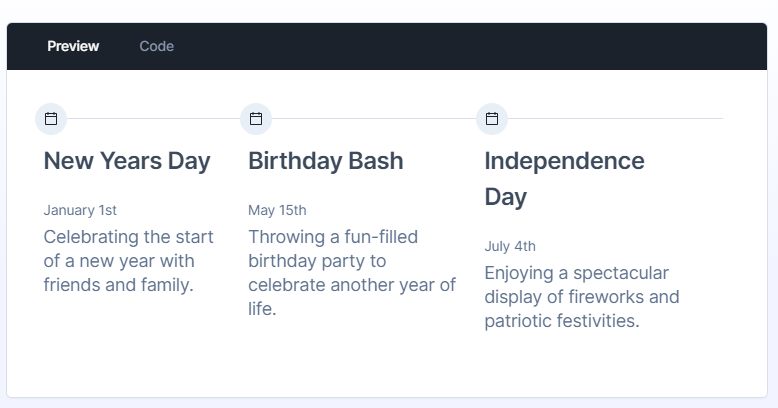 流暢的小動畫讓這一切都是值得的,如果你想快速建立一個 UI,沒有任何麻煩,你可以使用它。 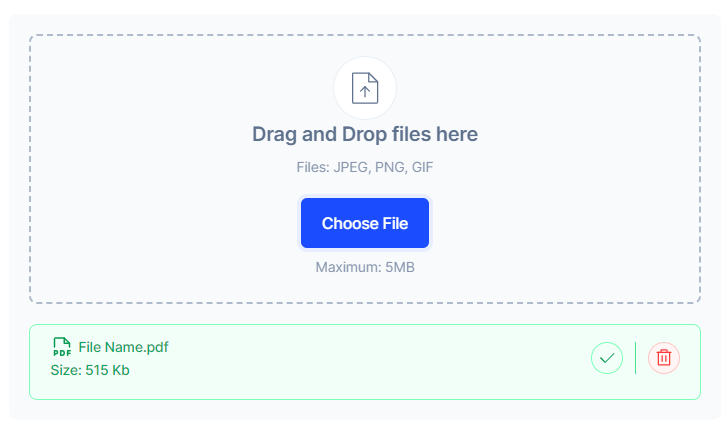  您可以閱讀[文件](https://react.keepdesign.io/docs/getting-started/Introduction)並查看[故事書](https://react-storybook.keepdesign.io/?path=/docs/components-accordion--docs)以進行詳細的使用測驗。 該專案在 GitHub 上有超過 1000 顆星,而且它的一些元件使用起來非常方便。 https://github.com/StaticMania/keep-react Star Keep React ⭐️ --- 5. [React Content Loader](https://github.com/danilowoz/react-content-loader) - SVG 支援的元件,可輕鬆建立骨架載入。 ---------------------------------------------------------------------------------------------------  該專案為您提供了一個由 SVG 驅動的元件,可以輕鬆建立佔位符載入(如 Facebook 的卡片載入)。 在載入狀態期間使用骨架來向使用者指示內容仍在載入。 總的來說,這是一個非常方便的專案,可以增強整體使用者體驗。 開始使用以下 npm 指令。 ``` npm i react-content-loader --save ``` 您可以這樣使用它。 ``` import React from "react" import ContentLoader from "react-content-loader" const MyLoader = (props) => ( <ContentLoader speed={2} width={400} height={160} viewBox="0 0 400 160" backgroundColor="#f3f3f3" foregroundColor="#ecebeb" {...props} > <rect x="48" y="8" rx="3" ry="3" width="88" height="6" /> <rect x="48" y="26" rx="3" ry="3" width="52" height="6" /> <rect x="0" y="56" rx="3" ry="3" width="410" height="6" /> <rect x="0" y="72" rx="3" ry="3" width="380" height="6" /> <rect x="0" y="88" rx="3" ry="3" width="178" height="6" /> <circle cx="20" cy="20" r="20" /> </ContentLoader> ) export default MyLoader ```  您甚至可以拖曳單一骨架或使用為 Facebook 和 Instagram 等不同社群媒體預先定義的骨架。 您可以閱讀[文件](https://github.com/danilowoz/react-content-loader?tab=readme-ov-file#gettingstarted)並查看[演示](https://skeletonreact.com/)。 該專案在 GitHub 上擁有 13k+ Stars,並在 GitHub 上有 45k+ 開發人員使用。 https://github.com/danilowoz/react-content-loader Star React 內容載入器 ⭐️ --- 6. [React PDF](https://github.com/diegomura/react-pdf) - 使用 React 建立 PDF 檔案。 ---------------------------------------------------------------------------- 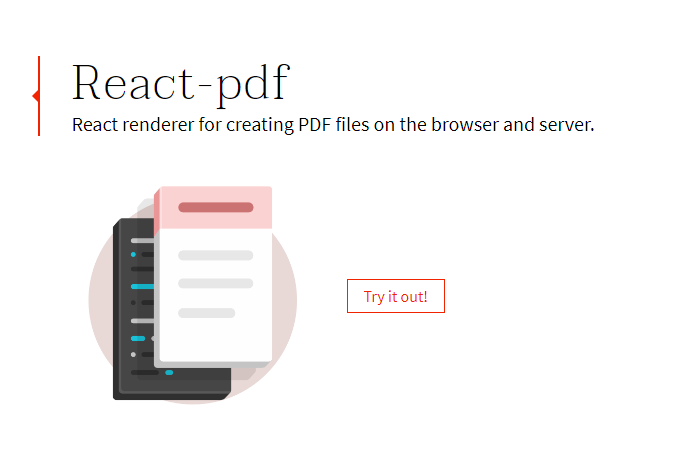 該套件用於使用 React 建立 PDF。 開始使用以下 npm 指令。 ``` npm install @react-pdf/renderer --save ``` 您可以這樣使用它。 ``` import React from 'react'; import { Document, Page, Text, View, StyleSheet } from '@react-pdf/renderer'; // Create styles const styles = StyleSheet.create({ page: { flexDirection: 'row', backgroundColor: '#E4E4E4', }, section: { margin: 10, padding: 10, flexGrow: 1, }, }); // Create Document Component const MyDocument = () => ( <Document> <Page size="A4" style={styles.page}> <View style={styles.section}> <Text>Section #1</Text> </View> <View style={styles.section}> <Text>Section #2</Text> </View> </Page> </Document> ); ```   您可以閱讀[文件](https://react-pdf.org/)並查看[演示](https://react-pdf.org/repl)。 React-pdf 現在提供了一個名為`usePDF`的鉤子,可以透過 React hook API 存取所有 PDF 建立功能。如果您需要更多控製文件的呈現方式或更新頻率,這非常有用。 ``` const [instance, update] = usePDF({ document }); ``` 該專案在 GitHub 上有 13k+ Stars,有超過 270 個版本,[每週下載量超過 400k](https://www.npmjs.com/package/@react-pdf/renderer) ,這是一個好兆頭。 https://github.com/diegomura/react-pdf Star React PDF ⭐️ --- 7. [Recharts](https://github.com/recharts/recharts) - 使用 React 和 D3 建立的重新定義的圖表庫。 -------------------------------------------------------------------------------- 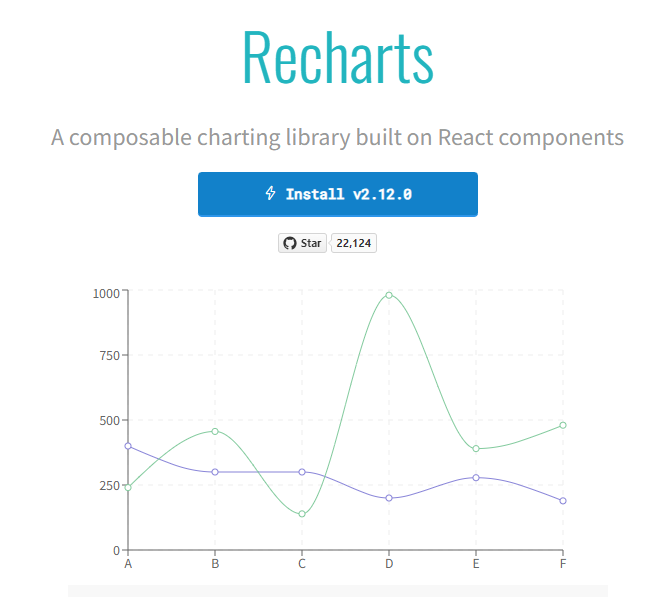 該庫的主要目的是幫助您輕鬆地在 React 應用程式中編寫圖表。 Recharts 的主要原則是。 1. 只需使用 React 元件進行部署即可。 2. 原生 SVG 支持,輕量級,僅依賴一些 D3 子模組。 3. 聲明性元件、圖表元件純粹是表示性的。 開始使用以下 npm 指令。 ``` npm install recharts ``` 您可以這樣使用它。 ``` <LineChart width={500} height={300} data={data} accessibilityLayer> <XAxis dataKey="name"/> <YAxis/> <CartesianGrid stroke="#eee" strokeDasharray="5 5"/> <Line type="monotone" dataKey="uv" stroke="#8884d8" /> <Line type="monotone" dataKey="pv" stroke="#82ca9d" /> <Tooltip/> </LineChart> ``` 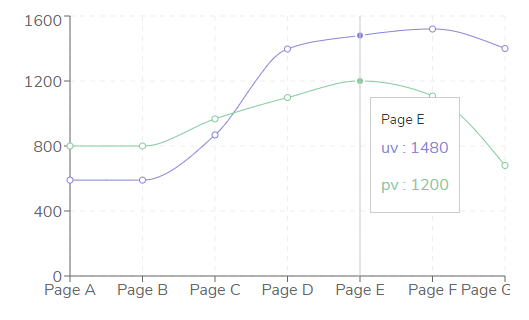 您可以閱讀[文件](https://recharts.org/en-US/guide)並查看有關[Storybook](https://recharts.org/en-US/storybook)的更多資訊。 他們提供了大量的選項來自訂它,這就是開發人員喜歡它的原因。他們也提供一般常見問題的[wiki](https://github.com/recharts/recharts/wiki)頁面。 您也可以在此處的codesandbox 上嘗試。 https://codesandbox.io/embed/kec3v?view=Editor+%2B+Preview&module=%2Fsrc%2Findex.tsx 該專案在 GitHub 上有 22k+ Stars,有 200k+ 開發人員使用。 https://github.com/recharts/recharts 明星 Recharts ⭐️ --- 8. [React Joyride](https://github.com/gilbarbara/react-joyride) - 在您的應用程式中建立導遊。 ------------------------------------------------------------------------------- 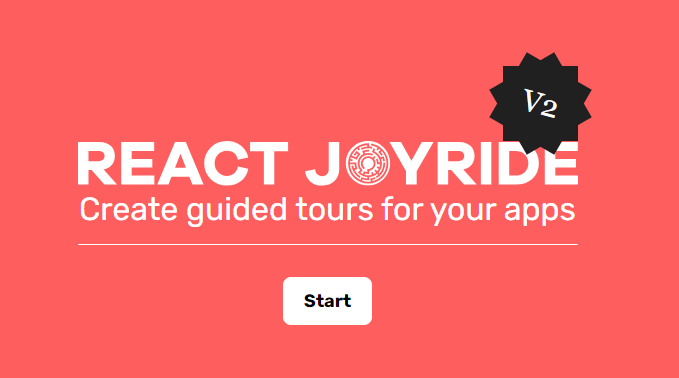 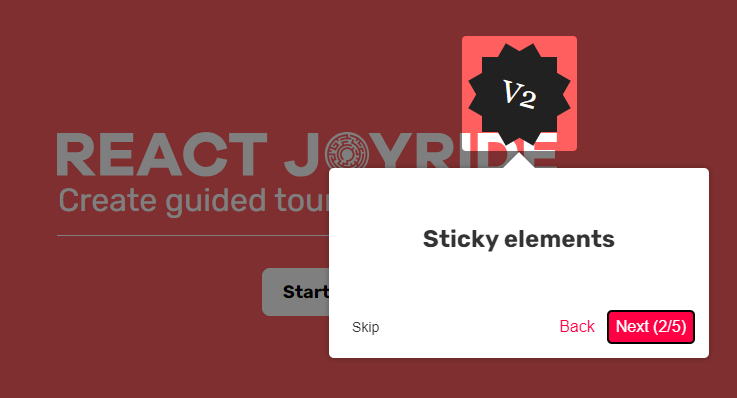 導覽是向新用戶展示您的應用程式或解釋新功能的絕佳方式。它改善了用戶體驗並可以創造個人化的觸感。 開始使用以下 npm 指令。 ``` npm i react-joyride ``` 您可以這樣使用它。 ``` import React, { useState } from 'react'; import Joyride from 'react-joyride'; /* * If your steps are not dynamic you can use a simple array. * Otherwise you can set it as a state inside your component. */ const steps = [ { target: '.my-first-step', content: 'This is my awesome feature!', }, { target: '.my-other-step', content: 'This another awesome feature!', }, ]; export default function App() { // If you want to delay the tour initialization you can use the `run` prop return ( <div> <Joyride steps={steps} /> ... </div> ); } ``` 它們還提供[元件列表](https://docs.react-joyride.com/custom-components)以及自訂預設用戶介面的簡單方法。 您可以閱讀[文件](https://docs.react-joyride.com/)並查看[演示](https://react-joyride.com/)。 您也可以嘗試[codesandbox](https://codesandbox.io/p/devbox/github/gilbarbara/react-joyride-demo/tree/main/?embed=1)上的東西。 他們在 GitHub 上有超過 6k 顆星,npm 套件每週下載量超過 25 萬次。 https://github.com/gilbarbara/react-joyride Star React Joyride ⭐️ --- 9. [SVGR](https://github.com/gregberge/svgr) - 將 SVG 轉換為 React 元件。 ------------------------------------------------------------------  SVGR 是一個將 SVG 轉換為 React 元件的通用工具。 它需要一個原始的 SVG 並將其轉換為隨時可用的 React 元件。 開始使用以下 npm 指令。 ``` npm install @svgr/core ``` 例如,您採用這個 SVG。 ``` <?xml version="1.0" encoding="UTF-8"?> <svg width="48px" height="1px" viewBox="0 0 48 1" version="1.1" xmlns="http://www.w3.org/2000/svg" xmlns:xlink="http://www.w3.org/1999/xlink" > <!-- Generator: Sketch 46.2 (44496) - http://www.bohemiancoding.com/sketch --> <title>Rectangle 5</title> <desc>Created with Sketch.</desc> <defs></defs> <g id="Page-1" stroke="none" stroke-width="1" fill="none" fill-rule="evenodd"> <g id="19-Separator" transform="translate(-129.000000, -156.000000)" fill="#063855" > <g id="Controls/Settings" transform="translate(80.000000, 0.000000)"> <g id="Content" transform="translate(0.000000, 64.000000)"> <g id="Group" transform="translate(24.000000, 56.000000)"> <g id="Group-2"> <rect id="Rectangle-5" x="25" y="36" width="48" height="1"></rect> </g> </g> </g> </g> </g> </g> </svg> ``` 執行SVGR後,將轉換為. ``` import * as React from 'react' const SvgComponent = (props) => ( <svg width="1em" height="1em" viewBox="0 0 48 1" {...props}> <path d="M0 0h48v1H0z" fill="currentColor" fillRule="evenodd" /> </svg> ) export default SvgComponent ``` 它使用[SVGO](https://github.com/svg/svgo)優化 SVG,並使用 Prettier 格式化程式碼。 將 HTML 轉換為 JSX 需要幾個步驟: 1. 將 SVG 轉換為 HAST (HTML AST) 2. 將 HAST 轉換為 Babel AST (JSX AST) 3. 使用 Babel 轉換 AST(重新命名屬性、更改屬性值…) 您可以在[Playground](https://react-svgr.com/playground/)閱讀[文件](https://react-svgr.com/docs/getting-started)並檢查內容。 該專案在 GitHub 上擁有 10k+ Stars,有超過 800 萬開發者使用,npm 上每週下載量超過 800k。 https://github.com/gregberge/svgr 明星 SVGR ⭐️ --- 10. [React Sortable Tree](https://github.com/frontend-collective/react-sortable-tree) - 用於巢狀資料和層次結構的拖放可排序元件。 ------------------------------------------------------------------------------------------------------------ 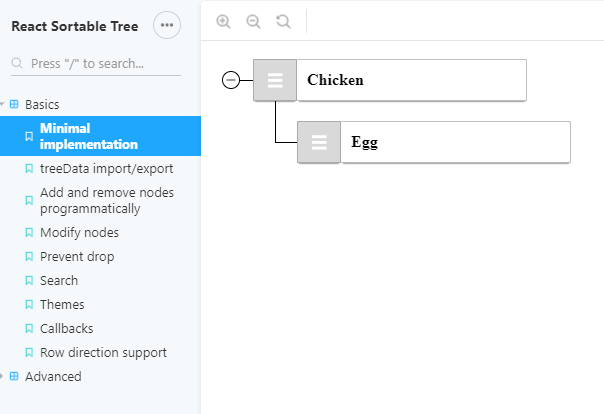 一個 React 元件,支援對分層資料進行拖放排序。  開始使用以下 npm 指令。 ``` npm install react-sortable-tree --save ``` 您可以這樣使用它。 ``` import React, { Component } from 'react'; import SortableTree from 'react-sortable-tree'; import 'react-sortable-tree/style.css'; // This only needs to be imported once in your app export default class Tree extends Component { constructor(props) { super(props); this.state = { treeData: [ { title: 'Chicken', children: [{ title: 'Egg' }] }, { title: 'Fish', children: [{ title: 'fingerline' }] }, ], }; } render() { return ( <div style={{ height: 400 }}> <SortableTree treeData={this.state.treeData} onChange={treeData => this.setState({ treeData })} /> </div> ); } } ``` 檢查由此獲得的各種[道具選項](https://github.com/frontend-collective/react-sortable-tree?tab=readme-ov-file#props)和[主題](https://github.com/frontend-collective/react-sortable-tree?tab=readme-ov-file#featured-themes)。 您可以閱讀[文件](https://github.com/frontend-collective/react-sortable-tree?tab=readme-ov-file#getting-started)並查看[Storybook](https://frontend-collective.github.io/react-sortable-tree/?path=/story/basics--minimal-implementation) ,以獲取一些基本和高級功能的演示。 它可能不會被積極維護(仍然沒有存檔),因此您也可以使用[維護的 fork 版本](https://github.com/nosferatu500/react-sortable-tree)。 該專案在 GitHub 上擁有超過 4,500 個 Star,並被超過 5,000 名開發人員使用。 https://github.com/frontend-collective/react-sortable-tree Star React 可排序樹 ⭐️ --- 11. [React Hot Toast](https://github.com/timolins/react-hot-toast) - 冒煙的 Hot React 通知。 --------------------------------------------------------------------------------------  React Hot Toast 透過簡單的自訂選項提供了驚人的 🔥 預設體驗。它利用 Promise API 進行自動加載,確保平穩過渡。 它重量輕,不到 5kb,但仍然可以存取,同時為開發人員提供了像`useToaster()`這樣的無頭鉤子。 首先將 Toaster 加入到您的應用程式中。它將負責渲染發出的所有通知。現在您可以從任何地方觸發 toast() ! 開始使用以下 npm 指令。 ``` npm install react-hot-toast ``` 這就是它的易用性。 ``` import toast, { Toaster } from 'react-hot-toast'; const notify = () => toast('Here is your toast.'); const App = () => { return ( <div> <button onClick={notify}>Make me a toast</button> <Toaster /> </div> ); }; ``` 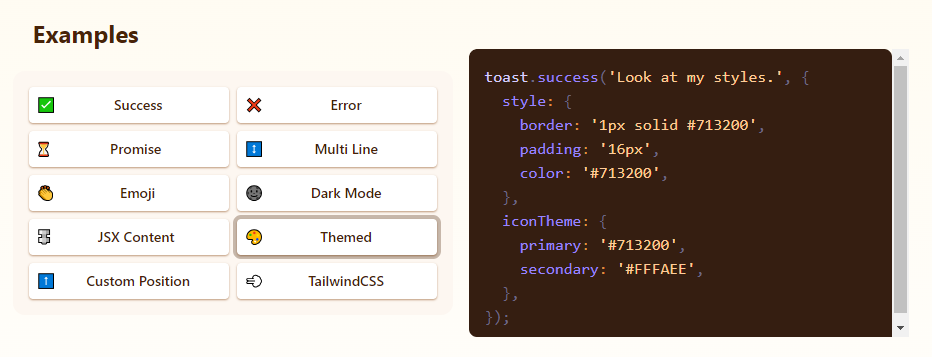  他們有很多自訂選項,但`useToaster()`掛鉤為您提供了一個無頭系統,可以為您管理通知狀態。這使得建立您的通知系統變得更加容易。 您可以閱讀[文件](https://react-hot-toast.com/docs)、[樣式指南](https://react-hot-toast.com/docs/styling)並查看[示範](https://react-hot-toast.com/)。 該專案在 GitHub 上有 8k+ Stars,有 230k+ 開發者使用。 https://github.com/timolins/react-hot-toast Star React Hot Toast ⭐️ --- 12. [Payload](https://github.com/payloadcms/payload) - 建立現代後端+管理 UI 的最佳方式。 -------------------------------------------------------------------------- 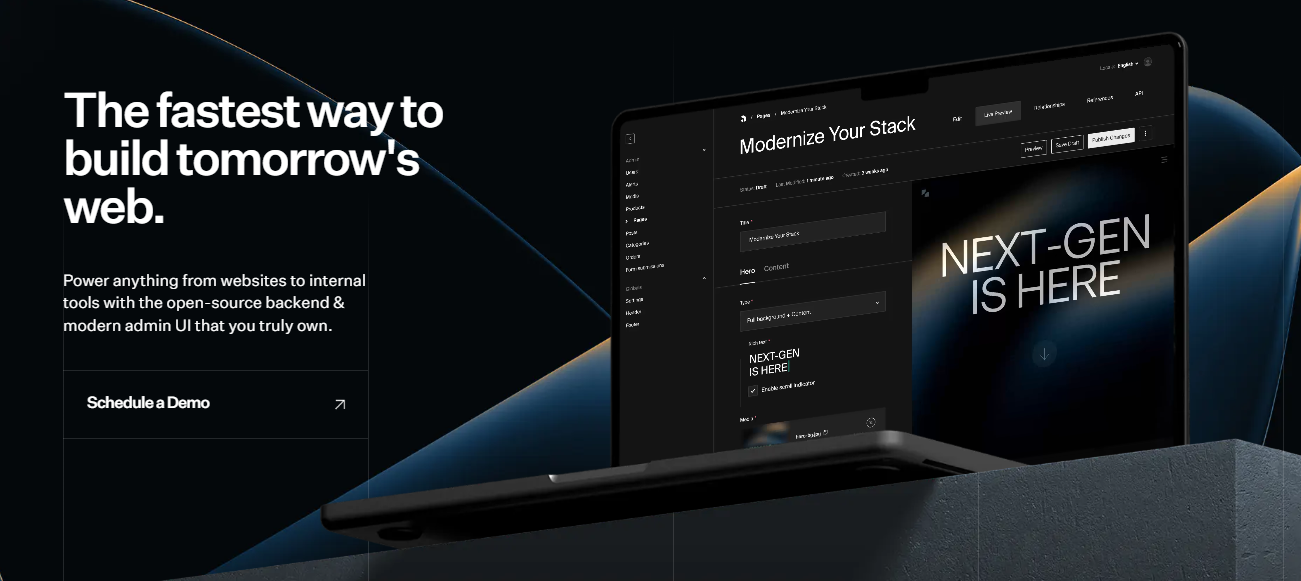 Payload 是一個無頭 CMS 和應用程式框架。它旨在促進您的開發過程,但重要的是,當您的應用程式變得更加複雜時,不要妨礙您。 Payload 沒有黑魔法,完全開源,它既是一個應用程式框架,也是一個無頭 CMS。它確實是適用於 TypeScript 的 Rails,並且您會獲得一個管理面板。您可以使用此[YouTube 影片](https://www.youtube.com/watch?v=In_lFhzmbME)了解有關 Payload 的更多資訊。 https://www.youtube.com/watch?v=In\_lFhzmbME 您可以透過使用Payload來了解[其中涉及的概念](https://payloadcms.com/docs/getting-started/concepts)。 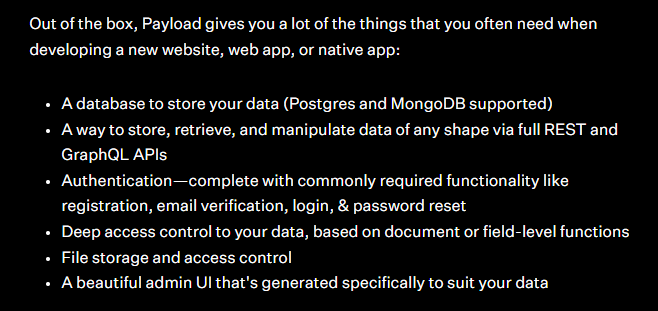 有效負載透過您選擇的資料庫適配器與您的資料庫進行互動。目前,Payload 正式支援兩種資料庫適配器: 1. MongoDB 與 Mongoose 2. Postgres 帶毛毛雨 開始使用以下命令。 ``` npx create-payload-app@latest ``` 您必須產生 Payload 金鑰並更新`server.ts`以初始化 Payload。 ``` import express from 'express' import payload from 'payload' require('dotenv').config() const app = express() const start = async () => { await payload.init({ secret: process.env.PAYLOAD_SECRET, express: app, }) app.listen(3000, async () => { console.log( "Express is now listening for incoming connections on port 3000." ) }) } start() ``` 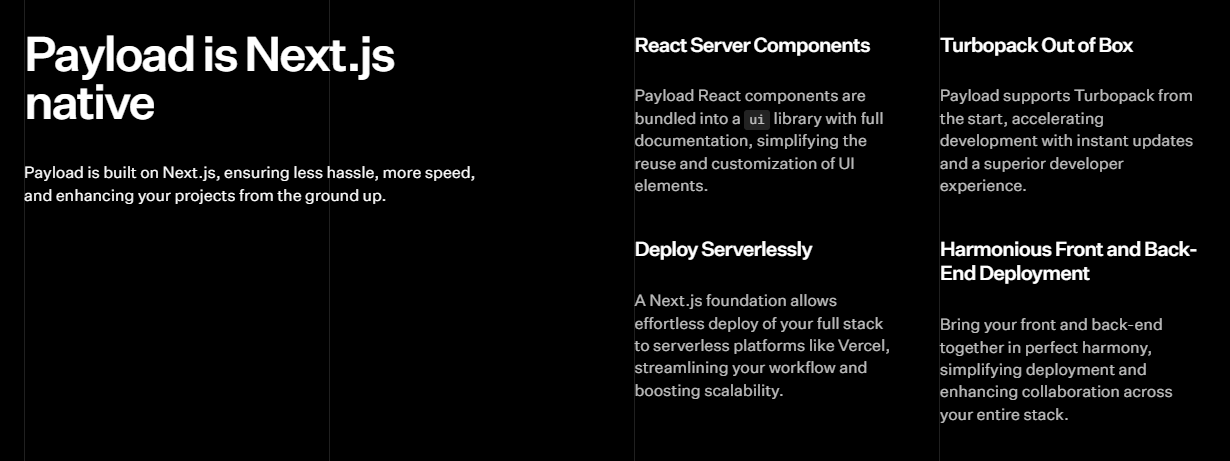 您可以閱讀[文件](https://payloadcms.com/docs/getting-started/what-is-payload)並查看[演示](https://demo.payloadcms.com/?_gl=1*9x0za3*_ga*NzEzMzkwNzIuMTcxMDE2NDk1MA..*_ga_FLQ5THRMZQ*MTcxMDE2NDk1MC4xLjEuMTcxMDE2NDk1MS4wLjAuMA..)。 他們還提供與 Payload + Stripe 無縫整合的[電子商務模板](https://github.com/payloadcms/payload/tree/main/templates/ecommerce)。此範本具有令人驚嘆的、功能齊全的前端,包括購物車、結帳流程、訂單管理等元件。 Payload 在 GitHub 上擁有 18k+ Stars,並且有超過 290 個版本,因此它們不斷改進,尤其是在資料庫支援方面。 https://github.com/payloadcms/payload 明星有效負載 ⭐️ --- 13. [React Player](https://github.com/cookpete/react-player) - 用於播放各種 URL 的 React 元件。 ------------------------------------------------------------------------------------- 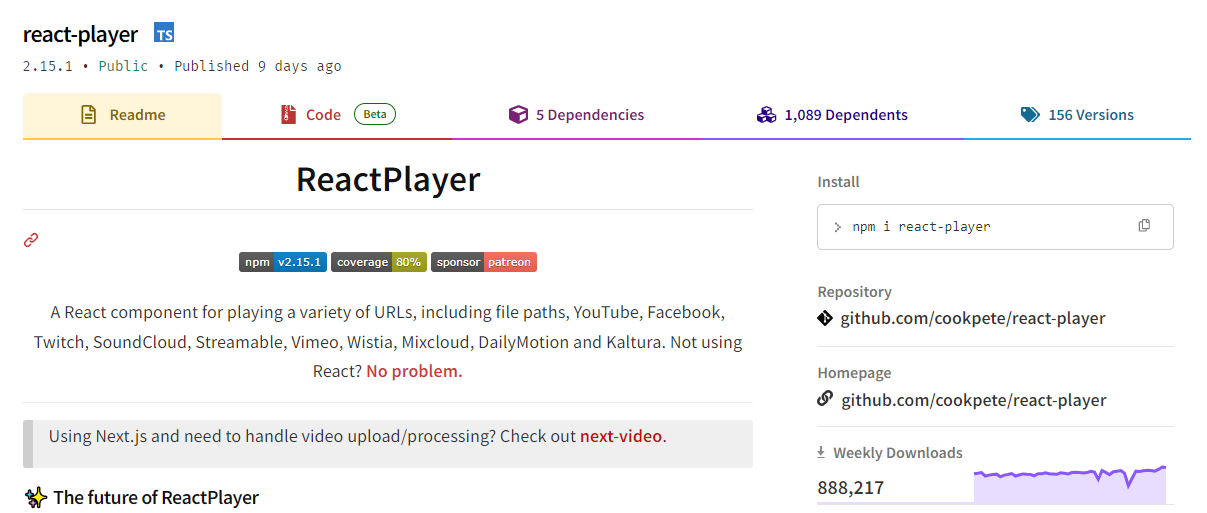 用於播放各種 URL 的 React 元件,包括檔案路徑、YouTube、Facebook、Twitch、SoundCloud、Streamable、Vimeo、Wistia、Mixcloud、DailyMotion 和 Kaltura。您可以看到[支援的媒體](https://github.com/cookpete/react-player?tab=readme-ov-file#supported-media)清單。 ReactPlayer 的維護工作由 Mux 接管,這使它們成為一個不錯的選擇。 開始使用以下 npm 指令。 ``` npm install react-player ``` 您可以這樣使用它。 ``` import React from 'react' import ReactPlayer from 'react-player' // Render a YouTube video player <ReactPlayer url='https://www.youtube.com/watch?v=LXb3EKWsInQ' /> // If you only ever use one type, use imports such as react-player/youtube to reduce your bundle size. // like this: import ReactPlayer from 'react-player/youtube' ``` 您也可以使用`react-player/lazy`為您傳入的URL 延遲載入適當的播放器。這會為您的輸出加入幾個reactPlayer 區塊,但會減少主包的大小。 ``` import React from 'react' import ReactPlayer from 'react-player/lazy' // Lazy load the YouTube player <ReactPlayer url='https://www.youtube.com/watch?v=ysz5S6PUM-U' /> ``` 您可以閱讀[文件](https://github.com/cookpete/react-player?tab=readme-ov-file#props)並查看[演示](https://cookpete.github.io/react-player/)。他們提供了大量的選項,包括加入字幕並以簡單的方式使其響應。 它們在 GitHub 上擁有超過 8000 顆星,被超過 135,000 名開發人員使用,並且 npm 軟體包[每週的下載量超過 800k](https://www.npmjs.com/package/react-player) 。 https://github.com/cookpete/react-player 明星 React 播放器 ⭐️ --- 14. [Victory](https://github.com/FormidableLabs/victory) - 用於建立互動式資料視覺化的 React 元件。 ----------------------------------------------------------------------------------  Victory 是一個可組合 React 元件的生態系統,用於建立互動式資料視覺化。 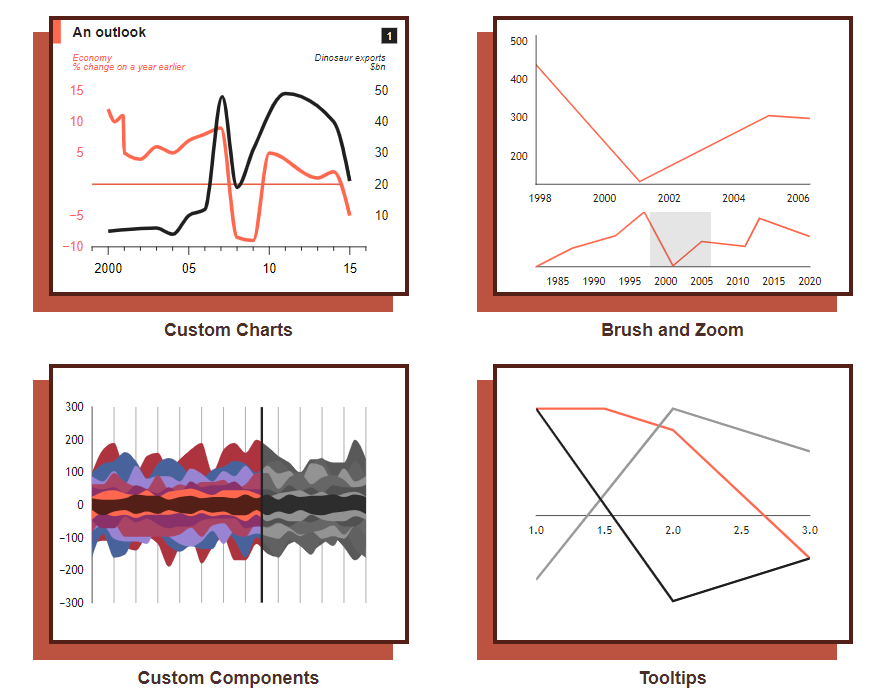 開始使用以下 npm 指令。 ``` npm i --save victory ``` 您可以這樣使用它。 ``` <VictoryChart domainPadding={{ x: 20 }} > <VictoryHistogram style={{ data: { fill: "#c43a31" } }} data={sampleHistogramDateData} bins={[ new Date(2020, 1, 1), new Date(2020, 4, 1), new Date(2020, 8, 1), new Date(2020, 11, 1) ]} /> </VictoryChart> ``` 這就是它的渲染方式。他們還提供通常有用的動畫和主題選項。 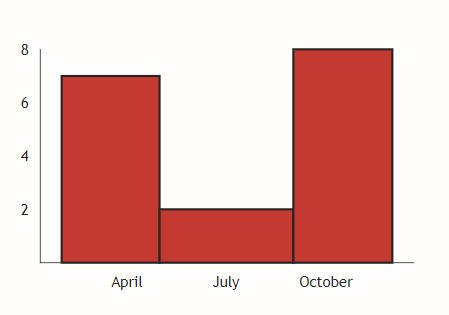 您可以閱讀[文件](https://commerce.nearform.com/open-source/victory/docs)並按照[教學](https://commerce.nearform.com/open-source/victory/docs/native)開始。他們提供大約 15 種不同的圖表選項。 它也可用於[React Native(文件)](https://commerce.nearform.com/open-source/victory/docs/native) ,所以這是一個優點。我還建議您查看他們的常見[問題解答](https://commerce.nearform.com/open-source/victory/docs/faq#frequently-asked-questions-faq),其中描述了常見問題的程式碼解決方案和解釋,例如樣式、註釋(標籤)、處理軸。 該專案在 GitHub 上擁有 10k+ Stars,並在 GitHub 上有 23k+ 開發人員使用。 https://github.com/FormidableLabs/victory 勝利之星 ⭐️ --- 15. [React Slick](https://github.com/akiran/react-slick) - React 輪播元件。 ----------------------------------------------------------------------  React Slick 是一個使用 React 建構的輪播元件。它是一個光滑的旋轉木馬的反應端口 開始使用以下 npm 指令。 ``` npm install react-slick --save ``` 這是使用自訂分頁的方法。 ``` import React, { Component } from "react"; import Slider from "react-slick"; import { baseUrl } from "./config"; function CustomPaging() { const settings = { customPaging: function(i) { return ( <a> <img src={`${baseUrl}/abstract0${i + 1}.jpg`} /> </a> ); }, dots: true, dotsClass: "slick-dots slick-thumb", infinite: true, speed: 500, slidesToShow: 1, slidesToScroll: 1 }; return ( <div className="slider-container"> <Slider {...settings}> <div> <img src={baseUrl + "/abstract01.jpg"} /> </div> <div> <img src={baseUrl + "/abstract02.jpg"} /> </div> <div> <img src={baseUrl + "/abstract03.jpg"} /> </div> <div> <img src={baseUrl + "/abstract04.jpg"} /> </div> </Slider> </div> ); } export default CustomPaging; ```  您可以閱讀有關可用的[prop 選項](https://react-slick.neostack.com/docs/api)和[方法](https://react-slick.neostack.com/docs/api#methods)的資訊。 您可以閱讀[文件](https://react-slick.neostack.com/docs/get-started)和所有帶有程式碼和輸出[的範例集](https://react-slick.neostack.com/docs/example/)。 他們在 GitHub 上有超過 11k 顆星,並且有超過 36 萬開發者在 GitHub 上使用它。 https://github.com/akiran/react-slick Star React Slick ⭐️ --- 16. [Medusa](https://github.com/medusajs/medusa) - 數位商務的建構模組。 -------------------------------------------------------------  Medusa 是一組商務模組和工具,可讓您建立豐富、可靠且高效能的商務應用程式,而無需重新發明核心商務邏輯。 這些模組可以客製化並用於建立高級電子商務商店、市場或任何需要基礎商務原語的產品。所有模組都是開源的,可以在 npm 上免費取得。 開始使用以下 npm 指令。 ``` npm install medusa-react @tanstack/[email protected] @medusajs/medusa ``` 將其包含在`app.ts`中。 只有 MedusaProvider 的子級才能從其鉤子中受益。因此,Storefront 元件及其子元件現在可以使用 Medusa React 公開的鉤子。 ``` import { MedusaProvider } from "medusa-react" import Storefront from "./Storefront" import { QueryClient } from "@tanstack/react-query" import React from "react" const queryClient = new QueryClient() const App = () => { return ( <MedusaProvider queryClientProviderProps={{ client: queryClient }} baseUrl="http://localhost:9000" > <Storefront /> </MedusaProvider> ) } export default App ``` 例如,這就是您如何使用突變來建立購物車。 ``` import { useCreateCart } from "medusa-react" const Cart = () => { const createCart = useCreateCart() const handleClick = () => { createCart.mutate({}) // create an empty cart } return ( <div> {createCart.isLoading && <div>Loading...</div>} {!createCart.data?.cart && ( <button onClick={handleClick}> Create cart </button> )} {createCart.data?.cart?.id && ( <div>Cart ID: {createCart.data?.cart.id}</div> )} </div> ) } export default Cart ``` 他們提供了一套電子商務模組(大量選項),例如折扣、價目表、禮品卡等。 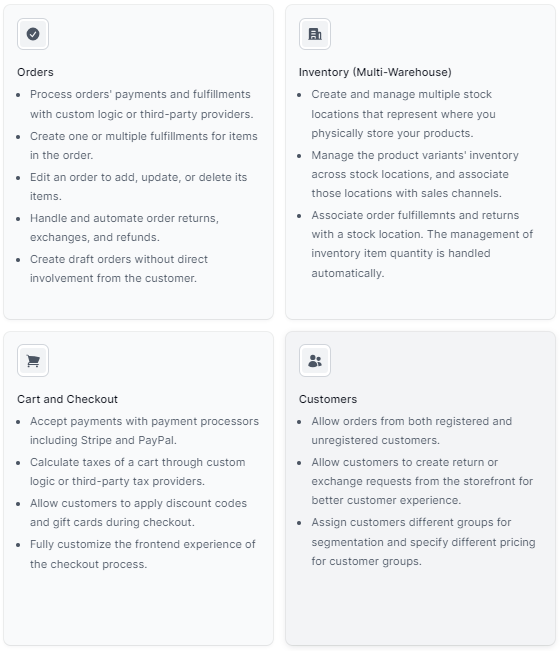 它們還提供了一種簡單的管理員和客戶身份驗證方法,您可以在[文件](https://docs.medusajs.com/)中閱讀。 他們提供了[nextjs 入門模板](https://docs.medusajs.com/starters/nextjs-medusa-starter)和[Medusa React](https://docs.medusajs.com/medusa-react/overview)作為 SDK。 該專案在 GitHub 上有 22k+ Stars,有 4k+ 開發者使用。 https://github.com/medusajs/medusa 明星美杜莎 ⭐️ --- 17. [React Markdown](https://github.com/remarkjs/react-markdown) - React 的 Markdown 元件. --------------------------------------------------------------------------------------- 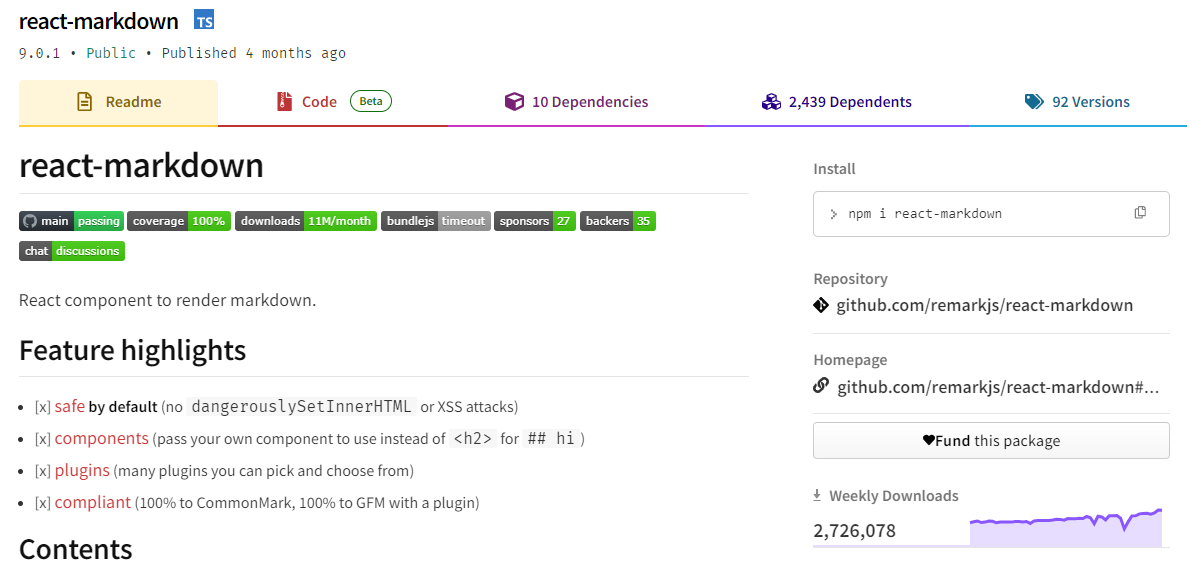 Markdown 至關重要,使用 React 渲染它對於各種場景都非常有用。 它提供了一個 React 元件,能夠安全地將一串 Markdown 渲染到 React 元素中。您可以透過傳遞外掛程式並指定要使用的元件而不是標準 HTML 元素來自訂 Markdown 的轉換。 開始使用以下 npm 指令。 ``` npm i react-markdown ``` 您可以這樣使用它。 ``` import React from 'react' import {createRoot} from 'react-dom/client' import Markdown from 'react-markdown' import remarkGfm from 'remark-gfm' const markdown = `Just a link: www.nasa.gov.` createRoot(document.body).render( <Markdown remarkPlugins={[remarkGfm]}>{markdown}</Markdown> ) ``` 等效的 JSX 是。 ``` <p> Just a link: <a href="http://www.nasa.gov">www.nasa.gov</a>. </p> ``` 他們還提供了一份[備忘錄](https://commonmark.org/help/)和一個十分鐘的逐步[教學](https://commonmark.org/help/tutorial/)。 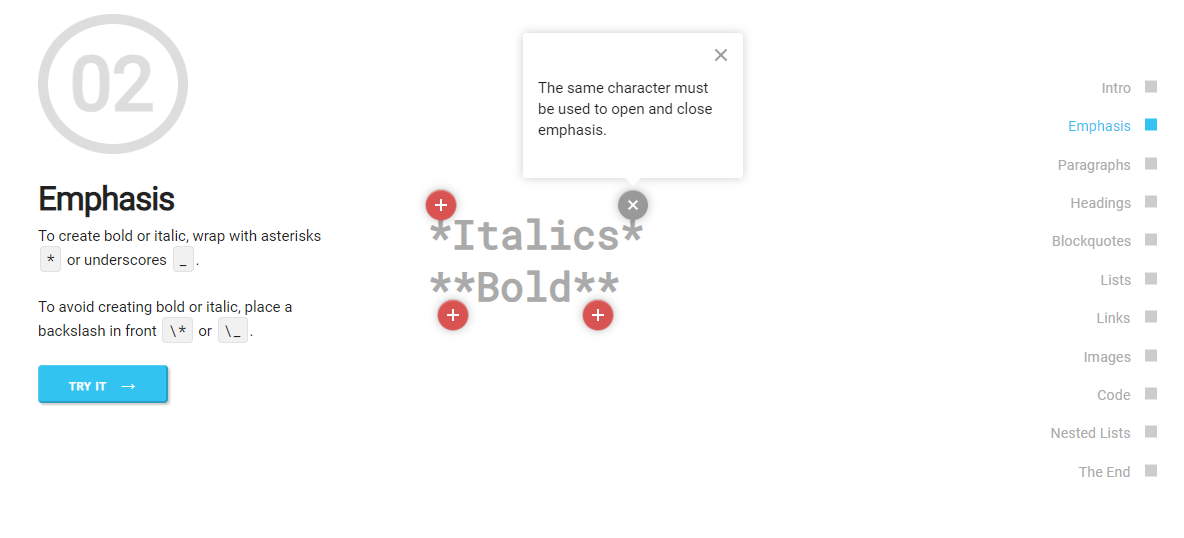 您可以閱讀[文件](https://github.com/remarkjs/react-markdown?tab=readme-ov-file#install)並查看[演示](https://remarkjs.github.io/react-markdown/)。 該專案在 GitHub 上有 12k+ Stars,[每週下載量超過 2700k](https://www.npmjs.com/package/react-markdown) ,並被 200k+ 開發人員使用,證明了它的真正有用性。 https://github.com/remarkjs/react-markdown Star React Markdown ⭐️ --- 18. [React JSONSchema Form](https://github.com/rjsf-team/react-jsonschema-form) - 用於從 JSON Schema 建立 Web 表單。 ------------------------------------------------------------------------------------------------------------ 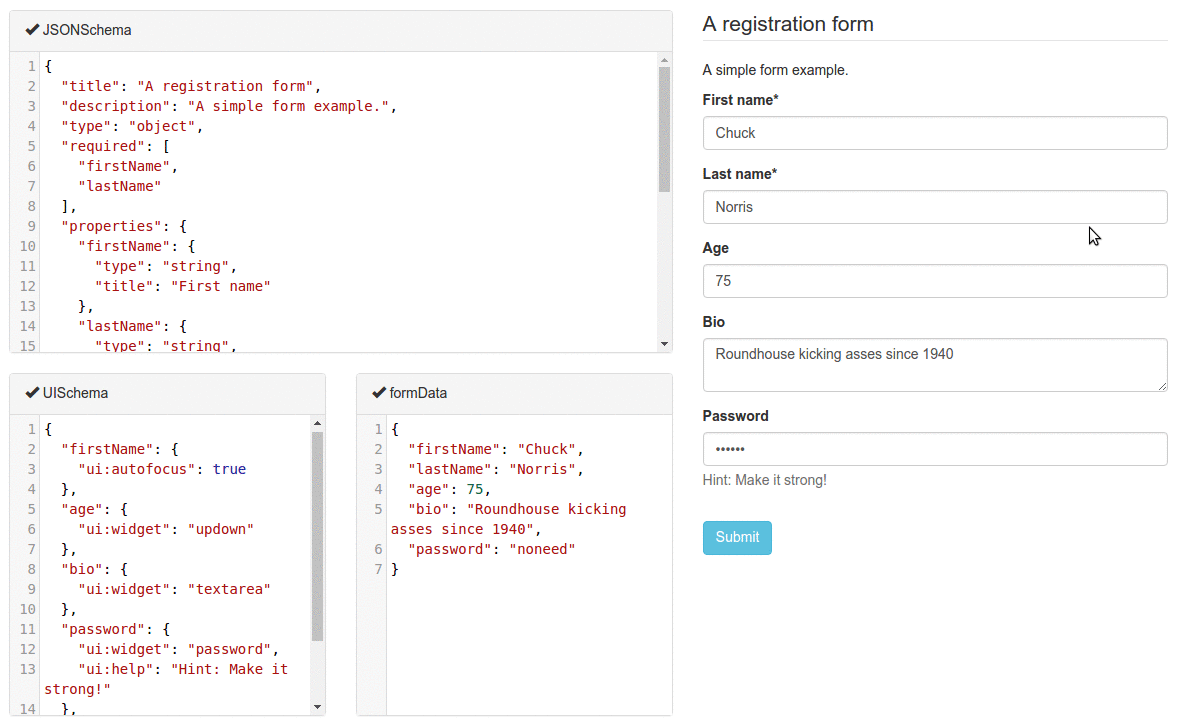 `react-jsonschema-form`會自動從 JSON Schema 產生 React 表單,使其非常適合僅使用 JSON schema 為任何資料產生表單。它提供了像 uiSchema 這樣的自訂選項來自訂預設主題之外的表單外觀。 開始使用以下 npm 指令。 ``` npm install @rjsf/core @rjsf/utils @rjsf/validator-ajv8 --save ``` 您可以這樣使用它。 ``` import { RJSFSchema } from '@rjsf/utils'; import validator from '@rjsf/validator-ajv8'; const schema: RJSFSchema = { title: 'Todo', type: 'object', required: ['title'], properties: { title: { type: 'string', title: 'Title', default: 'A new task' }, done: { type: 'boolean', title: 'Done?', default: false }, }, }; const log = (type) => console.log.bind(console, type); render( <Form schema={schema} validator={validator} onChange={log('changed')} onSubmit={log('submitted')} onError={log('errors')} />, document.getElementById('app') ); ``` 他們提供[高級定制](https://rjsf-team.github.io/react-jsonschema-form/docs/advanced-customization/)選項,包括定制小部件。 您可以閱讀[文件](https://rjsf-team.github.io/react-jsonschema-form/docs/)並查看[即時遊樂場](https://rjsf-team.github.io/react-jsonschema-form/)。 它在 GitHub 上擁有超過 13k 個 Star,並被 5k+ 開發人員使用。他們在`v5`上發布了 190 多個版本,因此他們正在不斷改進。 https://github.com/rjsf-team/react-jsonschema-form Star React JSONSchema 表單 ⭐️ --- 19. [Craft.js](https://github.com/prevwong/craft.js) - 建立可擴充的拖放頁面編輯器。 ---------------------------------------------------------------------  頁面編輯器可以增強使用者體驗,但從頭開始建立頁面編輯器可能會令人望而生畏。現有庫提供具有可編輯元件的預先建置編輯器,但自訂通常需要修改庫本身。 Craft.js 透過模組化頁面編輯器元件、透過拖放功能簡化自訂以及渲染管理來解決這個問題。在 React 中設計你的編輯器,無需複雜的插件系統,專注於你的特定需求和規格。 開始使用以下 npm 指令。 ``` npm install --save @craftjs/core ``` 他們還提供了有關如何入門的[簡短教程](https://craft.js.org/docs/guides/basic-tutorial)。我不會介紹它,因為它非常簡單且詳細。 您可以閱讀[文件](https://craft.js.org/docs/overview)並查看[即時演示](https://craft.js.org/)以及另一個[即時範例](https://craft.js.org/examples/basic)。 它在 GitHub 上有大約 6k+ Stars,但考慮到它們正在改進,仍然很有用。 https://github.com/prevwong/craft.js Star Craft.js ⭐️ --- 20. [Gatsby](https://github.com/gatsbyjs/gatsby) - 最好的基於 React 的框架,具有內建的效能、可擴展性和安全性。 ------------------------------------------------------------------------------------  Gatsby 是一個基於 React 的框架,使開發人員能夠建立閃電般快速的網站和應用程式,將動態渲染的靈活性與靜態網站生成的速度融為一體。 憑藉可自訂的 UI 和對各種資料來源的支援等功能,Gatsby 提供了無與倫比的控制和可擴展性。此外,它還可以自動進行效能最佳化,使其成為靜態網站的首選。 開始使用以下 npm 指令。 ``` npm init gatsby ``` 這就是如何在 Gatsby(反應元件)中使用`Link` 。 ``` import React from "react" import { Link } from "gatsby" const Page = () => ( <div> <p> Check out my <Link to="/blog">blog</Link>! </p> <p> {/* Note that external links still use `a` tags. */} Follow me on <a href="https://twitter.com/gatsbyjs">Twitter</a>! </p> </div> ) ``` 他們提供了一組[入門模板,](https://www.gatsbyjs.com/starters/)其中包含如何使用它、涉及的依賴項以及每個模板的演示。  您可以閱讀有關 Gatsby 的一些[常見概念,](https://www.gatsbyjs.com/docs/conceptual/gatsby-concepts/)例如 React Hydration、Gatsby 建置流程等。 您可以閱讀[文件](https://www.gatsbyjs.com/docs/)並查看入門[教學課程](https://www.gatsbyjs.com/docs/tutorial/)。 Gatsby 在 GitHub 上擁有超過 55,000 顆星,並被超過 240,000 名開發者使用 https://github.com/gatsbyjs/gatsby 明星蓋茲比 ⭐️ --- 21. [Chat UI Kit React](https://github.com/chatscope/chat-ui-kit-react) - 在幾分鐘內使用 React 建立您的聊天 UI。 -------------------------------------------------------------------------------------------------- 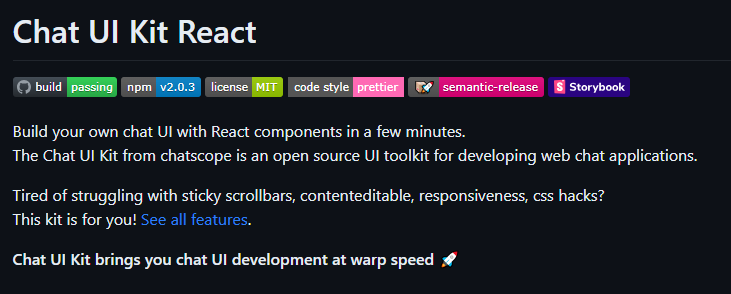 Chatscope 的聊天 UI 工具包是一個用於開發網頁聊天應用程式的開源 UI 工具包。 儘管該專案並未廣泛使用,但這些功能對於剛剛查看該專案的初學者來說還是很有用的。  開始使用以下 npm 指令。 ``` npm install @chatscope/chat-ui-kit-react ``` 這就是建立 GUI 的方法。 ``` import styles from '@chatscope/chat-ui-kit-styles/dist/default/styles.min.css'; import { MainContainer, ChatContainer, MessageList, Message, MessageInput } from '@chatscope/chat-ui-kit-react'; <div style={{ position:"relative", height: "500px" }}> <MainContainer> <ChatContainer> <MessageList> <Message model={{ message: "Hello my friend", sentTime: "just now", sender: "Joe" }} /> </MessageList> <MessageInput placeholder="Type message here" /> </ChatContainer> </MainContainer> </div> ``` 您可以閱讀[文件](https://chatscope.io/docs/)。 故事書中有更[詳細的文件](https://chatscope.io/storybook/react/?path=/docs/documentation-introduction--docs)。 它提供了一些方便的元件,例如[`TypingIndicator`](https://chatscope.io/storybook/react/?path=/docs/components-typingindicator--docs) 、 [`Multiline Incoming`](https://chatscope.io/storybook/react/?path=/story/components-message--multiline-incoming)等等。 我知道你們中的一些人更喜歡透過部落格來了解整個結構,因此你可以閱讀使用 Chat UI Kit React 的 Rollbar 的[如何將 ChatGPT 與 React 整合](https://rollbar.com/blog/how-to-integrate-chatgpt-with-react/)。 您可以看到的一些演示: - [聊天機器人使用者介面](https://mars.chatscope.io/) - [與朋友聊天](https://chatscope.io/demo/chat-friends/)- 看看這個!  https://github.com/chatscope/chat-ui-kit-react Star Chat UI Kit React ⭐️ --- 22. [Botonic](https://github.com/hubtype/botonic) - 用於建立會話應用程式的 React 框架。 -------------------------------------------------------------------------  Botonic 是一個全端 Javascript 框架,用於建立在多個平台上執行的聊天機器人和現代對話應用程式:Web、行動和訊息應用程式(Messenger、WhatsApp、Telegram 等)。它建構在 ⚛️ React、Serverless 和 Tensorflow.js 之上。 如果您不了解對話應用程式的概念,可以在[官方部落格](https://www.hubtype.com/blog/what-are-conversational-apps)上閱讀它們。 使用 Botonic,您可以建立包含最佳文字外介面(簡單性、自然語言互動)和圖形介面(多媒體、視覺上下文、豐富互動)的會話應用程式。 這是一個強大的組合,可以提供比僅依賴文字和 NLP 的傳統聊天機器人更好的用戶體驗。 這就是 Botonic 的簡單方式。 ``` export default class extends React.Component { static async botonicInit({ input, session, params, lastRoutePath }) { await humanHandOff(session)) } render() { return ( <Text> Thanks for contacting us! One of our agents will attend you as soon as possible. </Text> ) } } ``` 它們也支援 TypeScript,所以這是一個優點。 您可以看到一些使用 Botonic 建置的[範例](https://botonic.io/examples/)及其原始程式碼。 您可以閱讀[文件](https://botonic.io/docs/welcome)以及如何[從頭開始建立會話應用程式](https://botonic.io/docs/create-convapp)。 https://github.com/hubtype/botonic Star Botonic ⭐️ --- 23. [React Flowbite](https://github.com/themesberg/flowbite-react) - 為 Flowbite 和 Tailwind CSS 建構的 React 元件. ------------------------------------------------------------------------------------------------------------  每個人對他們想要用來建立網站的使用者介面都有不同的偏好。 Flowbite React 是 UI 元件的開源集合,在 React 中建置,具有來自 Tailwind CSS 的實用程式類,您可以將其用作使用者介面和網站的起點。 開始使用以下 npm 指令。 ``` npm i flowbite-react ``` 這是一起使用表格和鍵盤元件的方法。 ``` 'use client'; import { Kbd, Table } from 'flowbite-react'; import { MdKeyboardArrowDown, MdKeyboardArrowLeft, MdKeyboardArrowRight, MdKeyboardArrowUp } from 'react-icons/md'; function Component() { return ( <Table> <Table.Head> <Table.HeadCell>Key</Table.HeadCell> <Table.HeadCell>Description</Table.HeadCell> </Table.Head> <Table.Body className="divide-y"> <Table.Row className="bg-white dark:border-gray-700 dark:bg-gray-800"> <Table.Cell className="whitespace-nowrap font-medium text-gray-900 dark:text-white"> <Kbd>Shift</Kbd> <span>or</span> <Kbd>Tab</Kbd> </Table.Cell> <Table.Cell>Navigate to interactive elements</Table.Cell> </Table.Row> <Table.Row className="bg-white dark:border-gray-700 dark:bg-gray-800"> <Table.Cell className="whitespace-nowrap font-medium text-gray-900 dark:text-white"> <Kbd>Enter</Kbd> or <Kbd>Spacebar</Kbd> </Table.Cell> <Table.Cell>Ensure elements with ARIA role="button" can be activated with both key commands.</Table.Cell> </Table.Row> <Table.Row className="bg-white dark:border-gray-700 dark:bg-gray-800"> <Table.Cell className="whitespace-nowrap font-medium text-gray-900 dark:text-white"> <span className="inline-flex gap-1"> <Kbd icon={MdKeyboardArrowUp} /> <Kbd icon={MdKeyboardArrowDown} /> </span> <span> or </span> <span className="inline-flex gap-1"> <Kbd icon={MdKeyboardArrowLeft} /> <Kbd icon={MdKeyboardArrowRight} /> </span> </Table.Cell> <Table.Cell>Choose and activate previous/next tab.</Table.Cell> </Table.Row> </Table.Body> </Table> ); } ```  您可以閱讀[文件](https://www.flowbite-react.com/docs/getting-started/introduction)並查看[Storybook](https://storybook.flowbite-react.com/?path=/story/components-accordion--always-open)中的功能。您也可以查看[元件](https://www.flowbite-react.com/docs/components/accordion)清單。 在我看來,如果您想快速設定 UI,但又不想最終為高品質的開源專案使用預先定義的庫元件,那麼這很好。 該專案在 GitHub 上擁有超過 1,500 顆星,擁有超過 37,000 名開發者的用戶群,並受到社群的廣泛認可和信任,使其成為一個可靠的選擇。 https://github.com/themesberg/flowbite-react Star React Flowbite ⭐️ --- 24. [DND 套件](https://github.com/clauderic/dnd-kit)- 輕量級、高效能、可存取且可擴展的拖放功能。 ------------------------------------------------------------------------- 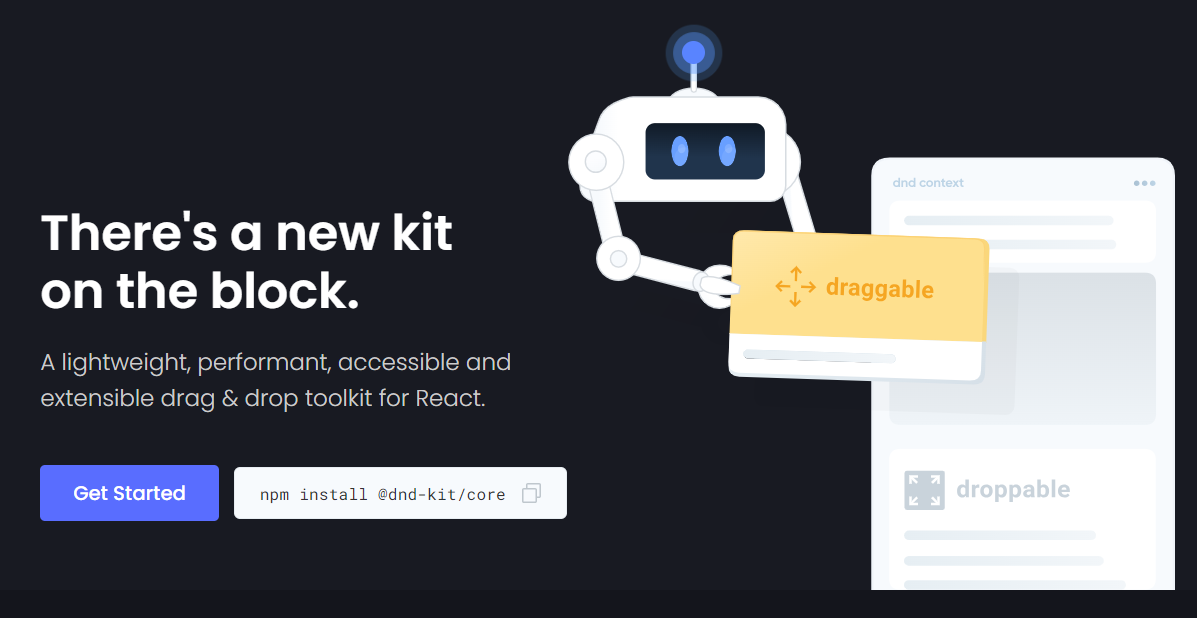 這是一個強大的 React 拖放工具包,擁有可自訂的碰撞檢測、多個啟動器和自動滾動等功能。 它的設計考慮到了 React,提供了方便集成的鉤子,無需進行重大的架構更改。支援從清單到網格和虛擬化清單的各種用例,它既是動態的又是輕量級的,沒有外部相依性。 開始使用以下 npm 指令。 ``` npm install @dnd-kit/core ``` 這就是建立可拖放元件的方法。 `Example.jsx` ``` import React, {useState} from 'react'; import {DndContext} from '@dnd-kit/core'; import {Draggable} from './Draggable'; import {Droppable} from './Droppable'; function Example() { const [parent, setParent] = useState(null); const draggable = ( <Draggable id="draggable"> Go ahead, drag me. </Draggable> ); return ( <DndContext onDragEnd={handleDragEnd}> {!parent ? draggable : null} <Droppable id="droppable"> {parent === "droppable" ? draggable : 'Drop here'} </Droppable> </DndContext> ); function handleDragEnd({over}) { setParent(over ? over.id : null); } } ``` `Droppable.jsx` ``` import React from 'react'; import {useDroppable} from '@dnd-kit/core'; export function Droppable(props) { const {isOver, setNodeRef} = useDroppable({ id: props.id, }); const style = { opacity: isOver ? 1 : 0.5, }; return ( <div ref={setNodeRef} style={style}> {props.children} </div> ); } ``` `Draggable.jsx` ``` import React from 'react'; import {useDraggable} from '@dnd-kit/core'; import {CSS} from '@dnd-kit/utilities'; function Draggable(props) { const {attributes, listeners, setNodeRef, transform} = useDraggable({ id: props.id, }); const style = { // Outputs `translate3d(x, y, 0)` transform: CSS.Translate.toString(transform), }; return ( <button ref={setNodeRef} style={style} {...listeners} {...attributes}> {props.children} </button> ); } ``` 我將可拖曳元件放在可放置元件上。 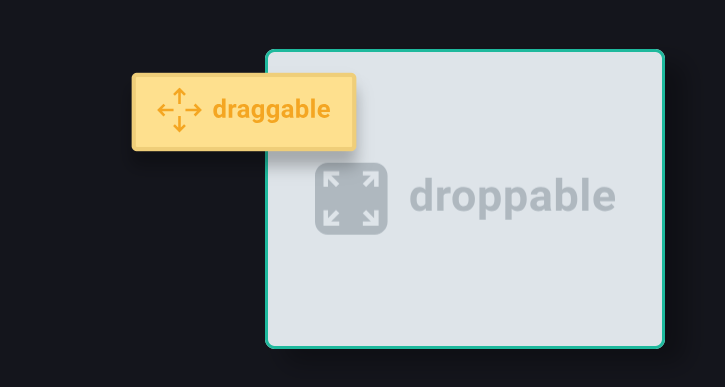 您可以閱讀[文件](https://docs.dndkit.com/)以及滑鼠和指標等[感測器的選項](https://docs.dndkit.com/introduction/installation#core-library)。 它在 GitHub 上擁有 10k+ Stars,並被 GitHub 上 47k+ 開發人員使用。 https://github.com/clauderic/dnd-kit 明星免打擾套件 ⭐️
我已經看過相當多的 React 教程,但是每當他們談論使用 React-router 進行導航時,他們都只展示使用 Link 元件的方式。一旦有人開始處理他/她自己的專案,他們遇到的第一個問題就是如何以程式設計方式進行路由,這基本上意味著除了點擊 \\ 中包含的內容之外的其他方式進行路由。成分。 這個部落格的主要目的是為那些來這裡尋找這個問題答案的人提供一個避難所。 --- 1.\\成分 ------ 我們可以使用 \\ 進行重定向只需傳遞我們想要重定向到的路由並渲染元件即可。它已經載入到react-router-dom 庫中。 ``` import { Redirect } from "react-router-dom"; ``` 使用此方法最簡單的方法是在元件狀態內維護重定向屬性。 ``` state = { redirect: null }; render() { if (this.state.redirect) { return <Redirect to={this.state.redirect} /> } return( // Your Code goes here ) } ``` 每當你想要重定向到另一個路徑時,你可以簡單地改變狀態來重新渲染元件,從而渲染\\成分。 ``` this.setState({ redirect: "/someRoute" }); ``` **筆記** 這是除 \\ 之外的建議導航方式。方法。 在帖子的最後詳細討論了。 這種方法的缺點是,當我們想要直接從 redux 操作重新導向時,我們無法這樣做。 --- 2.使用歷史鉤子 -------- 從 5.1.2 版本開始,react-router 附帶了一些新的鉤子,可以幫助我們存取路由器的狀態。 現在,我們只需要討論 useHistory 鉤子。 ``` import { useHistory } from "react-router-dom"; function App() { let history = useHistory(); } ``` 之後,我們可以使用 .push() 方法重定向到我們想要的任何路由。 ``` history.push('/someRoute') ``` --- 3.歷史道具 ------ 作為 \\ 的直接子級的每個元件元件接收歷史物件作為道具。這是保存 React Router 會話歷史記錄的同一個歷史記錄(庫)。因此,我們可以使用它的屬性來導航到所需的路徑。 ``` this.props.history.push("/first"); ``` 我們在這裡遇到的一個常見問題是,在不是 \\ 的直接子級的元件中元件中,不存在歷史道具。使用 withRouter 函數可以輕鬆解決這個問題。 ### 3.1.帶路由器 withRouter 是react-router-dom庫中提供的一個函數,它可以幫助我們存取不是 \\ 直接子級的元件中的歷史記錄道具成分。 使用 Router 導入 ``` import { withRouter } from "react-router-dom"; ``` 現在為了在我們的元件中取得歷史屬性,我們需要在匯出它時用 withRouter 包裝我們的元件。 ``` export default withRouter(yourComponent); ``` 我們現在可以像上面一樣存取歷史記錄來完成我們所需的導航。 --- 4.建立歷史 ------ 我們上面學到的方法可以涵蓋我們在建立 React 應用程式時遇到的大多數情況,那麼為什麼要使用第四種方法呢? 每次我們需要從 redux 操作重定向時,我們總是必須將歷史記錄傳遞給該操作,從而不必要地增加參數數量。因此,可以使用此方法來獲得更簡潔的程式碼。 在此方法中,我們建立自訂歷史記錄實例,可以將其匯入其他文件中以進行重定向。 ``` // Inside /utils/history.js import createHistory from "history/createBrowserHistory"; export default createHistory(); ``` 作為 \\使用它自己的歷史記錄並且不接受任何外部歷史記錄屬性,我們必須使用 \\而不是它。 ``` import { Router } from "react-router-dom"; import history from "./utils/history"; function App(){ return( <Router history={history}> // Your Routes go here <Router> ) } ``` 之後,我們可以將此歷史實例匯入到我們想要重新導向的任何檔案中。 ``` import history from "./utils/history"; history.push("/somePath"); ``` --- 筆記 -- 從本質上講,React 是一種建立 UI 的聲明式方法。 聲明式方法是一種表達計算邏輯而不描述其控制流或不描述幕後實際發生的情況的方法。 由於這個原因,推薦的導航方式除\\正在使用\\成分。 使用這裡提到的其他方法並沒有什麼壞處,只是它們並不完全符合 React 的願景。 --- 儲存庫 --- 我的 Github 個人資料上提供了上述方法的完整工作實作。如果有人想看到這些方法在專案中實際執行,請隨意探索。 {% github https://github.com/projectescape/blogs-reference %} --- --- 原文出處:https://dev.to/projectescape/programmatic-navigation-in-react-3p1l
在 React 專案中組織文件和目錄對於可維護性、可擴充性和易於導航至關重要。本文探討了不同規模的 React 專案的一般架構和資料夾結構,為每個層級提供了清晰的演示。 第 1 種:依「檔案類型」分組 ----------------- 這種結構的特點是簡單 - 按文件類型對文件進行分組: ``` └── src/ ├── actions/ ├── assets/ ├── components/ │ ├── Dialog.tsx │ ├── DistributionGraph.tsx │ ├── Employees.tsx │ ├── PaymentForm.tsx │ └── HoorayDialog.tsx ├── helpers/ ├── reducers/ ├── storage/ ├── store/ └── utils/ ``` - **專案規模**:小型至中型 - **優點**: - 簡單明了 - **缺點**: - 會迅速膨脹並變得難以維護 - 業務關注點沒有分離 假設您有很多與付款相關的程式碼。有一天,整個業務發生變化或不再需要,更換或刪除它有多容易?使用此資料夾結構,您必須檢查*每個資料夾及其中的檔案*才能進行必要的變更。如果專案不斷擴大,它很快就會變成維護地獄,隨著時間的推移只會變得更糟。 第 2 種:按「檔案類型」和功能分組 -------------------- 隨著專案的成長,「2 級」結構引入了按每種類型中的功能進行分組: ``` └── src/ ├── actions/ ├── assets/ ├── components/ │ ├── auth/ │ │ └── SignUpForm.tsx │ ├── payment/ │ │ └── PaymentForm.tsx │ ├── common/ │ │ └── Button.tsx │ └── employees/ │ ├── EmployeeList.tsx │ └── EmployeeSummary.tsx ├── helpers/ ├── reducers/ └── services/ ``` - **專案規模**:中型到大型 - **優點**: - 簡單明了 - 內容按功能分組 - **缺點**: - 與功能相關的邏輯仍然分佈在多個資料夾類型中 現在讓我們回到需要修改或刪除支付模組的問題陳述。有了這個結構,現在做起來就容易多了。 「2 級」資料夾結構是我**為大多數專案推薦的**結構。 第 3 種:依功能/模組分組 ---------------- 對於較大的專案,「3 級」結構提供了高度模組化的方法,為每個模組內應用程式的不同方面定義了清晰的邊界: ``` └── src/ ├── assets/ ├── modules/ | ├── core/ │ │ ├── components/ │ │ ├── design-system/ │ │ ├── hooks/ │ │ ├── persistence/ │ │ └── utils/ │ ├── payment/ │ │ ├── components/ │ │ ├── hooks/ │ │ ├── utils/ │ │ └── services/ │ ├── auth/ │ │ ├── components/ │ │ ├── hooks/ │ │ ├── utils/ │ │ └── services/ │ └── employees/ │ ├── components/ │ │ ├── EmployeeList.tsx │ │ └── EmployeeSummary.tsx │ ├── design-system/ │ ├── hooks/ │ ├── lib/ │ └── utils/ └── ``` - **專案規模**:大型且複雜 - **優點**: - 內容按功能/模組清晰地分組 - 特徵/模組是現實世界中物件的清晰表示 - **缺點**: - 您必須充分了解業務邏輯才能做出正確的分組決策 有了這個,如果您要刪除或修改支付邏輯,您將立即知道從哪裡開始。 為資料夾名稱賦予一致的含義 ------------- 無論結構層級如何,某些資料夾名稱都應具有特定的含義。資料夾名稱的含義可能會根據您的偏好或專案的約定而有所不同。 以下是我通常對資料夾名稱的看法: - **Components** :React 元件 - 主要的 UI 建構塊。 - **design-system** :基於設計系統的基本 UI 元素和模式。 - **icon** :用於內嵌使用的 SVG 圖示。 - **hooks** :用於共享邏輯的自訂 React 鉤子。 - **hocs** :反應高階元件。 - **contexts** / **providers** :包含 React Contexts 和 Providers。 - **utils** :與業務邏輯或任何技術無關的通用邏輯實用程序,例如字串操作、數學計算等。 - **lib** :與某些技術相關的實用程序,例如 DOM 操作、HTML 相關邏輯、localStorage、IndexedDB 等。 - **plugins** :第三方插件應該放在這裡(例如 i18n、Sentry 等) - **services** :封裝主要業務邏輯。 - **helpers** :提供特定於業務的實用程式。 - **styles** :包含(全域)CSS 或 CSS-in-JS 樣式。 - **types** :適用於一般 TypeScript 類型、枚舉和介面。 - **configs** :應用程式的配置(例如環境變數) - **Constants** :常數,未更改的值(例如`export const MINUTES_PER_HOUR = 60` )。 - **api** :用於與伺服器通訊的邏輯。 - **graphql** :GraphQL 特定的程式碼。 - **states** 、 **reducers** 、 **store** 、 **actions** 、 **selectors** :全域狀態管理邏輯(Redux、Zustand、Valtio、Jotai 等) - **路線**/**路由器**:定義路線(如果您使用React Router或類似的)。 - **測試**:程式碼的單元測試和其他類型的測試。 結論 -- 在 React 專案中選擇正確的資料夾結構至關重要,並且應該基於專案的大小和複雜性。雖然「Level 1」可能足以滿足小型專案的需要,但「Level 2」和「Level 3」為中型和大型專案提供了更有組織性和模組化的結構。就我個人而言,我經常**推薦「Level 2」資料夾結構**。此外,了解常見資料夾名稱有助於在 React 應用程式中保持一致且直覺的架構。 --- 原文出處:https://dev.to/itswillt/folder-structures-in-react-projects-3dp8
Sass 已成為本地安裝的強大預處理器,十多年來構成了我的專案的支柱。它使我能夠有效地組織可擴展且穩定的 CSS 包。即使在今天,我仍然認為 Sass 是一個非常強大的工具。然而,當我們步入 2024 年時,不可否認 CSS 已經經歷了快速發展。曾經是 Sass 獨有的功能現在已原生整合到 CSS 中,包括變數和最新亮點:CSS 嵌套。 變數 -- 長期以來,定義變數一直被視為 SCSS 的獨特優勢,它允許集中管理許多屬性,這是 CSS 長期以來非常缺少的功能。然而如今,變數也可以以類似 Sass 的方式在 CSS 中定義。然而,一個顯著的差異是,Sass 變數只存在於預處理器上下文中,而 CSS 變數可以在瀏覽器中使用,甚至可以透過 JavaScript 動態覆寫。 ``` :root { --button-padding: 10px 20px; --button-bg-color: #007bff; --button-text-color: #ffffff; --button-border-radius: 8px; } .button { padding: var(--button-padding); background-color: var(--button-bg-color); color: var(--button-text-color); border-radius: var(--button-border-radius); border: none; cursor: pointer; transition: background-color 0.3s; } ``` CSS 嵌套 ------ 在另一個元素中定義一個元素的樣式規則的能力大大簡化了 CSS 的編寫。嵌套允許將這些選擇器分組到父選擇器中,而不是對從屬元素或偽選擇器重複使用相同的選擇器。這種技術可以產生清晰的、層次結構的、因而更有效率的程式碼庫。 隨著[瀏覽器對 CSS 巢狀的支援率](https://caniuse.com/?search=css%20nesting)超過 84%,對巢狀選擇器的支援率超過 86%,這種技術變得越來越容易使用。 ``` .blog { position: relative; padding: 1rem; background: var(--neutral-100); .blog-item { border: 1px solid var(--neutral-200); & span { font-size: 1rem; } } } ``` :is 偽類 ------ `:is`偽類透過接受選擇器清單並對與這些選擇器中的任何一個匹配的所有元素進行樣式設置,徹底改變了選擇器概念。這大大方便了 DOM 中元素的選擇和樣式設定。 ``` :is(selector1, selector2, selector3) { /* styles */ } ``` 您可以使用 :is() 來提高可讀性,同時避免使用長選擇器,而不是使用長選擇器清單。 : has() 偽類 ---------- CSS 偽類`:has()`提供了一種基於其後代選擇元素的強大方法,類似於條件樣式的應用。 ``` .hero:has(.hero-button) { background-color: var(--accent-50); } ``` 容器查詢 ---- 容器查詢被認為是自 CSS3 以來網頁設計最重要的創新。他們透過允許元素根據容器的大小進行調整來擴展響應式設計的概念。該技術使元素的設計能夠根據上下文動態變化,從而實現更靈活和更具適應性的設計。 ``` .component { --theme: dark; container-name: fancy; } @container fancy style(--theme: dark) { .fancy { /* dark styles. */ } } ``` ``` @container (min-width: 720px) { .headline { font-size: 2em; } } ``` 如果容器有變數 --theme: dark,請加入以下 CSS。 級聯層 --- 使用級聯層,我們可以透過分配自己的層(layer)來避免類別、ID等的嵌套,以獲得更高的特異性。使用`@layer` at-rule 和分層`@imports` ,我們可以建立自己的級聯層- 從低優先樣式(如重設和預設值),透過主題、框架和設計系統,到最高優先樣式(如元件、實用程式) ,並覆蓋。級聯層提供更多控制。 ``` @layer utilities { .button { padding: 0.5rem; } .button--lg { padding: 0.8rem; } } ``` SASS 的未來 -------- 這是否意味著 Sass 已經過時了?一點也不。 Mixins和函數,例如像素到rem的轉換,仍然是Sass不可替代的優勢。儘管如此,我還是決定在我的大部分專案中放棄 Sass。相反,我在 Sublime 編輯器中使用預先定義的程式碼區塊和套件,這顯著改善了我的工作流程。 再見sass? ----- 我堅信,到 2024 年,Sass 的好處,包括安裝、使用和編譯問題,將不再證明其使用的合理性。現代 CSS 的可擴展性和用戶友好性使得無需額外工具即可完成。 我的 Themex 專案展示了新 CSS 功能的組合有多強大:https://app.themexproject.com 隨著 CSS 的進步,我期待直接、直接地實施小型和大型專案。 **再見sass,謝謝你!**  --- 原文出處:https://dev.to/karsten_biedermann/goodbye-sass-welcome-back-native-css-cf
長話短說 ==== 我收集了您應該了解的 React 庫,以建立許多不同類型的專案並成為 React 奇才🧙♂️。 其中每一項都是獨一無二的,並且都有自己的用例。 別忘了給他們加星號🌟 讓我們開始吧!  --- 1. [CopilotKit](https://github.com/CopilotKit/CopilotKit) - 建立應用內人工智慧聊天機器人、代理程式和文字區域 ------------------------------------------------------------------------------------  將 AI 功能整合到 React 中是很困難的,這就是 Copilot 的用武之地。一個簡單快速的解決方案,可將可投入生產的 Copilot 整合到任何產品中! 您可以使用兩個 React 元件將關鍵 AI 功能整合到 React 應用程式中。它們還提供內建(完全可自訂)Copilot 原生 UX 元件,例如`<CopilotKit />` 、 `<CopilotPopup />` 、 `<CopilotSidebar />` 、 `<CopilotTextarea />` 。 開始使用以下 npm 指令。 ``` npm i @copilotkit/react-core @copilotkit/react-ui ``` Copilot Portal 是 CopilotKit 提供的元件之一,CopilotKit 是一個應用程式內人工智慧聊天機器人,可查看目前應用狀態並在應用程式內採取操作。它透過插件與應用程式前端和後端以及第三方服務進行通訊。 這就是整合聊天機器人的方法。 `CopilotKit`必須包裝與 CopilotKit 互動的所有元件。建議您也開始使用`CopilotSidebar` (您可以稍後切換到不同的 UI 提供者)。 ``` "use client"; import { CopilotKit } from "@copilotkit/react-core"; import { CopilotSidebar } from "@copilotkit/react-ui"; import "@copilotkit/react-ui/styles.css"; export default function RootLayout({children}) { return ( <CopilotKit url="/path_to_copilotkit_endpoint/see_below"> <CopilotSidebar> {children} </CopilotSidebar> </CopilotKit> ); } ``` 您可以使用此[快速入門指南](https://docs.copilotkit.ai/getting-started/quickstart-backend)設定 Copilot 後端端點。 之後,您可以讓 Copilot 採取行動。您可以閱讀如何提供[外部上下文](https://docs.copilotkit.ai/getting-started/quickstart-chatbot#provide-context)。您可以使用`useMakeCopilotReadable`和`useMakeCopilotDocumentReadable`反應掛鉤來執行此操作。 ``` "use client"; import { useMakeCopilotActionable } from '@copilotkit/react-core'; // Let the copilot take action on behalf of the user. useMakeCopilotActionable( { name: "setEmployeesAsSelected", // no spaces allowed in the function name description: "Set the given employees as 'selected'", argumentAnnotations: [ { name: "employeeIds", type: "array", items: { type: "string" } description: "The IDs of employees to set as selected", required: true } ], implementation: async (employeeIds) => setEmployeesAsSelected(employeeIds), }, [] ); ``` 您可以閱讀[文件](https://docs.copilotkit.ai/getting-started/quickstart-textarea)並查看[演示影片](https://github.com/CopilotKit/CopilotKit?tab=readme-ov-file#demo)。 您可以輕鬆整合 Vercel AI SDK、OpenAI API、Langchain 和其他 LLM 供應商。您可以按照本[指南](https://docs.copilotkit.ai/getting-started/quickstart-chatbot)將聊天機器人整合到您的應用程式中。 基本概念是在幾分鐘內建立可用於基於 LLM 的應用程式的 AI 聊天機器人。 用例是巨大的,作為開發人員,我們絕對應該在下一個專案中嘗試使用 CopilotKit。 https://github.com/CopilotKit/CopilotKit Star CopilotKit ⭐️ --- 2. [xyflow](https://github.com/xyflow/xyflow) - 使用 React 建立基於節點的 UI。 --------------------------------------------------------------------  XYFlow 是一個功能強大的開源程式庫,用於使用 React 或 Svelte 建立基於節點的 UI。它是一個 monorepo,提供[React Flow](https://reactflow.dev)和[Svelte Flow](https://svelteflow.dev) 。讓我們更多地了解可以使用 React flow 做什麼。  您可以觀看此影片,在 60 秒內了解 React Flow。 https://www.youtube.com/watch?v=aUBWE41a900 有些功能在專業模式下可用,但免費層中的功能足以形成一個非常互動的流程。 React 流程以 TypeScript 編寫並使用 Cypress 進行測試。 開始使用以下 npm 指令。 ``` npm install reactflow ``` 以下介紹如何建立兩個節點( `Hello`和`World` ,並透過邊連接。節點具有預先定義的初始位置以防止重疊,並且我們還應用樣式來確保有足夠的空間來渲染圖形。 ``` import ReactFlow, { Controls, Background } from 'reactflow'; import 'reactflow/dist/style.css'; const edges = [{ id: '1-2', source: '1', target: '2' }]; const nodes = [ { id: '1', data: { label: 'Hello' }, position: { x: 0, y: 0 }, type: 'input', }, { id: '2', data: { label: 'World' }, position: { x: 100, y: 100 }, }, ]; function Flow() { return ( <div style={{ height: '100%' }}> <ReactFlow nodes={nodes} edges={edges}> <Background /> <Controls /> </ReactFlow> </div> ); } export default Flow; ``` 這就是它的樣子。您還可以新增標籤、更改類型並使其具有互動性。 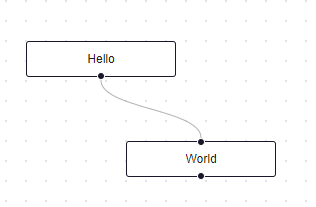 您可以在 React Flow 的 API 參考中查看[完整的選項清單](https://reactflow.dev/api-reference/react-flow)以及元件、鉤子和實用程式。 最好的部分是您還可以加入[自訂節點](https://reactflow.dev/learn/customization/custom-nodes)。在您的自訂節點中,您可以渲染您想要的一切。您可以定義多個來源和目標句柄並呈現表單輸入或圖表。您可以查看此[codesandbox](https://codesandbox.io/p/sandbox/pensive-field-z4kv3w?file=%2FApp.js&utm_medium=sandpack)作為範例。 您可以閱讀[文件](https://reactflow.dev/learn)並查看 Create React App、Next.js 和 Remix 的[範例 React Flow 應用程式](https://github.com/xyflow/react-flow-example-apps)。 React Flow 附帶了幾個額外的[插件](https://reactflow.dev/learn/concepts/plugin-components)元件,可以幫助您使用 Background、Minimap、Controls、Panel、NodeToolbar 和 NodeResizer 元件製作更高級的應用程式。 例如,您可能已經注意到許多網站的背景中有圓點,增強了美觀性。要實現此模式,您可以簡單地使用 React Flow 中的後台元件。 ``` import { Background } from 'reactflow'; <Background color="#ccc" variant={'dots'} /> // this will be under React Flow component. Just an example. ```  如果您正在尋找一篇快速文章,我建議您查看 Webkid 的[React Flow - A Library for Rendering Interactive Graphs](https://webkid.io/blog/react-flow-node-based-graph-library/) 。 React Flow 由 Webkid 開發和維護。 它在 GitHub 上有超過 19k 顆星,並且在`v11.10.4`上顯示它們正在不斷改進,npm 套件每週下載量超過 40 萬次。您可以輕鬆使用的最佳專案之一。  https://github.com/xyflow/xyflow 星 xyflow ⭐️ --- 3. [Zod](https://github.com/colinhacks/zod) + [React Hook Form](https://github.com/react-hook-form) - 致命的驗證組合。 -------------------------------------------------------------------------------------------------------------- 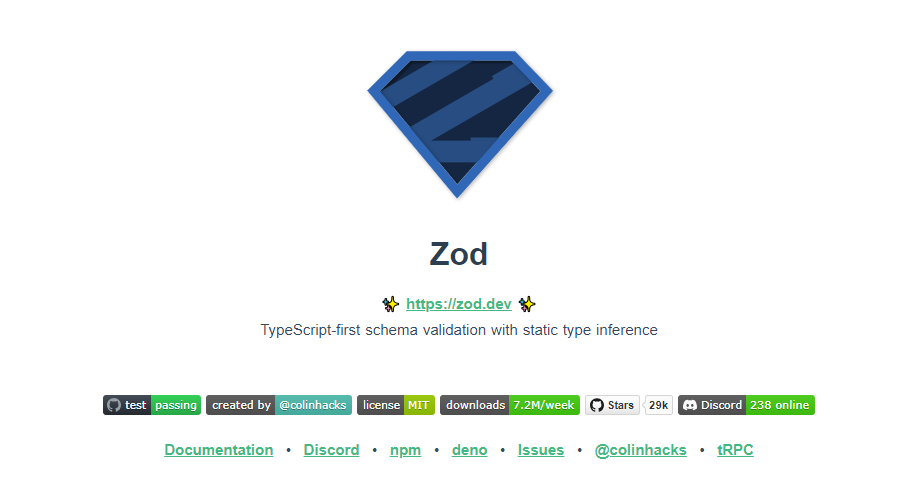 第一個問題是:為什麼我在同一個選項中包含 Zod 和 React Hook 表單?好吧,請閱讀它來找出答案。 Zod 的目標是透過最大限度地減少重複的類型聲明來對開發人員友好。使用 Zod,您聲明一次驗證器,Zod 將自動推斷靜態 TypeScript 類型。將更簡單的類型組合成複雜的資料結構很容易。 開始使用以下 npm 指令。 ``` npm install zod ``` 這是您在建立字串架構時自訂一些常見錯誤訊息的方法。 ``` const name = z.string({ required_error: "Name is required", invalid_type_error: "Name must be a string", }); ``` ``` // It does provide lots of options // validations z.string().min(5, { message: "Must be 5 or more characters long" }); z.string().max(5, { message: "Must be 5 or fewer characters long" }); z.string().length(5, { message: "Must be exactly 5 characters long" }); z.string().email({ message: "Invalid email address" }); z.string().url({ message: "Invalid url" }); z.string().emoji({ message: "Contains non-emoji characters" }); z.string().uuid({ message: "Invalid UUID" }); z.string().includes("tuna", { message: "Must include tuna" }); z.string().startsWith("https://", { message: "Must provide secure URL" }); z.string().endsWith(".com", { message: "Only .com domains allowed" }); z.string().datetime({ message: "Invalid datetime string! Must be UTC." }); z.string().ip({ message: "Invalid IP address" }); ``` 請閱讀[文件](https://zod.dev/)以了解有關 Zod 的更多資訊。 它適用於 Node.js 和所有現代瀏覽器。 現在,第二部分來了。 有很多可用的表單整合。 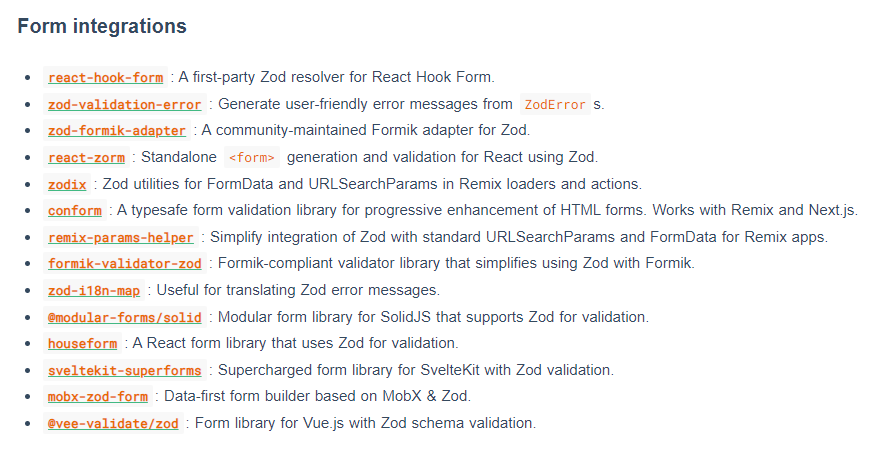 雖然 Zod 可以驗證物件,但如果沒有自訂邏輯,它不會影響您的用戶端和後端。 React-hook-form 是用於客戶端驗證的優秀專案。例如,它可以顯示輸入錯誤。  開始使用以下 npm 指令。 ``` npm install react-hook-form ``` 這就是如何使用`React Hook Form` 。 ``` import { useForm, SubmitHandler } from "react-hook-form" type Inputs = { example: string exampleRequired: string } export default function App() { const { register, handleSubmit, watch, formState: { errors }, } = useForm<Inputs>() const onSubmit: SubmitHandler<Inputs> = (data) => console.log(data) console.log(watch("example")) // watch input value by passing the name of it return ( /* "handleSubmit" will validate your inputs before invoking "onSubmit" */ <form onSubmit={handleSubmit(onSubmit)}> {/* register your input into the hook by invoking the "register" function */} <input defaultValue="test" {...register("example")} /> {/* include validation with required or other standard HTML validation rules */} <input {...register("exampleRequired", { required: true })} /> {/* errors will return when field validation fails */} {errors.exampleRequired && <span>This field is required</span>} <input type="submit" /> </form> ) } ``` 您甚至可以隔離重新渲染,從而提高整體效能。 您可以閱讀[文件](https://react-hook-form.com/get-started)。 兩者結合起來就是一個很好的組合。嘗試一下! 我透過 Shadcn 發現了它,它使用它作為表單元件的預設值。我自己在幾個專案中使用過它,效果非常好。它提供了很大的靈活性,這確實很有幫助。 https://github.com/colinhacks/zod Star Zod ⭐️ https://github.com/react-hook-form Star React Hook Form ⭐️ --- 4. [React DND](https://github.com/react-dnd/react-dnd) - 用於 React 的拖放。 ---------------------------------------------------------------------- 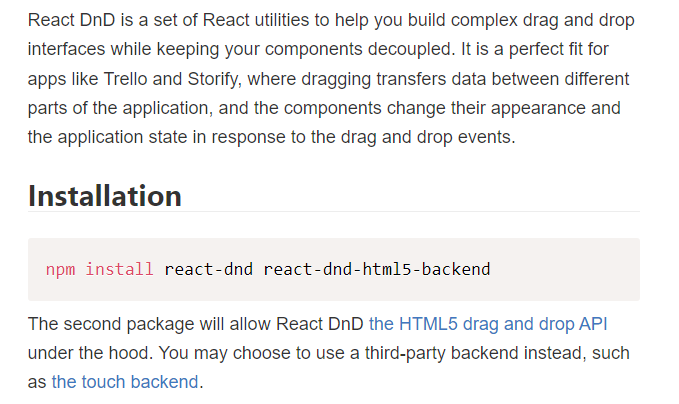 我還沒有完全實現拖放功能,而且我經常發現自己對選擇哪個選項感到困惑。我遇到的另一個選擇是[interactjs.io](https://interactjs.io/) ,根據我讀過的文件,它似乎非常有用。由於他們提供了詳細的範例,這非常容易。  但我現在只介紹 React DND。 開始使用以下 npm 指令。 ``` npm install react-dnd react-dnd-html5-backend ``` 除非您正在編寫自訂後端,否則您可能想要使用 React DnD 隨附的 HTML5 後端。 這是安裝`react-dnd-html5-backend`方法。閱讀[文件](https://react-dnd.github.io/react-dnd/docs/backends/html5)。 這是起點。 ``` import { HTML5Backend } from 'react-dnd-html5-backend' import { DndProvider } from 'react-dnd' export default class YourApp { render() { return ( <DndProvider backend={HTML5Backend}> /* Your Drag-and-Drop Application */ </DndProvider> ) } } ``` 透過這種方式,您可以非常輕鬆地實現卡片的拖放操作。 ``` // Let's make <Card text='Write the docs' /> draggable! import React from 'react' import { useDrag } from 'react-dnd' import { ItemTypes } from './Constants' export default function Card({ isDragging, text }) { const [{ opacity }, dragRef] = useDrag( () => ({ type: ItemTypes.CARD, item: { text }, collect: (monitor) => ({ opacity: monitor.isDragging() ? 0.5 : 1 }) }), [] ) return ( <div ref={dragRef} style={{ opacity }}> {text} </div> ) } ``` 請注意,HTML5 後端不支援觸控事件。因此它不適用於平板電腦和行動裝置。您可以將`react-dnd-touch-backend`用於觸控裝置。閱讀[文件](https://react-dnd.github.io/react-dnd/docs/backends/touch)。 ``` import { TouchBackend } from 'react-dnd-touch-backend' import { DndProvider } from 'react-dnd' class YourApp { <DndProvider backend={TouchBackend} options={opts}> {/* Your application */} </DndProvider> } ``` 這個codesandbox規定了我們如何正確使用React DND。 https://codesandbox.io/embed/3y5nkyw381?view=Editor+%2B+Preview&module=%2Fsrc%2Findex.tsx&hidenavigation=1 你可以看看React DND的[例子](https://react-dnd.github.io/react-dnd/examples)。 它們甚至有一個乾淨的功能,您可以使用 Redux 檢查內部發生的情況。 您可以透過為提供者新增 debugModeprop 來啟用[Redux DevTools](https://github.com/reduxjs/redux-devtools) ,其值為 true。 ``` <DndProvider debugMode={true} backend={HTML5Backend}> ``` 它提供了多種元件選項,我需要親自測試一下。總的來說,這看起來相當不錯,特別是如果你剛開始的話。 React DND 已獲得`MIT`許可,並在 GitHub 上擁有超過 20k Stars,這使其具有令人難以置信的可信度。 https://github.com/react-dnd/react-dnd Star React DND ⭐️ --- 5. [Cypress](https://github.com/cypress-io/cypress) - 快速測試瀏覽器中執行的內容。 --------------------------------------------------------------------  近年來已經證明了測試的重要性,而 Jest 和 Cypress 等選項使其變得異常簡單。 但我們只會介紹 Cypress,因為它本身就很方便。 只需一張圖片就能證明 Cypress 值得付出努力。 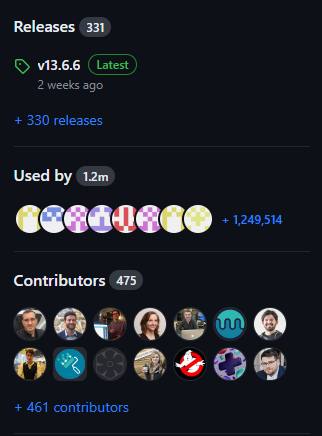 開始使用以下 npm 指令。 ``` npm install cypress -D ``` 如果您在專案中沒有使用 Node 或套件管理器,或者您想快速試用 Cypress,您始終可以[直接從 CDN 下載 Cypress](https://download.cypress.io/desktop) 。 一旦安裝並打開它。您必須使用`.cy.js`建立一個規範檔案。 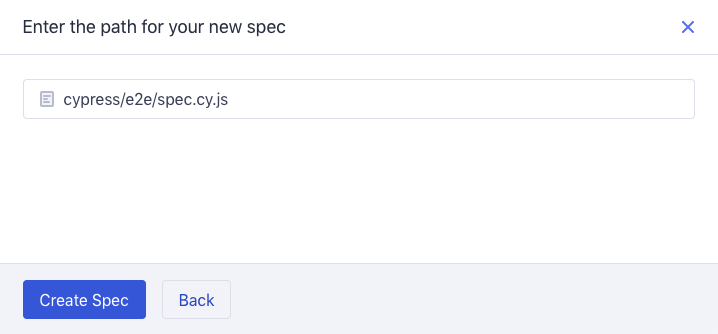 現在,您可以編寫並測試您的應用程式(範例程式碼)。 ``` describe('My First Test', () => { it('Does not do much!', () => { expect(true).to.equal(true) }) }) ``` Cypress 提供了多種選項,例如`cy.visit()`或`cy.contains()` 。由於我沒有廣泛使用 Cypress,因此您需要在其[文件](https://docs.cypress.io/guides/end-to-end-testing/writing-your-first-end-to-end-test)中進一步探索它。 如果它看起來很可怕,那麼請前往這個[為初學者解釋 Cypress 的](https://www.youtube.com/watch?v=u8vMu7viCm8&pp=ygUQY3lwcmVzcyB0dXRvcmlhbA%3D%3D)freeCodeCamp 教程。 Freecodecamp 影片確實是金礦 :D Cypress 在 GitHub 上擁有超過 45,000 顆星,並且在目前的 v13 版本中,它正在不斷改進。 https://github.com/cypress-io/cypress 星柏 ⭐️ --- [6.Refine](https://github.com/refinedev/refine) - 面向企業的開源 Retool。 ----------------------------------------------------------------- 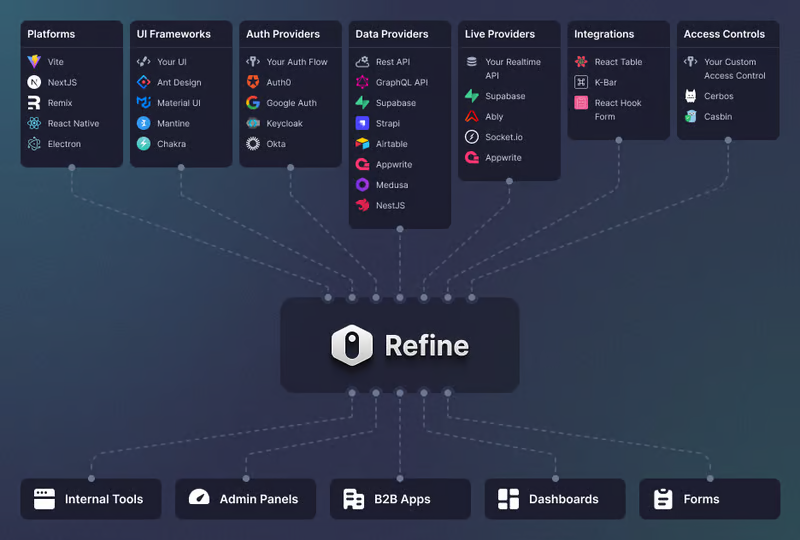 Refine 是一個元 React 框架,可以快速開發各種 Web 應用程式。 從內部工具到管理面板、B2B 應用程式和儀表板,它可作為建立任何類型的 CRUD 應用程式(例如 DevOps 儀表板、電子商務平台或 CRM 解決方案)的全面解決方案。  您可以在一分鐘內使用單一 CLI 命令進行設定。 它具有適用於 15 多個後端服務的連接器,包括 Hasura、Appwrite 等。 您可以查看可用的[整合清單](https://refine.dev/integrations/)。 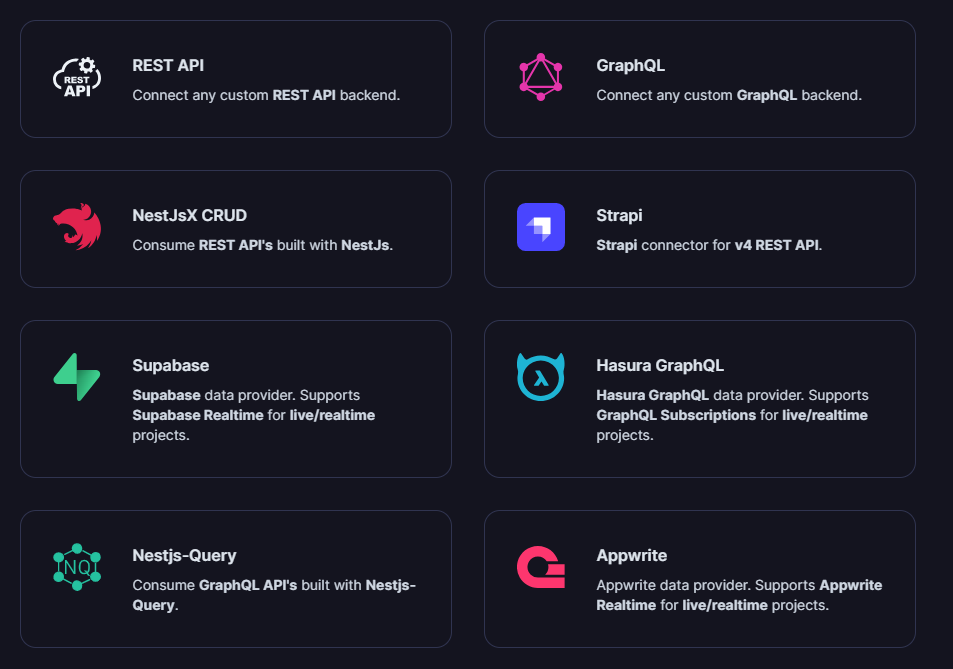 但最好的部分是,Refine `headless by design` ,從而提供無限的樣式和自訂選項。 由於該架構,您可以使用流行的 CSS 框架(如 TailwindCSS)或從頭開始建立樣式。 這是最好的部分,因為我們不希望最終受到與特定庫的兼容性的樣式限制,因為每個人都有自己的風格並使用不同的 UI。 開始使用以下 npm 指令。 ``` npm create refine-app@latest ``` 這就是使用 Refine 新增登入資訊的簡單方法。 ``` import { useLogin } from "@refinedev/core"; const { login } = useLogin(); ``` 使用 Refine 概述程式碼庫的結構。 ``` const App = () => ( <Refine dataProvider={dataProvider} resources={[ { name: "blog_posts", list: "/blog-posts", show: "/blog-posts/show/:id", create: "/blog-posts/create", edit: "/blog-posts/edit/:id", }, ]} > /* ... */ </Refine> ); ``` 您可以閱讀[文件](https://refine.dev/docs/)。 您可以看到一些使用 Refine 建立的範例應用程式: - [全功能管理面板](https://example.admin.refine.dev/) - [優化不同的用例場景](https://github.com/refinedev/refine/tree/master/examples)。 他們甚至提供模板,這就是為什麼這麼多用戶喜歡Refine。 你可以看到[模板](https://refine.dev/templates/)。 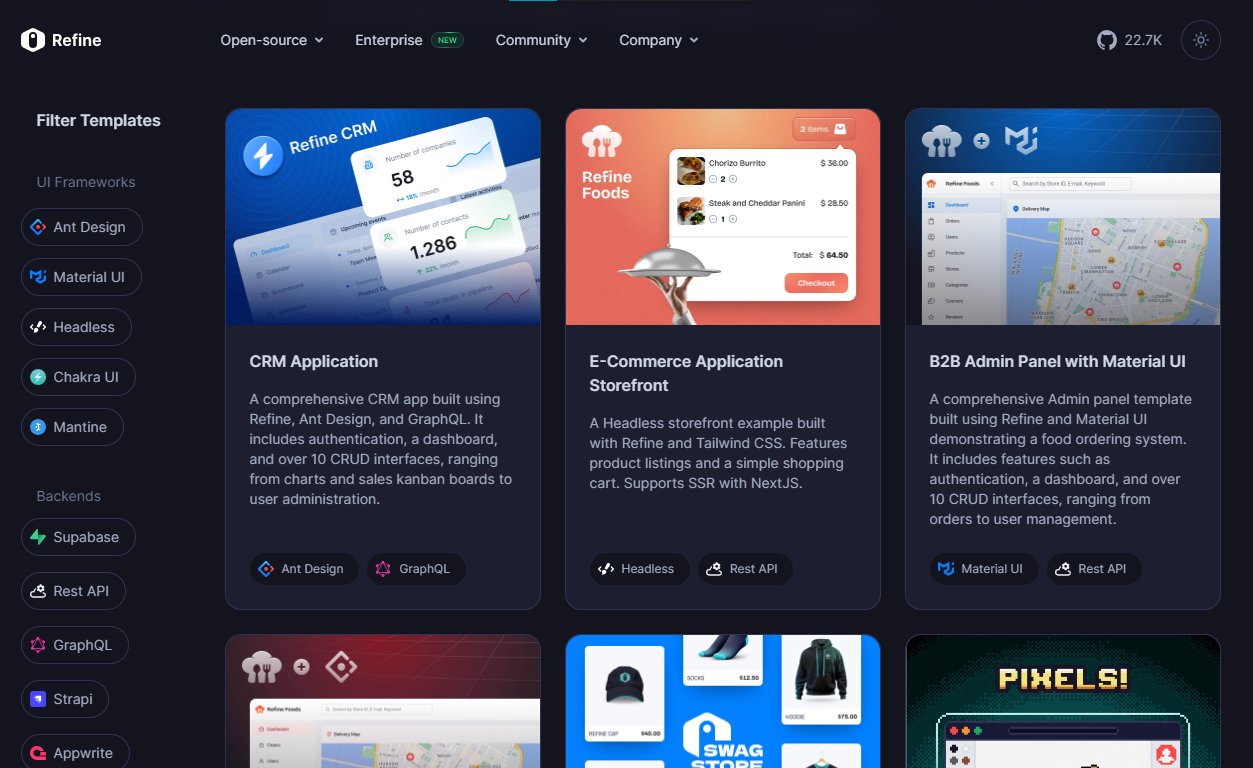 他們在 GitHub 上擁有大約 22k+ 顆星。 https://github.com/refinedev/refine 星際精煉 ⭐️ --- 7. [Tremor](https://github.com/tremorlabs/tremor) - React 元件來建立圖表和儀表板。 ---------------------------------------------------------------------- 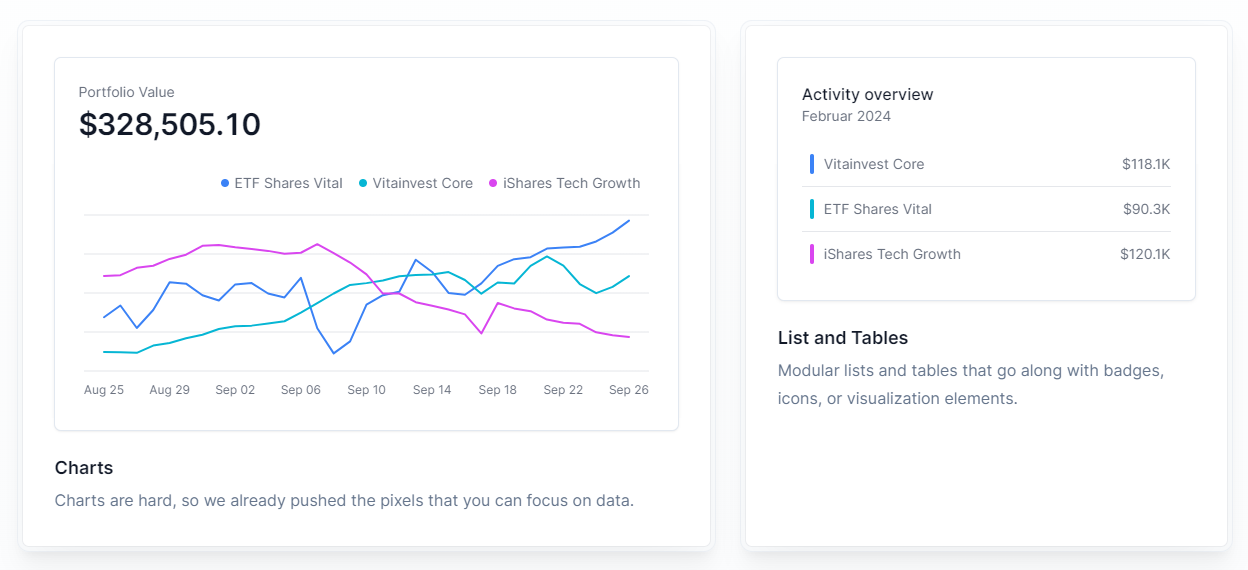 Tremor 提供了 20 多個開源 React 元件,用於建立基於 Tailwind CSS 的圖表和儀表板,使資料視覺化再次變得簡單。 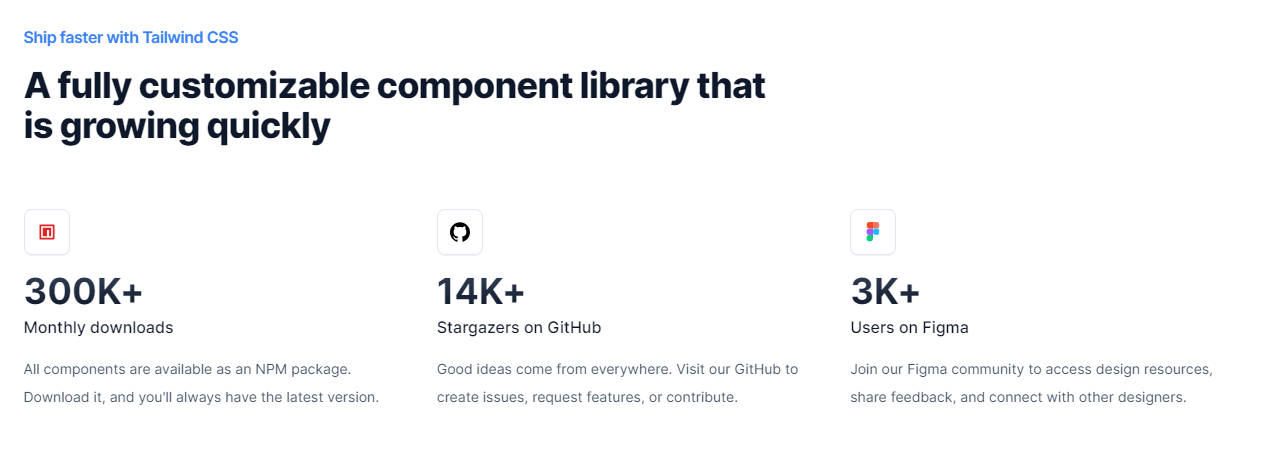 開始使用以下 npm 指令。 ``` npm i @tremor/react ``` 這就是您如何使用 Tremor 快速建立東西。 ``` import { Card, ProgressBar } from '@tremor/react'; export default function Example() { return ( <Card className="mx-auto max-w-md"> <h4 className="text-tremor-default text-tremor-content dark:text-dark-tremor-content"> Sales </h4> <p className="text-tremor-metric font-semibold text-tremor-content-strong dark:text-dark-tremor-content-strong"> $71,465 </p> <p className="mt-4 flex items-center justify-between text-tremor-default text-tremor-content dark:text-dark-tremor-content"> <span>32% of annual target</span> <span>$225,000</span> </p> <ProgressBar value={32} className="mt-2" /> </Card> ); } ``` 這就是基於此生成的內容。 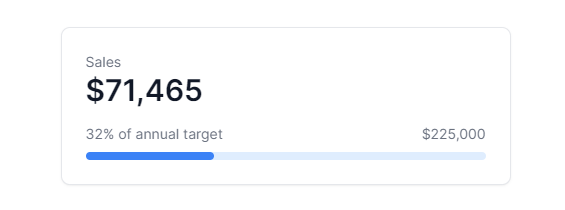 您可以閱讀[文件](https://www.tremor.so/docs/getting-started/installation)。其間,他們在引擎蓋下使用混音圖標。 從我見過的各種元件來看,這是一個很好的起點。相信我! Tremor 還提供了一個[乾淨的 UI 工具包](https://www.figma.com/community/file/1233953507961010067)。多麼酷啊! 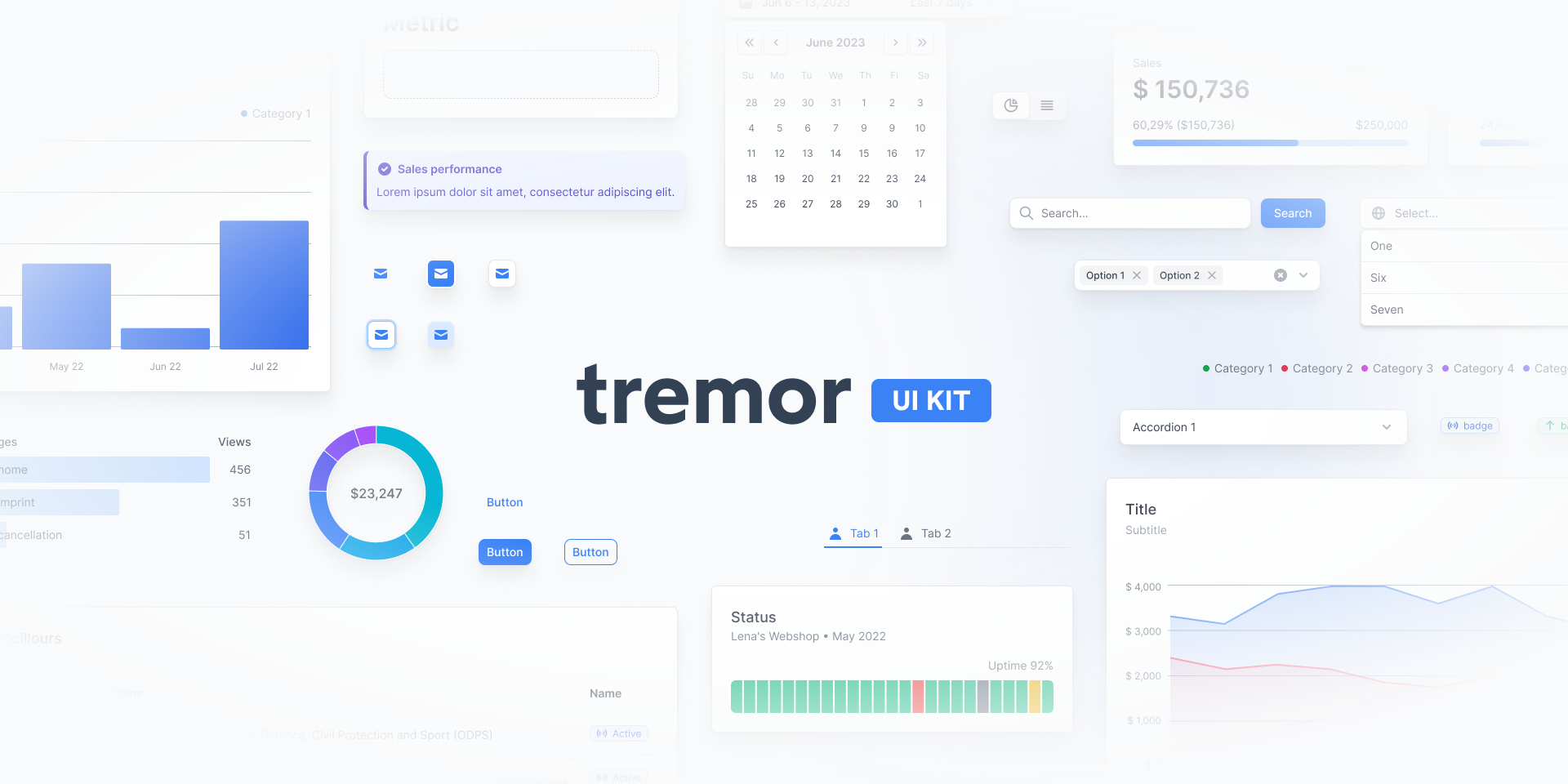 Tremor 在 GitHub 上擁有超過 14k 顆星,並有超過 280 個版本,這意味著它正在不斷改進。 https://github.com/tremorlabs/tremor 星震 ⭐️ --- 8. [Watermelon DB](https://github.com/Nozbe/WatermelonDB) - 用於 React 和 React Native 的反應式和非同步資料庫。 ------------------------------------------------------------------------------------------------  我不知道為什麼資料庫有這麼多選項;甚至很難全部數清。但如果我們使用 React,Watermelon DB 是一個不錯的選擇。即使在 4k+ 提交之後,它們仍然處於`v0.28`版本,這是一個相當大的問題。 Rocket.chat 使用 Watermelon DB,這給了他們巨大的可信度。 開始使用以下 npm 指令。 ``` npm install @nozbe/watermelondb ``` 您需要做的第一件事是建立模型和後續遷移(閱讀文件)。 ``` import { appSchema, tableSchema } from '@nozbe/watermelondb' export default appSchema({ version: 1, tables: [ // We'll add to tableSchemas here ] }) ``` 根據文件,使用 WatermelonDB 時,您正在處理模型和集合。然而,在 Watermelon 之下有一個底層資料庫(SQLite 或 LokiJS),它使用不同的語言:表格和欄位。這些一起稱為資料庫模式。 您可以閱讀有關[CRUD 操作的](https://watermelondb.dev/docs/CRUD)[文件](https://watermelondb.dev/docs/Installation)和更多內容。 https://github.com/Nozbe/WatermelonDB 明星 WatermelonDB ⭐️ --- 9. [Evergreen UI](https://github.com/segmentio/evergreen) - 按 Segment 劃分的 React UI 框架。 --------------------------------------------------------------------------------------  沒有 UI 框架的清單幾乎是不可能的。有許多受歡迎的選項,例如 Material、Ant Design、Next UI 等等。 但我們正在報道 Evergreen,它本身就非常好。 開始使用以下 npm 指令。 ``` $ npm install evergreen-ui ``` [Evergreen Segment 網站](https://evergreen.segment.com/foundations)上顯示了任何使用者介面的基礎以及詳細的選項。 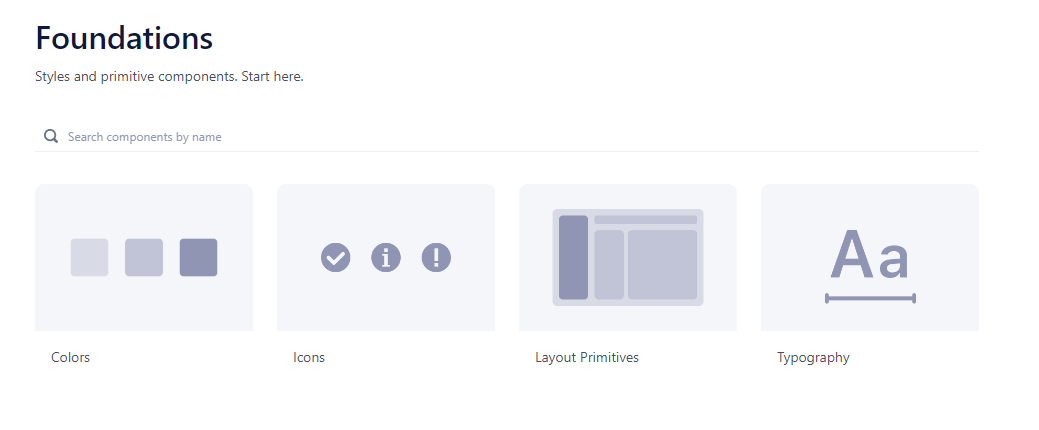 它提供了很多元件,其中一些非常好,例如`Tag Input`或`File uploader` 。  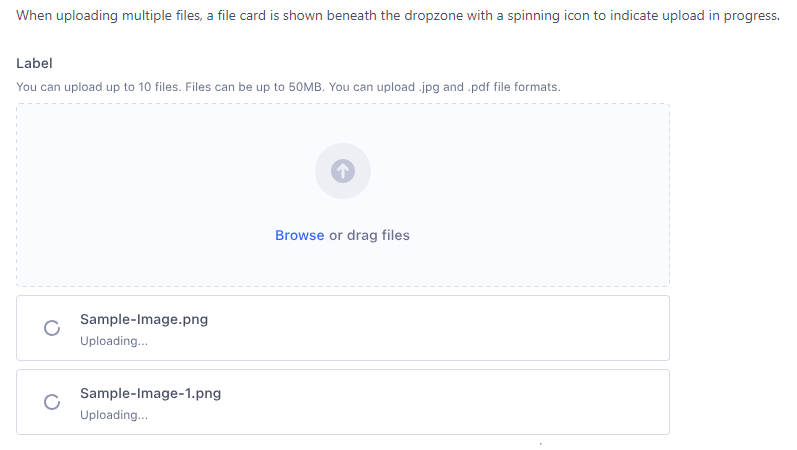 您可以看到 Evergreen UI 提供的所有[元件](https://evergreen.segment.com/components)。 https://github.com/segmentio/evergreen Star Evergreen UI ⭐️ --- 10. [React Spring](https://www.react-spring.dev/) - 流暢的動畫來提升 UI 和互動。 -------------------------------------------------------------------- 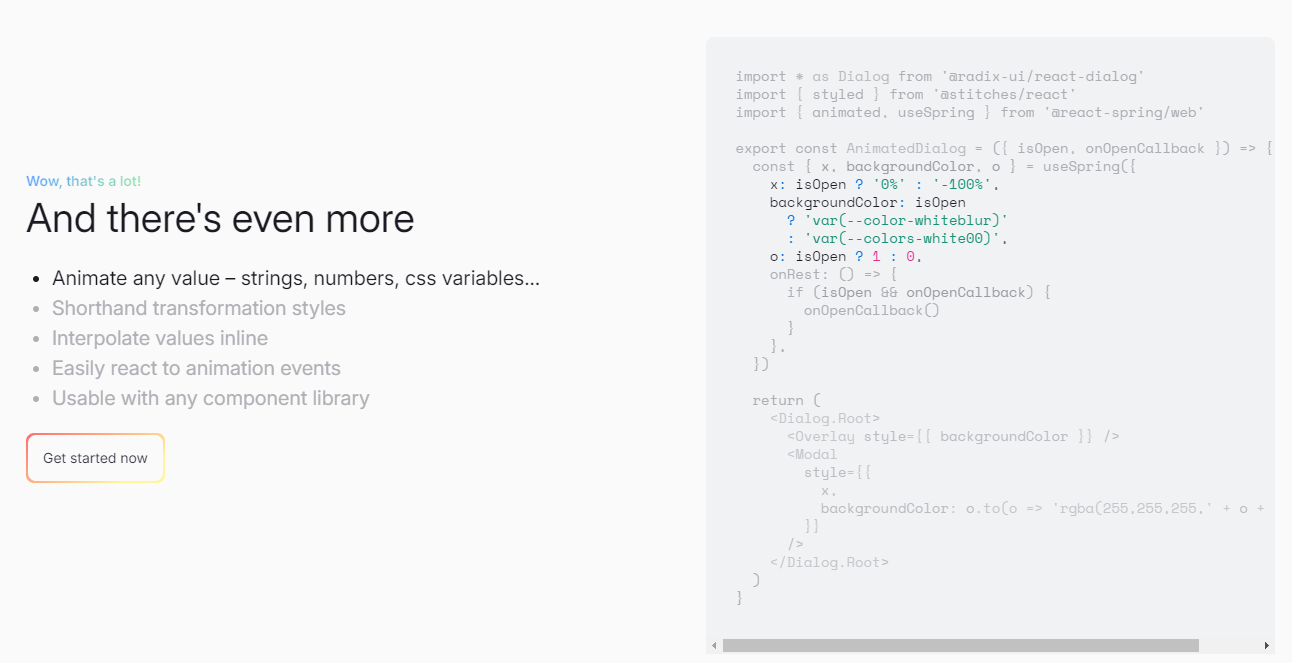  如果您喜歡 React-Motion 但感覺過渡不流暢,那是因為它專門使用 React 渲染。 如果你喜歡 Popmotion,但感覺自己的能力受到限制,那是因為它完全跳過了 React 渲染。 `react-spring`提供了兩種選擇,試試看! 開始使用以下 npm 指令。 ``` npm i @react-spring/web ``` 這就是導入高階元件來包裝動畫的方法。 ``` import { animated } from '@react-spring/web' // use it. export default function MyComponent() { return ( <animated.div style={{ width: 80, height: 80, background: '#ff6d6d', borderRadius: 8, }} /> ) } ``` 由於以下程式碼和框,我決定嘗試 React Spring。令人驚訝的是,我們可以使用 React Spring 做很多事情。 https://codesandbox.io/embed/mdovb?view=Editor+%2B+Preview&module=%2Fsrc%2Findex.tsx&hidenavigation=1 您可以閱讀[文件](https://www.react-spring.dev/docs/getting-started)。 他們還提供了很多您可以學習的[範例](https://www.react-spring.dev/examples)。 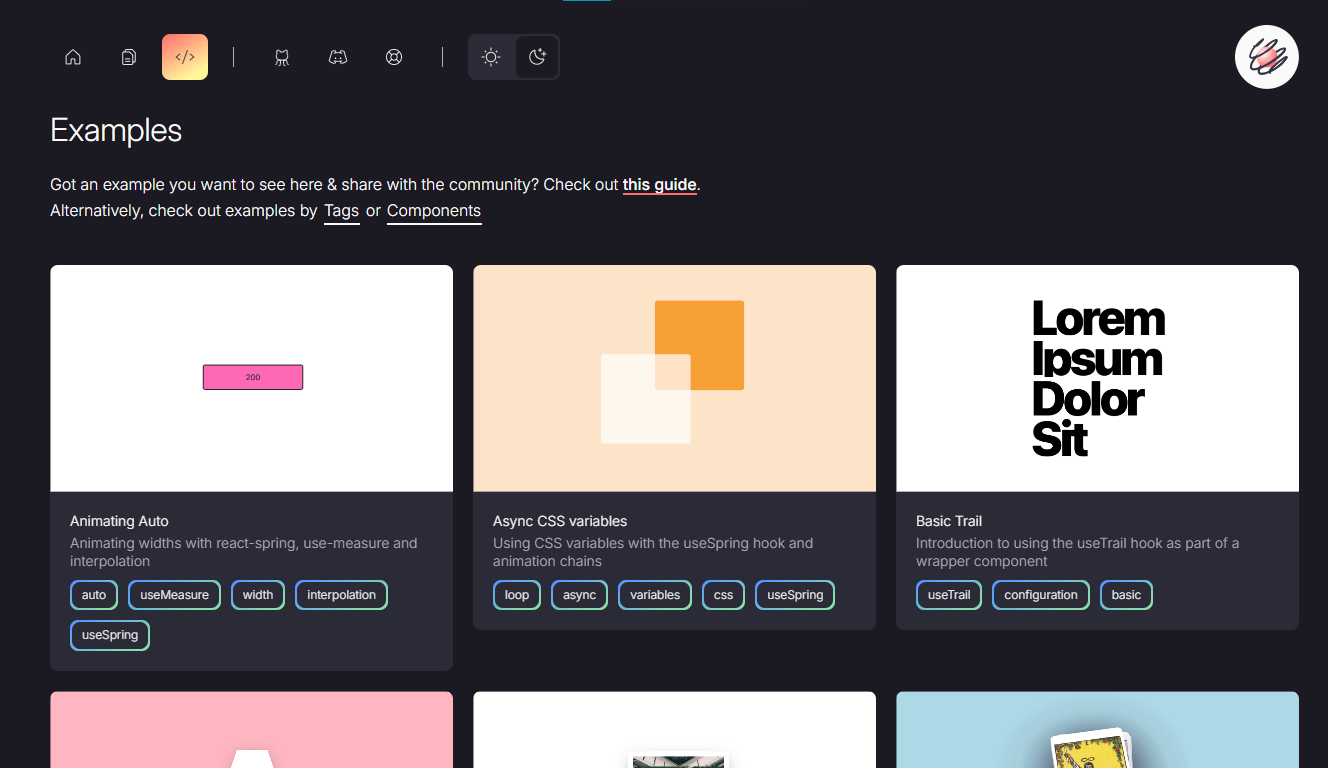 它提供了大量的選項,例如`useScroll` ,它允許您建立滾動連結動畫。 例如,這個codesandbox告訴了`useScroll`的用法。 https://codesandbox.io/embed/b07dmz?view=Editor+%2B+Preview&module=%2Fsrc%2Findex.tsx&hidenavigation=1 React Spring 在 GitHub 上有大約 27k+ Stars。 https://github.com/pmndrs/react-spring Star React Spring ⭐️ --- 11. [React Tweet](https://github.com/vercel/react-tweet) - 將推文嵌入到你的 React 應用程式中。 --------------------------------------------------------------------------------  `React Tweet`可讓您在使用 Next.js、Create React App、Vite 等時將推文嵌入到 React 應用程式中。 該函式庫不需要使用 Twitter API。推文可以靜態呈現,從而無需包含 iframe 和額外的客戶端 JavaScript。 它是 Vercel 的開源專案。 開始使用以下 npm 指令。 ``` npm i react-tweet ``` 為了顯示推文,我們需要從 Twitter 的 API 請求資料。透過此 API 進行速率限制具有挑戰性,但如果您僅依賴我們提供的 SWR 端點 ( `react-tweet.vercel.app/api/tweet/:id` ),這是可能的,因為伺服器的IP 位址向Twitter 發出了許多請求API。這也適用於 RSC,其中 API 端點不是必需的,但伺服器仍然從相同 IP 位址發送請求。 為了避免 API 限制,您可以使用 Redis 或 Vercel KV 等資料庫快取推文。例如,您可以使用 Vercel KV。 ``` import { Suspense } from 'react' import { TweetSkeleton, EmbeddedTweet, TweetNotFound } from 'react-tweet' import { fetchTweet, Tweet } from 'react-tweet/api' import { kv } from '@vercel/kv' async function getTweet( id: string, fetchOptions?: RequestInit ): Promise<Tweet | undefined> { try { const { data, tombstone, notFound } = await fetchTweet(id, fetchOptions) if (data) { await kv.set(`tweet:${id}`, data) return data } else if (tombstone || notFound) { // remove the tweet from the cache if it has been made private by the author (tombstone) // or if it no longer exists. await kv.del(`tweet:${id}`) } } catch (error) { console.error('fetching the tweet failed with:', error) } const cachedTweet = await kv.get<Tweet>(`tweet:${id}`) return cachedTweet ?? undefined } const TweetPage = async ({ id }: { id: string }) => { try { const tweet = await getTweet(id) return tweet ? <EmbeddedTweet tweet={tweet} /> : <TweetNotFound /> } catch (error) { console.error(error) return <TweetNotFound error={error} /> } } const Page = ({ params }: { params: { tweet: string } }) => ( <Suspense fallback={<TweetSkeleton />}> <TweetPage id={params.tweet} /> </Suspense> ) export default Page ``` 您可以直接使用它,方法非常簡單。 ``` <div className="dark"> <Tweet id="1629307668568633344" /> </div> ``` 如果您不喜歡使用 Twitter 主題,您也可以使用多個選項建立自己的[自訂主題](https://react-tweet.vercel.app/custom-theme)。 例如,您可以建立自己的推文元件,但沒有回覆按鈕,如下所示: ``` import type { Tweet } from 'react-tweet/api' import { type TwitterComponents, TweetContainer, TweetHeader, TweetInReplyTo, TweetBody, TweetMedia, TweetInfo, TweetActions, QuotedTweet, enrichTweet, } from 'react-tweet' type Props = { tweet: Tweet components?: TwitterComponents } export const MyTweet = ({ tweet: t, components }: Props) => { const tweet = enrichTweet(t) return ( <TweetContainer> <TweetHeader tweet={tweet} components={components} /> {tweet.in_reply_to_status_id_str && <TweetInReplyTo tweet={tweet} />} <TweetBody tweet={tweet} /> {tweet.mediaDetails?.length ? ( <TweetMedia tweet={tweet} components={components} /> ) : null} {tweet.quoted_tweet && <QuotedTweet tweet={tweet.quoted_tweet} />} <TweetInfo tweet={tweet} /> <TweetActions tweet={tweet} /> {/* We're not including the `TweetReplies` component that adds the reply button */} </TweetContainer> ) } ``` 您可以閱讀[文件](https://react-tweet.vercel.app/#installation)。 您可以查看[React Tweet 的演示,](https://react-tweet-next.vercel.app/light/1761133168772489698)以了解它如何在頁面上呈現。 它們已發布`v3.2`版本,這表明它們正在不斷改進,並且[每週下載量超過 46k+](https://www.npmjs.com/package/react-tweet) 。 https://github.com/vercel/react-tweet Star React 推文 ⭐️ --- 12. [React 360](https://github.com/facebookarchive/react-360) - 使用 React 建立令人驚嘆的 360 度和 VR 內容。 ----------------------------------------------------------------------------------------------  儘管 Facebook 已將其存檔,但許多開發人員仍然發現它足夠有用,因此繼續使用。 React 360 是一個函式庫,它利用大量 React Native 功能來建立在 Web 瀏覽器中執行的虛擬實境應用程式。 它使用 Three.js 進行渲染,並作為 npm 套件提供。透過將 WebGL 和 WebVR 等現代 API 與 React 的聲明性功能結合,React 360 有助於簡化建立跨平台 VR 體驗的過程。 開始使用以下 npm 指令。 ``` npm install -g react-360-cli ``` 涉及的事情有很多,但您可以使用 VrButton 加入重要的互動功能到您的 React VR 應用程式。 ``` import { AppRegistry, StyleSheet, Text, View, VrButton } from 'react-360'; state = { count: 0 }; _incrementCount = () => { this.setState({ count: this.state.count + 1 }) } <View style={styles.panel}> <VrButton onClick={this._incrementCount} style={styles.greetingBox}> <Text style={styles.greeting}> {`You have visited Simmes ${this.state.count} times`} </Text> </VrButton> </View> ``` 除了許多令人驚奇的東西之外,您還可以加入聲音。請參閱[使用 React 360 的 React Resources](https://reactresources.com/topics/react-360)範例。 您也可以閱讀 Log Rocket 撰寫的關於[使用 React 360 建立 VR 應用](https://blog.logrocket.com/building-a-vr-app-with-react-360/)程式的部落格。 這個codesandbox代表了我們可以使用React 360做什麼的一個常見範例。 https://codesandbox.io/embed/2bye27?view=Editor+%2B+Preview&module=%2Fsrc%2Findex.js&hidenavigation=1 https://github.com/facebookarchive/react-360 Star React 360 ⭐️ --- 13. [React Advanced Cropper](https://github.com/advanced-cropper/react-advanced-cropper) - 建立適合您網站的裁剪器。 -------------------------------------------------------------------------------------------------------   React Advanced Cropper 是一個高級庫,可讓您建立適合任何網站設計的裁剪器。這意味著您不僅可以更改裁剪器的外觀,還可以自訂其行為。 它們仍處於測試版本,這意味著 API 可能會在未來版本中發生變化。 簡單的用例是設計軟體和裁剪圖像表面以獲得進一步的見解。 他們有很多選擇,因此值得。 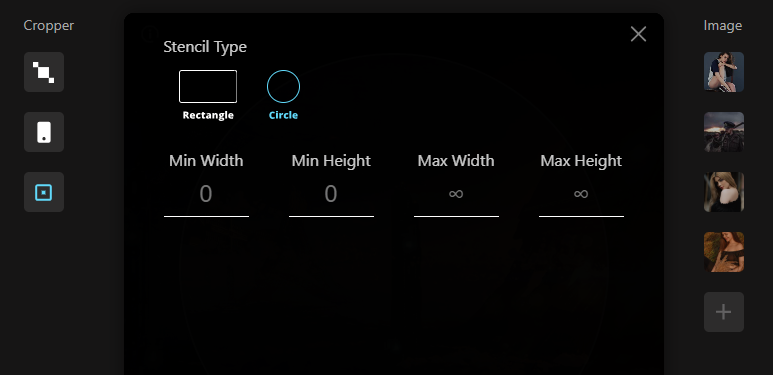 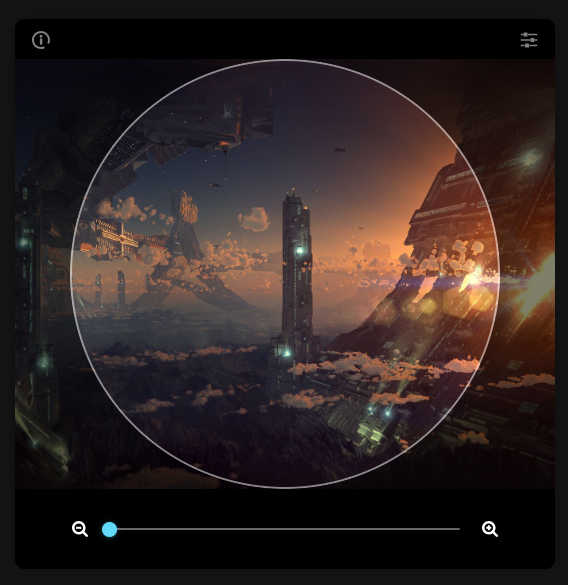 開始使用以下 npm 指令。 ``` npm install --save react-advanced-cropper ``` 您可以這樣使用它。 ``` import React, { useState } from 'react'; import { CropperRef, Cropper } from 'react-advanced-cropper'; import 'react-advanced-cropper/dist/style.css' export const GettingStartedExample = () => { const [image, setImage] = useState( 'https://images.unsplash.com/photo-1599140849279-1014532882fe?ixlib=rb-1.2.1&ixid=eyJhcHBfaWQiOjEyMDd9&auto=format&fit=crop&w=1300&q=80', ); const onChange = (cropper: CropperRef) => { console.log(cropper.getCoordinates(), cropper.getCanvas()); }; return ( <Cropper src={image} onChange={onChange} className={'cropper'} /> ) }; ``` 您可以閱讀[文件](https://advanced-cropper.github.io/react-advanced-cropper/docs/intro),它們提供了[20 多個自訂選項](https://github.com/advanced-cropper/react-advanced-cropper?tab=readme-ov-file#cropper)。 他們主要提供三種類型的[裁剪器選項](https://advanced-cropper.github.io/react-advanced-cropper/docs/guides/cropper-types/):固定、經典和混合以及範例和程式碼。 您可以使用 React Advanced Cropper 製作一些令人興奮的東西來向世界展示:) https://github.com/advanced-cropper/react-advanced-cropper Star React 進階裁剪器 ⭐️ --- 14. [Mobx](https://github.com/mobxjs/mobx) - 簡單、可擴展的狀態管理。 ---------------------------------------------------------  MobX 是一個經過驗證的基於訊號的函式庫,可透過函數反應式程式設計簡化和擴展狀態管理。它提供了靈活性,使您能夠獨立於任何 UI 框架來管理應用程式狀態。 這種方法會產生解耦、可移植且易於測試的程式碼。 以下是使用 MobX 的任何應用程式中處理事件的方式。  圖片來自文件 開始使用以下 npm 指令。 ``` npm install mobx-react --save // CDN is also available ``` 這就是它的樣子。 ``` import { observer } from "mobx-react" // ---- ES6 syntax ---- const TodoView = observer( class TodoView extends React.Component { render() { return <div>{this.props.todo.title}</div> } } ) // ---- ESNext syntax with decorator syntax enabled ---- @observer class TodoView extends React.Component { render() { return <div>{this.props.todo.title}</div> } } // ---- or just use function components: ---- const TodoView = observer(({ todo }) => <div>{todo.title}</div>) ``` 您可以使用 props、全域變數或使用 React Context 在觀察者中使用外部狀態。 您可以閱讀[有關 React Integration](https://mobx.js.org/react-integration.html)和[npm docs](https://www.npmjs.com/package/mobx-react#api-documentation)的文件。 您也可以閱讀[MobX 和 React 的 10 分鐘互動介紹](https://mobx.js.org/getting-started)。 MobX 在 GitHub 上擁有超過 27k 顆星,並在 GitHub 上被超過 140K 開發者使用。 https://github.com/mobxjs/mobx 明星 Mobx ⭐️ --- 15. [React Virtualized](https://github.com/bvaughn/react-virtualized) - 渲染大型清單和表格資料。 ------------------------------------------------------------------------------------  開始使用以下 npm 指令。 ``` npm install react-virtualized --save ``` 以下是如何在網格中使用 ColumnSizer 元件。探索演示(文件)以詳細了解可用選項。 ``` import React from 'react'; import ReactDOM from 'react-dom'; import {ColumnSizer, Grid} from 'react-virtualized'; import 'react-virtualized/styles.css'; // only needs to be imported once // numColumns, numRows, someCalculatedHeight, and someCalculatedWidth determined here... // Render your list ReactDOM.render( <ColumnSizer columnMaxWidth={100} columnMinWidth={50} columnCount={numColumns} width={someCalculatedWidth}> {({adjustedWidth, getColumnWidth, registerChild}) => ( <Grid ref={registerChild} columnWidth={getColumnWidth} columnCount={numColumns} height={someCalculatedHeight} cellRenderer={someCellRenderer} rowHeight={50} rowCount={numRows} width={adjustedWidth} /> )} </ColumnSizer>, document.getElementById('example'), ); ``` 您可以閱讀[文件](https://github.com/bvaughn/react-virtualized/tree/master/docs#documentation)和[演示](https://bvaughn.github.io/react-virtualized/#/components/List)。 他們提供了 React-window 作為輕量級的替代方案,但這個在發布和明星方面更受歡迎,所以我介紹了這個選項。您可以閱讀哪個選項更適合您: [React-Window 與 React-Virtualized 有何不同?](https://github.com/bvaughn/react-window?tab=readme-ov-file#how-is-react-window-different-from-react-virtualized) 。 它被超過 85,000 名開發人員使用,並在 GitHub 上擁有超過 25,000 顆星。它還擁有令人印象深刻的[170 萬+ 每週下載量](https://www.npmjs.com/package/react-virtualized)。 https://github.com/bvaughn/react-virtualized Star React 虛擬化 ⭐️ --- 16.React [Google Analytics](https://github.com/react-ga/react-ga) - React Google Analytics 模組。 ---------------------------------------------------------------------------------------------- 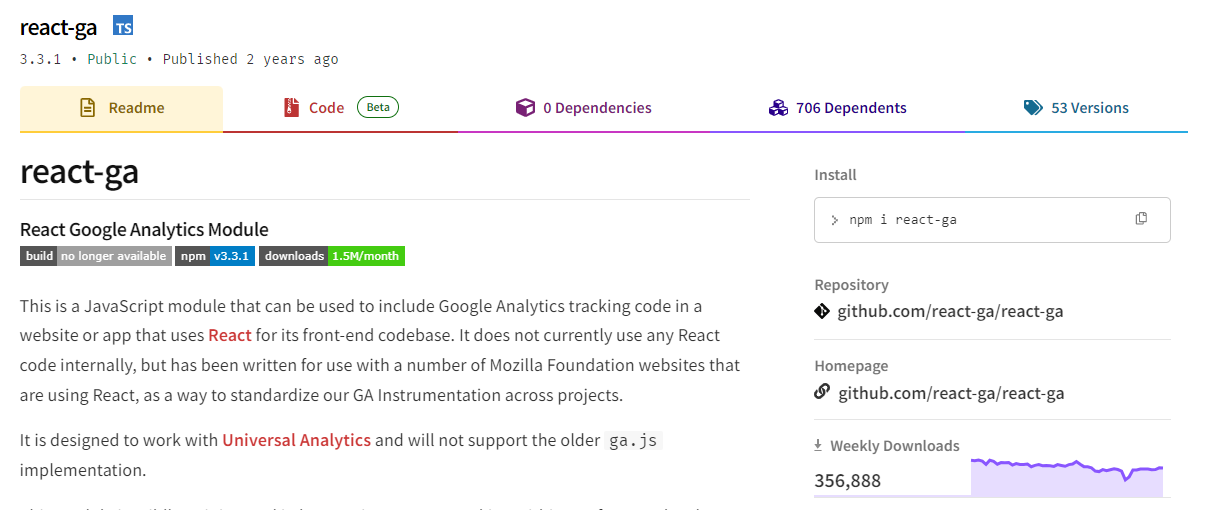 這是一個 JavaScript 模組,可用於在使用 React 作為前端程式碼庫的網站或應用程式中包含 Google Analytics 追蹤程式碼。 該模組對我們如何在前端程式碼中進行追蹤有一定的看法。我們的 API 比核心 Google Analytics 庫稍微詳細一些,以使程式碼更易於閱讀。 開始使用以下 npm 指令。 ``` npm install react-ga --save ``` 您可以這樣使用它。 ``` import ReactGA from 'react-ga'; ReactGA.initialize('UA-000000-01'); ReactGA.pageview(window.location.pathname + window.location.search); <!-- The core React library --> <script src="https://unpkg.com/[email protected]/dist/react.min.js"></script> <!-- The ReactDOM Library --> <script src="https://unpkg.com/[email protected]/dist/react-dom.min.js"></script> <!-- ReactGA library --> <script src="/path/to/bower_components/react-ga/dist/react-ga.min.js"></script> <script> ReactGA.initialize('UA-000000-01', { debug: true }); </script> ``` 執行`npm install` `npm start`並前往`port 8000 on localhost`後,您可以閱讀[文件](https://github.com/react-ga/react-ga?tab=readme-ov-file#installation)並查看[演示](https://github.com/react-ga/react-ga/tree/master/demo)。 它每週的下載量超過 35 萬次,在 GitHub 上擁有超過 5,000 顆星(已存檔)。 https://github.com/react-ga/react-ga Star React Google Analytics ⭐️ --- 17.react [-i18next](https://github.com/i18next/react-i18next) - React 的國際化做得很好。 ------------------------------------------------------------------------------- 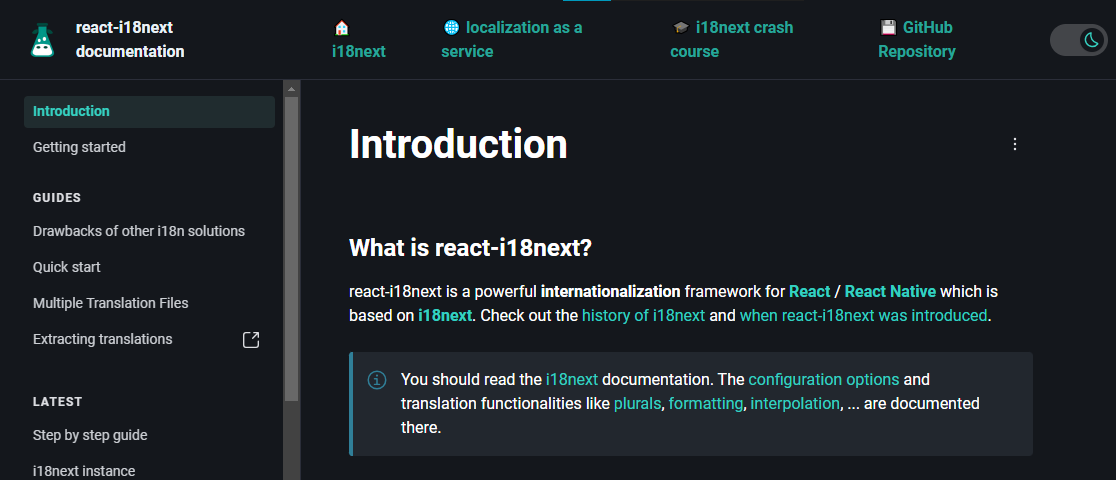 無需更改 webpack 配置或加入額外的 babel 轉譯器。 開始使用以下 npm 指令。 ``` npm i react-i18next ``` 我們來比較一下程式碼結構。 > 在使用react-i18next之前。 ``` ... <div>Just simple content</div> <div> Hello <strong title="this is your name">{name}</strong>, you have {count} unread message(s). <Link to="/msgs">Go to messages</Link>. </div> ... ``` > 使用react-i18next後。 ``` ... <div>{t('simpleContent')}</div> <Trans i18nKey="userMessagesUnread" count={count}> Hello <strong title={t('nameTitle')}>{{name}}</strong>, you have {{count}} unread message. <Link to="/msgs">Go to messages</Link>. </Trans> ... ``` 您可以閱讀[文件](https://react.i18next.com/)並前往[Codesandbox 的互動式遊樂場](https://codesandbox.io/s/1zxox032q)。 該工具已被超過 182,000 名開發人員使用,在 GitHub 上擁有超過 8,000 顆星。軟體包中令人印象深刻的 3400k+ 下載量進一步鞏固了它的可信度,使其成為您下一個 React 專案的絕佳選擇。 您也可以閱讀 Locize 關於[React Localization - Internationalize with i18next](https://locize.com/blog/react-i18next/)的部落格。 https://github.com/i18next/react-i18next 明星react-i18next ⭐️ --- 哇!如此長的有用專案清單。 我知道您有更多想法,分享它們,讓我們一起建造:D 現在就這些了! 在開展新專案時,開發人員經驗至關重要,這就是為什麼有些專案擁有龐大的社區,而有些則沒有。 React 社群非常龐大,所以成為這些社群的一部分,並使用這些開源專案將您的專案提升到一個新的水平。 祝你有美好的一天!直到下一次。 在 GitHub 上關注我。 https://github.com/Anmol-Baranwal 請關注 CopilotKit 以了解更多此類內容。 https://dev.to/copilotkit --- 原文出處:https://dev.to/copilotkit/libraries-you-should-know-if-you-build-with-react-1807
過去十年來,人工智慧世界取得了長足發展。 人工智慧無所不在,從語音助理到軟體開發,如果我們正確使用它,它會非常有幫助。 在這樣的世界中,製作 AI 應用程式是有利可圖的,因此我在這裡介紹 25 個開源專案,您可以使用它們來製作 AI 應用程式並將其提升到新的水平。 其中有一些令人興奮的概念,例如使用語音合成與 3D 角色進行互動式溝通。堅持到底。 將會有大量的資源、文章、專案想法、指南等可供參考。 讓我們涵蓋這一切! --- 1. [Taipy](https://github.com/Avaiga/taipy) - 將資料和人工智慧演算法整合到生產就緒的 Web 應用程式中。 ---------------------------------------------------------------------------- 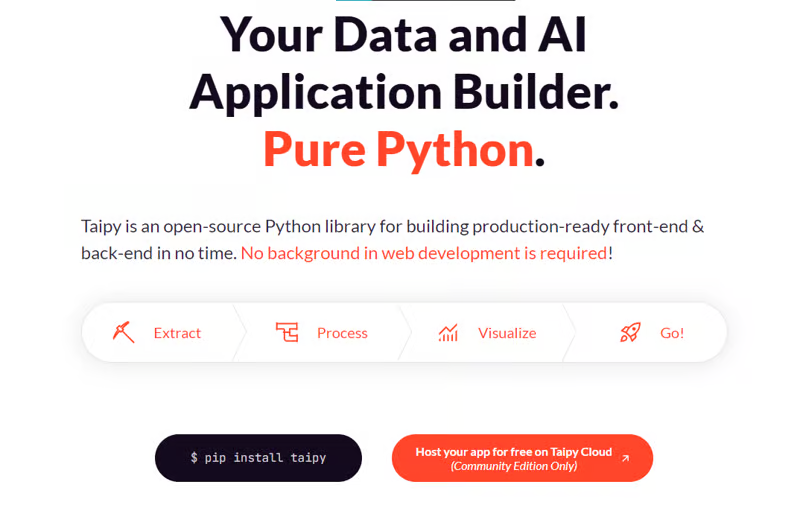 Taipy 是一個開源 Python 庫,可用於輕鬆的端到端應用程式開發,具有假設分析、智慧管道執行、內建調度和部署工具。 我相信你們大多數人都不明白 Taipy 用於為基於 Python 的應用程式建立 GUI 介面並改進資料流管理。 因此,您可以繪製資料集的圖表,並使用類似 GUI 的滑桿來提供使用其他實用功能來處理資料的選項。 雖然 Streamlit 是一種流行的工具,但在處理大型資料集時,其效能可能會顯著下降,這使得它在生產級使用上不切實際。 另一方面,Taipy 在不犧牲性能的情況下提供了簡單性和易用性。透過嘗試 Taipy,您將親身體驗其用戶友好的介面和高效的資料處理。 在底層,Taipy 利用各種函式庫來簡化開發並增強功能。 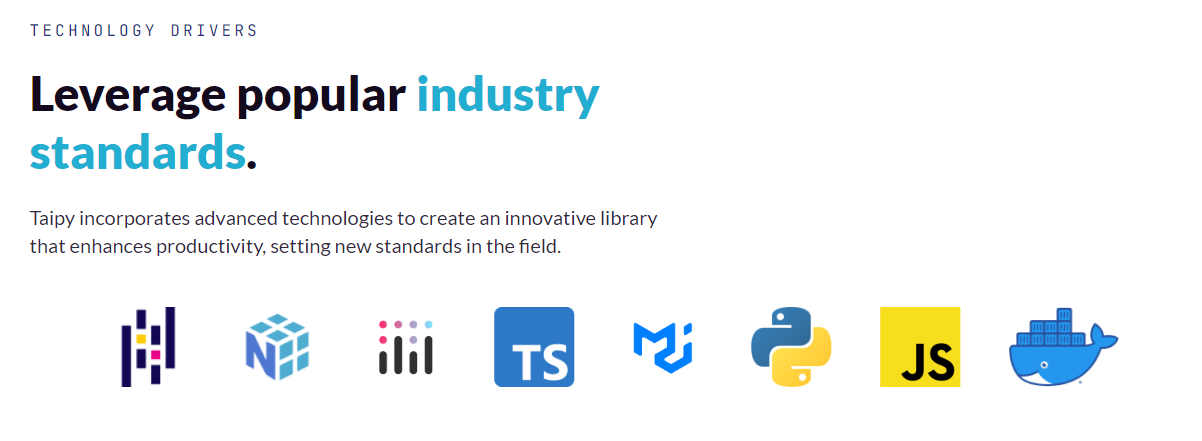 開始使用以下命令。 ``` pip install taipy ``` 我們來談談最新的[Taipy v3.1 版本](https://docs.taipy.io/en/latest/relnotes/)。 最新版本使得在 Taipy 的多功能零件物件中可視化任何 HTML 或 Python 物件成為可能。 這意味著[Folium](https://python-visualization.github.io/folium/latest/) 、 [Bokeh](https://bokeh.org/) 、 [Vega-Altair](https://altair-viz.github.io/)和[Matplotlib](https://matplotlib.org/)等程式庫現在可用於視覺化。 這也帶來了對[Plotly python 的](https://plotly.com/python/)原生支持,使繪製圖表變得更加容易。  他們還使用分散式運算提高了效能,但最好的部分是 Taipy,它的所有依賴項現在都與 Python 3.12 完全相容,因此您可以在使用 Taipy 進行專案的同時使用最新的工具和程式庫。 您可以閱讀[文件](https://docs.taipy.io/en/latest/)。 例如,您可以看到[聊天演示](https://docs.taipy.io/en/release-3.1/gallery/llm/5_chatbot/),它使用 OpenAI 的 GPT-4 API 來產生對您的訊息的回應。您可以輕鬆更改程式碼以使用任何其他 API 或模型。 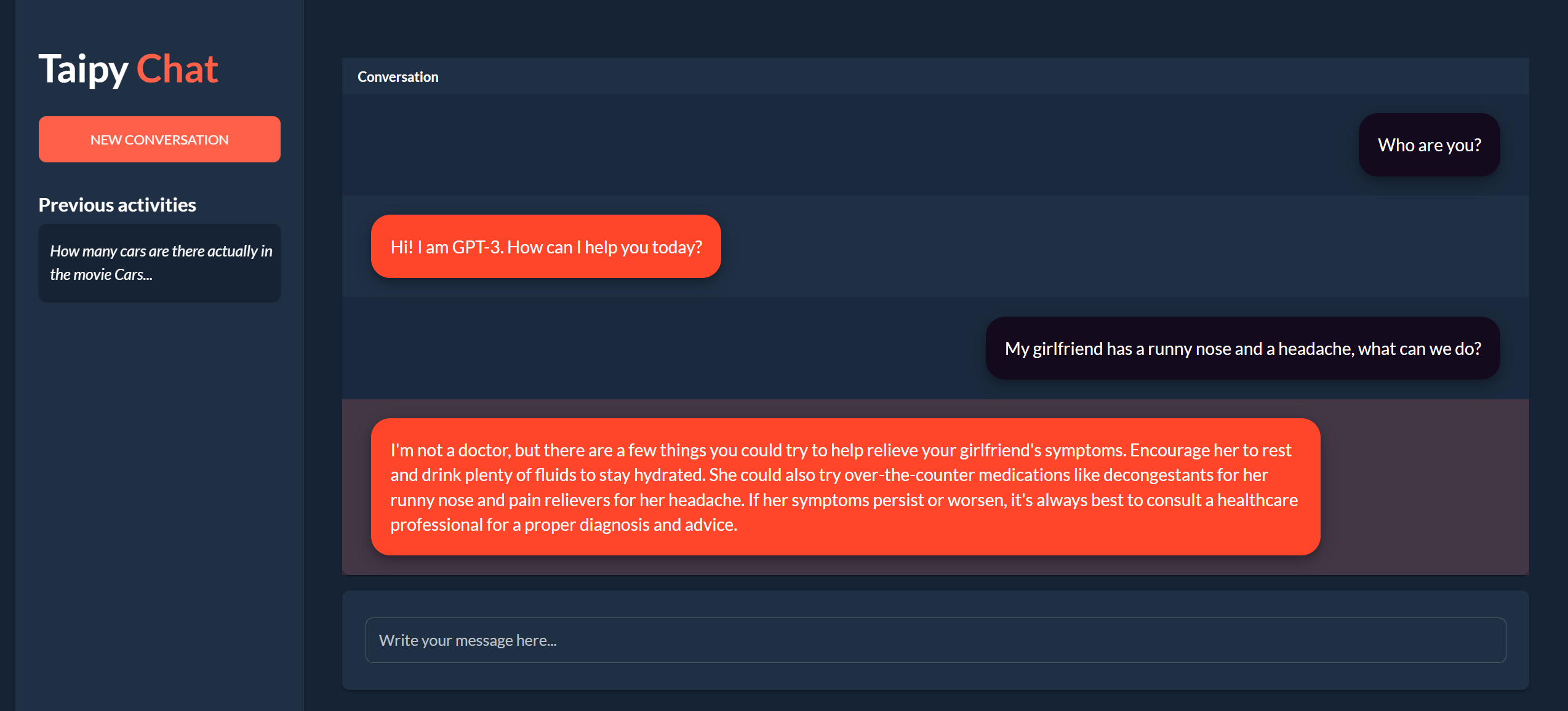 另一個有用的事情是,Taipy 團隊提供了一個名為[Taipy Studio](https://docs.taipy.io/en/latest/manuals/studio/)的 VSCode 擴充功能來加速 Taipy 應用程式的建置。  您也可以使用 Taipy 雲端部署應用程式。 如果您想閱讀部落格來了解程式碼庫結構,您可以閱讀 HuggingFace 的[使用 Taipy 在 Python 中為您的 LLM 建立 Web 介面](https://huggingface.co/blog/Alex1337/create-a-web-interface-for-your-llm-in-python)。 嘗試新技術通常很困難,但 Taipy 提供了[10 多個演示教程](https://docs.taipy.io/en/release-3.1/gallery/),其中包含程式碼和適當的文件供您遵循。 例如,一些現場演示範例: - [新冠儀表板](https://covid-dashboard.taipy.cloud/Country) - [推文生成](https://tweet-generation.taipy.cloud/) - [資料視覺化](https://production-planning.taipy.cloud/Data-Visualization) - [即時人臉辨識](https://face-recognition.taipy.cloud/) Taipy 在 GitHub 上有 7k+ Stars,並且處於`v3`版本,因此它們正在不斷改進。  https://github.com/Avaiga/taipy Star Taipy ⭐️ --- 2. [Supabase](https://github.com/supabase/supabase) - 開源 Firebase 替代品。 ---------------------------------------------------------------------- 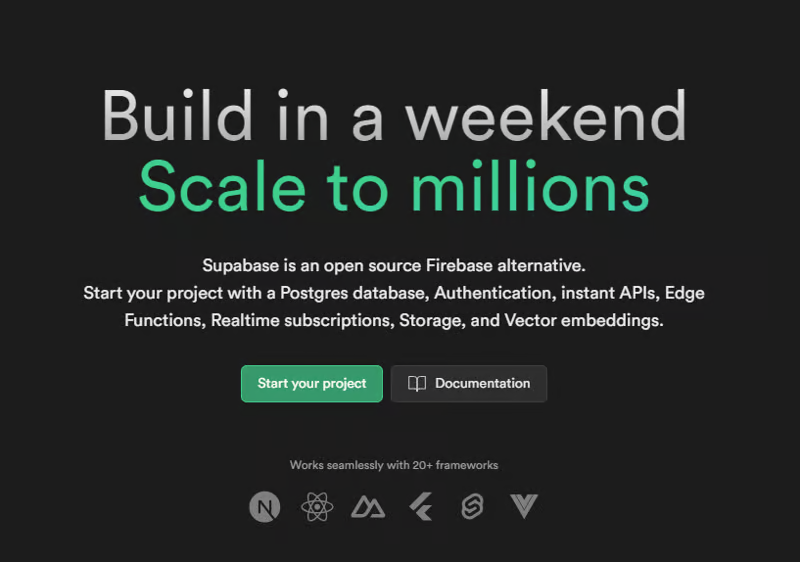 要建立AI應用程式,您需要一個後端,而Supabase作為優秀的後端服務提供者可以滿足這一需求。 開始使用以下 npm 指令 (Next.js)。 ``` npx create-next-app -e with-supabase ``` 這就是使用 CRUD 操作的方式。 ``` import { createClient } from '@supabase/supabase-js' // Initialize const supabaseUrl = 'https://chat-room.supabase.co' const supabaseKey = 'public-anon-key' const supabase = createClient(supabaseUrl, supabaseKey) // Create a new chat room const newRoom = await supabase .from('rooms') .insert({ name: 'Supabase Fan Club', public: true }) // Get public rooms and their messages const publicRooms = await supabase .from('rooms') .select(` name, messages ( text ) `) .eq('public', true) // Update multiple users const updatedUsers = await supabase .from('users') .eq('account_type', 'paid') .update({ highlight_color: 'gold' }) ``` 您可以閱讀[文件](https://supabase.com/docs)。 您可以使用身份驗證、即時、邊緣功能、儲存等功能建立一個速度極快的應用程式。 Supabase 涵蓋了這一切! Supabase 也提供了幾個入門套件,例如[Nextjs 與 LangChain](https://github.com/langchain-ai/langchain-nextjs-template) 、 [Stripe 與 Nextjs](https://github.com/vercel/nextjs-subscription-payments)或[AI Chatbot](https://github.com/supabase-community/vercel-ai-chatbot) 。 Supabase 在 GitHub 上擁有超過 63,000 顆星,並且擁有大量提交超過 27,000 次的貢獻者。 https://github.com/supabase/supabase 明星 Supabase ⭐️ --- 3. [Chatwoot](https://github.com/chatwoot/chatwoot) - 即時聊天、電子郵件支援、全通路服務台並擁有您的資料。 --------------------------------------------------------------------------------  Chatwoot 連接流行的客戶溝通管道,如電子郵件、網站即時聊天、Facebook、Twitter、WhatsApp、Instagram、Line 等。這有助於您從單一儀表板跨管道提供一致的客戶體驗。 這在各種情況下都可能很重要,例如當您圍繞人工智慧應用程式建立社群時。  您可以閱讀[文件](https://www.chatwoot.com/docs/product)來發現各種整合選項,以便更輕鬆地管理整個生態系統。 他們在每個整合中都有非常詳細的文件和快照範例,例如[帶有 WhatsApp Cloud API 的 WhatsApp 通道](https://www.chatwoot.com/docs/product/channels/whatsapp/whatsapp-cloud)。您可以根據需要一鍵式或自架部署到 Heroku。 他們在 GitHub 上擁有 18k+ Stars,並且發布了`v3.6`版本。 https://github.com/chatwoot/chatwoot 明星 Chatwoot ⭐️ --- 4. [CopilotKit](https://github.com/CopilotKit/CopilotKit) - 在數小時內為您的產品提供 AI Copilot。 ------------------------------------------------------------------------------------  您可以使用兩個 React 元件將關鍵 AI 功能整合到 React 應用程式中。它們還提供內建(完全可自訂)Copilot 原生 UX 元件,例如`<CopilotKit />` 、 `<CopilotPopup />` 、 `<CopilotSidebar />` 、 `<CopilotTextarea />` 。 開始使用以下 npm 指令。 ``` npm i @copilotkit/react-core @copilotkit/react-ui @copilotkit/react-textarea ``` 這是整合 CopilotTextArea 的方法。 ``` import { CopilotTextarea } from "@copilotkit/react-textarea"; import { useState } from "react"; export function SomeReactComponent() { const [text, setText] = useState(""); return ( <> <CopilotTextarea className="px-4 py-4" value={text} onValueChange={(value: string) => setText(value)} placeholder="What are your plans for your vacation?" autosuggestionsConfig={{ textareaPurpose: "Travel notes from the user's previous vacations. Likely written in a colloquial style, but adjust as needed.", chatApiConfigs: { suggestionsApiConfig: { forwardedParams: { max_tokens: 20, stop: [".", "?", "!"], }, }, }, }} /> </> ); } ``` 您可以閱讀[文件](https://docs.copilotkit.ai/getting-started/quickstart-textarea)。 基本概念是在幾分鐘內建立可用於基於 LLM 的全端應用程式的 AI 聊天機器人。 https://github.com/CopilotKit/CopilotKit Star CopilotKit ⭐️ --- 5. [DALL·E Mini](https://github.com/borisdayma/dalle-mini) - 根據文字提示產生圖像。 ------------------------------------------------------------------------  OpenAI 擁有第一個令人印象深刻的模型,用於使用 DALL·E 生成圖像。 Craiyon/DALL·E mini 嘗試使用開源模型重現這些結果。 如果您想知道這個名字,DALL-E mini 應母公司的要求更名為 Craiyon,並以更易於存取的網路應用程式格式使用類似的技術。 您可以在[Craiyon](https://www.craiyon.com/)上使用該模型。 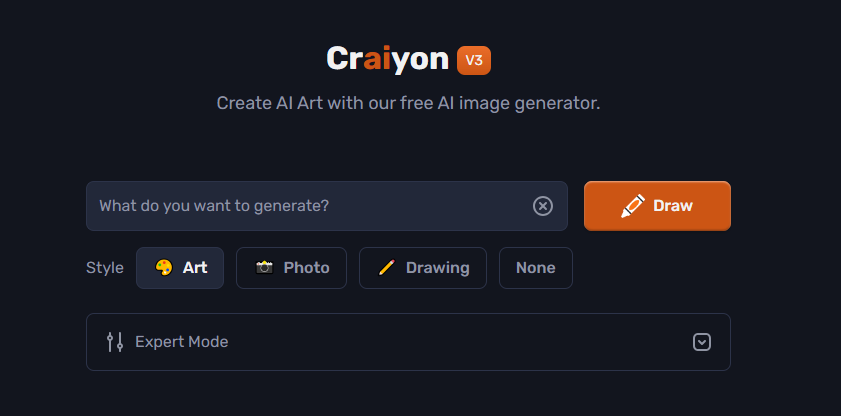 開始使用以下命令(用於開發)。 ``` pip install dalle-mini ``` 您可以閱讀[文件](https://github.com/borisdayma/dalle-mini?tab=readme-ov-file#development)。 您可以閱讀[DALL-E Mini 解釋](https://wandb.ai/dalle-mini/dalle-mini/reports/DALL-E-Mini-Explained-with-Demo--Vmlldzo4NjIxODA)來了解有關資料集、架構和所涉及演算法的更多資訊。 您可以閱讀[最佳真實感 AI 圖像和提示的終極指南](https://www.craiyon.com/blog/ultimate-guide-best-ai-art-photorealistic-images-and-prompts),以便更好地理解優質資源。 DALL·E Mini 在 GitHub 上擁有 14k+ Stars,目前處於`v0.1`版本。 https://github.com/borisdayma/dalle-mini 明星 DALL·E Mini ⭐️ --- 6. [Deepgram](https://github.com/deepgram) - 將語音 AI 建置到您的應用程式中。 --------------------------------------------------------------- 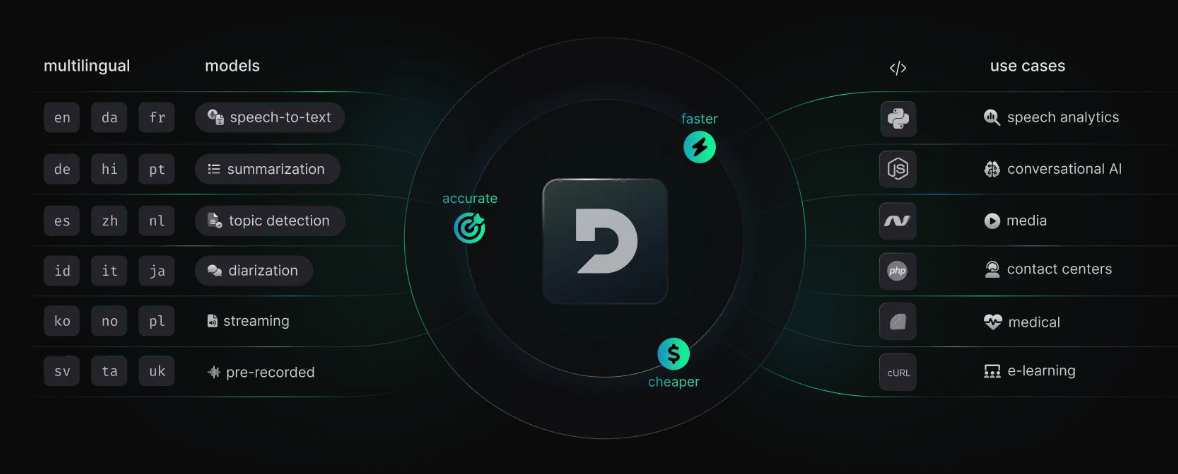 從新創公司到 NASA,Deepgram API 每天都用於轉錄和理解數百萬分鐘的音訊。快速、準確、可擴展且經濟高效。 它為開發人員提供語音到文字和音訊智慧模型。  儘管他們有免費增值模式,但免費套餐的限制足以讓您入門。 可視化效果更上一層樓。您可以檢查即時串流媒體回應或音訊檔案並比較音訊的智慧程度。  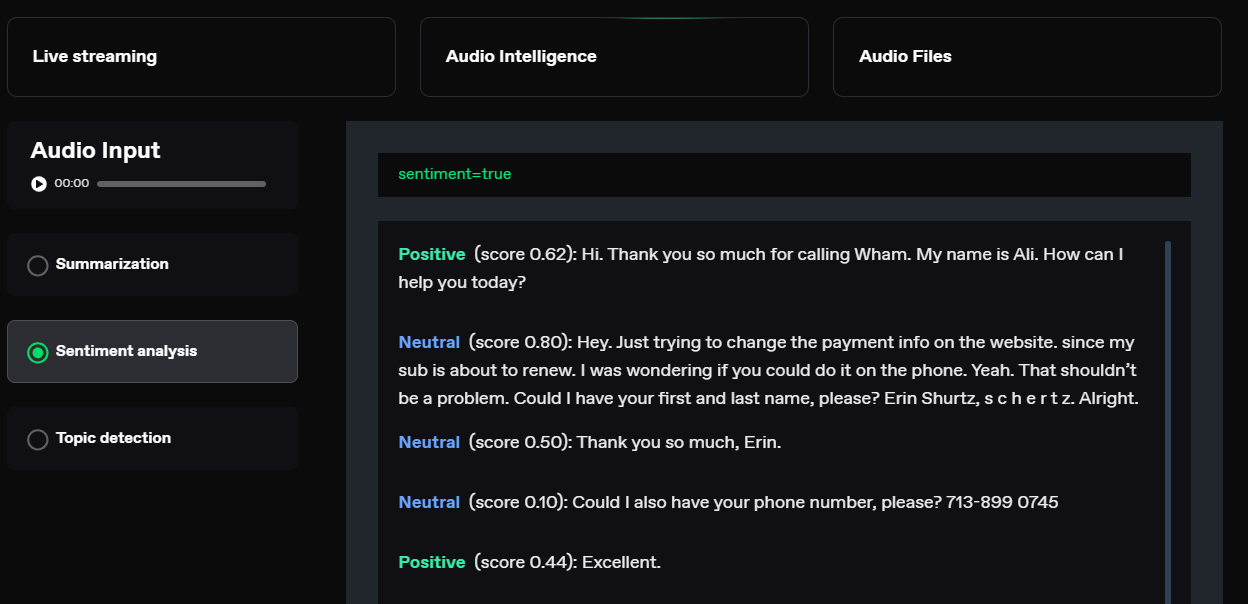 您可以閱讀[文件](https://developers.deepgram.com/docs/introduction)。 您也可以閱讀 Deepgram 撰寫的[關於如何將語音辨識新增至您的 React 和 Node.js 專案的](https://deepgram.com/learn/how-to-add-speech-recognition-to-your-react-project)範例部落格。 如果您想嘗試 API 來親自了解模型的靈活性,請查看他們的[API Playground](https://playground.deepgram.com/?smart_format=true&language=en&model=nova-2) 。 https://github.com/deepgram 明星 Deepgram ⭐️ --- 7. [InvokeAI](https://github.com/invoke-ai/InvokeAI) - 領先的穩定擴散模型創意引擎。 ---------------------------------------------------------------------  關於 InvokeAI 是 Stable Diffusion(開源文字到圖像和圖像到圖像生成器)的實現。 它可以在 Windows、Mac 和 Linux 機器上執行,並在 RAM 低至 4 GB 的 GPU 卡上執行。 此解決方案提供業界領先的WebUI,支援透過CLI進行終端使用,並作為多種商業產品的基礎。 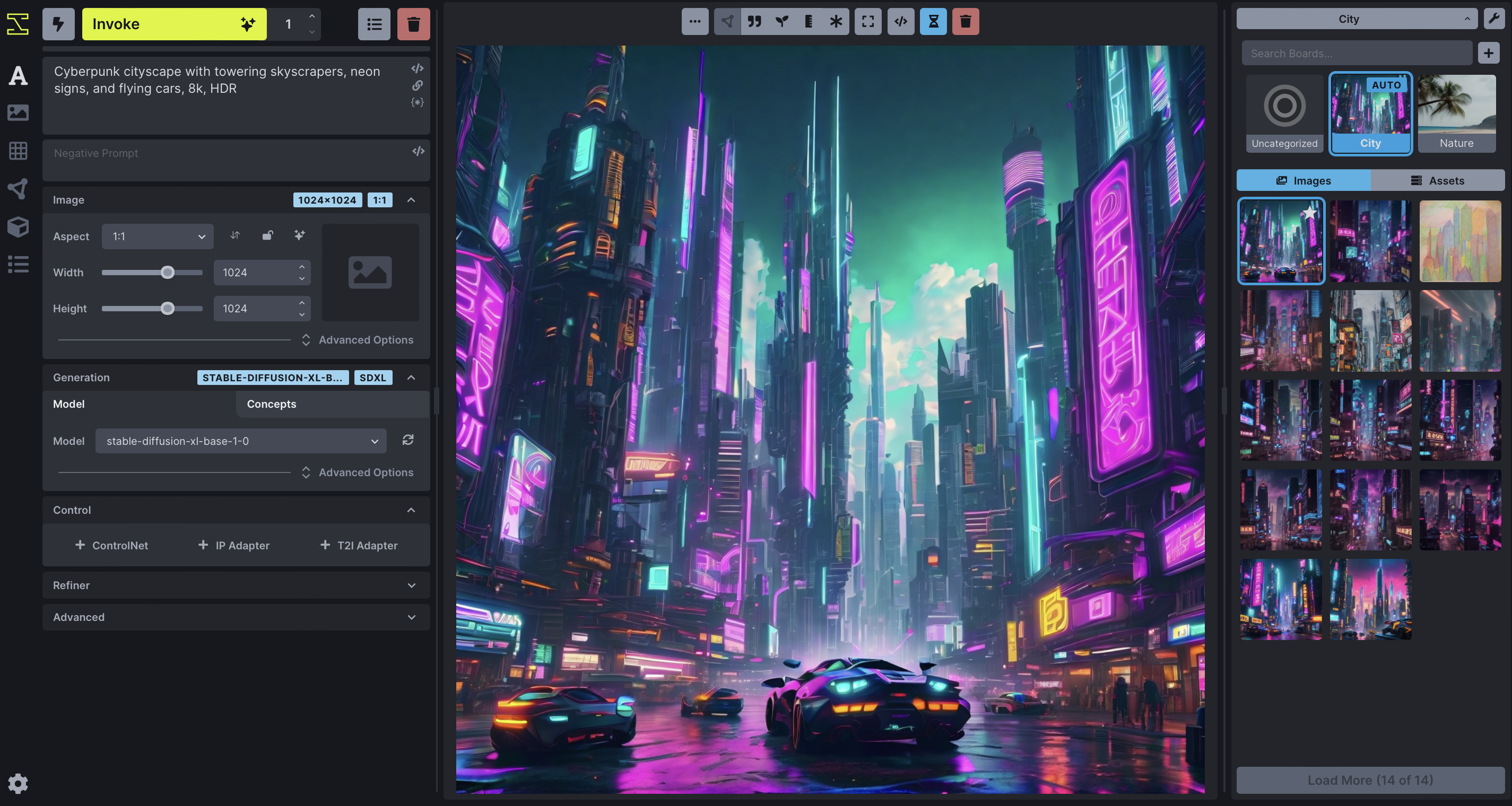 您可以閱讀有關[安裝和硬體要求](https://invoke-ai.github.io/InvokeAI/installation/INSTALLATION/)、[如何安裝不同型號](https://invoke-ai.github.io/InvokeAI/installation/050_INSTALLING_MODELS/)以及最重要的[自動安裝的資訊](https://invoke-ai.github.io/InvokeAI/installation/010_INSTALL_AUTOMATED/)。 令人興奮的功能是能夠使用另一個圖像生成圖像,如[文件](https://invoke-ai.github.io/InvokeAI/features/IMG2IMG/)中所述。 InvokeAI 在 GitHub 上有近 21k 顆星, https://github.com/invoke-ai/InvokeAI 明星 InvokeAI ⭐️ --- 8. [OpenAI](https://github.com/openai) - 您所需要的一切。 -------------------------------------------------  Gemini by Google 和 OpenAI 非常受歡迎,但我們在此列表中專注於 OpenAI。 如果您想了解更多訊息,可以在 Medium 上閱讀[Google AI Gemini API in web using React 🤖](https://generativeai.pub/google-gemini-api-in-web-using-react-7e5bf0bf0abc) 。這很簡單,也很切中要害。 透過 OpenAI,您可以使用 DALL·E(根據文字描述建立原創、逼真的圖像和藝術)、Whisper(語音辨識模型)和 GPT-4。在評論中告訴我們關於索拉的事吧! 您可以使用簡單的 API 開始建置。 ``` completion = openai.ChatCompletion.create( model="gpt-3.5-turbo", messages=[ {"role": "system", "content": "You are a helpful assistant."}, {"role": "user", "content": "What are some famous astronomical observatories?"} ] ) ``` 您可以閱讀[文件](https://platform.openai.com/docs/introduction)。它提供瞭如此多的選項來建立非常酷的東西! 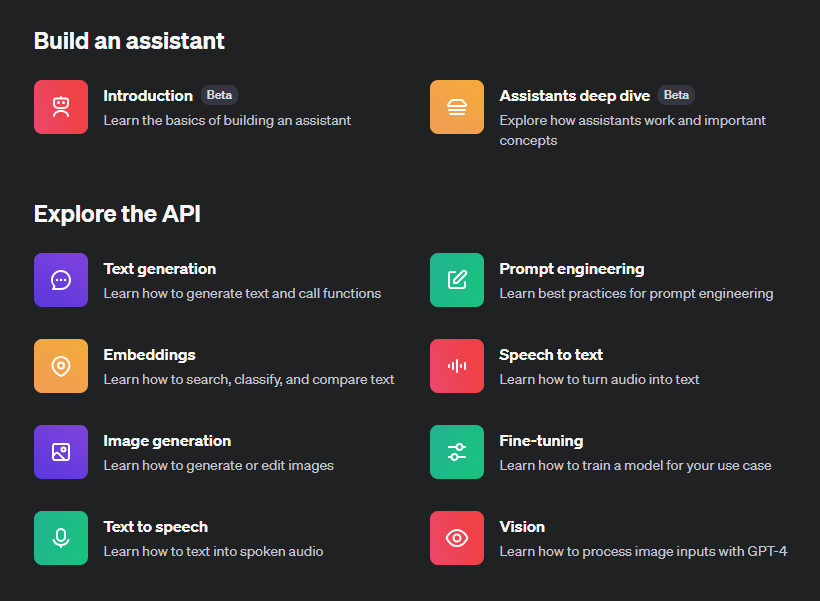 甚至 Stripe 也使用 GPT-4 來改善使用者體驗。 例如,您可以建立[Assistant 應用程式](https://platform.openai.com/docs/assistants/overview)並查看[API 遊樂場](https://platform.openai.com/playground/p/default-chat?model=text-davinci-003)以更好地理解它。 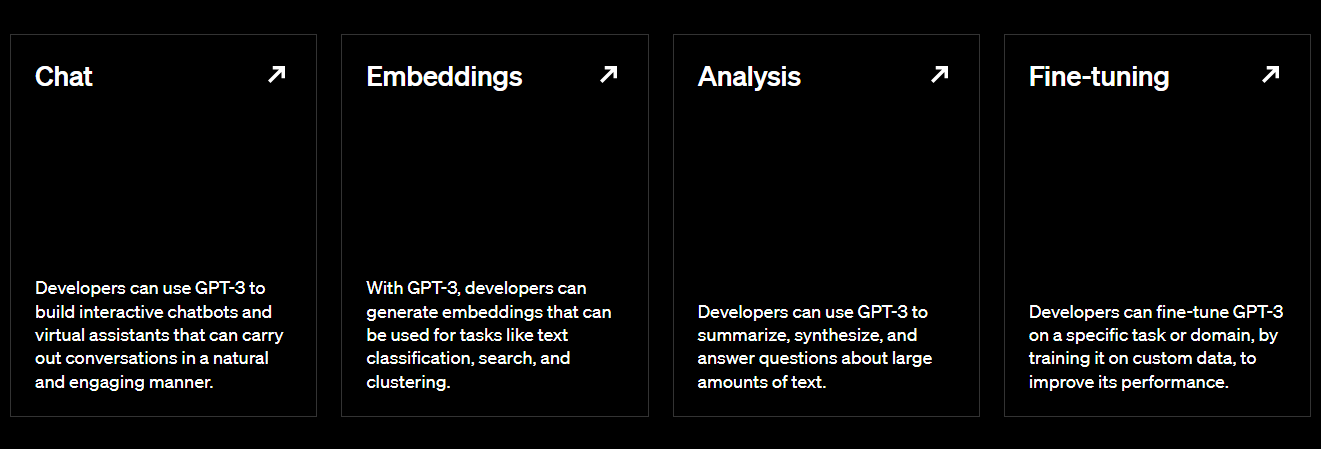 如果您需要指南,可以閱讀 Dzone 的[Integrating ChatGPT With ReactJS](https://dzone.com/articles/integrating-chatgpt-with-reactjs-a-comprehensive-g) 。 其間,OpenAI收購了Sora,獲得了壟斷地位。你怎麼認為? https://github.com/openai 明星 OpenAI ⭐️ --- 9. [DeepFaceLab](https://github.com/iperov/DeepFaceLab) - 用於建立深度贗品的領先軟體。 ------------------------------------------------------------------------  DeepFaceLab 是製作 Deepfakes 的頂級開源工具。 Deepfakes 是透過深度學習製作的經過修改的圖像和影片。它們經常被用來交換圖片或剪輯中的臉孔,有時是為了開玩笑,但也有出於有害的原因。 DeepFaceLab,用Python建置,是一個強大的deepfake工具。它可以改變媒體中的臉孔,甚至消除皺紋和老化跡象。 這些是您可以使用 DeepFaceLab 執行的一些操作。 - 換臉。  - [臉部抗衰老 - YouTube](https://www.youtube.com/watch?v=Ddx5B-84ebo) 。  - 更換頭部。  - 操縱嘴唇。 您可以使用這個基本教學來了解[如何有效地使用 DeepFaceLab](https://www.youtube.com/watch?v=kOIMXt8KK8M)來完成這些事情。 您可以在[YouTube](https://www.youtube.com/channel/UCGf4OlX_aTt8DlrgiH3jN3g/videos)上看到使用此 DeepLab 演算法的影片。 不幸的是,DeepFaceLab 中沒有「讓一切正常」按鈕,但值得根據您的特定需求了解其工作流程。 儘管它於 2023 年 11 月 9 日存檔,在 GitHub 上有近 44k+ 顆星,但由於其大量的教程和可靠的演算法,它仍然是您的 AI 應用程式的可靠選擇。 https://github.com/iperov/DeepFaceLab 明星 DeepFaceLab ⭐️ --- 10. [Detectron2](https://github.com/facebookresearch/detectron2) - 基於 PyTorch 的模組化物件偵測庫。 ----------------------------------------------------------------------------------------  Detectron2 是 Facebook AI Research 的下一代函式庫,提供最先進的偵測和分割演算法。它是 Detectron 和 maskrcnn-benchmark 的後繼者。 它支援 Facebook 上的多個電腦視覺研究專案和生產應用程式。 使用此[YouTube 教學](https://www.youtube.com/watch?v=eUSgtfK4ivk)將 Detectron2 與 Facebook 開發者倡導者的機器學習結合使用。 Detectron2 旨在支援各種最先進的物件偵測和分割模型,同時也適應不斷發展的前沿研究領域。 您可以閱讀[如何入門](https://detectron2.readthedocs.io/en/latest/tutorials/getting_started.html)以及 [元博客](https://ai.meta.com/blog/-detectron2-a-pytorch-based-modular-object-detection-library-/),其中深入介紹了 Detectron 的目標。 舊版的 Detectron 使用的是 Caffe,因此很難與後來結合 Caffe2 和 PyTorch 的程式碼變更一起使用。為了回應社群回饋,Facebook AI 發布了 Detectron2 作為更新的、更容易使用的版本。 Detectron2 配備了用於物件偵測的先進演算法,例如 DensePose 和全景特徵金字塔網路。 此外,Detectron2 還可以進行語義分割和全景分割,這有助於更準確地偵測和分割影像和影片中的物件。 Detectron2 不僅支援使用邊界框和實例分割遮罩進行物件偵測,還可以預測人體姿勢,與 Detectron 類似。 它們在 GitHub 儲存庫上擁有 28k+ Stars,並在 GitHub 上被 1.6k+ 開發人員使用。 https://github.com/facebookresearch/detectron2 Star Detectron2 ⭐️ --- [11.FastAI-](https://github.com/fastai/fastai)深度學習庫。 ---------------------------------------------------- 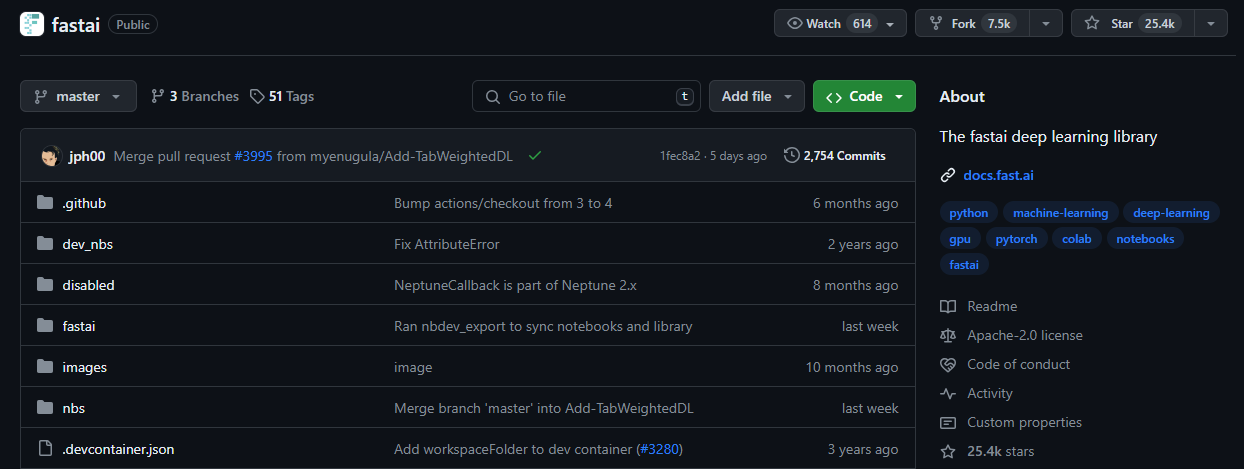 Fastai 是一個多功能的深度學習庫,旨在滿足從業者和研究人員的需求。它為從業者提供了高級元件,以便他們在常見的深度學習任務中快速獲得一流的結果。 同時,它為研究人員提供低階元件來實驗和開發新方法。 Detectron2 透過其分層架構實現了易用性和靈活性之間的平衡。 該架構將複雜的深度學習技術分解為可管理的抽象,簡潔地利用了 Python 的動態特性和 PyTorch 的靈活性。 它建構在較低層級 API 的層次結構之上,這些 API 提供可組合的建構塊。這樣,想要重寫部分高級 API 或加入特定行為以滿足其需求的用戶無需學習如何使用最低級別。 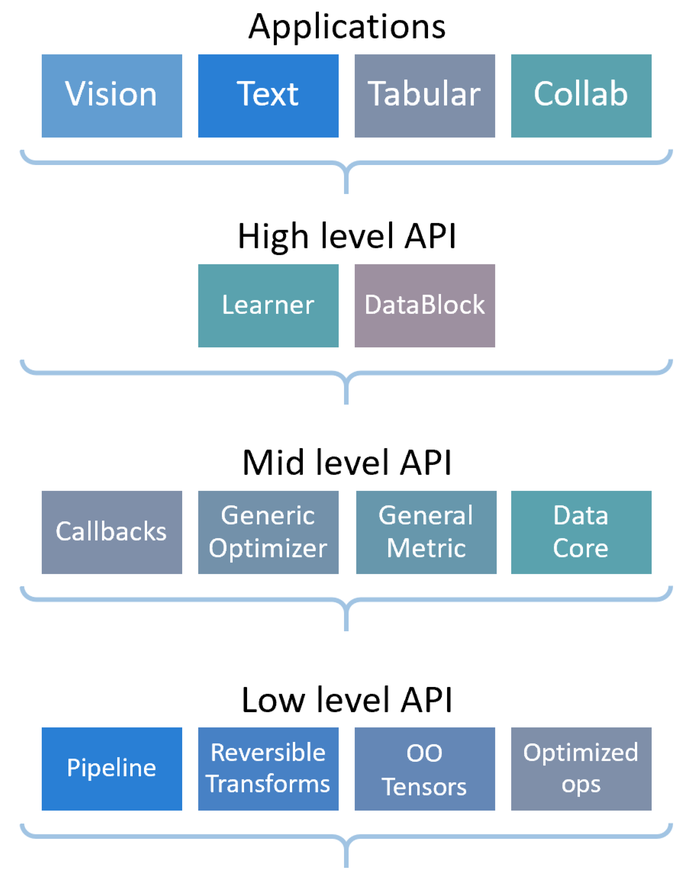 [安裝 pyTorch](https://pytorch.org/get-started/locally/)後即可開始使用以下命令。 ``` conda install -c fastai fastai ``` 您可以閱讀[文件](https://docs.fast.ai/)。 它們針對初學者、中級和專家的[教程](https://docs.fast.ai/tutorial.html)有不同的起點。 如果您想為 FastAI 做出貢獻,您應該閱讀他們的[程式碼風格指南](https://docs.fast.ai/dev/style.html)。 如果您更喜歡影片,可以在 YouTube 上觀看傑里米霍華德 (Jeremy Howard) 撰寫的[課程“0”:程式設計師實用深度學習 (fastai)](https://www.youtube.com/watch?v=gGxe2mN3kAg) 。 它們在 GitHub 上擁有超過 25,000 顆星,並已被 GitHub 上超過 16,000 名開發人員使用。 https://github.com/fastai/fastai 明星 FastAI ⭐️ --- 12.[穩定擴散](https://github.com/CompVis/stable-diffusion)- 潛在文字到影像擴散模型。 --------------------------------------------------------------------  > 什麼是穩定擴散? 穩定擴散是指生成模型中使用的一種技術,特別是在文字到圖像合成的背景下,其中將資訊從文字描述轉移到圖像的過程是逐漸且平滑地完成的。 在潛在文字到影像擴散模型中,穩定擴散可確保來自文字描述的訊息在整個模型的潛在空間中一致地擴散或傳播。這種擴散過程有助於產生與給定文字輸入相符的高品質和逼真的圖像。 穩定的擴散機制確保模型在生成過程中不會出現突然的跳躍或不穩定。我希望這能解決問題! 下載和採樣穩定擴散的簡單方法是使用[擴散器庫](https://github.com/huggingface/diffusers/tree/main#new--stable-diffusion-is-now-fully-compatible-with-diffusers)。 ``` # make sure you're logged in with `huggingface-cli login` from torch import autocast from diffusers import StableDiffusionPipeline pipe = StableDiffusionPipeline.from_pretrained( "CompVis/stable-diffusion-v1-4", use_auth_token=True ).to("cuda") prompt = "a photo of an astronaut riding a horse on mars" with autocast("cuda"): image = pipe(prompt)["sample"][0] image.save("astronaut_rides_horse.png") ``` 您可以閱讀[研究論文](https://ommer-lab.com/research/latent-diffusion-models/)以及有關[穩定擴散影像修改](https://github.com/CompVis/stable-diffusion?tab=readme-ov-file#image-modification-with-stable-diffusion)的更多資訊。 例如,這是輸入。  這是放大一點後的輸出。  Stable Diffusion v1 是一種特定的模型配置,它採用 860M UNet 和 CLIP ViT-L/14 文字編碼器進行擴散模型,並具有下採樣因子 8 自動編碼器。該模型在 256x256 影像上進行了預訓練,隨後在 512x512 影像上進行了微調。 他們在 GitHub 儲存庫上擁有大約 64k+ Stars。 https://github.com/CompVis/stable-diffusion 恆星穩定擴散 ⭐️ --- 13. [Mocap Drones](https://github.com/jyjblrd/Mocap-Drones) - 用於房間規模追蹤的低成本動作捕捉系統。 ---------------------------------------------------------------------------------  該專案需要 SFM(運動結構)OpenCV 模組,這需要您從原始程式碼編譯 OpenCV。 從`computer_code`目錄中,執行此命令來安裝節點相依性。 ``` yarn install yarn run dev // to start the web server. ``` 您將獲得前端介面的 URL 視圖。 開啟一個單獨的終端機視窗並執行命令`python3 api/index.py`來啟動後端伺服器。此伺服器負責接收攝影機串流並執行動作捕捉計算。 架構如下。  您可以觀看此[YouTube 影片](https://www.youtube.com/watch?v=0ql20JKrscQ)來了解 Mocap 無人機的工作原理,也可以觀看該專案所有者的[部落格](https://joshuabird.com/blog/post/mocap-drones)。 https://www.youtube.com/watch?v=0ql20JKrscQ 您可以閱讀[文件](https://github.com/jyjblrd/Mocap-Drones?tab=readme-ov-file#runing-the-code)。 這是一個最近的開源專案,在 GitHub 儲存庫上擁有 900 多個 star。 https://github.com/jyjblrd/Mocap-Drones 明星動捕無人機 ⭐️ --- 14. [Whisper Speech](https://github.com/collabora/WhisperSpeech) - 透過反轉 Whisper 建構的文字轉語音系統。 -------------------------------------------------------------------------------------------  該模型與穩定擴散類似,但用於語音,功能強大且高度可自訂。 該團隊確保使用經過適當許可的語音錄音,並且所有程式碼都是開源的,使該模型對於商業應用程式來說是安全的。 目前,這些模型是在英語 LibreLight 資料集上進行訓練的。 您可以進一步研究[架構](https://github.com/collabora/WhisperSpeech?tab=readme-ov-file#architecture)。  您可以聽到[範例聲音](https://github.com/collabora/WhisperSpeech/assets/107984/aa5a1e7e-dc94-481f-8863-b022c7fd7434)並使用[colab](https://colab.research.google.com/drive/1xxGlTbwBmaY6GKA24strRixTXGBOlyiw)自行嘗試。 它們相當新,在 GitHub 上有大約 3k+ 的星星。 https://github.com/collabora/WhisperSpeech 星語語音 ⭐️ --- 15. [eSpeak NG](https://github.com/espeak-ng/espeak-ng) - 支援一百多種語言和口音的語音合成器。 ----------------------------------------------------------------------------  eSpeak NG 是一款緊湊型開源軟體文字語音合成器,適用於 Linux、Windows、Android 和其他作業系統。它支援 100 多種語言和口音。它基於 Jonathan Duddington 建立的 eSpeak 引擎。 您可以閱讀各種系統上的[安裝指南](https://github.com/espeak-ng/espeak-ng/blob/master/docs/guide.md)。 對於類似 Debian 的發行版(例如 Ubuntu、Mint 等)。您可以使用此命令。 ``` sudo apt-get install espeak-ng ``` 您可以查看[支援的語言](https://github.com/espeak-ng/espeak-ng/blob/master/docs/languages.md)清單、閱讀[文件](https://github.com/espeak-ng/espeak-ng/tree/master?tab=readme-ov-file#documentation)並查看[功能](https://github.com/espeak-ng/espeak-ng/tree/master?tab=readme-ov-file#features)。 該模型將文字轉換為音素程式碼,表明其作為另一個語音合成引擎前端的潛在能力。 他們在 GitHub 上有 2700+ 顆星星, https://github.com/espeak-ng/espeak-ng 明星 eSpeak NG ⭐️ --- 16.[聊天機器人 UI](https://github.com/mckaywrigley/chatbot-ui) - 每個模型的人工智慧聊天。 ------------------------------------------------------------------------ 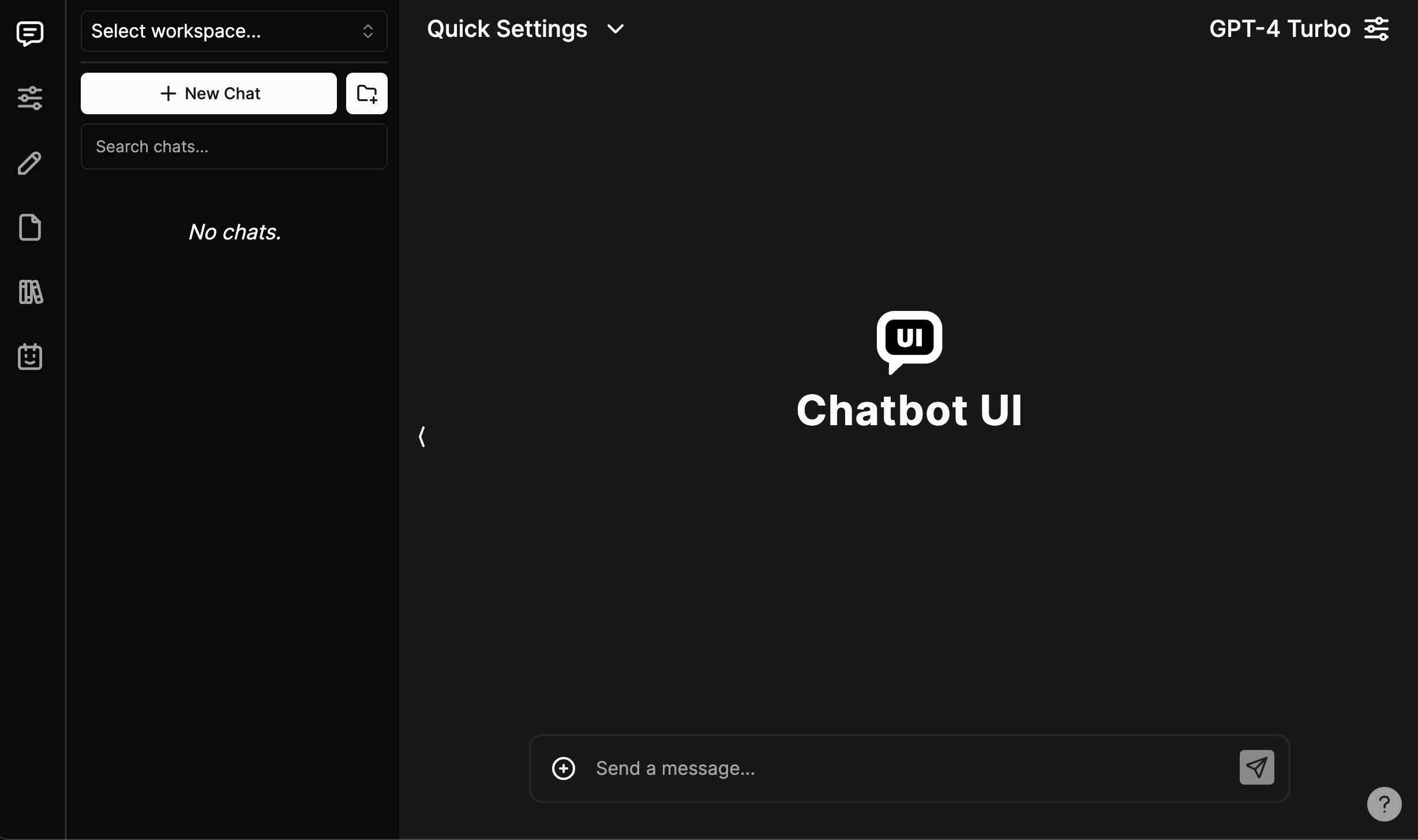 我們都使用過 ChatGPT,這個專案可以幫助我們為任何 AI 聊天機器人設定使用者介面。少一麻煩! 你可以閱讀[安裝指南](https://github.com/mckaywrigley/chatbot-ui?tab=readme-ov-file#1-install-docker)來安裝 docker、supabase CLI 和其他東西。 您可以閱讀<a href="">文件</a>並查看[演示](https://twitter.com/mckaywrigley/status/1738273242283151777?s=20)。 這在底層使用了 Supabase (Postgres),這就是我們之前討論它的原因。 我沒有討論 Vercel AI 聊天機器人,因為它與此機器人相比是一個相當新的比較。 Chatbot UI 在 GitHub 上擁有大約 25k+ Stars,因此它仍然是開發人員為任何聊天機器人建立 UI 介面的首選。 https://github.com/mckaywrigley/chatbot-ui 明星聊天機器人 UI ⭐️ --- 17. [GPT-4 & LangChain](https://github.com/mayooear/gpt4-pdf-chatbot-langchain) - 用於大型 PDF 文件的 GPT4 和 LangChain 聊天機器人。 -------------------------------------------------------------------------------------------------------------------------- 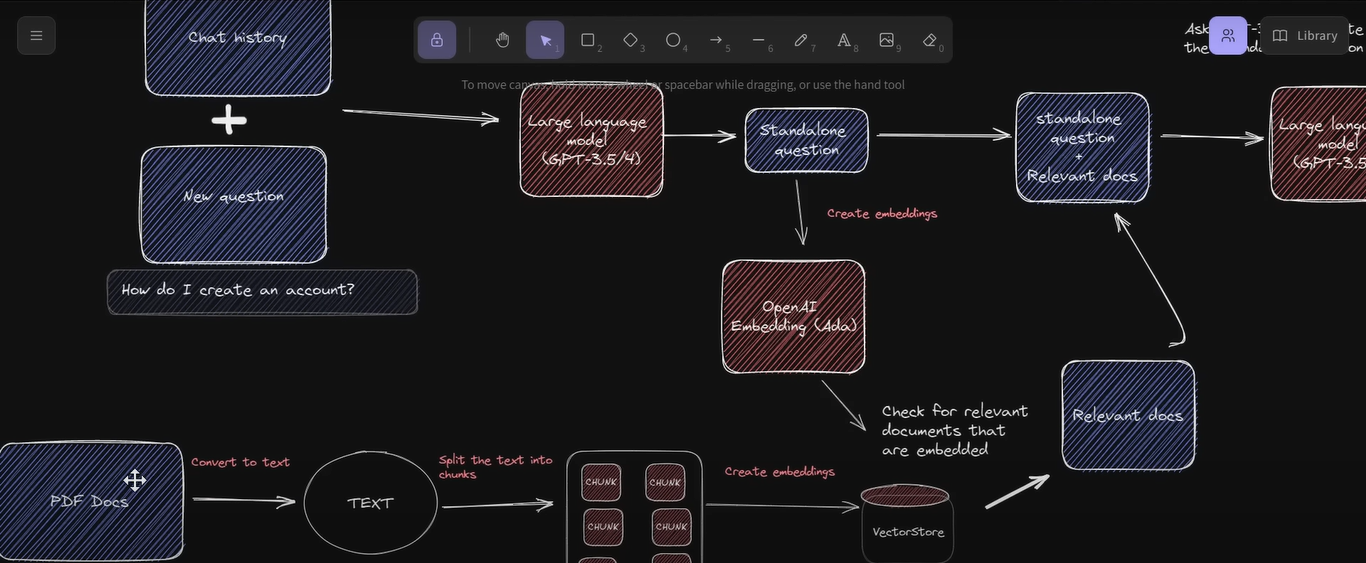 這可用於新的 GPT-4 API 來為多個大型 PDF 檔案建立 chatGPT 聊天機器人。 該系統是使用 LangChain、Pinecone、Typescript、OpenAI 和 Next.js 建構的。 LangChain 是一個簡化可擴展 AI/LLM 應用程式和聊天機器人開發的框架。 Pinecone 用作向量存儲,用於以文字格式儲存嵌入和 PDF,以便以後檢索類似文件。 您可以閱讀涉及複製、安裝依賴項和設定環境 API 金鑰[的開發指南](https://github.com/mayooear/gpt4-pdf-chatbot-langchain?tab=readme-ov-file#development)。 您可以觀看[YouTube 影片](https://www.youtube.com/watch?v=ih9PBGVVOO4),了解如何遵循和使用它。 他們在 GitHub 上擁有 14k+ Stars,僅提交了 34 次。在您的下一個人工智慧應用程式中嘗試! https://github.com/mayooear/gpt4-pdf-chatbot-langchain 明星 GPT-4 和 Langchain ⭐️ --- 18. [Amica](https://github.com/semperai/amica) - 允許您在瀏覽器中輕鬆與 3D 角色聊天。 ---------------------------------------------------------------------  Amica 是一個開源接口,用於透過語音合成和語音辨識與 3D 角色進行互動式通訊。 您可以匯入 VRM 文件,調整聲音以適合角色,並產生包含情緒表達的回應文字。 他們使用 Three.js、OpenAI、Whisper、Bakllava 等進行視覺處理。您可以閱讀[Amica 的工作原理](https://docs.heyamica.com/overview/how-amica-works)及其所涉及的[核心概念](https://docs.heyamica.com/overview/core-concepts)。 您可以克隆該存儲庫並使用它來[開始](https://docs.heyamica.com/getting-started/installation)。 ``` npm i npm run dev ``` 您可以閱讀[文件](https://docs.heyamica.com/)並查看[演示](https://amica.arbius.ai/),這真是太棒了:D  您可以觀看這段簡短的影片,了解它的功能。 https://www.youtube.com/watch?v=hUxAEnFiXH8 Amica 使用 Tauri 建立桌面應用程式。別擔心,我們在此清單的後面部分介紹了金牛座。 他們在 GitHub 上有 400 多個 Star,看起來非常容易使用。 https://github.com/semperai/amica Star Amica ⭐️ --- 19. [Hugging Face Transformers](https://github.com/huggingface/transformers) - 適用於 Pytorch、TensorFlow 和 JAX 的最先進的機器學習。 ----------------------------------------------------------------------------------------------------------------------  Hugging Face Transformers 可以輕鬆存取最先進的預訓練模型和演算法,用於文字分類、語言生成和問答等任務。該庫建置在 PyTorch 和 TensorFlow 之上,允許用戶以最少的努力將高級 NLP 功能無縫整合到他們的應用程式中。 憑藉大量預訓練模型和支援社區,Hugging Face Transformers 簡化了基於 NLP 的解決方案的開發。 這些模型可用於執行 100 多種語言的文本相關任務,例如文字分類、資訊擷取、問答、摘要、翻譯和文字生成。 它們還可以處理與影像相關的任務,例如影像分類、物件偵測和分割,以及與音訊相關的任務,例如語音辨識和音訊分類。 他們還可以執行各種模式的多任務處理,包括表格問答、光學字元辨識、從掃描文件中提取資訊、視訊分類和視覺問答。 您可以看到大量可用的[模型](https://huggingface.co/models)。 您可以瀏覽[文件](https://huggingface.co/docs/transformers/task_summary)以取得完整的目標並向您展示可以執行的各種任務的範例。 例如,使用管道的一種方法是用於影像分割。 ``` from transformers import pipeline segmenter = pipeline(task="image-segmentation") preds = segmenter( "https://huggingface.co/datasets/huggingface/documentation-images/resolve/main/pipeline-cat-chonk.jpeg" ) preds = [{"score": round(pred["score"], 4), "label": pred["label"]} for pred in preds] print(*preds, sep="\n") ``` Transformer 得到了 Jax、PyTorch 和 TensorFlow 這三個最廣泛使用的深度學習庫的支持,並且它們之間可以無縫整合。這種整合可以使用一個庫輕鬆訓練模型,然後加載它們以使用另一個庫進行推理。 它們在 GitHub 上擁有大約 120k+ 星,並被 142k+ 大量開發人員使用。試試看! https://github.com/huggingface/transformers 明星抱臉變形金剛 ⭐️ --- 20. [LLAMA](https://github.com/facebookresearch/llama) - LLaMA 模型的推理程式碼。 ------------------------------------------------------------------------  Llama 2 是 Facebook Research 開發的尖端技術,使個人、創作者、研究人員和各種規模的企業能夠使用大型語言模型負責任地實驗、創新和擴展他們的想法。 最新版本包括模型權重以及預訓練和微調 Llama 語言模型的起始程式碼,參數範圍從 7B 到 70B。 開始使用涵蓋以下步驟的[安裝指南](https://github.com/facebookresearch/llama?tab=readme-ov-file#quick-start)。 - 克隆並下載儲存庫。 - 安裝所需的依賴項。 - 從 Meta 網站註冊並下載模型。 - 執行提供的腳本來下載模型。 - 使用提供的命令在本地執行所需的模型。 您可以觀看由 ZeroToMastery 製作的關於什麼是美洲駝的[YouTube 影片](https://www.youtube.com/watch?v=OqZ0CSKzu10)。 您也可以在[Hugging Face](https://huggingface.co/meta-llama)和[Meta 官方頁面](https://llama.meta.com/)上查看型號清單和更多資訊。 Ollama 基於 llama,在 GitHub 上擁有 50k+ star。請參閱文件並使用此模型進行更多研究。 https://github.com/facebookresearch/llama 明星 LLAMA ⭐️ --- 21. [Fonoster](https://github.com/fonoster/fonoster) - Twilio 的開源替代品。 ---------------------------------------------------------------------  Fonoster Inc. 研究了一種創新的可編程電信堆棧,該堆疊將為企業提供完全基於雲端的實用程序,將電話服務與網路連接起來。 根據您想要實現的目標,有多種開始方法。 開始使用以下 npm 指令。 ``` npm install @fonoster/websdk // CDN is also available ``` 例如,您可以透過以下方式將 Fonoster 與 Google Speech API 結合使用。 (您將需要服務帳戶的金鑰) ``` npm install @fonoster/googleasr @fonoster/googletts ``` 這是您可以配置語音伺服器以使用插件的方法。 ``` const { VoiceServer } = require("@fonoster/voice"); const GoogleTTS = require("@fonoster/googletts"); const GoogleASR = require("@fonoster/googleasr"); const voiceServer = new VoiceServer(); const speechConfig = { keyFilename: "./google.json" }; // Set the server to use the speech APIS voiceServer.use(new GoogleTTS(speechConfig)); voiceServer.use(new GoogleASR(speechConfig)); voiceServer.listen(async(req, res) => { console.log(req); await res.answer(); // To use this verb you MUST have a TTS plugin const speech = await res.gather(); await res.say("You said " + speech); await res.hangup(); }); ``` 您可以閱讀[文件](https://fonoster.com/docs/overview/)。 他們提供了一個足以入門的免費套餐。 他們在 GitHub 上擁有大約 6k+ 顆星,並發布了 250 多個版本。 https://github.com/fonoster/fonoster 明星 Fonoster ⭐️ --- 22. [DIPY](https://github.com/dipy/dipy) - Python 中的 paragon 3D/4D+ 成像庫。 ------------------------------------------------------------------------  DIPY 是 Python 中領先的 3D/4D+ 成像庫。它包含用於空間歸一化、訊號處理、機器學習、統計分析和醫學影像視覺化的各種方法。 此外,它還包含計算解剖學的專門方法,包括擴散、灌注和結構成像。 您可以開始使用。 ``` pip install dipy // run this in python console import dipy print(dipy.get_info()) ``` 如果您使用的是 anaconda 或其他系統,您可以閱讀完整的[安裝指南](https://docs.dipy.org/stable/examples_built/quick_start/quick_start.html#sphx-glr-examples-built-quick-start-quick-start-py)。 您可以閱讀[文件](https://docs.dipy.org/stable/)並存取他們的[YouTube 頻道](https://www.youtube.com/c/diffusionimaginginpython)。 你可以看看詳細的[例子](https://docs.dipy.org/stable/examples_built/index.html)。  他們的下載量超過 428k,並且在 GitHub 儲存庫上擁有 600 多個 Star。 https://github.com/dipy/dipy 明星 DIPY ⭐️ --- 23. [Elastic Search](https://github.com/elastic/elasticsearch) - 免費開放式、分散式、RESTful 搜尋引擎。 ----------------------------------------------------------------------------------------   Elasticsearch 是一種分散式、RESTful 搜尋和分析引擎,能夠解決大量使用案例。 作為 Elastic Stack 的核心,它集中儲存您的資料,以實現閃電般的快速搜尋、微調的相關性以及可輕鬆擴展的強大分析。 他們闡述了使用 ElasticSearch 的用例。  Elasticsearch 使用標準 RESTful API 和 JSON。我們也使用多種語言(例如 Java、Python、.NET、SQL 和 PHP)來建立和維護客戶端。 該結構如下。 ``` const { Client } = require('@elastic/elasticsearch') const client = new Client({ node: 'http://localhost:9200' }) client .search({ index: 'social-*', body: { query: { match: { message: 'myProduct' } }, aggs: { top_10_states: { terms: { field: 'state', size: 10 } } } } }) .then(({ body }) => { const { hits } = body.hits console.log(hits) }) .catch(console.error) ``` 您可以閱讀<a href="">文件</a>並查看[功能清單](https://www.elastic.co/elasticsearch/features)。 儘管具有有用的功能,Elastic Search 的主要缺點是缺乏免費套餐。但是,您仍然可以利用免費試用版來探索和了解開源專案的架構。 Elastic Search 在 GitHub 上擁有超過 67k+ 的星星和近 1900 名貢獻者,並且處於`v8`版本中,正在不斷發展和改進。 https://github.com/elastic/elasticsearch 明星 Elastic Search ⭐️ --- 24. [Tauri](https://github.com/tauri-apps/tauri) - 使用 Web 前端建立更小、更快且安全的桌面應用程式。 ------------------------------------------------------------------------------ 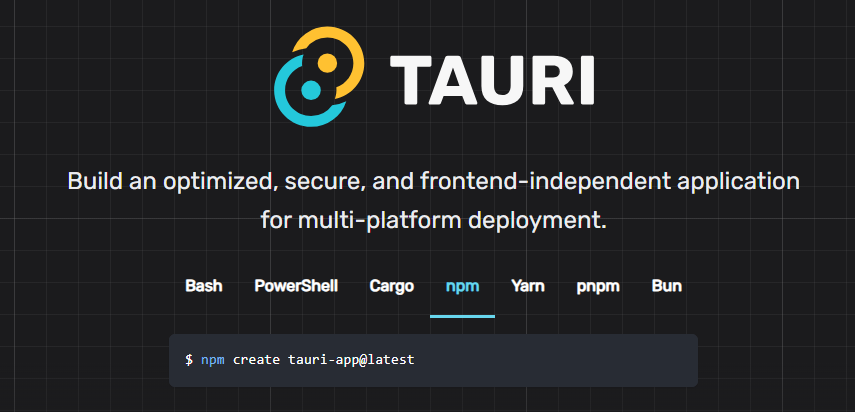 Tauri 是一個工具包,旨在幫助開發人員利用幾乎任何可用的前端框架為主要桌面平台建立應用程式。其核心是使用 Rust 開發的,而 CLI 利用 Node.js,提供了一種真正的多語言方法來開發和維護卓越的應用程式。 Tauri 應用程式中的使用者介面目前利用 Tao 作為 macOS、Windows、Linux、Android 和 iOS 上的視窗處理庫。 為了渲染您的應用程式,Tauri 使用 WRY,這是一個為系統 Web 視圖提供統一介面的程式庫。它在 macOS 和 iOS 上利用 WKWebView、在 Windows 上利用 WebView2、在 Linux 上利用 WebKitGTK 以及在 Android 上利用 Android System WebView。 您可以使用 Vite、HTML/CSS/JS、Next.js、Svelte 等等。 開始使用以下 npm 指令。 ``` npm create tauri-app@latest ``` 您可以閱讀[文件](https://tauri.app/v1/guides/getting-started/prerequisites)並查看 Tauri 提供的[功能清單](https://tauri.app/v1/guides/features/)。 您甚至可以使用 Tauri 建立自己的 CLI,這有多酷:) 團隊提供了[YouTube 影片](https://www.youtube.com/watch?v=UxTJeEbZX-0&t=2s),讓您了解更多關於 Tauri 的訊息。 他們在 GitHub 上擁有超過 75k 顆星星,並發布了 800 多個版本。 https://github.com/tauri-apps/tauri 金牛座之星 ⭐️ --- 25. [AutoGPT](https://github.com/Significant-Gravitas/AutoGPT) - 比 ChatGPT 更令人興奮。 ---------------------------------------------------------------------------------  AutoGPT 的核心在於其主要專案,即由大型語言模型 (LLM) 驅動的半自治代理,旨在為您執行任何任務。 AutoGPT 計畫由[四個主要部分](https://docs.agpt.co/#agent)組成: - 代理 – 也稱為“AutoGPT” - 基準 – 又稱 agbenchmark - 熔爐 - 前端 了解如何使用 OpenAI 金鑰[設定 AutoGPT](https://docs.agpt.co/autogpt/setup/) 。 您可以觀看[Fireship 發布的有關 AutoGPT 的 YouTube 影片](https://www.youtube.com/watch?v=_rGXIXyNqpk)。 https://www.youtube.com/watch?v=\_rGXIXyNqpk 您也可以觀看 Sentral Media 提供的[AutoGPT 教學](https://www.youtube.com/watch?v=FeIIaJUN-4A)。 您可以閱讀[文件](https://docs.agpt.co/)並查看[專案板](https://github.com/orgs/Significant-Gravitas/projects/1),以了解目前正在開發的內容。 即使您對 AI 不太了解,您也可以嘗試 AutoGPT 以了解如何節省時間並建立很酷的東西。 由於如此出色的用例和自動化功能,他們在 GitHub Repo 上擁有大約 159k+ 的星星。 https://github.com/Significant-Gravitas/AutoGPT 明星 AutoGPT ⭐️ --- 還沒結束。 現在,讓我們探索一些有價值的資源,這些資源將幫助您學習新概念並製作更好的人工智慧應用程式。 我們會保持簡單。不掛! - [人工智慧 (AI) 課程、書籍、視訊講座和論文](https://github.com/owainlewis/awesome-artificial-intelligence) - [機器學習/深度學習/AI + Web3 - 教程](https://github.com/TarrySingh/Artificial-Intelligence-Deep-Learning-Machine-Learning-Tutorials) - [ML 初學者](https://github.com/microsoft/ML-For-Beginners)- 12 週、26 節課程、52 個測驗,適合所有人的經典機器學習。 - [機器學習框架、函式庫和軟體](https://github.com/josephmisiti/awesome-machine-learning) - [如何製作人工智慧:逐步指南 - Revelo](https://www.revelo.com/blog/how-to-make-an-ai) 希望這將幫助您學習更多概念! --- 我希望您在列表中找到有用的東西。 我介紹了一些很棒的開源專案,它們可以將您的 AI 應用程式提升到一個新的水平。 人工智慧正在改變世界,最好與人工智慧保持朋友關係,而不是忽視它。 利用它來提高生產力,並抓住機會開發一些非凡的東西。 如果您想以最佳方式改進您的專案,有些開源專案比其他專案更有用,尤其是 Taipy 和 AutoGPT。 請發表評論,讓我們知道哪個專案最讓您感到驚訝。 祝你有美好的一天!直到下一次。 在 GitHub 上關注我。 https://github.com/Anmol-Baranwal 關注 Taipy 以了解更多此類內容。 https://dev.to/taipy --- 原文出處:https://dev.to/taipy/all-the-tools-i-need-to-build-a-perfect-ai-app-2oeh
介紹 --  踏上新的職業旅程常伴隨著興奮和高期望。然而,當面對類似混亂謎題的程式碼庫時,現實可能會截然不同。為了緩解這種常見情況,特別是對於擔任高階角色的開發人員來說,採用特定的最佳實踐勢在必行。這不僅可以確保程式碼品質,還可以讓您成為一絲不苟的專業人士,獲得公司內部的認可和潛在的晉升。  1. 最優路徑處理:絕對路徑優於相對路徑 -------------------- 想像一下,在迷宮中航行時,除了「後退四步,左轉兩次」這樣的神秘線索外,什麼都沒有。這就是程式碼中相對路徑的感覺。相反,擁抱絕對路徑的力量!這些提供了文件的完整地址,使導入變得一目了然,並使您免於無休止的猜測遊戲。設定它們可能需要使用 Webpack 或 TypeScript 等工具進行一些配置魔法,但相信我們,這是值得的。 額外提示:對於使用 create-react-app 的專案,一個簡單的 jsconfig.json 檔案可以成為你的英雄。只需幾行程式碼,您就可以定義導入的基本 URL,將怪物路徑 ../../../../../components/Button 轉換為時尚的 @/components/Button。 如果您使用 TypeScript,請將下列設定新增至「tsconfig.json」檔案: ``` { "compilerOptions": { "baseUrl": "src", "paths": { "@/*": ["src/*"] } }, "include": ["src"] } ``` 透過這樣做,您可以將程式碼片段轉換為如下所示: ``` //from this import { Button } from '../../../../components/Button' import { Icon } from '../../../../components/Icon' import { Input } from '../../../../components/Input' Into something cleaner and easier to read, like: //to this import { Button } from '@/components/Button' import { Icon } from '@/components/Icon' import { Input } from '@/components/Input' ``` 2.精簡模組組織:「出口桶」的威力 ----------------- 「導出桶」技術(也稱為「再導出」)大大提高了程式碼的可讀性和維護性。在資料夾中建立“index.js”(或 TypeScript 的“index.ts”)檔案並匯出所有模組可以簡化匯入並增強程式碼組織。 實施例: 想像一個包含「Button.tsx」、「Icon.tsx」和「Input.tsx」的「元件」資料夾。利用“匯出桶”,您可以建立一個“index.ts”檔案來簡化導入: ``` export * from './Button' export * from './Icon' export * from './Input' ``` 這種做法不僅減少了單獨導入的需求,還有助於建立更清晰、更易於理解的程式碼庫——這對於中型到大型專案至關重要。 3. 選擇“預設導出”和“命名導出” ------------------ 當我們深入研究「出口桶」主題時,必須注意它可能與「出口預設」的使用相衝突。如果這還不清楚,我將舉例說明情況: 讓我們回到我們的元件: ``` export const Button = () => { return <button>Button</button> } export default Button export const Icon = () => { return <svg>Icon</svg> } export default Icon export const Input = () => { return <input /> } export default Input ``` 想像一下,每個元件都在一個單獨的檔案中,並且您希望一次匯入所有元件。如果您習慣預設導入,您可以嘗試以下操作: ``` import Button from '@/components' import Icon from '@/components' import Input from '@/components' ``` 但是,這不起作用,因為 JavaScript 無法確定要使用哪個“導出預設值”,從而導致錯誤。你將被迫做這樣的事情: ``` import Button from '@/components/Button' import Icon from '@/components/Icon' import Input from '@/components/Input' ``` 然而,這抵消了「出口桶」的優勢。如何解決這個困境?解決方案很簡單:使用“命名導出”,即不使用“預設”導出: ``` import { Button, Icon, Input } from '@/components' ``` 與「匯出預設值」相關的另一個關鍵問題是重新命名導入內容的能力。我將分享我職業生涯早期的一個現實生活中的例子。我繼承了一個 React Native 專案,之前的開發人員對所有內容都使用「匯出預設值」。有一些名為「登入」、「註冊」和「忘記密碼」的畫面。然而,所有三個螢幕都是彼此的副本,並進行了微小的修改。問題是,在每個螢幕檔案的末尾,都有一個「匯出預設登入」。這導致了混亂,因為路由文件導入正確: ``` import Login from '../../screens/Login' import Register from '../../screens/Register' import ForgotPassword from '../../screens/ForgotPassword' ``` ``` // Further down, the usage in routes: { ResetPassword: { screen: ResetPassword }, Login: { screen: LoginScreen }, Register: { screen: RegisterScreen }, } ``` 但是當打開螢幕檔案時,它們都導出相同的名稱: ``` const login() { return <>tela de login</> } export default Login const login() { return <>tela de registro</> } export default Login const login() { return <>tela de esqueci minha senha</> } export default Login ``` 這造成了維護的噩夢,伴隨著持續的混亂,並且需要極度警惕以避免錯誤。 總之,強烈建議在專案中的大多數情況下使用“命名導出”,並僅在絕對必要時才使用“預設導出”。在某些情況下,例如 Next.js 路由和 React.lazy,可能需要使用「匯出預設值」。然而,在程式碼清晰度和符合特定要求之間取得平衡至關重要。 4. 正確的文件命名約定 ------------ 假設您有一個包含以下文件的元件資料夾: ``` --components: ----Button.tsx ----Icon.tsx ----Input.tsx ``` 現在,假設您想要將這些元件的樣式、邏輯或類型分開到單獨的文件中。你會如何命名這些文件?一個明顯的方法可能如下: ``` --components: ----Button.tsx ----Button.styles.css ----Icon.tsx ----Icon.styles.css ----Input.tsx ----Input.styles.css ``` 當然,這種方法可能看起來有些混亂且難以理解,特別是當您打算將元件進一步劃分為不同的文件(例如邏輯或類型)時。但如何才能保持結構井井有條呢?這是解決方案: ``` --components: ----Button ------index.ts (exports everything necessary) ------types.ts ------styles.css ------utils.ts ------component.tsx ----Icon ------index.ts (exports everything necessary) ------types.ts ------styles.css ------utils.ts ------component.tsx ----Input ------index.ts (exports everything necessary) ------types.ts ------styles.css ------utils.ts ------component.tsx ``` 這種方法可以輕鬆辨識每個文件的用途,並簡化對所需內容的搜尋。此外,如果您使用 Next.js 或類似框架,則可以調整檔案命名以指示該元件是用於客戶端還是伺服器端。例如: ``` --components: ----RandomComponent ------index.ts (exports everything necessary) ------types.ts ------styles.css ------utils.ts ------component.tsx ----RandomComponent2 ------index.ts (exports everything necessary) ------types.ts ------styles.css ------utils.ts ------component.server.tsx ``` 這樣,區分元件是用於客戶端還是伺服器端變得非常簡單,而無需打開程式碼進行驗證。組織和標準化文件命名對於保持開發專案的清晰度和效率至關重要。 5.正確使用ESLint和Prettier進行程式碼標準化 ---------------------------- 想像一下您與 10 多名同事一起處理一個專案,每個人都從過去的經驗中汲取了自己的編碼風格。這就是 ESLint 和 Prettier 發揮作用的地方。他們在維護整個團隊的程式碼一致性方面發揮著至關重要的作用。 Prettier 充當程式碼格式的“守護者”,確保每個人都遵守為專案設定的風格指南。例如,如果專案標準規定使用雙引號,則您不能簡單地選擇單引號,因為 Prettier 會自動替換它們。此外,Prettier 還可以執行各種其他修復和格式化,例如程式碼對齊、在語句末尾加入分號等等。具體的 Prettier 規則可以查看官方文件:Prettier Options。 另一方面,ESLint 對程式碼強制執行特定規則,有助於維護有凝聚力和連貫性的程式碼庫。例如,它可以強制使用箭頭函數而不是常規函數,確保正確填充 React 依賴項陣列,禁止使用“var”聲明以支援“let”和“const”,並應用駝峰命名法等命名約定。具體的ESLint規則可以在官方文件:ESLint Rules中找到。 ESLint 和 Prettier 的結合使用有助於保持原始程式碼的一致性。如果沒有它們,每個開發人員都可以遵循自己的風格,這可能會導致將來出現衝突和維護困難。設定這些工具對於專案的長壽至關重要,因為它有助於保持程式碼的組織性和易於理解。如果您還沒有使用 ESLint 和 Prettier,請認真考慮將它們合併到您的工作流程中,因為它們將使您的團隊和整個專案受益匪淺。 結論: --- 透過將這些最佳實踐合併到您的 React 開發工作流程中,您可以為一個更有組織、可讀和可維護的程式碼庫做出貢獻。繼續致力於提高編碼標準,如果您發現這些做法有用,請不要忘記按讚🦄!快樂編碼! 🚀 --- 原文出處:https://dev.to/sufian/5-essential-practices-for-front-end-developers-react-edition-3h96
長話短說 ==== 在本文中,您將學習如何建立由 AI 驅動的 PowerPoint 應用程式,該應用程式可以搜尋網路以自動製作有關任何主題的簡報。 我們將介紹使用: - 用於應用程式框架的 Next.js 🖥️ - 法學碩士 OpenAI 🧠 - LangChain 和 Tavily 的網路搜尋人工智慧代理🤖 - 使用 CopilotKit 將 AI 整合到您的應用程式中 🪁  --- CopilotKit:為您的應用程式建立人工智慧副駕駛 --------------------------- CopilotKit 是[開源人工智慧副駕駛平台。](https://github.com/CopilotKit/CopilotKit)我們可以輕鬆地將強大的人工智慧整合到您的 React 應用程式中。 建造: - ChatBot:上下文感知的應用內聊天機器人,可以在應用程式內執行操作 💬 - CopilotTextArea:人工智慧驅動的文字字段,具有上下文感知自動完成和插入功能📝 - 聯合代理:應用程式內人工智慧代理,可以與您的應用程式和使用者互動🤖  {% cta https://github.com/CopilotKit/CopilotKit %} Star CopilotKit ⭐️ {% endcta %} 現在回到文章。 (本文是我們三週前發表的一篇文章的進展,但您無需閱讀該文章即可理解這一點)。 --- **先決條件** -------- 在開始建立應用程式之前,讓我們先查看建置應用程式所需的依賴項或套件 `copilotkit/react-core` :CopilotKit 前端包,帶有 React hooks,用於向副駕駛提供應用程式狀態和操作(AI 功能) `copilotkit/react-ui` :聊天機器人側邊欄 UI 的 CopilotKit 前端包 `copilotkit/react-textarea` :CopilotKit 前端包,用於在演講者筆記中進行人工智慧輔助文字編輯。 `LangChainJS` :一個用於開發由語言模型支援的應用程式的框架。 `Tavily Search API` :幫助將法學碩士和人工智慧應用程式連接到可信賴的即時知識的 API。 安裝所有專案包和依賴項 ----------- 在安裝所有專案包和依賴項之前,我們首先在終端機上執行以下命令來建立 Nextjs 專案。 ``` npx create-next-app@latest ``` 然後系統會提示您選擇一些選項。請隨意標記它們,如下所示。 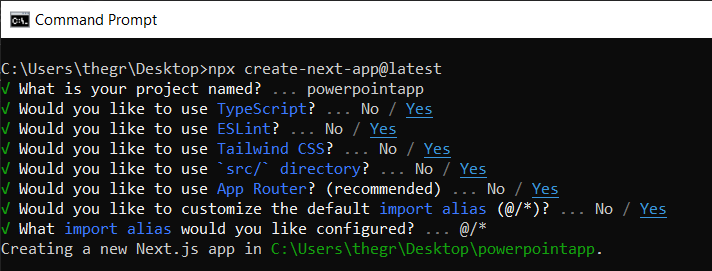 之後,使用您選擇的文字編輯器開啟新建立的 Nextjs 專案。然後在命令列中執行以下命令來安裝所有專案包和依賴項。 ``` npm i @copilotkit/backend @copilotkit/shared @langchain/langgraph @copilotkit/react-core @copilotkit/react-ui @copilotkit/react-textarea @heroicons/react ``` **建立 PowerPoint 應用程式前端** ------------------------ 讓我們先建立一個名為`Slide.tsx`的檔案。該文件將包含顯示和編輯投影片內容的程式碼,包括其`title` 、 `body text` 、 `background image`和`spoken narration text` 。 要建立該文件,請前往`/[root]/src/app`並建立一個名為`components`的資料夾。在 Components 資料夾中,建立`Slide.tsx`檔案。 之後,在文件頂部加入以下程式碼。程式碼定義了兩個名為`SlideModel`和`SlideProps`的 TypeScript 介面。 ``` "use client"; // Define an interface for the model of a slide, specifying the expected structure of a slide object. export interface SlideModel { title: string; content: string; backgroundImageDescription: string; spokenNarration: string; } // Define an interface for the properties of a component or function that manages slides. export interface SlideProps { slide: SlideModel; partialUpdateSlide: (partialSlide: Partial<SlideModel>) => void; } ``` 接下來,在上面的程式碼下面加入以下程式碼。程式碼定義了一個名為`Slide`功能元件,它接受`SlideProps`類型的 props。 ``` // Define a functional component named Slide that accepts props of type SlideProps. export const Slide = (props: SlideProps) => { // Define a constant for the height of the area reserved for speaker notes. const heightOfSpeakerNotes = 150; // Construct a URL for the background image using the description from slide properties, dynamically fetching an image from Unsplash. const backgroundImage = 'url("https://source.unsplash.com/featured/?' + encodeURIComponent(props.slide.backgroundImageDescription) + '")'; // Return JSX for the slide component. return ( <> {/* Slide content container with dynamic height calculation to account for speaker notes area. */} <div className="w-full relative bg-slate-200" style={{ height: `calc(100vh - ${heightOfSpeakerNotes}px)`, // Calculate height to leave space for speaker notes. }} > {/* Container for the slide title with centered alignment and styling. */} <div className="h-1/5 flex items-center justify-center text-5xl text-white text-center z-10" > {/* Textarea for slide title input, allowing dynamic updates. */} <textarea className="text-2xl bg-transparent text-black p-4 text-center font-bold uppercase italic line-clamp-2 resize-none flex items-center" style={{ border: "none", outline: "none", }} value={props.slide.title} placeholder="Title" onChange={(e) => { props.partialUpdateSlide({ title: e.target.value }); }} /> </div> {/* Container for the slide content with background image. */} <div className="h-4/5 flex" style={{ backgroundImage, backgroundSize: "cover", backgroundPosition: "center", }} > {/* Textarea for slide content input, allowing dynamic updates and styled for readability. */} <textarea className="w-full text-3xl text-black font-medium p-10 resize-none bg-red mx-40 my-8 rounded-xl text-center" style={{ lineHeight: "1.5", }} value={props.slide.content} placeholder="Body" onChange={(e) => { props.partialUpdateSlide({ content: e.target.value }); }} /> </div> </div> {/* Textarea for entering spoken narration with specified height and styling for consistency. */} <textarea className=" w-9/12 h-full bg-transparent text-5xl p-10 resize-none bg-gray-500 pr-36" style={{ height: `${heightOfSpeakerNotes}px`, background: "none", border: "none", outline: "none", fontFamily: "inherit", fontSize: "inherit", lineHeight: "inherit", }} value={props.slide.spokenNarration} onChange={(e) => { props.partialUpdateSlide({ spokenNarration: e.target.value }); }} /> </> ); }; ``` 之後,我們現在會建立一個名為`Presentation.tsx`的檔案。 該文件將包含初始化和更新投影片狀態、渲染目前投影片以及根據目前狀態動態啟用或停用按鈕實現導覽和投影片管理操作的程式碼。 要建立該文件,請將另一個文件新增至元件資料夾中,並將其命名為`Presentation.tsx` ,然後使用下列程式碼在檔案頂部匯入`React hooks` 、 `icons` 、 `SlideModel`和`Slide`元件。 ``` "use client"; import { useCallback, useMemo, useState } from "react"; import { BackwardIcon, ForwardIcon, PlusIcon, SparklesIcon, TrashIcon } from "@heroicons/react/24/outline"; import { SlideModel, Slide } from "./Slide"; ``` 之後,在上面的程式碼下面加入以下程式碼。程式碼定義了一個`ActionButton`功能元件,它將呈現具有可自訂屬性的按鈕元素。 ``` export const ActionButton = ({ disabled, onClick, className, children, }: { disabled: boolean; onClick: () => void; className?: string; children: React.ReactNode; }) => { return ( <button disabled={disabled} className={`bg-blue-500 text-white font-bold py-2 px-4 rounded ${disabled ? "opacity-50 cursor-not-allowed" : "hover:bg-blue-700"} ${className}`} onClick={onClick} > {children} </button> ); }; ``` 然後在上面的程式碼下面加入下面的程式碼。程式碼定義了一個名為「Presentation」的功能元件,用於初始化投影片的狀態並定義一個用於更新目前投影片的函數。 ``` // Define the Presentation component as a functional component. export const Presentation = () => { // Initialize state for slides with a default first slide and a state to track the current slide index. const [slides, setSlides] = useState<SlideModel[]>([ { title: `Welcome to our presentation!`, // Title of the first slide. content: 'This is the first slide.', // Content of the first slide. backgroundImageDescription: "hello", // Description for background image retrieval. spokenNarration: "This is the first slide. Welcome to our presentation!", // Spoken narration text for the first slide. }, ]); const [currentSlideIndex, setCurrentSlideIndex] = useState(0); // Current slide index, starting at 0. // Use useMemo to memoize the current slide object to avoid unnecessary recalculations. const currentSlide = useMemo(() => slides[currentSlideIndex], [slides, currentSlideIndex]); // Define a function to update the current slide. This function uses useCallback to memoize itself to prevent unnecessary re-creations. const updateCurrentSlide = useCallback( (partialSlide: Partial<SlideModel>) => { // Update the slides state by creating a new array with the updated current slide. setSlides((slides) => [ ...slides.slice(0, currentSlideIndex), // Copy all slides before the current one. { ...slides[currentSlideIndex], ...partialSlide }, // Merge the current slide with the updates. ...slides.slice(currentSlideIndex + 1), // Copy all slides after the current one. ]); }, [currentSlideIndex, setSlides] // Dependencies for useCallback. ); // The JSX structure for the Presentation component. return ( <div className="relative"> {/* Render the current slide by passing the currentSlide and updateCurrentSlide function as props. */} <Slide slide={currentSlide} partialUpdateSlide={updateCurrentSlide} /> {/* Container for action buttons located at the top-left corner of the screen. */} <div className="absolute top-0 left-0 mt-6 ml-4 z-30"> {/* Action button to add a new slide. Disabled state is hardcoded to true for demonstration. */} <ActionButton disabled={true} onClick={() => { // Define a new slide object. const newSlide: SlideModel = { title: "Title", content: "Body", backgroundImageDescription: "random", spokenNarration: "The speaker's notes for this slide.", }; // Update the slides array to include the new slide. setSlides((slides) => [ ...slides.slice(0, currentSlideIndex + 1), newSlide, ...slides.slice(currentSlideIndex + 1), ]); // Move to the new slide by updating the currentSlideIndex. setCurrentSlideIndex((i) => i + 1); }} className="rounded-r-none" > <PlusIcon className="h-6 w-6" /> {/* Icon for the button. */} </ActionButton> {/* Another action button, currently disabled and without functionality. */} <ActionButton disabled={true} onClick={async () => { }} // Placeholder async function. className="rounded-l-none ml-[1px]" > <SparklesIcon className="h-6 w-6" /> {/* Icon for the button. */} </ActionButton> </div> {/* Container for action buttons at the top-right corner for deleting slides, etc. */} <div className="absolute top-0 right-0 mt-6 mr-24"> <ActionButton disabled={slides.length === 1} // Disable button if there's only one slide. onClick={() => {}} // Placeholder function for the button action. className="ml-5 rounded-r-none" > <TrashIcon className="h-6 w-6" /> {/* Icon for the button. */} </ActionButton> </div> {/* Display current slide number and total slides at the bottom-right corner. */} <div className="absolute bottom-0 right-0 mb-20 mx-24 text-xl" style={{ textShadow: "1px 1px 0 #ddd, -1px -1px 0 #ddd, 1px -1px 0 #ddd, -1px 1px 0 #ddd", }} > Slide {currentSlideIndex + 1} of {slides.length} {/* Current slide and total slides. */} </div> {/* Container for navigation buttons (previous and next) at the bottom-right corner. */} <div className="absolute bottom-0 right-0 mb-6 mx-24"> {/* Button to navigate to the previous slide. */} <ActionButton className="rounded-r-none" disabled={ currentSlideIndex === 0 || true} // Example condition to disable button; 'true' is just for demonstration. onClick={() => { setCurrentSlideIndex((i) => i - 1); // Update currentSlideIndex to move to the previous slide. }} > <BackwardIcon className="h-6 w-6" /> {/* Icon for the button. */} </ActionButton> {/* Button to navigate to the next slide. */} <ActionButton className="mr-[1px] rounded-l-none" disabled={ true || currentSlideIndex + 1 === slides.length} // Example condition to disable button; 'true' is just for demonstration. onClick={async () => { setCurrentSlideIndex((i) => i + 1); // Update currentSlideIndex to move to the next slide. }} > <ForwardIcon className="h-6 w-6" /> {/* Icon for the button. */} </ActionButton> </div> </div> ); }; ``` 要在瀏覽器上呈現 PowerPoint 應用程式,請前往`/[root]/src/app/page.tsx`檔案並新增以下程式碼。 ``` "use client"; import "./style.css"; import { Presentation } from "./components/Presentation"; export default function AIPresentation() { return ( <Presentation /> ); } ``` 如果您想要在 Powerpoint 應用程式前端新增樣式,請在`/[root]/src/app`資料夾中建立名為`style.css`的檔案。 然後導航[到此 gist 文件](https://gist.github.com/TheGreatBonnie/e7c0b790a2e2af3e669810539ba54fed),複製 CSS 程式碼,並將其新增至 style.css 檔案。 最後,在命令列上執行命令`npm run dev` ,然後導航到 http://localhost:3000/。 現在您應該在瀏覽器上查看 PowerPoint 應用程式,如下所示。  **將 PowerPoint 應用程式與 CopilotKit 後端集成** -------------------------------------- 讓我們先在根目錄中建立一個名為`.env.local`的檔案。然後在保存 ChatGPT 和 Tavily Search API 金鑰的檔案中加入下面的環境變數。 ``` OPENAI_API_KEY="Your ChatGPT API key" TAVILY_API_KEY="Your Tavily Search API key" ``` 若要取得 ChatGPT API 金鑰,請導覽至 https://platform.openai.com/api-keys。  若要取得 Tavilly Search API 金鑰,請導覽至 https://app.tavily.com/home 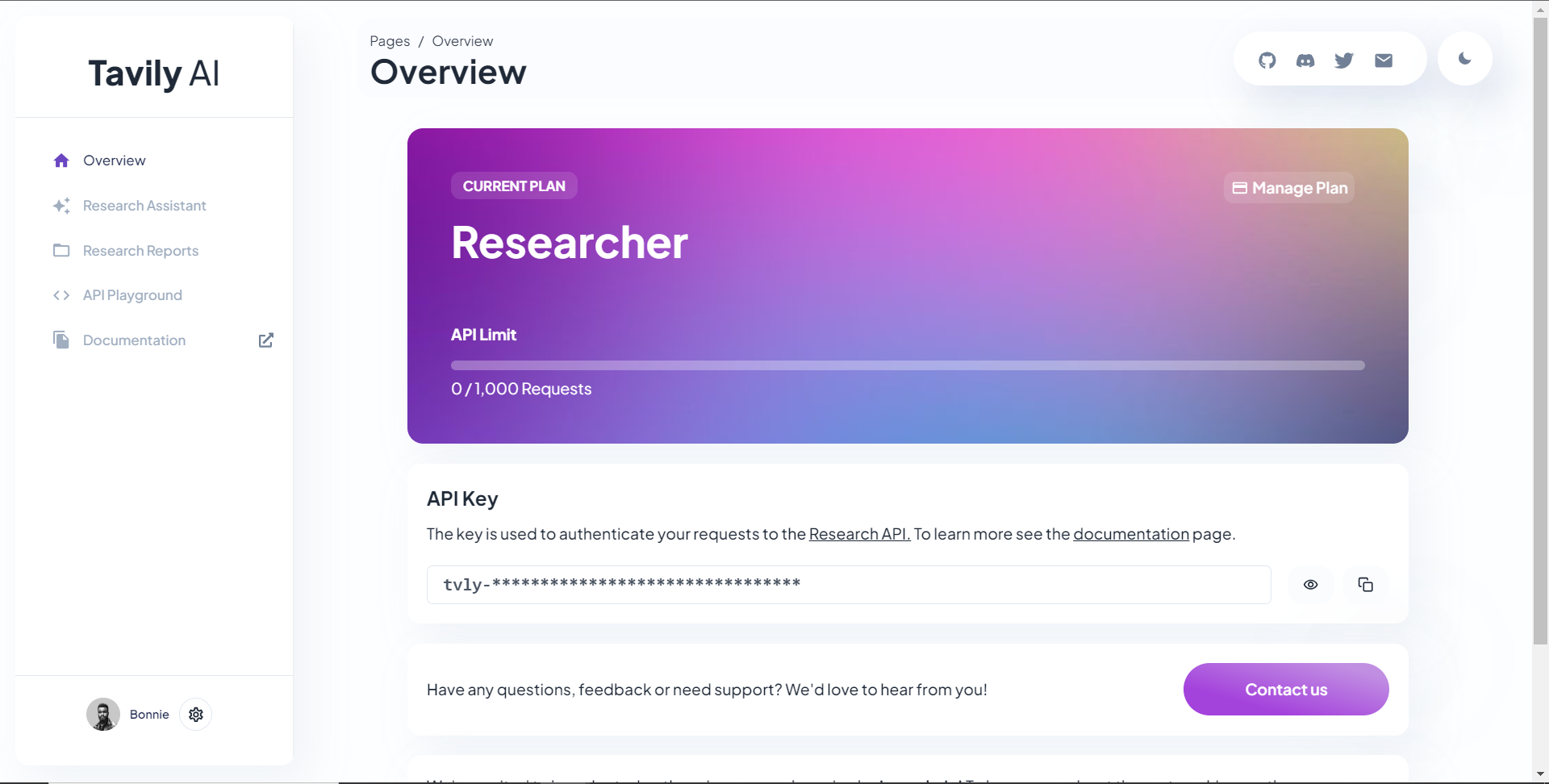 之後,轉到`/[root]/src/app`並建立一個名為`api`的資料夾。在`api`資料夾中,建立一個名為`copilotkit`的資料夾。 在`copilotkit`資料夾中,建立一個名為`research.ts`的檔案。然後導航到[該 Research.ts gist 文件](https://gist.github.com/TheGreatBonnie/58dc21ebbeeb8cbb08df665db762738c),複製程式碼,並將其新增至**`research.ts`**檔案中 接下來,在`/[root]/src/app/api/copilotkit`資料夾中建立一個名為`route.ts`的檔案。該文件將包含設定後端功能來處理 POST 請求的程式碼。它有條件地包括對給定主題進行研究的“研究”操作。 現在在文件頂部導入以下模組。 ``` import { CopilotBackend, OpenAIAdapter } from "@copilotkit/backend"; // For backend functionality with CopilotKit. import { researchWithLangGraph } from "./research"; // Import a custom function for conducting research. import { AnnotatedFunction } from "@copilotkit/shared"; // For annotating functions with metadata. ``` 在上面的程式碼下面,定義一個執行時環境變數和一個註解的函數,以便使用下面的程式碼進行研究。 ``` // Define a runtime environment variable, indicating the environment where the code is expected to run. export const runtime = "edge"; // Define an annotated function for research. This object includes metadata and an implementation for the function. const researchAction: AnnotatedFunction<any> = { name: "research", // Function name. description: "Call this function to conduct research on a certain topic. Respect other notes about when to call this function", // Function description. argumentAnnotations: [ // Annotations for arguments that the function accepts. { name: "topic", // Argument name. type: "string", // Argument type. description: "The topic to research. 5 characters or longer.", // Argument description. required: true, // Indicates that the argument is required. }, ], implementation: async (topic) => { // The actual function implementation. console.log("Researching topic: ", topic); // Log the research topic. return await researchWithLangGraph(topic); // Call the research function and return its result. }, }; ``` 然後在上面的程式碼下加入下面的程式碼來定義處理POST請求的非同步函數。 ``` // Define an asynchronous function that handles POST requests. export async function POST(req: Request): Promise<Response> { const actions: AnnotatedFunction<any>[] = []; // Initialize an array to hold actions. // Check if a specific environment variable is set, indicating access to certain functionality. if (process.env["TAVILY_API_KEY"]) { actions.push(researchAction); // Add the research action to the actions array if the condition is true. } // Instantiate CopilotBackend with the actions defined above. const copilotKit = new CopilotBackend({ actions: actions, }); // Use the CopilotBackend instance to generate a response for the incoming request using an OpenAIAdapter. return copilotKit.response(req, new OpenAIAdapter()); } ``` **將 PowerPoint 應用程式與 CopilotKit 前端集成** -------------------------------------- 讓我們先導入`/[root]/src/app/components/Slide.tsx`檔案頂部的`useMakeCopilotActionable`掛鉤。 ``` import { useMakeCopilotActionable } from "@copilotkit/react-core"; ``` 在 Slide 函數中,新增以下程式碼,該程式碼使用`useMakeCopilotActionable`掛鉤來設定一個名為`updateSlide`的操作,該操作具有特定參數以及根據提供的值更新投影片的實作。 ``` useMakeCopilotActionable({ // Defines the action name. This is a unique identifier for the action within the application. name: "updateSlide", // Describes what the action does. In this case, it updates the current slide. description: "Update the current slide.", // Details the arguments that the action accepts. Each argument has a name, type, description, and a flag indicating if it's required. argumentAnnotations: [ { name: "title", // The argument name. type: "string", // The data type of the argument. description: "The title of the slide. Should be a few words long.", // Description of the argument. required: true, // Indicates that this argument must be provided for the action to execute. }, { name: "content", type: "string", description: "The content of the slide. Should generally consists of a few bullet points.", required: true, }, { name: "backgroundImageDescription", type: "string", description: "What to display in the background of the slide. For example, 'dog', 'house', etc.", required: true, }, { name: "spokenNarration", type: "string", description: "The spoken narration for the slide. This is what the user will hear when the slide is shown.", required: true, }, ], // The implementation of the action. This is a function that will be called when the action is executed. implementation: async (title, content, backgroundImageDescription, spokenNarration) => { // Calls a function passed in through props to partially update the slide with new values for the specified properties. props.partialUpdateSlide({ title, content, backgroundImageDescription, spokenNarration, }); }, }, [props.partialUpdateSlide]); // Dependencies array for the custom hook or function. This ensures that the action is re-initialized only when `props.partialUpdateSlide` changes. ``` 之後,請前往`/[root]/src/app/components/Presentation.tsx`檔案並使用下面的程式碼匯入頂部的 CopilotKit 前端套件。 ``` import { useCopilotContext } from "@copilotkit/react-core"; import { CopilotTask } from "@copilotkit/react-core"; import { useMakeCopilotActionable, useMakeCopilotReadable } from "@copilotkit/react-core"; ``` 在演示函數中,加入以下程式碼,該程式碼使用`useMakeCopilotReadable`掛鉤加入`Slides`和`currentSlide`幻燈片陣列作為應用程式內聊天機器人的上下文。掛鉤使副駕駛可以讀取簡報中的整個幻燈片集合以及當前幻燈片的資料。 ``` useMakeCopilotReadable("These are all the slides: " + JSON.stringify(slides)); useMakeCopilotReadable( "This is the current slide: " + JSON.stringify(currentSlide) ); ``` 在`useMakeCopilotReadable`掛鉤下方,新增以下程式碼,該程式碼使用`useCopilotActionable`掛鉤來設定名為`appendSlide`的操作,其中包含說明和加入多張幻燈片的實作函數。 ``` useMakeCopilotActionable( { // Defines the action's metadata. name: "appendSlide", // Action identifier. description: "Add a slide after all the existing slides. Call this function multiple times to add multiple slides.", // Specifies the arguments that the action takes, including their types, descriptions, and if they are required. argumentAnnotations: [ { name: "title", // The title of the new slide. type: "string", description: "The title of the slide. Should be a few words long.", required: true, }, { name: "content", // The main content or body of the new slide. type: "string", description: "The content of the slide. Should generally consist of a few bullet points.", required: true, }, { name: "backgroundImageDescription", // Description for fetching or generating the background image of the new slide. type: "string", description: "What to display in the background of the slide. For example, 'dog', 'house', etc.", required: true, }, { name: "spokenNarration", // Narration text that will be read aloud during the presentation of the slide. type: "string", description: "The text to read while presenting the slide. Should be distinct from the slide's content, and can include additional context, references, etc. Will be read aloud as-is. Should be a few sentences long, clear, and smooth to read.", required: true, }, ], // The function to execute when the action is triggered. It creates a new slide with the provided details and appends it to the existing slides array. implementation: async (title, content, backgroundImageDescription, spokenNarration) => { const newSlide: SlideModel = { // Constructs the new slide object. title, content, backgroundImageDescription, spokenNarration, }; // Updates the slides state by appending the new slide to the end of the current slides array. setSlides((slides) => [...slides, newSlide]); }, }, [setSlides] // Dependency array for the hook. This action is dependent on the `setSlides` function, ensuring it reinitializes if `setSlides` changes. ); ``` 在上面的程式碼下方,定義一個名為`context`的變數,該變數使用名為`useCopilotContext`的自訂掛鉤從 copilot 上下文中檢索當前上下文。 ``` const context = useCopilotContext(); ``` 之後,定義一個名為`generateSlideTask`的函數,它包含一個名為`CopilotTask`的類別。 `CopilotTask`類別定義用於產生與簡報的整體主題相關的新投影片的指令 ``` const generateSlideTask = new CopilotTask({ instructions: "Make the next slide related to the overall topic of the presentation. It will be inserted after the current slide. Do NOT carry any research", }); ``` 然後在上面的程式碼下面初始化一個名為`generateSlideTaskRunning`的狀態變數,預設值為false。 ``` const [generateSlideTaskRunning, **setGenerateSlideTaskRunning**] = useState(false); ``` 之後,使用下面的程式碼更新簡報元件中的操作按鈕,以透過新增、刪除和導覽投影片來新增動態互動。 ``` // The JSX structure for the Presentation component. return ( <div className="relative"> {/* Renders the current slide using a Slide component with props for the slide data and a method to update it. */} <Slide slide={currentSlide} partialUpdateSlide={updateCurrentSlide} /> {/* Container for action buttons positioned at the top left corner of the relative parent */} <div className="absolute top-0 left-0 mt-6 ml-4 z-30"> {/* ActionButton to add a new slide. It is disabled when a generateSlideTask is running to prevent concurrent modifications. */} <ActionButton disabled={generateSlideTaskRunning} onClick={() => { const newSlide: SlideModel = { title: "Title", content: "Body", backgroundImageDescription: "random", spokenNarration: "The speaker's notes for this slide.", }; // Inserts the new slide immediately after the current slide and updates the slide index to point to the new slide. setSlides((slides) => [ ...slides.slice(0, currentSlideIndex + 1), newSlide, ...slides.slice(currentSlideIndex + 1), ]); setCurrentSlideIndex((i) => i + 1); }} className="rounded-r-none" > <PlusIcon className="h-6 w-6" /> </ActionButton> {/* ActionButton to generate a new slide based on the current context, also disabled during task running. */} <ActionButton disabled={generateSlideTaskRunning} onClick={async () => { setGenerateSlideTaskRunning(true); // Indicates the task is starting. await generateSlideTask.run(context); // Executes the task with the current context. setGenerateSlideTaskRunning(false); // Resets the flag when the task is complete. }} className="rounded-l-none ml-[1px]" > <SparklesIcon className="h-6 w-6" /> </ActionButton> </div> {/* Container for action buttons at the top right, including deleting the current slide and potentially other actions. */} <div className="absolute top-0 right-0 mt-6 mr-24"> {/* ActionButton for deleting the current slide, disabled if a task is running or only one slide remains. */} <ActionButton disabled={generateSlideTaskRunning || slides.length === 1} onClick={() => { console.log("delete slide"); // Removes the current slide and resets the index to the beginning as a simple handling strategy. setSlides((slides) => [ ...slides.slice(0, currentSlideIndex), ...slides.slice(currentSlideIndex + 1), ]); setCurrentSlideIndex((i) => 0); }} className="ml-5 rounded-r-none" > <TrashIcon className="h-6 w-6" /> </ActionButton> </div> {/* Display showing the current slide index and the total number of slides. */} <div className="absolute bottom-0 right-0 mb-20 mx-24 text-xl" style={{ textShadow: "1px 1px 0 #ddd, -1px -1px 0 #ddd, 1px -1px 0 #ddd, -1px 1px 0 #ddd", }} > Slide {currentSlideIndex + 1} of {slides.length} </div> {/* Navigation buttons to move between slides, disabled based on the slide index or if a task is running. */} <div className="absolute bottom-0 right-0 mb-6 mx-24"> {/* Button to move to the previous slide, disabled if on the first slide or a task is running. */} <ActionButton className="rounded-r-none" disabled={generateSlideTaskRunning || currentSlideIndex === 0} onClick={() => { setCurrentSlideIndex((i) => i - 1); }} > <BackwardIcon className="h-6 w-6" /> </ActionButton> {/* Button to move to the next slide, disabled if on the last slide or a task is running. */} <ActionButton className="mr-[1px] rounded-l-none" disabled={generateSlideTaskRunning || currentSlideIndex + 1 === slides.length} onClick={async () => { setCurrentSlideIndex((i) => i + 1); }} > <ForwardIcon className="h-6 w-6" /> </ActionButton> </div> </div> ); ``` 現在讓我們轉到`/[root]/src/app/page.tsx`文件,使用下面的程式碼匯入 CopilotKit 前端包和文件頂部的樣式。 ``` import { CopilotKit, } from "@copilotkit/react-core"; import { CopilotSidebar } from "@copilotkit/react-ui"; import "@copilotkit/react-ui/styles.css"; import "@copilotkit/react-textarea/styles.css"; ``` 然後使用`CopilotKit`和`CopilotSidebar`來包裝Presentation元件,如下所示。 ``` export default function AIPresentation() { return ( <CopilotKit url="/api/copilotkit/"> <CopilotSidebar instructions="Help the user create and edit a powerpoint-style presentation. IMPORTANT NOTE: SOMETIMES you may want to research a topic, before taking further action. BUT FIRST ASK THE USER if they would like you to research it. If they answer 'no', do your best WITHOUT researching the topic first." defaultOpen={true} labels={{ title: "Presentation Copilot", initial: "Hi you! 👋 I can help you create a presentation on any topic.", }} clickOutsideToClose={false} > <Presentation /> </CopilotSidebar> </CopilotKit> ); } ``` 之後,執行開發伺服器並導航到 http://localhost:3000/。您應該會看到應用程式內聊天機器人已整合到 PowerPoint Web 應用中。  最後,給右側的聊天機器人一個提示,例如“在 JavaScript 上建立 PowerPoint 簡報”,聊天機器人將開始產生回應,完成後,使用底部的前進按鈕瀏覽產生的幻燈片。 注意:如果聊天機器人沒有立即產生投影片,請根據其回應給予適當的後續提示。  結論 -- 總而言之,您可以使用 CopilotKit 建立應用內 AI 聊天機器人,該機器人可以查看當前應用程式狀態並在應用程式內執行操作。 AI 聊天機器人可以與您的應用程式前端、後端和第三方服務對話。 完整的原始碼:https://github.com/TheGreatBonnie/aipoweredpowerpointapp --- 原文出處:https://dev.to/copilotkit/how-to-build-an-ai-powered-powerpoint-generator-langchain-copilotkit-openai-nextjs-4c76
🔑 關鍵概念 ------ 什麼是可重複使用的 React 元件?您可以將它們視為建置塊。 它們是獨立的程式碼片段,可以在整個網站中重複使用,以節省您的時間和精力。 它們可以是從簡單按鈕到複雜表單的任何內容。 **為什麼要使用可重複使用的元件?** 隨著您的網站的發展,您可以透過組合現有元件輕鬆加入新功能。這使您的程式碼更具可擴展性和適應性。 您可以**在未來的專案中使用可重複使用的程式碼,**而無需從頭開始重新編寫。 --- 🧩 如何寫出乾淨、可重複使用的 React 元件 ------------------------ 在編寫乾淨的可重複使用 React 元件時,需要記住以下*兩個最重要的*事情:  **1. 🩼避免副作用。**不要將與外部資料互動的邏輯(例如進行 API 呼叫)直接放入可重複使用元件中。相反,將此邏輯作為`props`傳遞給元件。 例如,如果一個按鈕不僅僅是看起來漂亮,例如從網路獲取資料,**那麼它可能無法重複使用。** 在您掌握透過最佳實踐傳遞 props 的概念之前,我不會向您展示這方面的範例。繼續閱讀。 這是一個可重複使用的按鈕元件。但它缺乏最佳實踐。我將在範例部分向您展示原因。 ``` // This is a reusable button component (bad practice!) const Button = () => { return ( <button> Click Me </button> ); } ``` **2. 🗃️使用 props。** Props 是傳遞給元件以自訂其行為和外觀的參數。這允許您將相同的元件用於不同的目的。 ``` // This is a button component that can change its color const Button = ({ color }) => { return ( <button style={{ backgroundColor: color }}> Click Here </button> ); } ``` 這仍然是一個不好的做法,因為您有一個名為「點擊這裡」的固定標籤。如果您想更改按鈕上的文本,例如“註冊”,那麼您必須返回按鈕元件並進行更改。 這意味著每次我們想要使用不同的文字時,我們都必須返回並編輯程式碼。換句話說,它不再可重複使用。 **💪 挑戰:**那麼解決方案是什麼? 你已經有了答案。但如果您不這樣做,我將在範例部分向您展示。 **🌴提示:**考慮一下您可能希望如何在不同情況下使用該元件,並將其設計得靈活且適應性強。 🍃可重複使用 React 元件的範例 ------------------ 以下是可重複使用 React 元件的一些常見範例,以及一些幫助您入門的程式碼範例: **1. 按鈕:**具有不同樣式和功能的基本按鈕。 ``` // Button component import React from "react"; const Button = ({ color, label, onClick }) => { return ( <button className={`padding-2 shadow-none hover:shadow background-light-${color} hover:background-dark-${color}`} onClick={onClick} > {label} </button> ); }; export default Button; // Using the Button component <Button color="blue" label="Click Here" onClick={() => console.log("Button clicked!")} /> ``` 正如你所看到的,我沒有在按鈕元件中寫“Click Here”。我想讓我的按鈕可重複使用,因此它不知道有關自訂樣式或文字的任何資訊。 因此,我將它們作為 props(例如,顏色、標籤、onClick)傳遞,以便將來更改它們,而無需觸摸原始按鈕元件。希望這能說清楚。 > **🪜解決方案:**您需要將每個功能作為可重複使用元件中的`props`傳遞 - 就是這樣。 **2. 導覽列:**在整個網站上提供一致導覽的導覽列。 ``` // Navbar component import React from "react"; const Navbar = ({ isLoggedIn }) => { return ( <div className="navbar"> <div className="navbar-container"> <div className="navbar-logo"> <img src={logo} alt="logo" /> </div> <div className="navbar-links"> <a href="/">Home</a> <a href="/about">About</a> <a href="/contact">Contact</a> {isLoggedIn ? ( <a href="/profile">Profile</a> ) : ( <a href="/login">Login</a> )} </div> </div> </div> ); }; export default Navbar; // Using the Navbar component <Navbar isLoggedIn={true} /> ``` 如您所見,我通過了`<Navbar isLoggedIn={true} />` 此行利用`Navbar`元件並傳遞值為 true 的`isLoggedIn`屬性,表示使用者已登入。這將顯示「個人資料」連結並隱藏「登入」連結。 與按鈕元件類似,導覽列元件是可重複使用的,並接受 props 來自訂其行為。完美的! **3. 為什麼在按鈕元件中呼叫 API 是不好的做法** 現在,您已經了解了 React 中可重複使用元件的所有內容。 讓我們透過解決一個複雜的問題來更深入地研究。 考慮這樣的場景,您有一個執行 API 呼叫的按鈕。按鈕元件的程式碼可以如下: ``` import React from "react"; import doAPICall from "../api" const SaveButton = () => { return ( <button onClick={() => { doAPICall(); }} > Save </button> ); } export default SaveButton ``` 很明顯,您不能在多個地方重複使用上述按鈕,因為該按鈕元件內部包含副作用( `doAPICall()` )。 為了使該元件可重複使用,首先,您必須提取副作用並將其作為 prop 傳遞給按鈕元件,如下所示: ``` const App = () => { function doAPICall() { // Does an API call to save the current state of the app. } return ( <div> <SaveButton onClick={doAPICall}/> </div> ) } ``` 按鈕元件將如下所示: ``` const SaveButton = ({ onClick }) => { return ( <button onClick={onClick} > Save </button> ); } ``` 正如您所看到的,現在可以在您想要透過點擊按鈕儲存資料的所有位置重複使用上面的按鈕。該按鈕現在可以在多個地方像這樣使用: ``` const App = () => { function saveUser() { // Does an API call to save the user. } function saveProject() { // Does an API call to save the project. } return ( <div> <SaveButton onClick={saveUser}/> <SaveButton onClick={saveProject}/> </div> ) } ``` 您也可以透過使用 prop 來控制標籤,使按鈕元件更具可重複使用性,如下所示: ``` const App = () => { function saveUser() { // Does an API call to save the user. } function saveProject() { // Does an API call to save the project. } return ( <div> <SaveButton onClick={saveUser} label="Save user" /> <SaveButton onClick={saveProject} label="Save project" /> </div> ) } ``` 按鈕元件將如下所示: ``` const SaveButton = ({ onClick, label }) => { return ( <button onClick={onClick} > {label} </button> ); } ``` **🫧 推薦:🤖🦾 [Figma AI:](https://psxid.figma.com/8g4g75niz3sg-7v0ro9)** 如果您需要快速設計簡報或網站,Figma AI 可以提供現成的範本。並且它可以與[Figma](https://psxid.figma.com/pq1612tcamkx)順利配合。只要告訴它你想要什麼,畫一點,然後繁榮——你的想法就變成現實了!  您可以嘗試[Figma AI](https://psxid.figma.com/8g4g75niz3sg-7v0ro9) ,目前它對所有人免費。 --- 👏結論 --- 恭喜!您已經成功學習如何使用最佳實踐建立乾淨的可重複使用 React 元件。 請記住,**可重複使用元件是健壯的 React 開發的建置塊**。透過練習可重複使用元件,您可以建立更乾淨、更有效率、更易於維護的 React 應用程式。 您練習得越多,您就越能更好地辨識在專案中使用它們的機會! 如果您喜歡這篇文章,您可能也會喜歡我的[𝕏](https://twitter.com/shahancd)帳戶,以了解更多有關前端開發的課程。 **閱讀更多:**[前端開發的未來](https://dev.to/codewithshahan/the-future-of-frontend-development-1amd) --- 原文出處:https://dev.to/codewithshahan/writing-clean-reusable-components-in-react-best-practices-2gka
想像一下,您的客戶要求您建立一個 Web 應用程式,以滿足其客戶的所有需求。這就是你的客戶會告訴你的全部內容,你能建造它嗎?很明顯,您錯過了更多訊息,並且存在要求,但您知道什麼是要求嗎?如果我們沒有明確定義它們,會產生什麼後果?存在哪些類型的需求?本文將嘗試以簡單的方式回答其中一些問題。 概括 -- - [什麼是要求?](#what-is-a-requirement) - [為什麼它們很重要以及需求定義不明確的後果](#why-they-matters-and-consequence-of-poorly-defined-requirements) - [我們怎樣才能有一個好的需求](#how-we-can-have-a-good-requirement) - [要求等級](#levels-of-requirements) ``` - [User requirements](#user-requirements) ``` ``` - [System requirements](#system-requirements) ``` - [要求類型](#types-of-requirements) ``` - [Functional requirements](#functional-requirements) ``` ``` - [Non-functional requirements](#non-functional-requirements) ``` - [結論](#conclusion) 什麼是要求? ------ 首先,我們需要了解軟體開發環境中的需求是什麼。 Shari Pleeger 給我們下了一個很好的定義: > 系統特徵或系統為實現其目標而能夠完成的事情的描述 換句話說,要求是辨識產品或流程操作、功能或設計約束或特徵的聲明,該聲明是**明確的**、**可**測試的、**可測量**的,並且是接受產品或流程所必需的(由消費者或內部品質保證指南) 。 每個需求都是基於現實中存在的問題而建立的,而軟體只是解決它的一種方法。 為什麼它們很重要以及需求定義不明確的後果 -------------------- 現在我們知道什麼是要求,我們必須問: > “為什麼對於從事 IT 工作的人來說了解它如此重要?” 我會給你一些原因。根據要求,我們能夠: - 為專案規劃提供依據 - 對於研究變更請求至關重要 - 允許從開發的最早階段進行風險管理 - 它們是驗收測試的基礎 - 合約管理  如果我們的需求定義不明確會發生什麼事? 第一個也是合乎邏輯的後果是專案交付的延遲。當我們開始一個專案或衝刺時,沒有對要開發的內容有所有明確的要求,存在錯誤的可能性是巨大的!因此,開發人員和 QA 團隊需要承擔更多工作,從而降低了他們的生活品質。 如果出現在Production中,就會有許多不滿意的用戶,讓產品的信心降低,甚至導致系統報廢。另一個後果是維護系統的成本。 我們怎樣才能有一個好的需求 ------------- 需求的編寫方式因團隊而異,但它們都應該具有以下三個特徵: - 明確 - 可測試 - 可測量的 要求等級 ---- ### 用戶要求 使用者需求定義了我們的軟體需要做什麼。它可以透過使用者的需求、期望、限制和介面來描述使用者面臨的問題。 此類需求是為客戶編寫的,我們使用自然語言加圖表。我們可以使用待辦事項清單應用程式的使用者需求範例: > 使用者應該能夠在清單中插入新任務 ### 系統需求 系統需求是定義系統有效運作所需的硬體、軟體和網路元件的功能和約束的規格。 這些要求對於設計、實施和維護系統至關重要。他們負責描述必須做什麼,而不是如何做。 使用我們已經使用過的相同要求,我們可以詳細了解它: |用戶需求|系統需求 | | -------------------------------------------------- ------ | -------------------------------------------------- -------------------------------------------------- -------------------------------------------------- -------------------------------------------------- ------------------------------------------ | |使用者應該能夠在清單中插入新任務 | - 使用者應該能夠點擊插入按鈕以新增任務 \- 當使用者點擊按鈕時,任務新增應出現在清單中 插入 \- 只有登入使用者才能存取任務清單| 要求類型 ---- ### 功能要求 功能需求描述了一個系統應該執行的操作。它們描述了系統應該提供什麼、系統應該如何對特定輸入做出反應以及系統在特定情況下應該如何表現。他們還可以描述系統不應該做什麼。 功能需求可以描述使用者或系統需求。 ### 非功能性需求 非功能性需求描述系統或環境應提供的服務或功能。他們負責定義系統的架構。我們對非功能性需求有不同的類別,它們是: 1. **表現:** ``` - _Response Time:_ Specifies the maximum acceptable time for the system to respond to user input. ``` ``` - _Throughput:_ Defines the number of transactions or operations the system can handle in a given time. ``` 2. **可用性:** ``` - _User Interface (UI) and User Experience (UX):_ Specifies criteria related to the design, ease of use, and overall user experience. ``` ``` - _Accessibility:_ Ensures that the system is usable by individuals with disabilities. ``` 3. **可靠性:** ``` - _Availability:_ Specifies the percentage of time the system should be operational. ``` ``` - _Fault Tolerance:_ Defines the system's ability to continue functioning in the presence of faults or errors. ``` 4. **安全:** ``` - _Authentication:_ Describes how users are identified and verified. ``` ``` - _Authorization:_ Specifies the level of access granted to different users or roles. ``` ``` - _Data Encryption:_ Requires the use of encryption to protect sensitive data. ``` 5. **可擴充性:** ``` - _Horizontal Scalability:_ Describes how well the system can handle an increase in load by adding more hardware. ``` ``` - _Vertical Scalability:_ Describes how well the system can handle an increase in load by increasing the capacity of existing hardware. ``` 6. **相容性:** ``` - _Hardware Compatibility:_ Ensures the system can run on specified hardware configurations. ``` ``` - _Software Compatibility:_ Ensures the system can work with specified software components. ``` 7. **可維護性:** ``` - _Modifiability:_ Describes the ease with which the system can be modified or updated. ``` ``` - _Testability:_ Specifies the ease with which the system can be tested to ensure its correctness. ``` 8. **可移植性:** ``` - _Platform Independence:_ Describes the ability of the system to run on different operating systems. ``` ``` - _Data Portability:_ Ensures that data can be easily transferred between different systems. ``` 9. **文件:** ``` - _User Documentation:_ Specifies the requirements for user manuals and guides. ``` ``` - _Technical Documentation:_ Describes the requirements for system architecture, API documentation, etc. ``` 10. **監理與合規:** ``` - _Legal Requirements:_ Ensures that the system complies with relevant laws and regulations. ``` ``` - _Industry Standards:_ Specifies adherence to industry-specific standards. ``` 結論 -- 正如我們所看到的,軟體需求對我們來說非常重要,並且有很多不同類型的需求,但最重要的是確保在開始開發之前,我們已經很好地定義了它們。 我希望這些內容對您有用。 如果您有任何疑問,請隨時與我聯繫! 親吻💅🏼 --- 原文出處:https://dev.to/m4rri4nne/what-you-need-to-know-about-software-requirements-2hc0
您可以使用無數的框架和函式庫來改進您的全端應用程式。 我們將介紹令人興奮的概念,例如應用程式內通知、使用 React 製作影片、從為開發人員提供的電子郵件 API 到在瀏覽器中建立互動式音樂。 那我們就開始吧。 (不要忘記為這些庫加註星標以表示您的支持)。  https://github.com/CopilotKit/CopilotKit --- 1. [CopilotKit](https://github.com/CopilotKit/CopilotKit) - 在數小時內為您的產品提供 AI Copilot。 ------------------------------------------------------------------------------------  您可以使用兩個 React 元件將關鍵 AI 功能整合到 React 應用程式中。它們還提供內建(完全可自訂)Copilot 原生 UX 元件,例如`<CopilotKit />` 、 `<CopilotPopup />` 、 `<CopilotSidebar />` 、 `<CopilotTextarea />` 。 開始使用以下 npm 指令。 ``` npm i @copilotkit/react-core @copilotkit/react-ui @copilotkit/react-textarea ``` 這是整合 CopilotTextArea 的方法。 ``` import { CopilotTextarea } from "@copilotkit/react-textarea"; import { useState } from "react"; export function SomeReactComponent() { const [text, setText] = useState(""); return ( <> <CopilotTextarea className="px-4 py-4" value={text} onValueChange={(value: string) => setText(value)} placeholder="What are your plans for your vacation?" autosuggestionsConfig={{ textareaPurpose: "Travel notes from the user's previous vacations. Likely written in a colloquial style, but adjust as needed.", chatApiConfigs: { suggestionsApiConfig: { forwardedParams: { max_tokens: 20, stop: [".", "?", "!"], }, }, }, }} /> </> ); } ``` 您可以閱讀[文件](https://docs.copilotkit.ai/getting-started/quickstart-textarea)。 基本概念是在幾分鐘內建立可用於基於 LLM 的全端應用程式的 AI 聊天機器人。 https://github.com/CopilotKit/CopilotKit --- 2. [Storybook](https://github.com/storybookjs/storybook) - UI 開發、測試和文件變得簡單。 --------------------------------------------------------------------------- 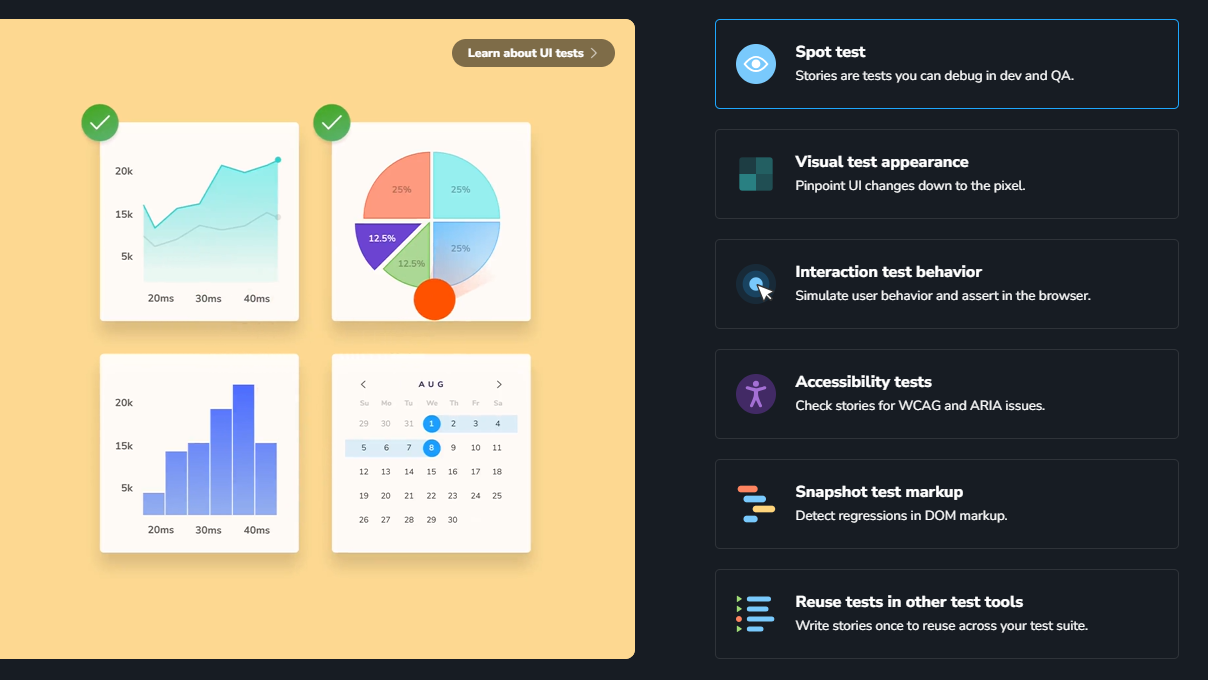 Storybook 是一個用於獨立建立 UI 元件和頁面的前端工作坊。它有助於 UI 開發、測試和文件編制。 他們在 GitHub 上有超過 57,000 次提交、81,000 多個 star 和 1300 多個版本。 這是您為專案建立簡單元件的方法。 ``` import type { Meta, StoryObj } from '@storybook/react'; import { YourComponent } from './YourComponent'; //👇 This default export determines where your story goes in the story list const meta: Meta<typeof YourComponent> = { component: YourComponent, }; export default meta; type Story = StoryObj<typeof YourComponent>; export const FirstStory: Story = { args: { //👇 The args you need here will depend on your component }, }; ``` 您可以閱讀[文件](https://storybook.js.org/docs/get-started/setup)。 如今,UI 除錯起來很痛苦,因為它們與業務邏輯、互動狀態和應用程式上下文糾纏在一起。 Storybook 提供了一個獨立的 iframe 來渲染元件,而不會受到應用程式業務邏輯和上下文的干擾。這可以幫助您將開發重點放在元件的每個變體上,甚至是難以觸及的邊緣情況。 https://github.com/storybookjs/storybook --- 3. [Appwrite](https://github.com/appwrite/appwrite) - 您的後端減少麻煩。 ---------------------------------------------------------------   Appwrite 的開源平台可讓您將身份驗證、資料庫、函數和儲存體新增至您的產品中,並建立任何規模的任何應用程式、擁有您的資料並使用您喜歡的編碼語言和工具。 他們有很好的貢獻指南,甚至不厭其煩地詳細解釋架構。 開始使用以下 npm 指令。 ``` npm install appwrite ``` 您可以像這樣建立一個登入元件。 ``` "use client"; import { useState } from "react"; import { account, ID } from "./appwrite"; const LoginPage = () => { const [loggedInUser, setLoggedInUser] = useState(null); const [email, setEmail] = useState(""); const [password, setPassword] = useState(""); const [name, setName] = useState(""); const login = async (email, password) => { const session = await account.createEmailSession(email, password); setLoggedInUser(await account.get()); }; const register = async () => { await account.create(ID.unique(), email, password, name); login(email, password); }; const logout = async () => { await account.deleteSession("current"); setLoggedInUser(null); }; if (loggedInUser) { return ( <div> <p>Logged in as {loggedInUser.name}</p> <button type="button" onClick={logout}> Logout </button> </div> ); } return ( <div> <p>Not logged in</p> <form> <input type="email" placeholder="Email" value={email} onChange={(e) => setEmail(e.target.value)} /> <input type="password" placeholder="Password" value={password} onChange={(e) => setPassword(e.target.value)} /> <input type="text" placeholder="Name" value={name} onChange={(e) => setName(e.target.value)} /> <button type="button" onClick={() => login(email, password)}> Login </button> <button type="button" onClick={register}> Register </button> </form> </div> ); }; export default LoginPage; ``` 您可以閱讀[文件](https://appwrite.io/docs)。 Appwrite 可以非常輕鬆地建立具有開箱即用的擴充功能的可擴展後端應用程式。 https://github.com/appwrite/appwrite --- 4. [Wasp](https://github.com/wasp-lang/wasp) - 用於 React、node.js 和 prisma 的類似 Rails 的框架。 --------------------------------------------------------------------------------------- 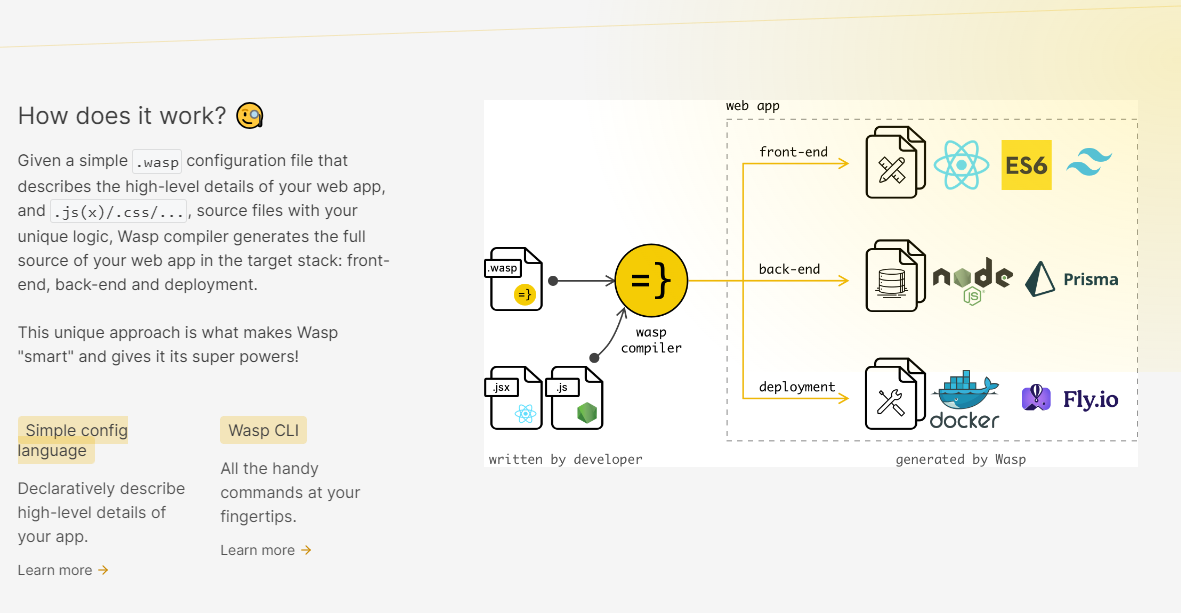 使用 React 和 Node.js 開發全端 Web 應用程式的最快方法。這不是一個想法,而是一種建立瘋狂快速全端應用程式的不同方法。 這是將其整合到元件中的方法。 ``` import getRecipes from "@wasp/queries/getRecipes"; import { useQuery } from "@wasp/queries"; import type { User } from "@wasp/entities"; export function HomePage({ user }: { user: User }) { // Due to full-stack type safety, `recipes` will be of type `Recipe[]` here. const { data: recipes, isLoading } = useQuery(getRecipes); // Calling our query here! if (isLoading) { return <div>Loading...</div>; } return ( <div> <h1>Recipes</h1> <ul> {recipes ? recipes.map((recipe) => ( <li key={recipe.id}> <div>{recipe.title}</div> <div>{recipe.description}</div> </li> )) : 'No recipes defined yet!'} </ul> </div> ); } ``` 您可以閱讀[文件](https://wasp-lang.dev/docs)。 https://github.com/wasp-lang/wasp --- 5. [Novu](https://github.com/novuhq/novu) - 將應用程式內通知新增至您的應用程式! -------------------------------------------------------------- 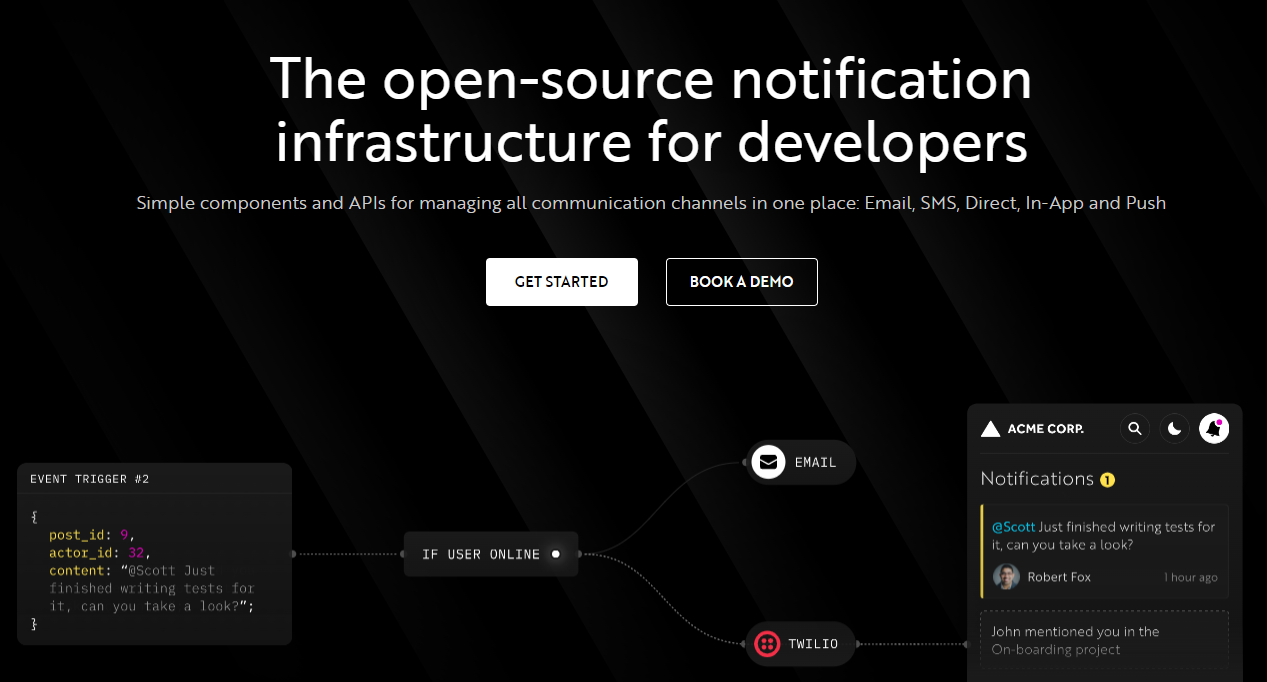 Novu 提供開源通知基礎架構和功能齊全的嵌入式通知中心。 這就是如何使用`React`建立 novu 元件以用於應用程式內通知。 ``` import { NovuProvider, PopoverNotificationCenter, NotificationBell, } from "@novu/notification-center"; function App() { return ( <> <NovuProvider subscriberId={process.env.REACT_APP_SUB_ID} applicationIdentifier={process.env.REACT_APP_APP_ID} > <PopoverNotificationCenter> {({ unseenCount }) => <NotificationBell unseenCount={unseenCount} />} </PopoverNotificationCenter> </NovuProvider> </> ); } export default App; ``` 您可以閱讀[文件](https://docs.novu.co/getting-started/introduction)。 https://github.com/novuhq/novu --- 6. [Remotion](https://github.com/remotion-dev/remotion) - 使用 React 以程式設計方式製作影片。 ------------------------------------------------------------------------------- 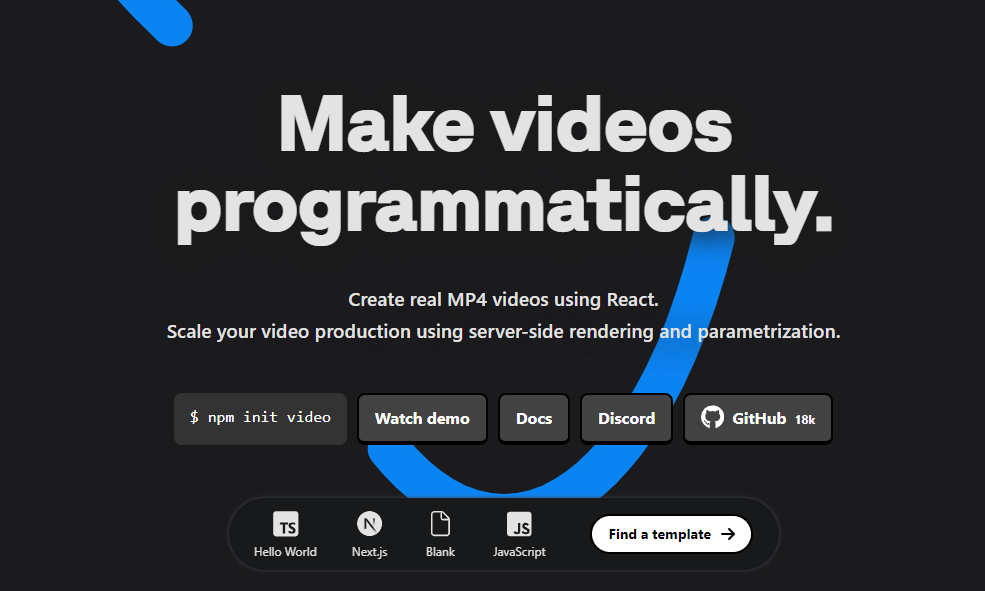 使用 React 建立真正的 MP4 影片,使用伺服器端渲染和參數化擴展影片製作。 開始使用以下 npm 指令。 ``` npm init video ``` 它為您提供了一個幀號和一個空白畫布,您可以在其中使用 React 渲染任何您想要的內容。 這是一個範例 React 元件,它將當前幀渲染為文字。 ``` import { AbsoluteFill, useCurrentFrame } from "remotion"; export const MyComposition = () => { const frame = useCurrentFrame(); return ( <AbsoluteFill style={{ justifyContent: "center", alignItems: "center", fontSize: 100, backgroundColor: "white", }} > The current frame is {frame}. </AbsoluteFill> ); }; ``` 您可以閱讀[文件](https://www.remotion.dev/docs/)。 過去兩年,remotion 團隊因製作 GitHub Wrapped 而聞名。 https://github.com/remotion-dev/remotion --- [7.NocoDB](https://github.com/nocodb/nocodb) - Airtable 的替代品。 ------------------------------------------------------------- 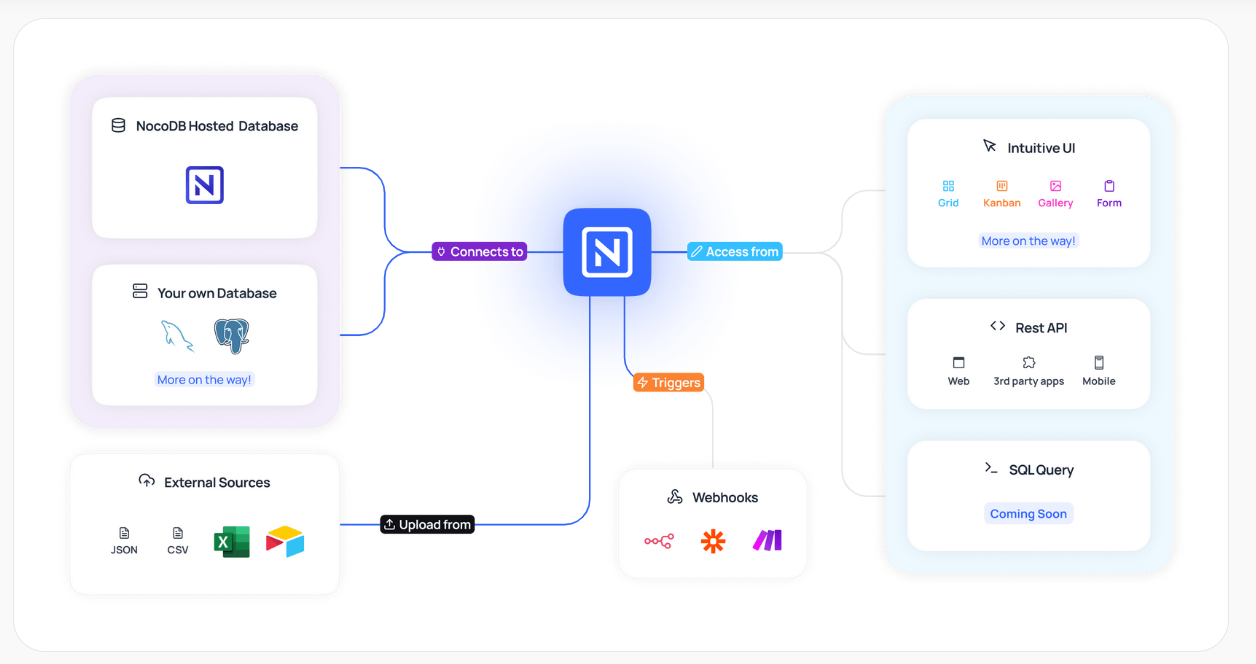 Airtable 的免費開源替代品是 NocoDB。它可以使用任何 MySQL、PostgreSQL、SQL Server、SQLite 或 MariaDB 資料庫製作智慧型電子表格。 其主要目標是讓強大的計算工具得到更廣泛的使用。 開始使用以下 npx 指令。 ``` npx create-nocodb-app ``` 您可以閱讀[文件](https://docs.nocodb.com/)。 NocoDB 的建立是為了為世界各地的數位企業提供強大的開源和無程式碼資料庫介面。 您可以非常快速地將airtable資料匯入NocoDB。 https://github.com/nocodb/nocodb --- 8.[新穎](https://github.com/steven-tey/novel)- 所見即所得編輯器,具有人工智慧自動完成功能。 ------------------------------------------------------------------- 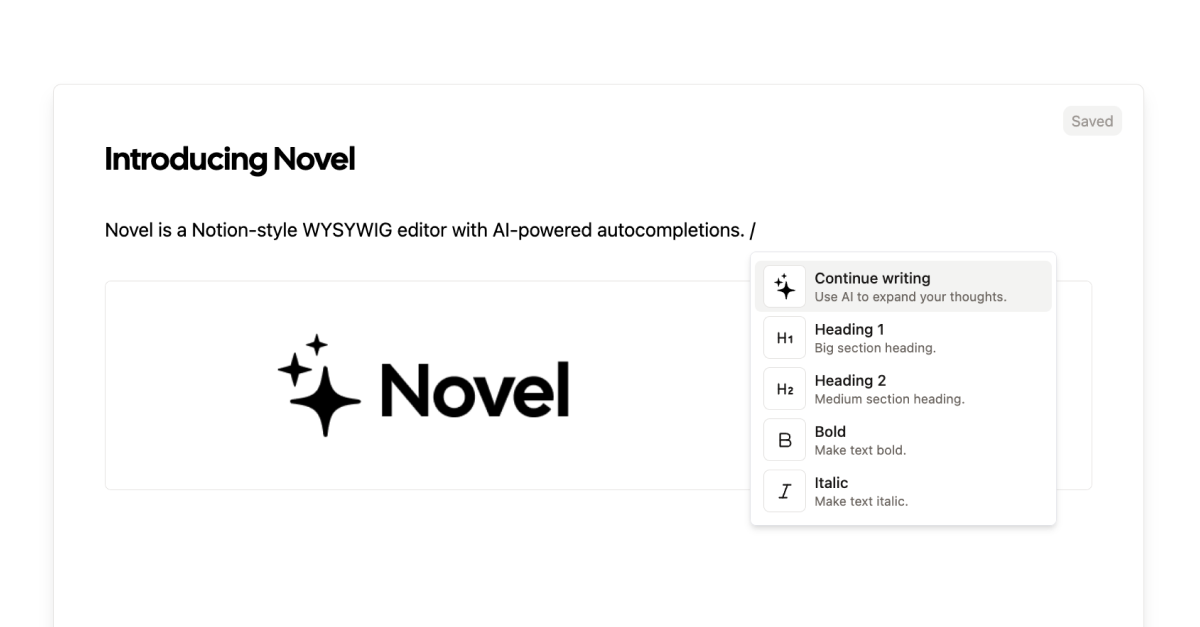 它使用`Next.js` 、 `Vercel AI SDK` 、 `Tiptap`作為文字編輯器。 開始使用以下 npm 指令。 ``` npm i novel ``` 您可以這樣使用它。有多種選項可用於改進您的應用程式。 ``` import { Editor } from "novel"; export default function App() { return <Editor />; } ``` https://github.com/steven-tey/novel --- 9. [Blitz](https://github.com/blitz-js/blitz) - 缺少 NextJS 的全端工具包。 ----------------------------------------------------------------- 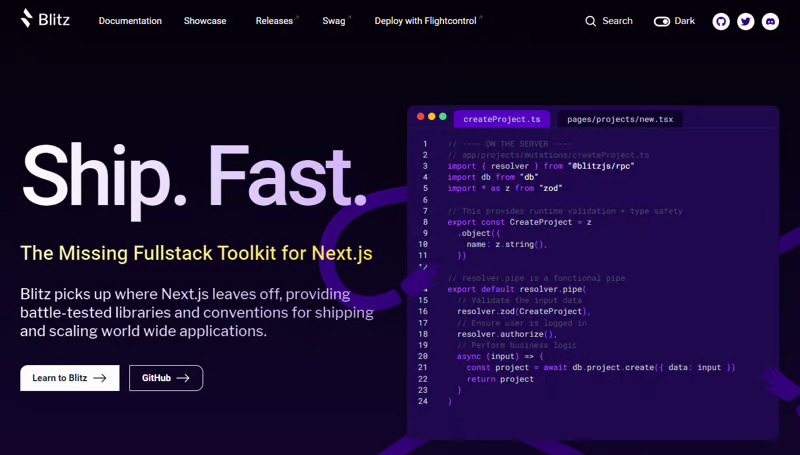 Blitz 繼承了 Next.js 的不足,為全球應用程式的交付和擴展提供了經過實戰考驗的函式庫和約定。 開始使用以下 npm 指令。 ``` npm install -g blitz ``` 這就是您如何使用 Blitz 建立新頁面。 ``` const NewProjectPage: BlitzPage = () => { const router = useRouter() const [createProjectMutation] = useMutation(createProject) return ( <div> <h1>Create New Project</h1> <ProjectForm submitText="Create Project" schema={CreateProject} onSubmit={async (values) => { // This is equivalent to calling the server function directly const project = await createProjectMutation(values) // Notice the 'Routes' object Blitz provides for routing router.push(Routes.ProjectsPage({ projectId: project.id })) }} /> </div> ); }; NewProjectPage.authenticate = true NewProjectPage.getLayout = (page) => <Layout>{page}</Layout> export default NewProjectPage ``` 您可以閱讀[文件](https://blitzjs.com/docs/get-started)。 它使建築物改善了數倍。  https://github.com/blitz-js/blitz --- 10. [Supabase](https://github.com/supabase/supabase) - 開源 Firebase 替代品。 -----------------------------------------------------------------------  我們大多數人都已經預料到 SUPABASE 會出現在這裡,因為它實在是太棒了。 開始使用以下 npm 指令 (Next.js)。 ``` npx create-next-app -e with-supabase ``` 這是使用 supabase 建立用戶的方法。 ``` import { createClient } from '@supabase/supabase-js' // Initialize const supabaseUrl = 'https://chat-room.supabase.co' const supabaseKey = 'public-anon-key' const supabase = createClient(supabaseUrl, supabaseKey) // Create a new user const { user, error } = await supabase.auth.signUp({ email: '[email protected]', password: 'example-password', }) ``` 您可以閱讀[文件](https://supabase.com/docs)。 您可以使用身份驗證、即時、邊緣功能、儲存等功能建立一個速度極快的應用程式。 Supabase 涵蓋了這一切! 他們還提供了一些入門套件,例如 AI 聊天機器人和 Stripe 訂閱。 https://github.com/supabase/supabase --- [11.Refine](https://github.com/refinedev/refine) - 企業開源重組工具。 ------------------------------------------------------------ 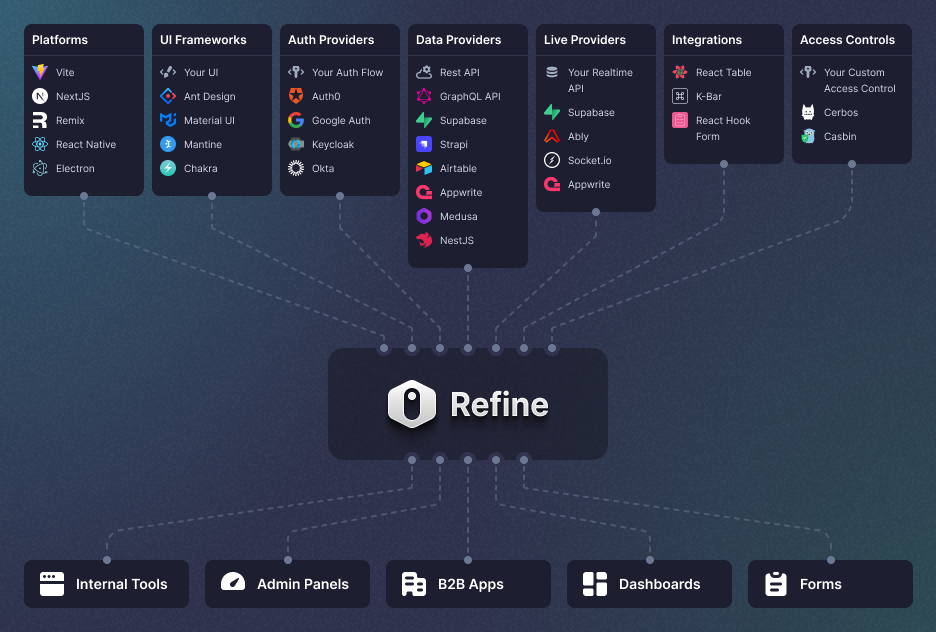 建立具有無與倫比的靈活性的管理面板、儀表板和 B2B 應用程式 您可以在一分鐘內使用單一 CLI 命令進行設定。 它具有適用於 15 多個後端服務的連接器,包括 Hasura、Appwrite 等。 開始使用以下 npm 指令。 ``` npm create refine-app@latest ``` 這就是使用 Refine 新增登入資訊的簡單方法。 ``` import { useLogin } from "@refinedev/core"; const { login } = useLogin(); ``` 您可以閱讀[文件](https://refine.dev/docs/)。 https://github.com/refinedev/refine --- 12. [Zenstack](https://github.com/zenstackhq/zenstack) - 資料庫到 API 和 UI 只需幾分鐘。 -----------------------------------------------------------------------------  TypeScript 工具包,透過強大的存取控制層增強 Prisma ORM,並釋放其全端開發的全部功能。 開始使用以下 npx 指令。 ``` npx zenstack@latest init ``` 這是透過伺服器適配器建立 RESTful API 的方法。 ``` // pages/api/model/[...path].ts import { requestHandler } from '@zenstackhq/next'; import { enhance } from '@zenstackhq/runtime'; import { getSessionUser } from '@lib/auth'; import { prisma } from '@lib/db'; // Mount Prisma-style APIs: "/api/model/post/findMany", "/api/model/post/create", etc. // Can be configured to provide standard RESTful APIs (using JSON:API) instead. export default requestHandler({ getPrisma: (req, res) => enhance(prisma, { user: getSessionUser(req, res) }), }); ``` 您可以閱讀[文件](https://zenstack.dev/docs/welcome)。 https://github.com/zenstackhq/zenstack --- 13. [Buildship](https://github.com/rowyio/buildship) - 低程式碼視覺化後端建構器。 --------------------------------------------------------------------  對於您正在使用無程式碼應用程式建構器(FlutterFlow、Webflow、Framer、Adalo、Bubble、BravoStudio...)或前端框架(Next.js、React、Vue...)建立的應用程式,您需要一個後端來支援可擴展的 API、安全工作流程、自動化等。BuildShip 為您提供了一種完全視覺化的方式,可以在易於使用的完全託管體驗中可擴展地建立這些後端任務。 這意味著您不需要在雲端平台上爭論或部署東西、執行 DevOps 等。只需立即建置和交付 🚀 https://github.com/rowyio/buildship --- 14. [Taipy](https://github.com/Avaiga/taipy) - 將資料和人工智慧演算法整合到生產就緒的 Web 應用程式中。 ----------------------------------------------------------------------------- 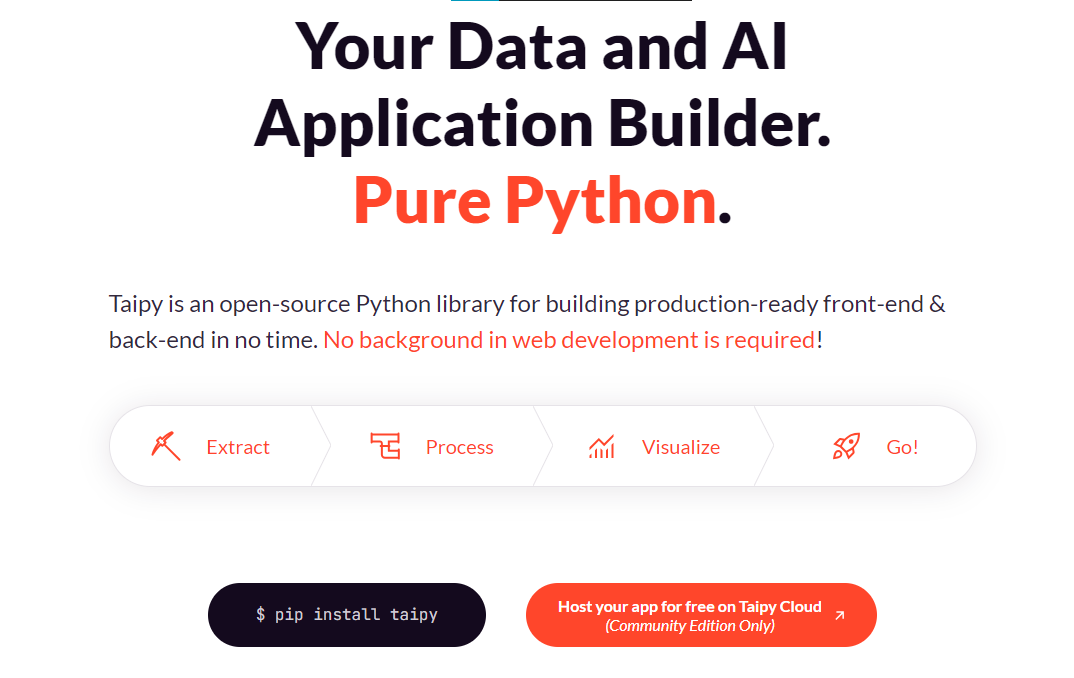 Taipy 是一個開源 Python 庫,用於輕鬆的端到端應用程式開發, 具有假設分析、智慧管道執行、內建調度和部署工具。 開始使用以下命令。 ``` pip install taipy ``` 這是一個典型的Python函數,也是過濾器場景中使用的唯一任務。 ``` def filter_genre(initial_dataset: pd.DataFrame, selected_genre): filtered_dataset = initial_dataset[initial_dataset['genres'].str.contains(selected_genre)] filtered_data = filtered_dataset.nlargest(7, 'Popularity %') return filtered_data ``` 您可以閱讀[文件](https://docs.taipy.io/en/latest/)。 他們還有很多可供您建立的[演示應用程式教學](https://docs.taipy.io/en/latest/knowledge_base/demos/)。 https://github.com/Avaiga/taipy --- 15. [LocalForage](https://github.com/localForage/localForage) - 改進了離線儲存。 ------------------------------------------------------------------------  LocalForage 是一個 JavaScript 函式庫,它透過使用非同步資料儲存和簡單的、類似 localStorage 的 API 來改善 Web 應用程式的離線體驗。它允許開發人員儲存多種類型的資料而不僅僅是字串。 開始使用以下 npm 指令。 ``` npm install localforage ``` 只需包含 JS 檔案並開始使用 localForage。 ``` <script src="localforage.js"></script> ``` 您可以閱讀[文件](https://localforage.github.io/localForage/#installation)。 https://github.com/localForage/localForage --- 16. [Zod](https://github.com/colinhacks/zod) - 使用靜態類型推斷的 TypeScript-first 模式驗證。 -------------------------------------------------------------------------------  Zod 的目標是透過最大限度地減少重複的類型聲明來對開發人員友好。使用 Zod,您聲明一次驗證器,Zod 將自動推斷靜態 TypeScript 類型。將更簡單的類型組合成複雜的資料結構很容易。 開始使用以下 npm 指令。 ``` npm install zod ``` 這是您在建立字串架構時自訂一些常見錯誤訊息的方法。 ``` const name = z.string({ required_error: "Name is required", invalid_type_error: "Name must be a string", }); ``` 您可以閱讀[文件](https://zod.dev/)。 它適用於 Node.js 和所有現代瀏覽器 https://github.com/colinhacks/zod --- 17.[多普勒](https://github.com/DopplerHQ)- 管理你的秘密。 -----------------------------------------------  您可以透過在具有開發、暫存和生產環境的專案中組織機密來消除機密蔓延。 開始使用以下指令 (MacOS)。 ``` $ brew install dopplerhq/cli/doppler $ doppler --version ``` 這是安裝 Doppler CLI[的 GitHub Actions 工作流程](https://github.com/DopplerHQ/cli-action)。 您可以閱讀[文件](https://docs.doppler.com/docs/start)。 ``` name: Example action on: [push] jobs: my-job: runs-on: ubuntu-latest steps: - name: Install CLI uses: dopplerhq/cli-action@v3 - name: Do something with the CLI run: doppler secrets --only-names env: DOPPLER_TOKEN: ${{ secrets.DOPPLER_TOKEN }} ``` https://github.com/DopplerHQ --- 18. [FastAPI](https://github.com/tiangolo/fastapi) - 高效能、易於學習、快速編碼、可用於生產。 -------------------------------------------------------------------------  FastAPI 是一個現代、快速(高效能)的 Web 框架,用於基於標準 Python 類型提示使用 Python 3.8+ 建立 API。 開始使用以下命令。 ``` $ pip install fastapi ``` 這是您開始使用 FastAPI 的方式。 ``` from typing import Union from fastapi import FastAPI app = FastAPI() @app.get("/") def read_root(): return {"Hello": "World"} @app.get("/items/{item_id}") def read_item(item_id: int, q: Union[str, None] = None): return {"item_id": item_id, "q": q} ``` 您的編輯器將自動完成屬性並了解它們的類型,這是使用 FastAPI 的最佳功能之一。 您可以閱讀[文件](https://fastapi.tiangolo.com/)。 https://github.com/tiangolo/fastapi --- 19. [Flowise](https://github.com/FlowiseAI/Flowise) - 拖放 UI 來建立您的客製化 LLM 流程。 ----------------------------------------------------------------------------  Flowise 是一款開源 UI 視覺化工具,用於建立客製化的 LLM 編排流程和 AI 代理程式。 開始使用以下 npm 指令。 ``` npm install -g flowise npx flowise start OR npx flowise start --FLOWISE_USERNAME=user --FLOWISE_PASSWORD=1234 ``` 這就是整合 API 的方式。 ``` import requests url = "/api/v1/prediction/:id" def query(payload): response = requests.post( url, json = payload ) return response.json() output = query({ question: "hello!" )} ``` 您可以閱讀[文件](https://docs.flowiseai.com/)。 https://github.com/FlowiseAI/Flowise --- 20. [Scrapy](https://github.com/scrapy/scrapy) - Python 的快速進階網頁爬行和抓取框架.. ------------------------------------------------------------------------  Scrapy 是一個快速的高級網路爬行和網頁抓取框架,用於爬行網站並從頁面中提取結構化資料。它可用於多種用途,從資料探勘到監控和自動化測試。 開始使用以下命令。 ``` pip install scrapy ``` 建造並執行您的網路蜘蛛。 ``` pip install scrapy cat > myspider.py <<EOF import scrapy class BlogSpider(scrapy.Spider): name = 'blogspider' start_urls = ['https://www.zyte.com/blog/'] def parse(self, response): for title in response.css('.oxy-post-title'): yield {'title': title.css('::text').get()} for next_page in response.css('a.next'): yield response.follow(next_page, self.parse) EOF scrapy runspider myspider.py ``` 您可以閱讀[文件](https://scrapy.org/doc/)。 它擁有大約 50k+ 的星星,因此對於網頁抓取來說具有巨大的可信度。 https://github.com/scrapy/scrapy --- 21. [Tone](https://github.com/Tonejs/Tone.js) - 在瀏覽器中製作互動式音樂。 -------------------------------------------------------------  開始使用以下 npm 指令。 ``` npm install tone ``` 這是您開始使用 Tone.js 的方法 ``` // To import Tone.js: import * as Tone from 'tone' //create a synth and connect it to the main output (your speakers) const synth = new Tone.Synth().toDestination(); //play a middle 'C' for the duration of an 8th note synth.triggerAttackRelease("C4", "8n"); ``` 您可以閱讀[文件](https://github.com/Tonejs/Tone.js?tab=readme-ov-file#installation)。 https://github.com/Tonejs/Tone.js --- 22. [Spacetime](https://github.com/spencermountain/spacetime) - 輕量級 javascript 時區庫。 -----------------------------------------------------------------------------------  您可以計算遠端時區的時間;支持夏令時、閏年和半球。按季度、季節、月份、週來定位時間.. 開始使用以下 npm 指令。 ``` npm install spacetime ``` 您可以這樣使用它。 ``` <script src="https://unpkg.com/spacetime"></script> <script> var d = spacetime('March 1 2012', 'America/New_York') //set the time d = d.time('4:20pm') d = d.goto('America/Los_Angeles') d.time() //'1:20pm' </script> ``` https://github.com/spencermountain/spacetime --- 23. [Mermaid](https://github.com/mermaid-js/mermaid) - 從類似 markdown 的文字產生圖表。 ----------------------------------------------------------------------------  您可以使用 Markdown with Mermaid 等文字產生流程圖或序列圖等圖表。 這就是建立圖表的方法。 ``` sequenceDiagram Alice->>John: Hello John, how are you? loop Healthcheck John->>John: Fight against hypochondria end Note right of John: Rational thoughts! John-->>Alice: Great! John->>Bob: How about you? Bob-->>John: Jolly good! ``` 它將做出如下圖。 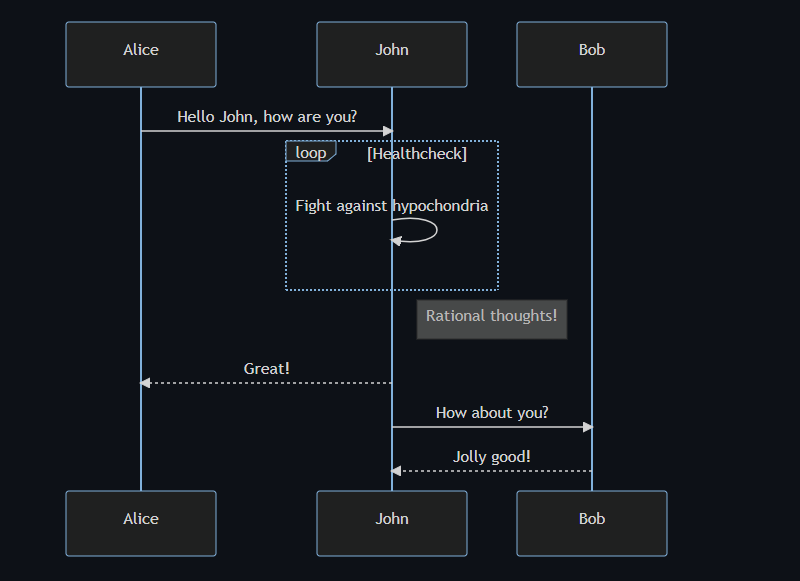 您可以閱讀[VS Code](https://docs.mermaidchart.com/plugins/visual-studio-code)的[文件](https://mermaid.js.org/intro/getting-started.html)和外掛程式。 請參閱[即時編輯器](https://mermaid.live/edit#pako:eNpVkE1PwzAMhv9KlvM-2AZj62EIxJd24ADXXLzEbaKlcUkdUDX1v5MONomcnNevXz32UWoyKAvZ4mfCoPHRQRWhVuHeO42T7XZHNhTiFb0nMdRjYelbQETRUbpTwRM1uQ2erbaoDyqI_AbnZfjZVZYFVOBCy8J2DWlLwUQHKmAwKrwRo4gnF5Xid-gd2FEAL9hSyp12pMIpNcee2ArxEhH4LG-3D7TPoAPcnhL_4WVxcgHZkfedqIjMSI5ljbEGZ_LyxwFaSbZYo5JFLg3Eg5Iq9NkHiemjC1oWHBOOZWoM8PlQ_8Un45iiLErwbRY9gcH8PUrumuHKlWs5J2oKpasGPUWfZcvctMVsNrSnlWOb9lNN9ax1xkJk-7VZzVaL1RoWS1zdLuFmuTR6P9-sy8X1vDS3V_MFyL7vfwD_bJ1W)中的範例。 https://github.com/mermaid-js/mermaid --- 24.[公共 API](https://github.com/public-apis/public-apis) - 20 多個類別的 1400 多個 API。 -------------------------------------------------------------------------------  我們主要使用外部 API 來建立應用程式,在這裡您可以找到所有 API 的清單。網站連結在最後。 它在 GitHub 上擁有大約 279k+ 顆星。  從儲存庫取得網站連結非常困難。所以,我把它貼在這裡。 網址 - [Collective-api.vercel.app/](https://collective-api.vercel.app/) https://github.com/public-apis/public-apis --- 25. [Framer Motion](https://github.com/framer/motion) - 像魔法一樣的動畫。 -----------------------------------------------------------------  可用的最強大的動畫庫之一。 Framer 使用簡單的聲明性語法意味著您編寫的程式碼更少。更少的程式碼意味著您的程式碼庫更易於閱讀和維護。 您可以建立事件和手勢,並且使用 Framer 的社區很大,這意味著良好的支援。 開始使用以下 npm 指令。 ``` npm install framer-motion ``` 您可以這樣使用它。 ``` import { motion } from "framer-motion" <motion.div whileHover={{ scale: 1.2 }} whileTap={{ scale: 1.1 }} drag="x" dragConstraints={{ left: -100, right: 100 }} /> ``` 您可以閱讀[文件](https://www.framer.com/motion/introduction/)。 https://github.com/framer/motion --- 26.[順便說一句](https://github.com/btw-so/btw)- 在幾分鐘內建立您的個人部落格。 ----------------------------------------------------------  順便說一句,您可以註冊並使用,而無需安裝任何東西。您也可以使用開源版本自行託管。 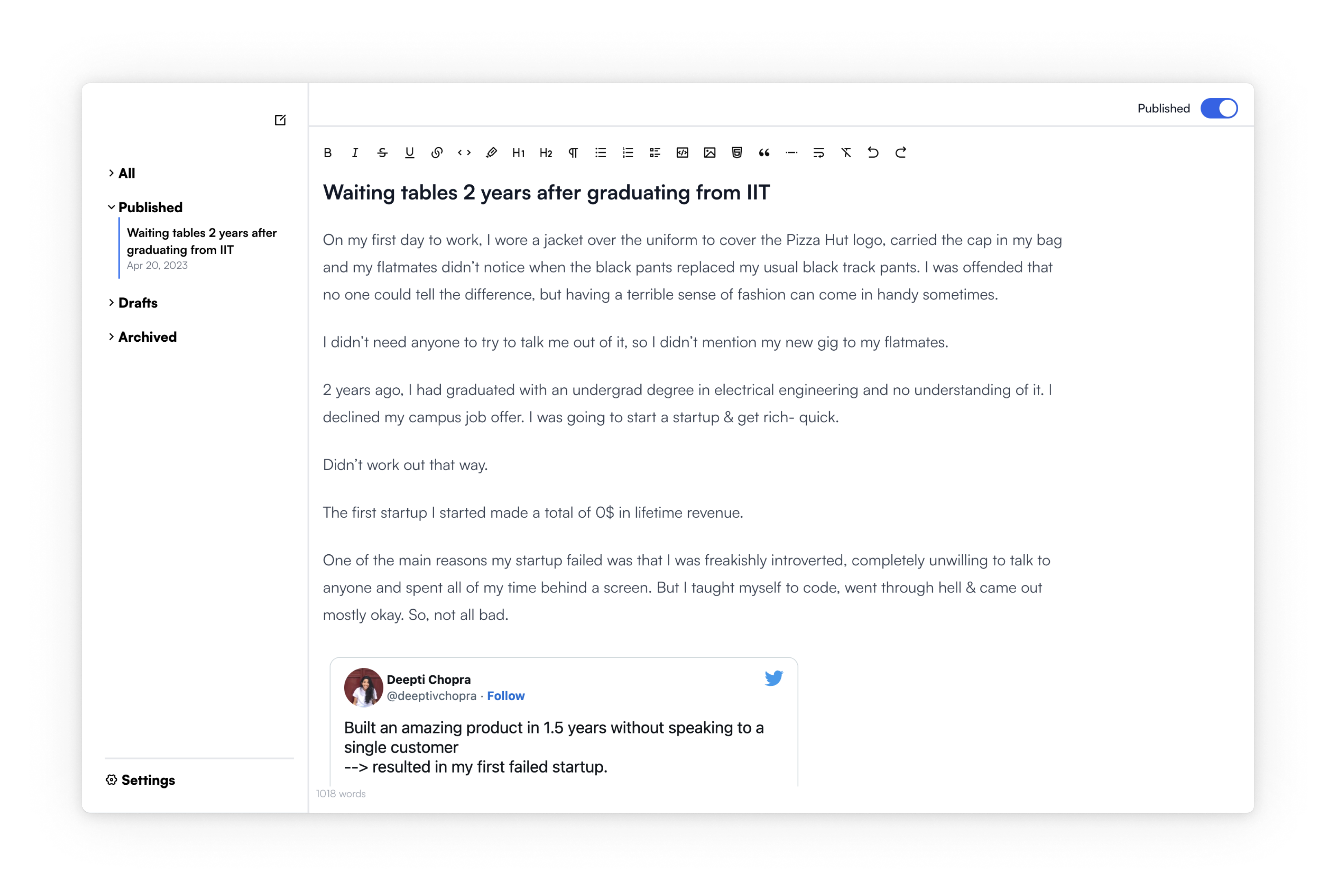 使用順便說一句建立的[範例部落格](https://www.siddg.com/about)。 https://github.com/btw-so/btw --- 27. [Formbricks](https://github.com/formbricks/formbricks) - 開源調查平台。 --------------------------------------------------------------------  Formbricks 提供免費、開源的測量平台。透過精美的應用程式內、網站、連結和電子郵件調查收集用戶旅程中每個點的回饋。在 Formbricks 之上建置或利用預先建置的資料分析功能。 開始使用以下 npm 指令。 ``` npm install @formbricks/js ``` 這就是您開始使用 formbricks 的方法。 ``` import formbricks from "@formbricks/js"; if (typeof window !== "undefined") { formbricks.init({ environmentId: "claV2as2kKAqF28fJ8", apiHost: "https://app.formbricks.com", }); } ``` 您可以閱讀[文件](https://formbricks.com/docs/getting-started/quickstart-in-app-survey)。 https://github.com/formbricks/formbricks --- 28. [Stripe](https://github.com/stripe) - 支付基礎設施。 -------------------------------------------------  數以百萬計的各種規模的公司在線上和親自使用 Stripe 來接受付款、發送付款、自動化財務流程並最終增加收入。 開始使用以下 npm 指令 (React.js)。 ``` npm install @stripe/react-stripe-js @stripe/stripe-js ``` 這就是使用鉤子的方法。 ``` import React, {useState} from 'react'; import ReactDOM from 'react-dom'; import {loadStripe} from '@stripe/stripe-js'; import { PaymentElement, Elements, useStripe, useElements, } from '@stripe/react-stripe-js'; const CheckoutForm = () => { const stripe = useStripe(); const elements = useElements(); const [errorMessage, setErrorMessage] = useState(null); const handleSubmit = async (event) => { event.preventDefault(); if (elements == null) { return; } // Trigger form validation and wallet collection const {error: submitError} = await elements.submit(); if (submitError) { // Show error to your customer setErrorMessage(submitError.message); return; } // Create the PaymentIntent and obtain clientSecret from your server endpoint const res = await fetch('/create-intent', { method: 'POST', }); const {client_secret: clientSecret} = await res.json(); const {error} = await stripe.confirmPayment({ //`Elements` instance that was used to create the Payment Element elements, clientSecret, confirmParams: { return_url: 'https://example.com/order/123/complete', }, }); if (error) { // This point will only be reached if there is an immediate error when // confirming the payment. Show error to your customer (for example, payment // details incomplete) setErrorMessage(error.message); } else { // Your customer will be redirected to your `return_url`. For some payment // methods like iDEAL, your customer will be redirected to an intermediate // site first to authorize the payment, then redirected to the `return_url`. } }; return ( <form onSubmit={handleSubmit}> <PaymentElement /> <button type="submit" disabled={!stripe || !elements}> Pay </button> {/* Show error message to your customers */} {errorMessage && <div>{errorMessage}</div>} </form> ); }; const stripePromise = loadStripe('pk_test_6pRNASCoBOKtIshFeQd4XMUh'); const options = { mode: 'payment', amount: 1099, currency: 'usd', // Fully customizable with appearance API. appearance: { /*...*/ }, }; const App = () => ( <Elements stripe={stripePromise} options={options}> <CheckoutForm /> </Elements> ); ReactDOM.render(<App />, document.body); ``` 您可以閱讀[文件](https://github.com/stripe/react-stripe-js?tab=readme-ov-file#minimal-example)。 您幾乎可以整合任何東西。它有一個巨大的選項清單。  https://github.com/stripe --- 29. [Upscayl](https://github.com/upscayl/upscayl) - 開源 AI 影像升級器。 ---------------------------------------------------------------- 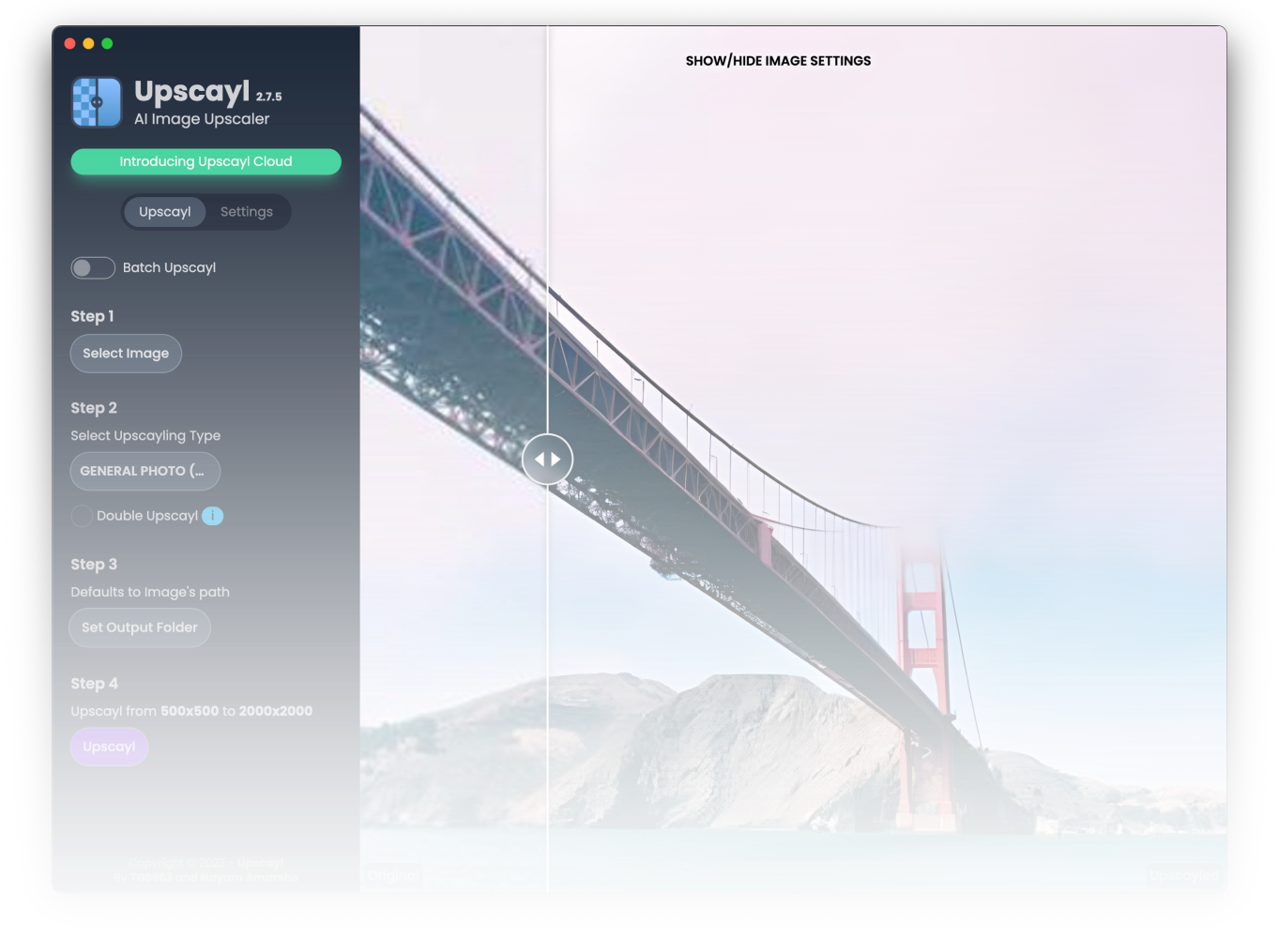 適用於 Linux、MacOS 和 Windows 的免費開源 AI Image Upscaler 採用 Linux 優先概念建構。 它可能與全端無關,但它對於升級圖像很有用。 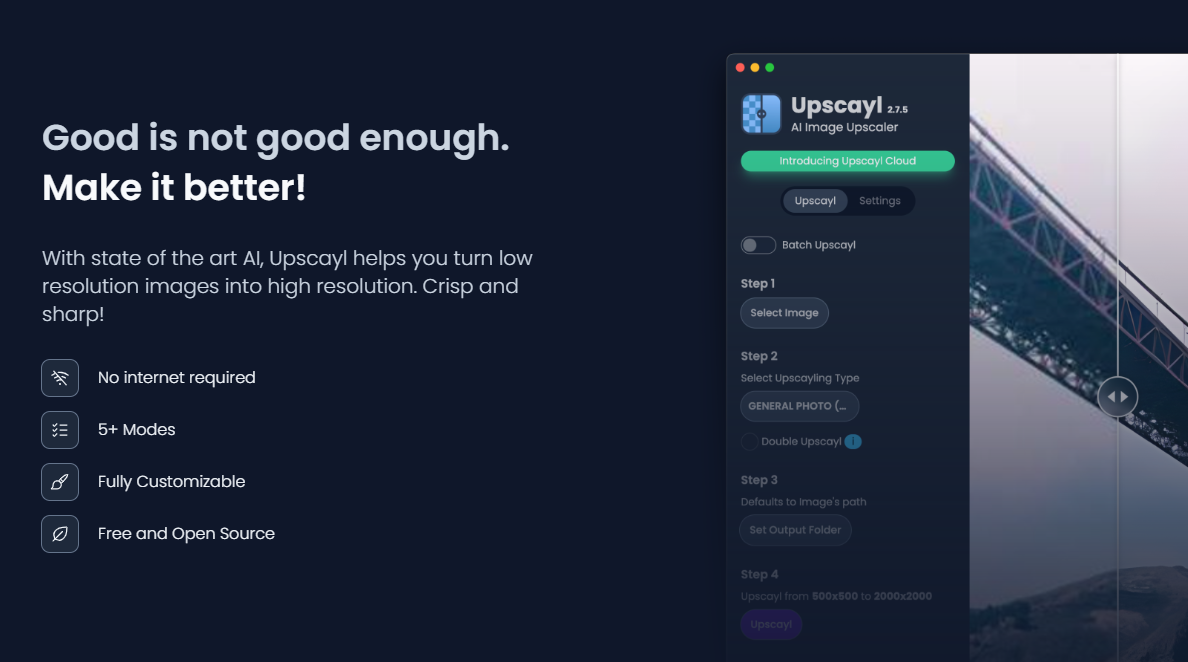 透過最先進的人工智慧,Upscayl 可以幫助您將低解析度影像變成高解析度。清脆又鋒利! https://github.com/upscayl/upscayl --- 30.[重新發送](https://github.com/resend)- 為開發人員提供的電子郵件 API。 ------------------------------------------------------- 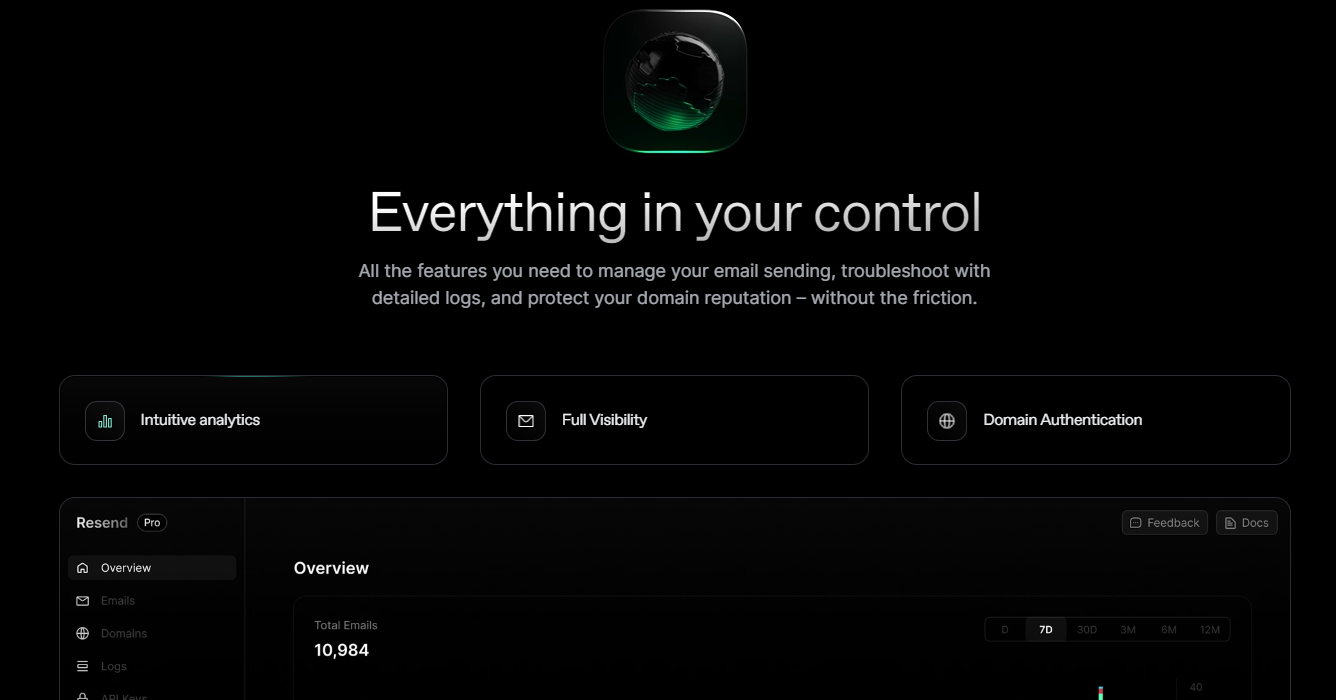 您可以使用 React 建立和傳送電子郵件。 2023 年最受炒作的產品之一。 開始使用以下 npm 指令。 ``` npm install @react-email/components -E ``` 這是將其與 next.js 專案整合的方法。 ``` import { EmailTemplate } from '@/components/email-template'; import { Resend } from 'resend'; const resend = new Resend(process.env.RESEND_API_KEY); export async function POST() { const { data, error } = await resend.emails.send({ from: '[email protected]', to: '[email protected]', subject: 'Hello world', react: EmailTemplate({ firstName: 'John' }), }); if (error) { return Response.json({ error }); } return Response.json(data); } ``` 您可以閱讀[文件](https://resend.com/docs/introduction)。 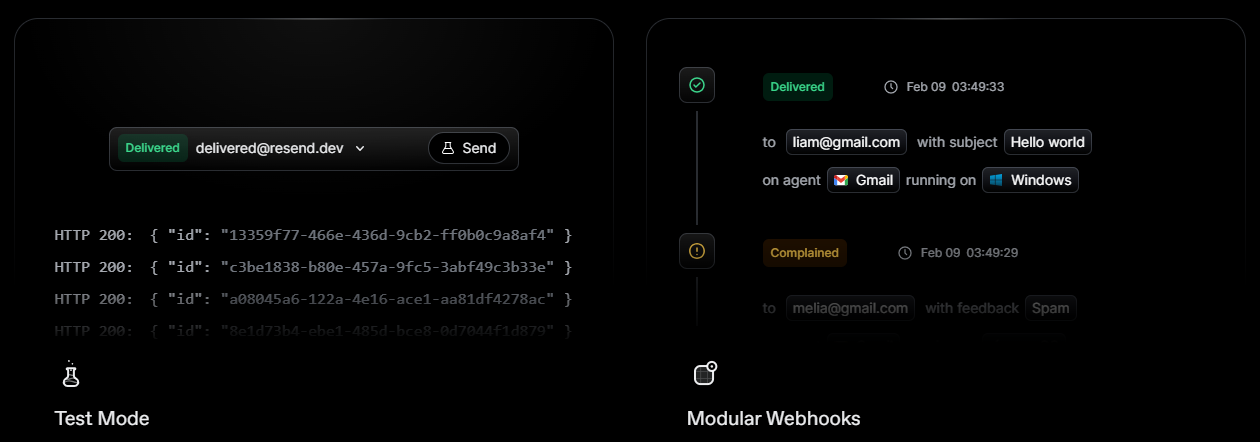 基本概念是一個簡單、優雅的介面,讓您可以在幾分鐘內開始發送電子郵件。它可以透過適用於您最喜歡的程式語言的 SDK 直接融入您的程式碼中。 https://github.com/resend --- 哇!如此長的專案清單。 我知道您有更多想法,分享它們,讓我們一起建造:D 如今建立全端應用程式並不難,但每個應用程式都可以透過有效地使用優秀的開源專案來解決任何問題來增加這一獨特因素。 例如,您可以建立一些提供通知或建立 UI 流來抓取資料的東西。 我希望其中一些內容對您的開發之旅有用。他們擁有一流的開發人員經驗;你可以依賴他們。 由於您將要建造東西,因此您可以在這裡找到一些[瘋狂的想法](https://github.com/florinpop17/app-ideas)。 祝你有美好的一天!直到下一次。 --- 原文出處:https://dev.to/copilotkit/im-building-a-full-stack-app-here-are-the-libraries-im-going-to-use-51nk
 在嘗試在個人react.js專案中實作Google地圖API時,我遇到了幾個非常複雜且令人困惑的範例。這是我如何在我的應用程式中使用 Google 地圖的簡短範例! 首先,事情第一! -------- 前往[Google 地圖 API](https://developers.google.com/maps/documentation/)頁面,註冊並取得令牌以供使用!您必須輸入信用卡號才能接收令牌。然而,谷歌聲稱,如果您不親自升級服務,他們不會向您的帳戶收取費用。**請自行決定是否繼續**。 獲得 API 金鑰後,您就可以開始建立您的應用程式了! ### 建立您的 react 應用程式 ``` npm init react-app my-app ``` ### 安裝依賴項 ``` npm install --save google-maps-react ``` 這就是我們如何將谷歌地圖作為一個元件來獲取! 檢查您的 package.json 檔案以確保它已安裝! 初始設定完成後,您就可以開始編碼了! 1.導入google-maps-react! ---------------------- ``` import { Map, GoogleApiWrapper } from 'google-maps-react'; ``` 2. 將地圖元件加入渲染函數中! ---------------- ``` render() { return ( <Map google={this.props.google} zoom={8} style={mapStyles} initialCenter={{ lat: 47.444, lng: -122.176}} /> ); } ``` 3. 編輯您的匯出預設語句 ------------- ``` export default GoogleApiWrapper({ apiKey: 'TOKEN HERE' })(MapContainer); ``` 請務必在此處插入您的 API 金鑰! 4.加入樣式 ------ 如果您願意,可以變更一些樣式屬性。我在課堂外將其作為常變數。 ``` const mapStyles = { width: '100%', height: '100%', }; ``` 5. 啟動你的伺服器! -----------  偉大的!你做到了!但說實話,沒有任何標記的地圖有什麼意義!那麼讓我們來加入一些吧! 6. 標記它! ------- ``` import { Map, GoogleApiWrapper, Marker } from 'google-maps-react'; ``` 更新您的地圖元件以包含標記元件! ``` render() { return ( <Map google={this.props.google} zoom={8} style={mapStyles} initialCenter={{ lat: 47.444, lng: -122.176}} > <Marker position={{ lat: 48.00, lng: -122.00}} /> </Map> ); } ``` 然後你就會擁有這個!  讓我們加入更多! -------- 您可以透過程式設計方式循環狀態來顯示地點,而不是新增一個標記。在我的範例中,我展示了該地區的一些舊貨店。您也可以為它們加入事件,例如 onClick! ``` export class MapContainer extends Component { constructor(props) { super(props); this.state = { stores: [{lat: 47.49855629475769, lng: -122.14184416996333}, {latitude: 47.359423, longitude: -122.021071}, {latitude: 47.2052192687988, longitude: -121.988426208496}, {latitude: 47.6307081, longitude: -122.1434325}, {latitude: 47.3084488, longitude: -122.2140121}, {latitude: 47.5524695, longitude: -122.0425407}] } } displayMarkers = () => { return this.state.stores.map((store, index) => { return <Marker key={index} id={index} position={{ lat: store.latitude, lng: store.longitude }} onClick={() => console.log("You clicked me!")} /> }) } render() { return ( <Map google={this.props.google} zoom={8} style={mapStyles} initialCenter={{ lat: 47.444, lng: -122.176}} > {this.displayMarkers()} </Map> ); } } ``` 這就是大家!  我希望本教程有助於建立您自己的應用程式! --- 原文出處:https://dev.to/jessicabetts/how-to-use-google-maps-api-and-react-js-26c2
我們都曾在某個時刻經歷過有關 git commit 訊息的混亂。  我也不例外。我的部落格的提交訊息如下所示: ``` fixxxx stuff post post post post posts mmm posts front maddy Add chris oliver add syntax article add git patch article fix video video arty art art Fix links oops ``` 因為我部落格的 git 歷史記錄只有我自己看過,所以沒關係。我已經接受了我永遠無法在我的部落格中充分利用 git 的事實,而且我完全同意這一點。 不幸的是,有些人對待有多個貢獻者的真實專案就像我對待我的部落格一樣。我發現這種做法是無知而不是懶惰的結果。因此,我將分享一些關於如何在實際專案中使用提交訊息的技巧。 ### 為什麼要關心? 😤[我不在乎,跳到模板!](#the-final-template) 🚀 Git 是一個強大的工具,即使您只使用它來保存程式碼更改歷史記錄並且不利用其最強大的功能。 然而,你會發現你挖掘得越深,git 就會變得越強大。您還會發現 git 的許多最有用的功能都是在提交訊息有用的假設下運作的。 想想你上次使用`git blame`是什麼時候。如果您發現一條提交訊息,上面`fixed a bad bug` ,這會有幫助嗎?可能不是,您可能試圖找到有關您正在處理的程式碼的更多上下文;你需要解釋什麼以及為什麼。 Git 提交訊息必須包含每次更改背後的內容和原因,以便明天勇敢的 git 探索者能夠進入提交作者的頭腦。如果提交訊息不包含該訊息,為什麼還要寫一個?提交訊息只有在對將來某個時候試圖理解更改的人有用時才有用。 為了建立一個良好的提交訊息的模板,我將把提交訊息分成幾個部分。 ### 首先,主題行 在提交訊息中,第一行(有時稱為主題行)應與正文隔離。理想情況下,這一行總結了提交中所做的更改。 當我寫主題行時,我嘗試完成這句話,“這次提交將......” 例如,我可能會編寫一個主題行,內容類似於`Remove unused, commented code` 。這可以很好地結束我的句子:“此提交將刪除未使用的帶註釋的程式碼。” 在設定主題行格式時,需要記住一兩個規則。 首先,主題行中的第一個字元應大寫;這只是一個常見的約定。根據我的經驗,它還使閱讀一長串的單行提交清單變得更加容易。 其次,您的提交訊息不應超過五十個字元。這是因為 GitHub 等工具會將該行截斷為 50 個字元。因此,為了讓其他人能夠有效地瀏覽和理解你的主題行,你應該嘗試用五十個字符來總結整個變化。 我的提交訊息範本的第一行如下所示: `Summarize the change in less than 50 characters` ### 接下來,第一個正文“段落” 在某些提交中,主題行足以傳達整個想法。例如,如果您的提交將`Add a comma to the README` ,您可能不需要自己解釋。 然而,在大多數提交中,您的更改可能會受益於一些額外的上下文。我們不希望未來的開發人員在嘗試理解更改背後的原因時錯過上下文。 這就是訊息正文發揮作用的地方。我將正文分為“段落”,這些“段落”只是鬆散定義的由空格分隔的文字字串。它們可以是要點、句子或其他東西;重要的是它們從冷開始就易於閱讀和理解。 過去,我通常使用提交訊息正文的第一段來解釋我所做的事情。這些天,我已經不再關注*「什麼」* ,而是開始記錄*「為什麼」* 。 [Ben Orenstein 最近改變了我對提交訊息格式的看法](https://twitter.com/r00k/status/1175100703829909505?s=20): {% 推特 1175100703829909505 %} 因此,在這種情況下,我們想要引導我們做出改變*的原因*。 這是一個例子: ``` Refactor the coupon UI Because: - The old UI code is fairly slow - There were a few unused dependencies - The old UI has aged poorly ``` 這些「段落」的偉大之處在於只有一個格式規則:72 個字元換行。這更多的是一種遺留傳統,而不是任何實質的東西。然而,主要原因是這允許 git 縮進一些空間(假設最大字元限制為 80)。我建議遵循這條規則,儘管它並不總是嚴格必要的。 這是到目前為止的提交訊息範本: ``` Summarize the change in less than 50 characters Because: - Explain the reasons you made this change - Make a new bullet for each reason - Each line should be under 72 characters ``` ### 現在是第二正文“段落” 既然我們已經總結了更改並分享了進行更改的原因,那麼以較長的形式準確地解釋我們所做的事情可能是謹慎的做法。 我用第二個「段落」來更詳細地解釋我在更改中所做的事情,例如: ``` Refactor the coupon UI Because: - The old UI code is fairly slow - There were a few unused dependencies - The old UI has aged poorly I thought it was necessary to remove some of the old coupon UI code. Unfortunately, it has aged pretty poorly, and I think this refactor makes the code much easier to support in the long-run. Primarily, this commit improves the performance of the coupon component. It also removes some unused dependencies. ``` 提交正文的這一部分應該比 50 個字元的摘要更深入地解釋所做的事情。格式由您決定(只要您以 72 個字元換行即可)。 這是更新後的模板: ``` Summarize the change in less than 50 characters Because: - Explain the reasons you made this change - Make a new bullet for each reason - Each line should be under 72 characters Explain exactly what was done in this commit with more depth than the 50 character subject line. Remember to wrap at 72 characters! ``` ### 其他部分:附加註釋和合著者 此時,我們正在編寫有效且連貫的提交訊息。然而,有時提交訊息需要一些額外的註釋。這可以在最後一節中完成。 例如: ``` Refactor the coupon UI Because: - The old UI code is fairly slow - There were a few unused dependencies - The old UI has aged poorly I thought it was necessary to remove some of the old coupon UI code. Unfortunately, it has aged pretty poorly, and I think this refactor makes the code much easier to support in the long-run. Primarily, this commit improves the performance of the coupon component. It also removes some unused dependencies. These changes should resolve issue #1337. This commit removed the left-pad dependency, so please stop using it! Co-authored-by: nspinazz89 <[email protected]> ``` 在這個例子中我能夠: - 參考相關問題 - 加入一行以警告我刪除了依賴項 - 包含與我一起參與該提交的人員的引用 此時,任何查看此提交訊息的人都會知道: 1. 做了什麼一目了然 2. 為什麼需要改變 3. 有關已完成操作的詳細訊息 4. 有關變更的任何有用的詳細訊息 這使得我們的提交訊息對我們未來的自己和任何其他需要理解我們程式碼的開發人員來說更加有用。 即使您不同意我編寫提交訊息的方法,也很難否認我們必須編寫提交訊息,以便其他開發人員在閱讀我們的程式碼時能夠進入我們的視野。 我認為大多數人都同意“好”程式碼的標誌是可維護性,您可以透過編寫有助於其他人理解甚至將來更改您的程式碼的提交訊息來增強程式碼的可維護性。 ### 最終模板 ``` Summarize the change in less than 50 characters Because: - Explain the reasons you made this change - Make a new bullet for each reason - Each line should be under 72 characters Explain exactly what was done in this commit with more depth than the 50 character subject line. Remember to wrap at 72 characters! Include any additional notes, relevant links, or co-authors. ``` ### 還有更多... 這些天我寫了[很多文章](https://jh.codes),我經營一個[播客](https://www.devpath.fm),並且我已經開始發送一份關於我聽到的所有精彩故事的[時事通訊摘要](https://pages.convertkit.com/674caf55d4/f30f7753a7)。 您還可以在[Twitter](https://twitter.com/jakeherrington)上關注我,我在那裡製作一些愚蠢的表情包並談論如何成為開發人員。 --- 原文出處:https://dev.to/jacobherrington/how-to-write-useful-commit-messages-my-commit-message-template-20n9
嗨大家好,新年快樂:煙火::煙火::煙火:! ---------------------- 這是一篇很長的文章,所以請耐心聽我一秒鐘或一個小時。每個問題的每個答案都有一個向上箭頭**↑**連結,可讓您返回到問題列表,這樣您就不會浪費時間上下滾動。 ### 問題 - [1. `undefined`和`null`有什麼差別?](#1-whats-the-difference-between-undefined-and-null) - [2. && 運算子的作用是什麼?](#2-what-does-the-ampamp-operator-do) - [3. || 是什麼意思?運營商做什麼?](#3-what-does-the-operator-do) - [4. 使用 + 或一元加運算子是將字串轉換為數字的最快方法嗎?](#4-is-using-the-or-unary-plus-operator-the-fastest-way-in-converting-a-string-to-a-number) - [5.什麼是DOM?](#5-what-is-the-dom) - [6.什麼是事件傳播?](#6-what-is-event-propagation) - [7.什麼是事件冒泡?](#7-whats-event-bubbling) - [8. 什麼是事件擷取?](#8-whats-event-capturing) - [9. `event.preventDefault()`和`event.stopPropagation()`方法有什麼差別?](#9-whats-the-difference-between-eventpreventdefault-and-eventstoppropagation-methods) - [10. 如何知道元素中是否使用了`event.preventDefault()`方法?](#10-how-to-know-if-the-eventpreventdefault-method-was-used-in-an-element) - [11. 為什麼這段程式碼 obj.someprop.x 會拋出錯誤?](#11-why-does-this-code-objsomepropx-throw-an-error) - \[12.什麼是`event.target` ?\](#12-什麼是 eventtarget- ) - [13.什麼是`event.currentTarget` ?](#13-what-is-eventcurrenttarget) - [14. `==`和`===`有什麼差別?](#14-whats-the-difference-between-and-) - [15. 為什麼在 JavaScript 中比較兩個相似的物件時回傳 false?](#15-why-does-it-return-false-when-comparing-two-similar-objects-in-javascript) - [16. `!!`是什麼意思?運營商做什麼?](#16-what-does-the-operator-do) - [17. 如何計算一行中的多個表達式?](#17-how-to-evaluate-multiple-expressions-in-one-line) - [18.什麼是吊裝?](#18-what-is-hoisting) - [19.什麼是範圍?](#19-what-is-scope) - [20.什麼是閉包?](#20-what-are-closures) - [21. JavaScript 中的假值是什麼?](#21-what-are-the-falsy-values-in-javascript) - [22. 如何檢查一個值是否為假值?](#22-how-to-check-if-a-value-is-falsy) - [23. `"use strict"`有什麼作用?](#23-what-does-use-strict-do) - [24. JavaScript 中`this`的值是什麼?](#24-whats-the-value-of-this-in-javascript) - [25. 物件的`prototype`是什麼?](#25-what-is-the-prototype-of-an-object) - \[26.什麼是 IIFE,它有什麼用?\](#26-what-is-an-iife-what-is-the-use-of-it ) - [27. `Function.prototype.apply`方法有什麼用?](#27-what-is-the-use-functionprototypeapply-method) - [28. `Function.prototype.call`方法有什麼用?](#28-what-is-the-use-functionprototypecall-method) - [29. `Function.prototype.apply`和`Function.prototype.call`有什麼差別?](#29-whats-the-difference-between-functionprototypeapply-and-functionprototypecall) - [30. `Function.prototype.bind`的用法是什麼?](#30-what-is-the-usage-of-functionprototypebind) - \[31.什麼是函數式程式設計以及 JavaScript 的哪些特性使其成為函數式語言的候選者?\](#31-什麼是函數式程式設計和 javascript 的特性是什麼-使其成為函數式語言的候選者 ) - [32.什麼是高階函數?](#32-what-are-higher-order-functions) - [33.為什麼函數被稱為First-class Objects?](#33-why-are-functions-called-firstclass-objects) - \[34.手動實作`Array.prototype.map`方法。\](#34-手動實作 arrayprototypemap-method ) - [35. 手動實作`Array.prototype.filter`方法。](#35-implement-the-arrayprototypefilter-method-by-hand) - [36. 手動實作`Array.prototype.reduce`方法。](#36-implement-the-arrayprototypereduce-method-by-hand) - [37.什麼是`arguments`物件?](#37-what-is-the-arguments-object) - [38. 如何創造沒有**原型的**物件?](#38-how-to-create-an-object-without-a-prototype) - [39. 為什麼當你呼叫這個函數時,這段程式碼中的`b`會變成全域變數?](#39-why-does-b-in-this-code-become-a-global-variable-when-you-call-this-function) - [40.什麼是**ECMAScript** ?](#40-what-is-ecmascript) - [41. **ES6**或**ECMAScript 2015**有哪些新功能?](#41-what-are-the-new-features-in-es6-or-ecmascript-2015) - [42. `var` 、 `let`和`const`關鍵字有什麼差別?](#42-whats-the-difference-between-var-let-and-const-keywords) - [43. 什麼是**箭頭函數**?](#43-what-are-arrow-functions) - [44.什麼是**類別**?](#44-what-are-classes) - [45.什麼是**模板文字**?](#45-what-are-template-literals) - [46.什麼是**物件解構**?](#46-what-is-object-destructuring) - [47.什麼是`ES6 Modules` ?](#47-what-are-es6-modules) - [48.什麼是`Set`物件以及它如何運作?](#48-what-is-the-set-object-and-how-does-it-work) - [49. 什麼是回呼函數?](#49-what-is-a-callback-function) - [50. 什麼是**Promise** ?](#50-what-are-promises) - [51. 什麼是*async/await*以及它是如何運作的?](#51-what-is-asyncawait-and-how-does-it-work) - [52. **Spread 運算子**和**Rest 運算**子有什麼差別?](#52-whats-the-difference-between-spread-operator-and-rest-operator) - [53. 什麼是**預設參數**?](#53-what-are-default-parameters) - [54.什麼是**包裝物件**?](#54-what-are-wrapper-objects) - [55.**隱性強制**和**顯性**強制有什麼差別?](#55-what-is-the-difference-between-implicit-and-explicit-coercion) - [56. 什麼是`NaN` ?以及如何檢查值是否為`NaN` ?](#56-what-is-nan-and-how-to-check-if-a-value-is-nan) - [57. 如何檢查一個值是否為一個**陣列**?](#57-how-to-check-if-a-value-is-an-array) - [58. 如何在不使用`%`或模運算子的情況下檢查數字是否為偶數?](#58-how-to-check-if-a-number-is-even-without-using-the-or-modulo-operator) - [59. 如何檢查物件中是否存在某個屬性?](#59-how-to-check-if-a-certain-property-exists-in-an-object) - [60.什麼是**AJAX** ?](#60-what-is-ajax) - [61. JavaScript 中建立物件的方式有哪些?](#61-what-are-the-ways-of-making-objects-in-javascript) - [62. `Object.seal`和`Object.freeze`方法有什麼不同?](#62-whats-the-difference-between-objectseal-and-objectfreeze-methods) - [63. `in`運算子和物件中的`hasOwnProperty`方法有什麼差別?](#63-whats-the-difference-between-the-in-operator-and-the-hasownproperty-method-in-objects) - [64. JavaScript中處理**非同步程式碼的**方法有哪些?](#64-what-are-the-ways-to-deal-with-asynchronous-code-in-javasscript) - [65.**函數表達式**和**函數宣告**有什麼不同?](#65-whats-the-difference-between-a-function-expression-and-function-declaration) - \[66.一個函數有多少種*呼叫*方式?\]( 66-函數可以有多少種方式被呼叫) ================= - [67. 什麼是*記憶*,它有什麼用?](#67-what-is-memoization-and-whats-the-use-it) - [68. 實現記憶輔助功能。](#68-implement-a-memoization-helper-function) - [69. 為什麼`typeof null`回傳`object` ?如何檢查一個值是否為`null` ?](#69-why-does-typeof-null-return-object-how-to-check-if-a-value-is-null) - [`new`關鍵字有什麼作用?](#70-what-does-the-new-keyword-do) ### 1. `undefined`和`null`有什麼差別? [^](#the-questions "返回問題")在了解`undefined`和`null`之間的差異之前,我們必須先了解它們之間的相似之處。 - 它們屬於**JavaScript 的**7 種基本型別。 ``` let primitiveTypes = ['string','number','null','undefined','boolean','symbol', 'bigint']; ``` - 它們是**虛假的**價值觀。使用`Boolean(value)`或`!!value`將其轉換為布林值時計算結果為 false 的值。 ``` console.log(!!null); //logs false console.log(!!undefined); //logs false console.log(Boolean(null)); //logs false console.log(Boolean(undefined)); //logs false ``` 好吧,我們來談談差異。 - `undefined`是尚未指派特定值的變數的預設值。或一個沒有**明確**回傳值的函數。 `console.log(1)` 。或物件中不存在的屬性。 JavaScript 引擎為我們完成了**指派**`undefined`值的任務。 ``` let _thisIsUndefined; const doNothing = () => {}; const someObj = { a : "ay", b : "bee", c : "si" }; console.log(_thisIsUndefined); //logs undefined console.log(doNothing()); //logs undefined console.log(someObj["d"]); //logs undefined ``` - `null`是**「代表無值的值」** 。 `null`是已**明確**定義給變數的值。在此範例中,當`fs.readFile`方法未引發錯誤時,我們得到`null`值。 ``` fs.readFile('path/to/file', (e,data) => { console.log(e); //it logs null when no error occurred if(e){ console.log(e); } console.log(data); }); ``` 當比較`null`和`undefined`時,使用`==`時我們得到`true` ,使用`===`時得到`false` 。您可以[在此處](#14-whats-the-difference-between-and-)閱讀原因。 ``` console.log(null == undefined); // logs true console.log(null === undefined); // logs false ``` ### 2. `&&`運算子的作用是什麼? [^](#the-questions "返回問題") `&&`或**邏輯 AND**運算子在其運算元中尋找第一個*假*表達式並傳回它,如果沒有找到任何*假*表達式,則傳回最後一個表達式。它採用短路來防止不必要的工作。在我的一個專案中關閉資料庫連線時,我在`catch`區塊中使用了它。 ``` console.log(false && 1 && []); //logs false console.log(" " && true && 5); //logs 5 ``` 使用**if**語句。 ``` const router: Router = Router(); router.get('/endpoint', (req: Request, res: Response) => { let conMobile: PoolConnection; try { //do some db operations } catch (e) { if (conMobile) { conMobile.release(); } } }); ``` 使用**&&**運算子。 ``` const router: Router = Router(); router.get('/endpoint', (req: Request, res: Response) => { let conMobile: PoolConnection; try { //do some db operations } catch (e) { conMobile && conMobile.release() } }); ``` ### 3. `||`是什麼意思?運營商做什麼? [↑](#the-questions "返回問題") `||` or**邏輯 OR**運算子尋找其運算元中的第一個*真值*表達式並傳回它。這也採用短路來防止不必要的工作。在**ES6預設函數參數**被支援之前,它被用來初始化函數中的預設參數值。 ``` console.log(null || 1 || undefined); //logs 1 function logName(name) { var n = name || "Mark"; console.log(n); } logName(); //logs "Mark" ``` ### 4. 使用**+**或一元加運算子是將字串轉換為數字的最快方法嗎? [^](#the-questions "返回問題")根據[MDN 文件,](https://developer.mozilla.org/en-US/docs/Web/JavaScript/Reference/Operators/Arithmetic_Operators#Unary_plus) `+`是將字串轉換為數字的最快方法,因為如果該值已經是數字,它不會對該值執行任何操作。 ### 5.什麼是**DOM** ? [^](#the-questions "返回問題") **DOM**代表**文件物件模型,**是 HTML 和 XML 文件的介面 ( **API** )。當瀏覽器第一次讀取(*解析*)我們的 HTML 文件時,它會建立一個大物件,一個基於 HTML 文件的非常大的物件,這就是**DOM** 。它是根據 HTML 文件建模的樹狀結構。 **DOM**用於互動和修改**DOM 結構**或特定元素或節點。 想像一下,如果我們有這樣的 HTML 結構。 ``` <!DOCTYPE html> <html lang="en"> <head> <meta charset="UTF-8"> <meta name="viewport" content="width=device-width, initial-scale=1.0"> <meta http-equiv="X-UA-Compatible" content="ie=edge"> <title>Document Object Model</title> </head> <body> <div> <p> <span></span> </p> <label></label> <input> </div> </body> </html> ``` 等效的**DOM**應該是這樣的。 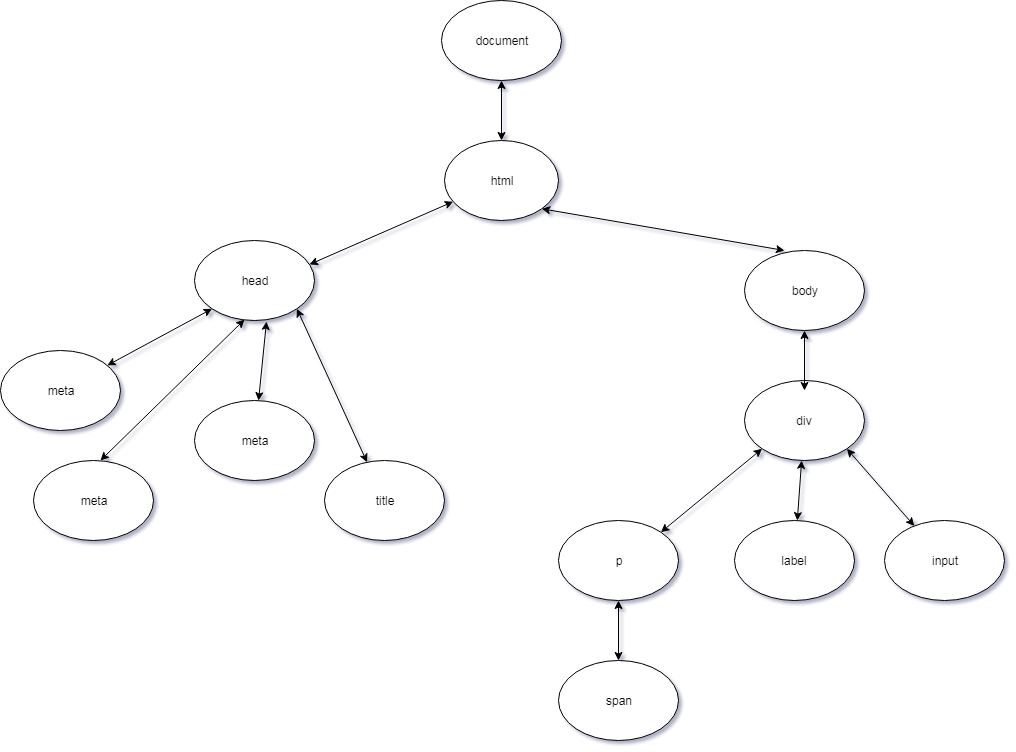 **JavaScript**中的`document`物件代表**DOM** 。它為我們提供了許多方法,我們可以用來選擇元素來更新元素內容等等。 ### 6.什麼是**事件傳播**? [↑](#the-questions "返回問題")當某個**事件**發生在**DOM**元素上時,該**事件**並非完全發生在該元素上。在**冒泡階段**,**事件**向上冒泡,或到達其父級、祖父母、祖父母的父級,直到一直到達`window` ,而在**捕獲階段**,事件從`window`開始向下到達觸發的元素事件或`<a href="#12-what-is-eventtarget-">event.target</a>` 。 **事件傳播**分為**三個**階段。 1. [捕獲階段](#8-whats-event-capturing)-事件從`window`開始,然後向下到達每個元素,直到到達目標元素。 2. [目標階段](#12-what-is-eventtarget-)– 事件已到達目標元素。 3. [冒泡階段](#7-whats-event-bubbling)-事件從目標元素冒起,然後向上移動到每個元素,直到到達`window` 。 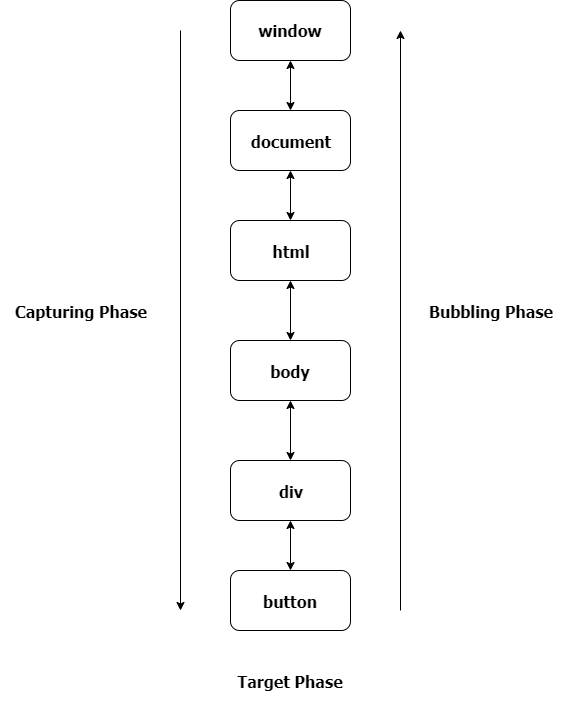 ### 7.什麼是**事件冒泡**? [↑](#the-questions "返回問題")當某個**事件**發生在**DOM**元素上時,該**事件**並非完全發生在該元素上。在**冒泡階段**,**事件**向上冒泡,或到達其父級、祖父母、祖父母的父級,直到一直到達`window` 。 如果我們有一個像這樣的範例標記。 ``` <div class="grandparent"> <div class="parent"> <div class="child">1</div> </div> </div> ``` 還有我們的js程式碼。 ``` function addEvent(el, event, callback, isCapture = false) { if (!el || !event || !callback || typeof callback !== 'function') return; if (typeof el === 'string') { el = document.querySelector(el); }; el.addEventListener(event, callback, isCapture); } addEvent(document, 'DOMContentLoaded', () => { const child = document.querySelector('.child'); const parent = document.querySelector('.parent'); const grandparent = document.querySelector('.grandparent'); addEvent(child, 'click', function (e) { console.log('child'); }); addEvent(parent, 'click', function (e) { console.log('parent'); }); addEvent(grandparent, 'click', function (e) { console.log('grandparent'); }); addEvent(document, 'click', function (e) { console.log('document'); }); addEvent('html', 'click', function (e) { console.log('html'); }) addEvent(window, 'click', function (e) { console.log('window'); }) }); ``` `addEventListener`方法有第三個可選參數**useCapture ,**預設值為`false`事件將在**冒泡階段**發生,如果為`true` ,事件將在**捕獲階段**發生。如果我們點擊`child`元素,它會分別在**控制台**上記錄`child` 、 `parent`元素、 `grandparent` 、 `html` 、 `document`和`window` 。這就是**事件冒泡**。 ### 8. 什麼是**事件擷取**? [↑](#the-questions "返回問題")當某個**事件**發生在**DOM**元素上時,該**事件**並非完全發生在該元素上。在**捕獲階段**,事件從`window`開始一直到觸發事件的元素。 如果我們有一個像這樣的範例標記。 ``` <div class="grandparent"> <div class="parent"> <div class="child">1</div> </div> </div> ``` 還有我們的js程式碼。 ``` function addEvent(el, event, callback, isCapture = false) { if (!el || !event || !callback || typeof callback !== 'function') return; if (typeof el === 'string') { el = document.querySelector(el); }; el.addEventListener(event, callback, isCapture); } addEvent(document, 'DOMContentLoaded', () => { const child = document.querySelector('.child'); const parent = document.querySelector('.parent'); const grandparent = document.querySelector('.grandparent'); addEvent(child, 'click', function (e) { console.log('child'); }, true); addEvent(parent, 'click', function (e) { console.log('parent'); }, true); addEvent(grandparent, 'click', function (e) { console.log('grandparent'); }, true); addEvent(document, 'click', function (e) { console.log('document'); }, true); addEvent('html', 'click', function (e) { console.log('html'); }, true) addEvent(window, 'click', function (e) { console.log('window'); }, true) }); ``` `addEventListener`方法有第三個可選參數**useCapture ,**預設值為`false`事件將在**冒泡階段**發生,如果為`true` ,事件將在**捕獲階段**發生。如果我們點擊`child`元素,它會分別在**控制台**上記錄`window` 、 `document` 、 `html` 、 `grandparent` 、 `parent`和`child` 。這就是**事件捕獲**。 ### 9. `event.preventDefault()`和`event.stopPropagation()`方法有什麼差別? [↑](#the-questions "返回問題") `event.preventDefault()`方法**阻止**元素的預設行為。如果在`form`元素中使用,它**會阻止**其提交。如果在`anchor`元素中使用,它**會阻止**其導航。如果在`contextmenu`中使用,它**會阻止**其顯示或顯示。而`event.stopPropagation()`方法會停止事件的傳播或停止事件在[冒泡](#7-whats-event-bubbling)或[捕獲](#8-whats-event-capturing)階段發生。 ### 10. 如何知道元素中是否使用了`event.preventDefault()`方法? [↑](#the-questions "返回問題")我們可以使用事件物件中的`event.defaultPrevented`屬性。它傳回一個`boolean` ,指示是否在特定元素中呼叫了`event.preventDefault()` 。 ### 11. 為什麼這段程式碼`obj.someprop.x`會拋出錯誤? ``` const obj = {}; console.log(obj.someprop.x); ``` [^](#the-questions "返回問題")顯然,由於我們嘗試存取 a 的原因,這會引發錯誤 `someprop`屬性中的`x`屬性具有`undefined`值。請記住,物件中的**屬性**本身並不存在,且其**原型**具有預設值`undefined`且`undefined`沒有屬性`x` 。 ### 12.什麼是**event.target** ? [↑](#the-questions "返回問題")最簡單來說, **event.target**是**發生**事件的元素或**觸發**事件的元素。 HTML 標記範例。 ``` <div onclick="clickFunc(event)" style="text-align: center;margin:15px; border:1px solid red;border-radius:3px;"> <div style="margin: 25px; border:1px solid royalblue;border-radius:3px;"> <div style="margin:25px;border:1px solid skyblue;border-radius:3px;"> <button style="margin:10px"> Button </button> </div> </div> </div> ``` JavaScript 範例。 ``` function clickFunc(event) { console.log(event.target); } ``` 如果您單擊按鈕,它會記錄**按鈕**標記,即使我們將事件附加在最外部的`div`上,它也會始終記錄**按鈕**,因此我們可以得出結論, **event.target**是觸發事件的元素。 ### 13.什麼是**event.currentTarget** ? [↑](#the-questions "返回問題") **event.currentTarget**是我們**明確**附加事件處理程序的元素。 複製**問題 12**中的標記。 HTML 標記範例。 ``` <div onclick="clickFunc(event)" style="text-align: center;margin:15px; border:1px solid red;border-radius:3px;"> <div style="margin: 25px; border:1px solid royalblue;border-radius:3px;"> <div style="margin:25px;border:1px solid skyblue;border-radius:3px;"> <button style="margin:10px"> Button </button> </div> </div> </div> ``` 並且稍微改變我們的**JS** 。 ``` function clickFunc(event) { console.log(event.currentTarget); } ``` 如果您按一下該按鈕,即使我們按一下該按鈕,它也會記錄最外層的**div**標記。在此範例中,我們可以得出結論, **event.currentTarget**是我們附加事件處理程序的元素。 ### 14. `==`和`===`有什麼差別? [^](#the-questions "返回問題") `==` \_\_(抽象相等)\_\_ 和`===` \_\_(嚴格相等)\_\_ 之間的區別在於`==`在*強制轉換*後按**值**進行比較,而`===`在不進行*強制轉換的*情況下按**值**和**類型**進行比較。 讓我們更深入地研究`==` 。那麼首先我們來談談*強制*。 *強制轉換*是將一個值轉換為另一種類型的過程。在本例中, `==`進行*隱式強制轉換*。在比較兩個值之前, `==`需要執行一些條件。 假設我們必須比較`x == y`值。 1. 如果`x`和`y`具有相同的類型。 然後將它們與`===`運算子進行比較。 2. 如果`x`為`null`且`y` `undefined` ,則傳回`true` 。 3. 如果`x` `undefined`且`y`為`null`則傳回`true` 。 4. 如果`x`是`number`類型, `y`是`string`類型 然後回傳`x == toNumber(y)` 。 5. 如果`x`是`string`類型, `y`是`number`類型 然後返回`toNumber(x) == y` 。 6. 如果`x`是`boolean`類型 然後返回`toNumber(x) == y` 。 7. 如果`y`是`boolean`類型 然後回傳`x == toNumber(y)` 。 8. 如果`x`是`string` 、 `symbol`或`number`且`y`是 type `object` 然後回傳`x == toPrimitive(y)` 。 9. 如果`x`是`object`且`x`是`string` 、 `symbol` 然後返回`toPrimitive(x) == y` 。 10. 返回`false` 。 **注意:** `toPrimitive`首先使用物件中的`valueOf`方法,然後使用`toString`方法來取得該物件的原始值。 讓我們舉個例子。 | `x` | `y` | `x == y` | | ------------- |:-------------:| ----------------: | | `5` | `5` | `true` | | `1` | `'1'` | `true` | | `null` | `undefined` | `true` | | `0` | `false` | `true` | | `'1,2'` | `[1,2]` | `true` | | `'[object Object]'` | `{}` | `true` | 這些範例都傳回`true` 。 **第一個範例**屬於**條件一**,因為`x`和`y`具有相同的類型和值。 **第二個範例**轉到**條件四,**在比較之前將`y`轉換為`number` 。 **第三個例子**涉及**條件二**。 **第四個範例**轉到**條件七,**因為`y`是`boolean` 。 **第五個範例**適用於**條件八**。使用`toString()`方法將陣列轉換為`string` ,該方法傳回`1,2` 。 **最後一個例子**適用於**條件十**。使用傳回`[object Object]`的`toString()`方法將該物件轉換為`string` 。 | `x` | `y` | `x === y` | | ------------- |:-------------:| ----------------: | | `5` | `5` | `true` | | `1` | `'1'` | `false` | | `null` | `undefined` | `false` | | `0` | `false` | `false` | | `'1,2'` | `[1,2]` | `false` | | `'[object Object]'` | `{}` | `false` | 如果我們使用`===`運算符,則除第一個範例之外的所有比較都將傳回`false` ,因為它們不具有相同的類型,而第一個範例將傳回`true` ,因為兩者俱有相同的類型和值。 ### 15. 為什麼在 JavaScript 中比較兩個相似的物件時回傳**false** ? [^](#the-questions "返回問題")假設我們有下面的例子。 ``` let a = { a: 1 }; let b = { a: 1 }; let c = a; console.log(a === b); // logs false even though they have the same property console.log(a === c); // logs true hmm ``` **JavaScript**以不同的方式比較*物件*和*基元*。在*基元*中,它透過**值**來比較它們,而在*物件*中,它透過**引用**或**儲存變數的記憶體位址**來比較它們。這就是為什麼第一個`console.log`語句回傳`false`而第二個`console.log`語句回傳`true`的原因。 `a`和`c`有相同的引用,而`a`和`b`則不同。 ### 16. **!!**是什麼意思?運營商做什麼? [↑](#the-questions "返回問題")**雙非**運算子或**!!**將右側的值強制轉換為布林值。基本上,這是一種將值轉換為布林值的奇特方法。 ``` console.log(!!null); //logs false console.log(!!undefined); //logs false console.log(!!''); //logs false console.log(!!0); //logs false console.log(!!NaN); //logs false console.log(!!' '); //logs true console.log(!!{}); //logs true console.log(!![]); //logs true console.log(!!1); //logs true console.log(!![].length); //logs false ``` ### 17. 如何計算一行中的多個表達式? [↑](#the-questions "返回問題")我們可以使用`,`或逗號運算子來計算一行中的多個表達式。它從左到右計算並傳回右側最後一項或最後一個操作數的值。 ``` let x = 5; x = (x++ , x = addFive(x), x *= 2, x -= 5, x += 10); function addFive(num) { return num + 5; } ``` 如果記錄`x`的值,它將是**27** 。首先,我們**增加**x 的值,它將是**6** ,然後我們呼叫函數`addFive(6)`並將 6 作為參數傳遞,並將結果分配給`x` , `x`的新值將是**11** 。之後,我們將`x`的當前值乘以**2**並將其分配給`x` , `x`的更新值將是**22** 。然後,我們將`x`的當前值減去 5 並將結果指派給`x` ,更新後的值將是**17** 。最後,我們將`x`的值增加 10 並將更新後的值指派給`x` ,現在`x`的值將是**27** 。 ### 18.什麼是**吊裝**? [^](#the-questions "返回問題")**提升**是一個術語,用於描述將*變數*和*函數*移動到其*(全域或函數)*作用域的頂部(即我們定義該變數或函數的位置)。 要理解**提升**,我必須解釋*執行上下文*。 **執行上下文**是目前正在執行的「程式碼環境」。**執行上下文**有兩個階段*:編譯*和*執行*。 **編譯**- 在此階段,它獲取所有*函數聲明*並將它們*提升*到作用域的頂部,以便我們稍後可以引用它們並獲取所有*變數聲明***(使用 var 關鍵字聲明)** ,並將它們*提升*並給它們一個默認值*未定義*的 . **執行**- 在此階段,它將值指派給先前*提升的*變數,並*執行*或*呼叫*函數**(物件中的方法)** 。 **注意:**只有使用*var*關鍵字宣告的**函數宣告**和變數才會*被提升*,而不是**函數表達式**或**箭頭函數**、 `let`和`const`關鍵字。 好吧,假設我們在下面的*全域範圍*內有一個範例程式碼。 ``` console.log(y); y = 1; console.log(y); console.log(greet("Mark")); function greet(name){ return 'Hello ' + name + '!'; } var y; ``` 此程式碼記錄`undefined` , `1` , `Hello Mark!`分別。 所以*編譯*階段看起來像這樣。 ``` function greet(name) { return 'Hello ' + name + '!'; } var y; //implicit "undefined" assignment //waiting for "compilation" phase to finish //then start "execution" phase /* console.log(y); y = 1; console.log(y); console.log(greet("Mark")); */ ``` 出於範例目的,我對變數和*函數呼叫*的*賦值*進行了評論。 *編譯*階段完成後,它開始*執行*階段,呼叫方法並向變數賦值。 ``` function greet(name) { return 'Hello ' + name + '!'; } var y; //start "execution" phase console.log(y); y = 1; console.log(y); console.log(greet("Mark")); ``` ### 19.什麼是**範圍**? [↑](#the-questions "返回問題") JavaScript 中的**作用域**是我們可以有效存取變數或函數的**區域**。 JavaScript 有三種類型的作用域。**全域作用域**、**函數作用域**和**區塊作用域(ES6)** 。 - **全域作用域**- 在全域命名空間中宣告的變數或函數位於全域作用域中,因此可以在程式碼中的任何位置存取。 ``` //global namespace var g = "global"; function globalFunc(){ function innerFunc(){ console.log(g); // can access "g" because "g" is a global variable } innerFunc(); } ``` - **函數作用域**- 函數內聲明的變數、函數和參數可以在該函數內部存取,但不能在函數外部存取。 ``` function myFavoriteFunc(a) { if (true) { var b = "Hello " + a; } return b; } myFavoriteFunc("World"); console.log(a); // Throws a ReferenceError "a" is not defined console.log(b); // does not continue here ``` - **區塊作用域**- 在區塊`{}`內宣告的變數**( `let` 、 `const` )**只能在區塊內存取。 ``` function testBlock(){ if(true){ let z = 5; } return z; } testBlock(); // Throws a ReferenceError "z" is not defined ``` **範圍**也是一組查找變數的規則。如果一個變數在**當前作用域中**不存在,它會在**外部作用域中查找**並蒐索該變數,如果不存在,它會再次**查找,**直到到達**全域作用域。**如果該變數存在,那麼我們可以使用它,如果不存在,我們可以使用它來拋出錯誤。它搜尋**最近的**變數,一旦找到它就停止**搜尋**或**尋找**。這稱為**作用域鏈**。 ``` /* Scope Chain Inside inner function perspective inner's scope -> outer's scope -> global's scope */ //Global Scope var variable1 = "Comrades"; var variable2 = "Sayonara"; function outer(){ //outer's scope var variable1 = "World"; function inner(){ //inner's scope var variable2 = "Hello"; console.log(variable2 + " " + variable1); } inner(); } outer(); // logs Hello World // because (variable2 = "Hello") and (variable1 = "World") are the nearest // variables inside inner's scope. ``` 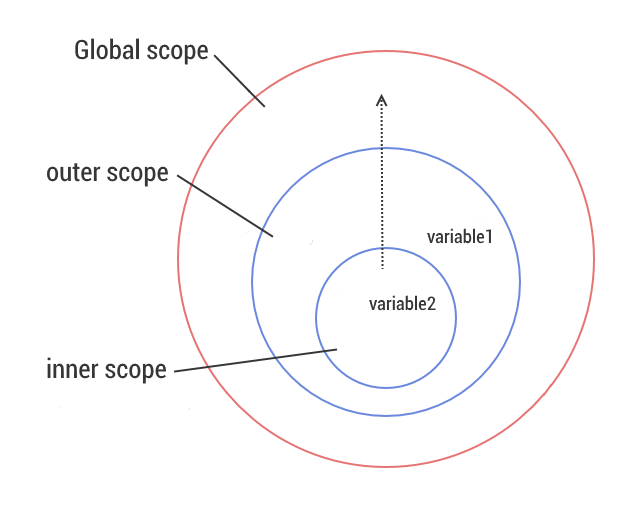 ### 20.什麼是**閉包**? [^](#the-questions "返回問題")這可能是所有這些問題中最難的問題,因為**閉包**是一個有爭議的話題。那我就從我的理解來解釋。 **閉包**只是函數在宣告時記住其當前作用域、其父函數作用域、其父函數的父函數作用域上的變數和參數的引用的能力,直到在**作用域鏈**的幫助下到達全域作用域。基本上它是聲明函數時建立的**作用域**。 例子是解釋閉包的好方法。 ``` //Global's Scope var globalVar = "abc"; function a(){ //testClosures's Scope console.log(globalVar); } a(); //logs "abc" /* Scope Chain Inside a function perspective a's scope -> global's scope */ ``` 在此範例中,當我們宣告`a`函數時**,全域**作用域是`a's`*閉包*的一部分。 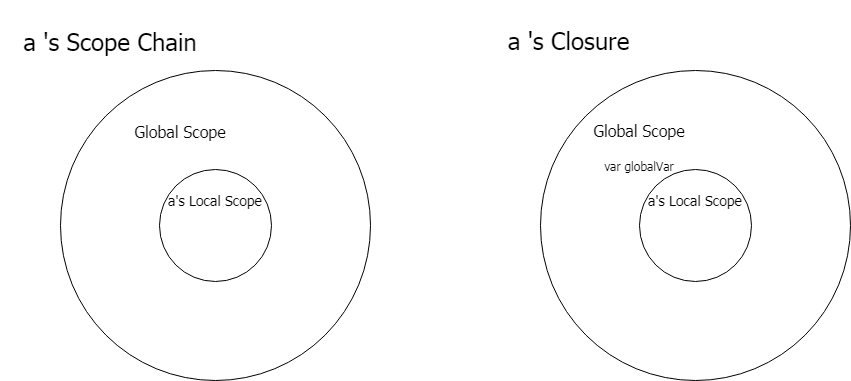 變數`globalVar`在影像中沒有值的原因是該變數的值可以根據我們呼叫`a`**位置**和**時間**而改變。 但在上面的範例中, `globalVar`變數的值為**abc** 。 好吧,讓我們來看一個複雜的例子。 ``` var globalVar = "global"; var outerVar = "outer" function outerFunc(outerParam) { function innerFunc(innerParam) { console.log(globalVar, outerParam, innerParam); } return innerFunc; } const x = outerFunc(outerVar); outerVar = "outer-2"; globalVar = "guess" x("inner"); ``` 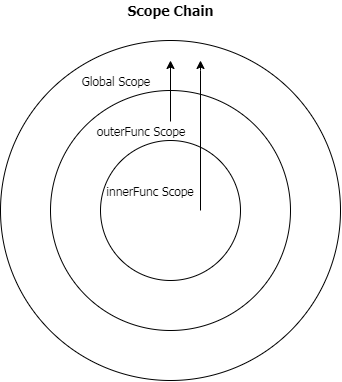 這將列印“猜測外部內部”。對此的解釋是,當我們呼叫`outerFunc`函數並將`innerFunc`函數的回傳值指派給變數`x`時,即使我們將新值**outer-2**指派給`outerVar`變數, `outerParam`也會具有**outer**值,因為 重新分配發生在呼叫`outer`函數之後,當我們呼叫`outerFunc`函數時,它會在**作用域鏈**中尋找`outerVar`的值,而`outerVar`的值為**「outer」** 。現在,當我們呼叫引用了`innerFunc`的`x`變數時, `innerParam`的值為**inner,**因為這是我們在呼叫中傳遞的值,而`globalVar`變數的值為**猜測**,因為在呼叫`x`變數之前,我們為`globalVar`分配了一個新值,並且在呼叫`x`時**作用域鏈**中`globalVar`的值是**猜測**。 我們有一個例子來示範沒有正確理解閉包的問題。 ``` const arrFuncs = []; for(var i = 0; i < 5; i++){ arrFuncs.push(function (){ return i; }); } console.log(i); // i is 5 for (let i = 0; i < arrFuncs.length; i++) { console.log(arrFuncs[i]()); // all logs "5" } ``` 由於**Closures**的原因,此程式碼無法按我們的預期工作。 `var`關鍵字建立一個全域變數,當我們推送一個函數時 我們返回全域變數`i` 。因此,當我們在循環之後呼叫該陣列中的其中一個函數時,它會記錄`5` ,因為我們得到 `i`的目前值為`5` ,我們可以存取它,因為它是全域變數。因為**閉包**保留該變數的**引用,**而不是其建立時的**值**。我們可以使用**IIFES**或將`var`關鍵字變更為`let`來解決此問題,以實現區塊作用域。 ### 21. **JavaScript**中的**假**值是什麼? [↑](#the-questions "返回問題") ``` const falsyValues = ['', 0, null, undefined, NaN, false]; ``` **假**值是轉換為布林值時變成**false 的**值。 ### 22. 如何檢查一個值是否為**假值**? [↑](#the-questions "返回問題")使用**布林**函數或雙非運算符**[!!](#16-what-does-the-operator-do)** ### 23. `"use strict"`有什麼作用? [^](#the-questions "返回問題") `"use strict"`是**JavaScript**中的 ES5 功能,它使我們的程式碼在*函數*或*整個腳本*中處於**嚴格模式**。**嚴格模式**幫助我們避免程式碼早期出現**錯誤**並為其加入限制。 **嚴格模式**給我們的限制。 - 分配或存取未宣告的變數。 ``` function returnY(){ "use strict"; y = 123; return y; } ``` - 為唯讀或不可寫的全域變數賦值; ``` "use strict"; var NaN = NaN; var undefined = undefined; var Infinity = "and beyond"; ``` - 刪除不可刪除的屬性。 ``` "use strict"; const obj = {}; Object.defineProperty(obj, 'x', { value : '1' }); delete obj.x; ``` - 參數名稱重複。 ``` "use strict"; function someFunc(a, b, b, c){ } ``` - 使用**eval**函數建立變數。 ``` "use strict"; eval("var x = 1;"); console.log(x); //Throws a Reference Error x is not defined ``` - **該**值的預設值是`undefined` 。 ``` "use strict"; function showMeThis(){ return this; } showMeThis(); //returns undefined ``` **嚴格模式**的限制遠不止這些。 ### 24. JavaScript 中`this`的值是什麼? [↑](#the-questions "返回問題")基本上, `this`是指目前正在執行或呼叫函數的物件的值。我說**目前**是因為**它**的值會根據我們使用它的上下文和使用它的位置而改變。 ``` const carDetails = { name: "Ford Mustang", yearBought: 2005, getName(){ return this.name; }, isRegistered: true }; console.log(carDetails.getName()); // logs Ford Mustang ``` 這是我們通常所期望的,因為在**getName**方法中我們傳回`this.name` ,在此上下文中`this`指的是`carDetails`物件,該物件目前是正在執行的函數的「擁有者」物件。 好吧,讓我們加入一些程式碼讓它變得奇怪。在`console.log`語句下面加入這三行程式碼 ``` var name = "Ford Ranger"; var getCarName = carDetails.getName; console.log(getCarName()); // logs Ford Ranger ``` 第二個`console.log`語句印製了**「Ford Ranger」**一詞,這很奇怪,因為在我們的第一個`console.log`語句中它印了**「Ford Mustang」** 。原因是`getCarName`方法有一個不同的「擁有者」物件,即`window`物件。在全域作用域中使用`var`關鍵字聲明變數會在`window`物件中附加與變數同名的屬性。請記住,當未使用`"use strict"`時,全域範圍內的`this`指的是`window`物件。 ``` console.log(getCarName === window.getCarName); //logs true console.log(getCarName === this.getCarName); // logs true ``` 本例中的`this`和`window`指的是同一個物件。 解決此問題的一種方法是使用函數中的`<a href="#27-what-is-the-use-functionprototypeapply-method">apply</a>`和`<a href="#28-what-is-the-use-functionprototypecall-method">call</a>`方法。 ``` console.log(getCarName.apply(carDetails)); //logs Ford Mustang console.log(getCarName.call(carDetails)); //logs Ford Mustang ``` `apply`和`call`方法期望第一個參數是一個物件,該物件將是該函數內`this`的值。 **IIFE** (即**立即呼叫函數表達式)** 、在全域作用域中宣告的函數、物件內部方法中的**匿名函數**和內部函數都有一個指向**window**物件的預設**值**。 ``` (function (){ console.log(this); })(); //logs the "window" object function iHateThis(){ console.log(this); } iHateThis(); //logs the "window" object const myFavoriteObj = { guessThis(){ function getThis(){ console.log(this); } getThis(); }, name: 'Marko Polo', thisIsAnnoying(callback){ callback(); } }; myFavoriteObj.guessThis(); //logs the "window" object myFavoriteObj.thisIsAnnoying(function (){ console.log(this); //logs the "window" object }); ``` 如果我們想要取得`myFavoriteObj`物件中的`name`屬性**(Marko Polo)**的值,有兩種方法可以解決這個問題。 首先,我們將`this`的值保存在變數中。 ``` const myFavoriteObj = { guessThis(){ const self = this; //saves the this value to the "self" variable function getName(){ console.log(self.name); } getName(); }, name: 'Marko Polo', thisIsAnnoying(callback){ callback(); } }; ``` 在此圖像中,我們保存`this`的值,該值將是`myFavoriteObj`物件。所以我們可以在`getName`內部函數中存取它。 其次,我們使用**ES6[箭頭函數](#43-what-are-arrow-functions)**。 ``` const myFavoriteObj = { guessThis(){ const getName = () => { //copies the value of "this" outside of this arrow function console.log(this.name); } getName(); }, name: 'Marko Polo', thisIsAnnoying(callback){ callback(); } }; ``` [箭頭函數](#43-what-are-arrow-functions)沒有自己的`this` 。它複製封閉詞法範圍的`this`值,或複製`getName`內部函數外部的`this`值(即`myFavoriteObj`物件)。我們也可以根據[函數的呼叫方式](#66-how-many-ways-can-a-function-be-invoked)來決定`this`的值。 ### 25. 物件的`prototype`是什麼? [↑](#the-questions "返回問題")最簡單的`prototype`是一個物件的*藍圖*。如果目前物件中確實存在它,則將其用作**屬性**和**方法**的後備。這是在物件之間共享屬性和功能的方式。這是 JavaScript**原型繼承**的核心概念。 ``` const o = {}; console.log(o.toString()); // logs [object Object] ``` 即使`o.toString`方法不存在於`o`物件中,它也不會拋出錯誤,而是傳回字串`[object Object]` 。當物件中不存在屬性時,它會尋找其**原型**,如果仍然不存在,則會尋找**原型的原型**,依此類推,直到在**原型鏈**中找到具有相同屬性的屬性。**原型鏈**的末尾在**Object.prototype**之後為`null` 。 ``` console.log(o.toString === Object.prototype.toString); // logs true // which means we we're looking up the Prototype Chain and it reached // the Object.prototype and used the "toString" method. ``` ### 26. 什麼是**IIFE** ,它有什麼用? [^](#the-questions "返回問題") **IIFE**或**立即呼叫函數表達式**是在建立或宣告後將被呼叫或執行的函數。建立**IIFE**的語法是,我們將`function (){}`包裝在括號`()`或**分組運算**子內,以將函數視為表達式,然後用另一個括號`()`呼叫它。所以**IIFE**看起來像這樣`(function(){})()` 。 ``` (function () { }()); (function () { })(); (function named(params) { })(); (() => { })(); (function (global) { })(window); const utility = (function () { return { //utilities }; })(); ``` 這些範例都是有效的**IIFE** 。倒數第二個範例顯示我們可以將參數傳遞給**IIFE**函數。最後一個範例表明我們可以將**IIFE**的結果保存到變數中,以便稍後引用它。 **IIFE**的最佳用途是進行初始化設定功能,並避免與全域範圍內的其他變數**發生命名衝突**或污染全域名稱空間。讓我們舉個例子。 ``` <script src="https://cdnurl.com/somelibrary.js"></script> ``` 假設我們有一個指向庫`somelibrary.js`的連結,該庫公開了我們可以在程式碼中使用的一些全域函數,但該庫有兩個我們不使用`createGraph`和`drawGraph`方法,因為這些方法中有錯誤。我們想要實作我們自己的`createGraph`和`drawGraph`方法。 - 解決這個問題的一種方法是改變腳本的結構。 ``` <script src="https://cdnurl.com/somelibrary.js"></script> <script> function createGraph() { // createGraph logic here } function drawGraph() { // drawGraph logic here } </script> ``` 當我們使用這個解決方案時,我們將覆蓋庫為我們提供的這兩種方法。 - 解決這個問題的另一種方法是更改我們自己的輔助函數的名稱。 ``` <script src="https://cdnurl.com/somelibrary.js"></script> <script> function myCreateGraph() { // createGraph logic here } function myDrawGraph() { // drawGraph logic here } </script> ``` 當我們使用此解決方案時,我們還將這些函數呼叫更改為新函數名稱。 - 另一種方法是使用**IIFE** 。 ``` <script src="https://cdnurl.com/somelibrary.js"></script> <script> const graphUtility = (function () { function createGraph() { // createGraph logic here } function drawGraph() { // drawGraph logic here } return { createGraph, drawGraph } })(); </script> ``` 在此解決方案中,我們建立一個實用程式變數,它是**IIFE**的結果,它傳回一個包含`createGraph`和`drawGraph`兩個方法的物件。 **IIFE**解決的另一個問題就是這個例子。 ``` var li = document.querySelectorAll('.list-group > li'); for (var i = 0, len = li.length; i < len; i++) { li[i].addEventListener('click', function (e) { console.log(i); }) } ``` 假設我們有一個`ul`元素,其類別為**list-group** ,並且它有 5 個`li`子元素。當我們**點擊**單一`li`元素時,我們希望`console.log` `i`的值。 但我們想要的程式碼中的行為不起作用。相反,它會在對`li`元素的任何**點擊**中記錄`5` 。我們遇到的問題是由於**閉包的**工作方式造成的。**閉包**只是函數記住其當前作用域、其父函數作用域和全域作用域中的變數引用的能力。當我們在全域範圍內使用`var`關鍵字聲明變數時,顯然我們正在建立一個全域變數`i` 。因此,當我們單擊`li`元素時,它會記錄**5** ,因為這是我們稍後在回調函數中引用它時的`i`值。 - 解決這個問題的一種方法是**IIFE** 。 ``` var li = document.querySelectorAll('.list-group > li'); for (var i = 0, len = li.length; i < len; i++) { (function (currentIndex) { li[currentIndex].addEventListener('click', function (e) { console.log(currentIndex); }) })(i); } ``` 這個解決方案之所以有效,是因為**IIFE**為每次迭代建立一個新範圍,並且我們捕獲`i`的值並將其傳遞到`currentIndex`參數中,因此當我們呼叫**IIFE**時,每次迭代的`currentIndex`值都是不同的。 ### 27. `Function.prototype.apply`方法有什麼用? [^](#the-questions "返回問題") `apply`呼叫一個函數,在呼叫時指定`this`或該函數的「所有者」物件。 ``` const details = { message: 'Hello World!' }; function getMessage(){ return this.message; } getMessage.apply(details); // returns 'Hello World!' ``` 這個方法的工作方式類似於`<a href="#28-what-is-the-use-functionprototypecall-method">Function.prototype.call</a>`唯一的差異是我們傳遞參數的方式。在`apply`中,我們將參數作為陣列傳遞。 ``` const person = { name: "Marko Polo" }; function greeting(greetingMessage) { return `${greetingMessage} ${this.name}`; } greeting.apply(person, ['Hello']); // returns "Hello Marko Polo!" ``` ### 28. `Function.prototype.call`方法有什麼用? [^](#the-questions "返回問題")此`call`呼叫一個函數,指定呼叫時該函數的`this`或「擁有者」物件。 ``` const details = { message: 'Hello World!' }; function getMessage(){ return this.message; } getMessage.call(details); // returns 'Hello World!' ``` 這個方法的工作方式類似於`<a href="#27-what-is-the-use-functionprototypeapply-method">Function.prototype.apply</a>`唯一的差異是我們傳遞參數的方式。在`call`中,我們直接傳遞參數,對於每個參數`,`用逗號分隔它們。 ``` const person = { name: "Marko Polo" }; function greeting(greetingMessage) { return `${greetingMessage} ${this.name}`; } greeting.call(person, 'Hello'); // returns "Hello Marko Polo!" ``` ### 29. `Function.prototype.apply`和`Function.prototype.call`有什麼差別? [↑](#the-questions "返回問題") `apply`和`call`之間的唯一區別是我們如何在被呼叫的函數中傳遞**參數**。在`apply`中,我們將參數作為**陣列**傳遞,而在`call`中,我們直接在參數列表中傳遞參數。 ``` const obj1 = { result:0 }; const obj2 = { result:0 }; function reduceAdd(){ let result = 0; for(let i = 0, len = arguments.length; i < len; i++){ result += arguments[i]; } this.result = result; } reduceAdd.apply(obj1, [1, 2, 3, 4, 5]); // returns 15 reduceAdd.call(obj2, 1, 2, 3, 4, 5); // returns 15 ``` ### 30. `Function.prototype.bind`的用法是什麼? [↑](#the-questions "返回問題") `bind`方法傳回一個新*綁定的*函數 到特定的`this`值或“所有者”物件,因此我們可以稍後在程式碼中使用它。 `call` 、 `apply`方法立即呼叫函數,而不是像`bind`方法那樣傳回一個新函數。 ``` import React from 'react'; class MyComponent extends React.Component { constructor(props){ super(props); this.state = { value : "" } this.handleChange = this.handleChange.bind(this); // Binds the "handleChange" method to the "MyComponent" component } handleChange(e){ //do something amazing here } render(){ return ( <> <input type={this.props.type} value={this.state.value} onChange={this.handleChange} /> </> ) } } ``` ### 31.什麼是**函數式程式設計**? **JavaScript**的哪些特性使其成為**函數式語言**的候選者? [^](#the-questions "返回問題")**函數式程式設計**是一種**聲明式**程式設計範式或模式,它介紹如何**使用表達式來**計算值而不改變傳遞給它的參數的函數來建立應用程式。 JavaScript**陣列**具有**map** 、 **filter** 、 **reduce**方法,這些方法是函數式程式設計世界中最著名的函數,因為它們非常有用,而且它們不會改變或改變陣列,這使得這些函數變得**純粹**,並且JavaScript 支援**閉包**和**高階函數**,它們是**函數式程式語言**的一個特徵。 - **map**方法建立一個新陣列,其中包含對陣列中每個元素呼叫提供的回調函數的結果。 ``` const words = ["Functional", "Procedural", "Object-Oriented"]; const wordsLength = words.map(word => word.length); ``` - **filter**方法會建立一個新陣列,其中包含透過回調函數中測試的所有元素。 ``` const data = [ { name: 'Mark', isRegistered: true }, { name: 'Mary', isRegistered: false }, { name: 'Mae', isRegistered: true } ]; const registeredUsers = data.filter(user => user.isRegistered); ``` - **reduce**方法對累加器和陣列中的每個元素(從左到右)套用函數,將其減少為單一值。 ``` const strs = ["I", " ", "am", " ", "Iron", " ", "Man"]; const result = strs.reduce((acc, currentStr) => acc + currentStr, ""); ``` ### 32.什麼是**高階函數**? [^](#the-questions "返回問題")**高階函數**是可以傳回函數或接收具有函數值的一個或多個參數的函數。 ``` function higherOrderFunction(param,callback){ return callback(param); } ``` ### 33.為什麼函數被稱為**First-class Objects** ? [^](#the-questions "返回問題") JavaScript 中的 \_\_Functions\_\_ 是**一流物件**,因為它們被視為該語言中的任何其他值。它們可以分配給**變數**,可以是稱為**方法的物件的屬性**,可以是**陣列中的專案**,可以**作為參數傳遞給函數**,也可以**作為函數的值返回**。函數與**JavaScript**中任何其他值之間的唯一區別是**函數**可以被呼叫。 ### 34. 手動實作`Array.prototype.map`方法。 [↑](#the-questions "返回問題") ``` function map(arr, mapCallback) { // First, we check if the parameters passed are right. if (!Array.isArray(arr) || !arr.length || typeof mapCallback !== 'function') { return []; } else { let result = []; // We're making a results array every time we call this function // because we don't want to mutate the original array. for (let i = 0, len = arr.length; i < len; i++) { result.push(mapCallback(arr[i], i, arr)); // push the result of the mapCallback in the 'result' array } return result; // return the result array } } ``` 正如`Array.prototype.map`方法的MDN描述。 **map() 方法建立一個新陣列,其中包含對呼叫陣列中的每個元素呼叫所提供函數的結果。** ### 35. 手動實作`Array.prototype.filter`方法。 [↑](#the-questions "返回問題") ``` function filter(arr, filterCallback) { // First, we check if the parameters passed are right. if (!Array.isArray(arr) || !arr.length || typeof filterCallback !== 'function') { return []; } else { let result = []; // We're making a results array every time we call this function // because we don't want to mutate the original array. for (let i = 0, len = arr.length; i < len; i++) { // check if the return value of the filterCallback is true or "truthy" if (filterCallback(arr[i], i, arr)) { // push the current item in the 'result' array if the condition is true result.push(arr[i]); } } return result; // return the result array } } ``` 正如`Array.prototype.filter`方法的 MDN 描述。 **filter() 方法建立一個新陣列,其中包含透過所提供函數實現的測試的所有元素。** ### 36. 手動實作`Array.prototype.reduce`方法。 [↑](#the-questions "返回問題") ``js 函數reduce(arr,reduceCallback,initialValue){ // 首先,我們檢查傳遞的參數是否正確。 if (!Array.isArray(arr) || !arr.length || typeof reduceCallback !== 'function') { ``` return []; ``` } 別的 { ``` // If no initialValue has been passed to the function we're gonna use the ``` ``` let hasInitialValue = initialValue !== undefined; ``` ``` let value = hasInitialValue ? initialValue : arr[0]; ``` ``` // first array item as the initialValue ``` ``` // Then we're gonna start looping at index 1 if there is no ``` ``` // initialValue has been passed to the function else we start at 0 if ``` ``` // there is an initialValue. ``` ``` for (let i = hasInitialValue ? 0 : 1, len = arr.length; i < len; i++) { ``` ``` // Then for every iteration we assign the result of the ``` ``` // reduceCallback to the variable value. ``` ``` value = reduceCallback(value, arr[i], i, arr); ``` ``` } ``` ``` return value; ``` } } ``` As the MDN description of the <code>Array.prototype.reduce</code> method. __The reduce() method executes a reducer function (that you provide) on each element of the array, resulting in a single output value.__ ###37. What is the __arguments__ object? [↑](#the-questions "Back To Questions") The __arguments__ object is a collection of parameter values pass in a function. It's an __Array-like__ object because it has a __length__ property and we can access individual values using array indexing notation <code>arguments[1]</code> but it does not have the built-in methods in an array <code>forEach</code>,<code>reduce</code>,<code>filter</code> and <code>map</code>. It helps us know the number of arguments pass in a function. We can convert the <code>arguments</code> object into an array using the <code>Array.prototype.slice</code>. ``` 函數一(){ 返回 Array.prototype.slice.call(參數); } ``` Note: __the <code>arguments</code> object does not work on ES6 arrow functions.__ ``` 函數一(){ 返回參數; } 常數二 = 函數 () { 返回參數; } 常量三 = 函數三() { 返回參數; } const 四 = () => 參數; 四(); // 拋出錯誤 - 參數未定義 ``` When we invoke the function <code>four</code> it throws a <code>ReferenceError: arguments is not defined</code> error. We can solve this problem if your enviroment supports the __rest syntax__. ``` const 四 = (...args) => args; ``` This puts all parameter values in an array automatically. ###38. How to create an object without a __prototype__? [↑](#the-questions "Back To Questions") We can create an object without a _prototype_ using the <code>Object.create</code> method. ``` 常數 o1 = {}; console.log(o1.toString()); // Logs \[object Object\] 取得此方法到Object.prototype const o2 = Object.create(null); // 第一個參數是物件「o2」的原型,在此 // case 將為 null 指定我們不需要任何原型 console.log(o2.toString()); // 拋出錯誤 o2.toString 不是函數 ``` ###39. Why does <code>b</code> in this code become a global variable when you call this function? [↑](#the-questions "Back To Questions") ``` 函數 myFunc() { 令a = b = 0; } myFunc(); ``` The reason for this is that __assignment operator__ or __=__ has right-to-left __associativity__ or __evaluation__. What this means is that when multiple assignment operators appear in a single expression they evaluated from right to left. So our code becomes likes this. ``` 函數 myFunc() { 令 a = (b = 0); } myFunc(); ``` First, the expression <code>b = 0</code> evaluated and in this example <code>b</code> is not declared. So, The JS Engine makes a global variable <code>b</code> outside this function after that the return value of the expression <code>b = 0</code> would be 0 and it's assigned to the new local variable <code>a</code> with a <code>let</code> keyword. We can solve this problem by declaring the variables first before assigning them with value. ``` 函數 myFunc() { 令 a,b; a = b = 0; } myFunc(); ``` ###40. <div id="ecmascript">What is __ECMAScript__</div>? [↑](#the-questions "Back To Questions") __ECMAScript__ is a standard for making scripting languages which means that __JavaScript__ follows the specification changes in __ECMAScript__ standard because it is the __blueprint__ of __JavaScript__. ###41. What are the new features in __ES6__ or __ECMAScript 2015__? [↑](#the-questions "Back To Questions") * [Arrow Functions](#43-what-are-arrow-functions) * [Classes](#44-what-are-classes) * [Template Strings](#45-what-are-template-literals) * __Enhanced Object literals__ * [Object Destructuring](#46-what-is-object-destructuring) * [Promises](#50-what-are-promises) * __Generators__ * [Modules](#47-what-are-es6-modules) * Symbol * __Proxies__ * [Sets](#48-what-is-the-set-object-and-how-does-it-work) * [Default Function parameters](#53-what-are-default-parameters) * [Rest and Spread](#52-whats-the-difference-between-spread-operator-and-rest-operator) * [Block Scoping with <code>let</code> and <code>const</code>](#42-whats-the-difference-between-var-let-and-const-keywords) ###42. What's the difference between <code>var</code>, <code>let</code> and <code>const</code> keywords? [↑](#the-questions "Back To Questions") Variables declared with <code>var</code> keyword are _function scoped_. What this means that variables can be accessed across that function even if we declare that variable inside a block. ``` 函數給MeX(showX) { 如果(顯示X){ ``` var x = 5; ``` } 返回x; } console.log(giveMeX(false)); console.log(giveMeX(true)); ``` The first <code>console.log</code> statement logs <code>undefined</code> and the second <code>5</code>. We can access the <code>x</code> variable due to the reason that it gets _hoisted_ at the top of the function scope. So our function code is intepreted like this. ``` 函數給MeX(showX) { 變數 x; // 有一個預設值未定義 如果(顯示X){ ``` x = 5; ``` } 返回x; } ``` If you are wondering why it logs <code>undefined</code> in the first <code>console.log</code> statement remember variables declared without an initial value has a default value of <code>undefined</code>. Variables declared with <code>let</code> and <code>const</code> keyword are _block scoped_. What this means that variable can only be accessed on that block <code>{}</code> on where we declare it. ``` 函數給MeX(showX) { 如果(顯示X){ ``` let x = 5; ``` } 返回x; } 函數給MeY(顯示Y){ 如果(顯示Y){ ``` let y = 5; ``` } 返回y; } ``` If we call this functions with an argument of <code>false</code> it throws a <code>Reference Error</code> because we can't access the <code>x</code> and <code>y</code> variables outside that block and those variables are not _hoisted_. There is also a difference between <code>let</code> and <code>const</code> we can assign new values using <code>let</code> but we can't in <code>const</code> but <code>const</code> are mutable meaning. What this means is if the value that we assign to a <code>const</code> is an object we can change the values of those properties but can't reassign a new value to that variable. ###43. What are __Arrow functions__? [↑](#the-questions "Back To Questions") __Arrow Functions__ are a new way of making functions in JavaScript. __Arrow Functions__ takes a little time in making functions and has a cleaner syntax than a __function expression__ because we omit the <code>function</code> keyword in making them. ``` //ES5版本 var getCurrentDate = 函數 (){ 返回新日期(); } //ES6版本 const getCurrentDate = () => new Date(); ``` In this example, in the ES5 Version have <code>function(){}</code> declaration and <code>return</code> keyword needed to make a function and return a value respectively. In the __Arrow Function__ version we only need the <code>()</code> parentheses and we don't need a <code>return</code> statement because __Arrow Functions__ have a implicit return if we have only one expression or value to return. ``` //ES5版本 函數問候(名稱){ return '你好' + 名字 + '!'; } //ES6版本 const 問候 = (name) => `Hello ${name}` ; constgreet2 = 名稱 => `Hello ${name}` ; ``` We can also parameters in __Arrow functions__ the same as the __function expressions__ and __function declarations__. If we have one parameter in an __Arrow Function__ we can omit the parentheses it is also valid. ``` const getArgs = () => 參數 const getArgs2 = (...休息) => 休息 ``` __Arrow functions__ don't have access to the <code>arguments</code> object. So calling the first <code>getArgs</code> func will throw an Error. Instead we can use the __rest parameters__ to get all the arguments passed in an arrow function. ``` 常量資料 = { 結果:0, 數字:\[1,2,3,4,5\], 計算結果() { ``` // "this" here refers to the "data" object ``` ``` const addAll = () => { ``` ``` // arrow functions "copies" the "this" value of ``` ``` // the lexical enclosing function ``` ``` return this.nums.reduce((total, cur) => total + cur, 0) ``` ``` }; ``` ``` this.result = addAll(); ``` } }; ``` __Arrow functions__ don't have their own <code>this</code> value. It captures or gets the <code>this</code> value of lexically enclosing function or in this example, the <code>addAll</code> function copies the <code>this</code> value of the <code>computeResult</code> method and if we declare an arrow function in the global scope the value of <code>this</code> would be the <code>window</code> object. ###44. What are __Classes__? [↑](#the-questions "Back To Questions") __Classes__ is the new way of writing _constructor functions_ in __JavaScript__. It is _syntactic sugar_ for using _constructor functions_, it still uses __prototypes__ and __Prototype-Based Inheritance__ under the hood. ``` //ES5版本 函數人(名字,姓氏,年齡,地址){ ``` this.firstName = firstName; ``` ``` this.lastName = lastName; ``` ``` this.age = age; ``` ``` this.address = address; ``` } Person.self = 函數(){ ``` return this; ``` } Person.prototype.toString = function(){ ``` return "[object Person]"; ``` } Person.prototype.getFullName = function (){ ``` return this.firstName + " " + this.lastName; ``` } //ES6版本 類人{ ``` constructor(firstName, lastName, age, address){ ``` ``` this.lastName = lastName; ``` ``` this.firstName = firstName; ``` ``` this.age = age; ``` ``` this.address = address; ``` ``` } ``` ``` static self() { ``` ``` return this; ``` ``` } ``` ``` toString(){ ``` ``` return "[object Person]"; ``` ``` } ``` ``` getFullName(){ ``` ``` return `${this.firstName} ${this.lastName}`; ``` ``` } ``` } ``` __Overriding Methods__ and __Inheriting from another class__. ``` //ES5版本 Employee.prototype = Object.create(Person.prototype); 函數 Employee(名字, 姓氏, 年齡, 地址, 職位名稱, 開始年份) { Person.call(this, 名字, 姓氏, 年齡, 地址); this.jobTitle = jobTitle; this.yearStarted = YearStarted; } Employee.prototype.describe = function () { return `I am ${this.getFullName()} and I have a position of ${this.jobTitle} and I started at ${this.yearStarted}` ; } Employee.prototype.toString = function () { 返回“\[物件員工\]”; } //ES6版本 class Employee extends Person { //繼承自「Person」類 建構函數(名字,姓氏,年齡,地址,工作標題,開始年份){ ``` super(firstName, lastName, age, address); ``` ``` this.jobTitle = jobTitle; ``` ``` this.yearStarted = yearStarted; ``` } 描述() { ``` return `I am ${this.getFullName()} and I have a position of ${this.jobTitle} and I started at ${this.yearStarted}`; ``` } toString() { // 重寫「Person」的「toString」方法 ``` return "[object Employee]"; ``` } } ``` So how do we know that it uses _prototypes_ under the hood? ``` 類別東西{ } 函數 AnotherSomething(){ } const as = new AnotherSomething(); const s = new Something(); console.log(typeof Something); // 記錄“函數” console.log(AnotherSomething 類型); // 記錄“函數” console.log(as.toString()); // 記錄“\[物件物件\]” console.log(as.toString()); // 記錄“\[物件物件\]” console.log(as.toString === Object.prototype.toString); console.log(s.toString === Object.prototype.toString); // 兩個日誌都回傳 true 表示我們仍在使用 // 底層原型,因為 Object.prototype 是 // 原型鏈的最後一部分和“Something” // 和「AnotherSomething」都繼承自Object.prototype ``` ###45. What are __Template Literals__? [↑](#the-questions "Back To Questions") __Template Literals__ are a new way of making __strings__ in JavaScript. We can make __Template Literal__ by using the backtick or back-quote symbol. ``` //ES5版本 vargreet = '嗨,我是馬克'; //ES6版本 讓問候 = `Hi I'm Mark` ; ``` In the ES5 version, we need to escape the <code>'</code> using the <code>\\</code> to _escape_ the normal functionality of that symbol which in this case is to finish that string value. In Template Literals, we don't need to do that. ``` //ES5版本 var 最後一個字 = '\\n' - ' 在' - '我\\n' - '鋼鐵人\\n'; //ES6版本 讓最後一個單字=` ``` I ``` ``` Am ``` 鋼鐵人 `; ``` In the ES5 version, we need to add this <code>\n</code> to have a new line in our string. In Template Literals, we don't need to do that. ``` //ES5版本 函數問候(名稱){ return '你好' + 名字 + '!'; } //ES6版本 const 問候 = 名稱 => { 返回`Hello ${name} !` ; } ``` In the ES5 version, If we need to add an expression or value in a string we need to use the <code>+</code> or string concatenation operator. In Template Literals, we can embed an expression using <code>${expr}</code> which makes it cleaner than the ES5 version. ###46. What is __Object Destructuring__? [↑](#the-questions "Back To Questions") __Object Destructuring__ is a new and cleaner way of __getting__ or __extracting__ values from an object or an array. Suppose we have an object that looks like this. ``` 常量僱員 = { 名字:“馬可”, 姓氏:“波羅”, 職位:“軟體開發人員”, 聘用年份:2017 }; ``` The old way of getting properties from an object is we make a variable t
長話短說 ==== 在本文中,您將學習如何使用 Nextjs、CopilotKit 和 OpenAI 建立人工智慧驅動的 PowerPoint 應用程式。我們將涵蓋: - 利用 ChatGPT 建立您的 PowerPoint 簡報📊 - 與您的 PowerPoint 簡報聊天💬 - 將音訊和圖像新增至您的 PowerPoint 簡報🔉  --- CopilotKit:建構深度整合的應用內人工智慧聊天機器人💬 ------------------------------- CopilotKit 是[開源人工智慧副駕駛平台。](https://github.com/CopilotKit/CopilotKit)我們可以輕鬆地將強大的人工智慧聊天機器人整合到您的 React 應用程式中。完全可定制和深度集成。  {% cta https://github.com/CopilotKit/CopilotKit %} Star CopilotKit ⭐️ {% endcta %} ###### \*在布胡布上 現在回到文章。 --- **先決條件** -------- 要開始學習本教程,您需要在電腦上安裝以下軟體: - 文字編輯器(例如 Visual Studio Code) - Node.js - 套件管理器 使用 NextJS 建立 PowerPoint 應用程式前端 ------------------------------ **步驟 1:**使用下列指令 Git 複製 PowerPoint 應用程式樣板。 ``` git clone https://github.com/TheGreatBonnie/aipoweredpowerpointpresentation ``` **步驟 2:**在文字編輯器上開啟 PowerPoint 應用程式樣板,並使用下列指令安裝所有專案相依性。 ``` npm install ``` 步驟3: • 前往根目錄\*\*\*\*並建立一個名為**`.env.local`的檔案。**在該文件中,加入下面保存您的 ChatGPT API 金鑰的環境變數。 ``` OPENAI_API_KEY="Your ChatGPT API Key” ``` **步驟4:**在命令列執行命令*npm run dev* 。導航至 http://localhost:3000/,您應該會看到 PowerPoint 應用程式前端。 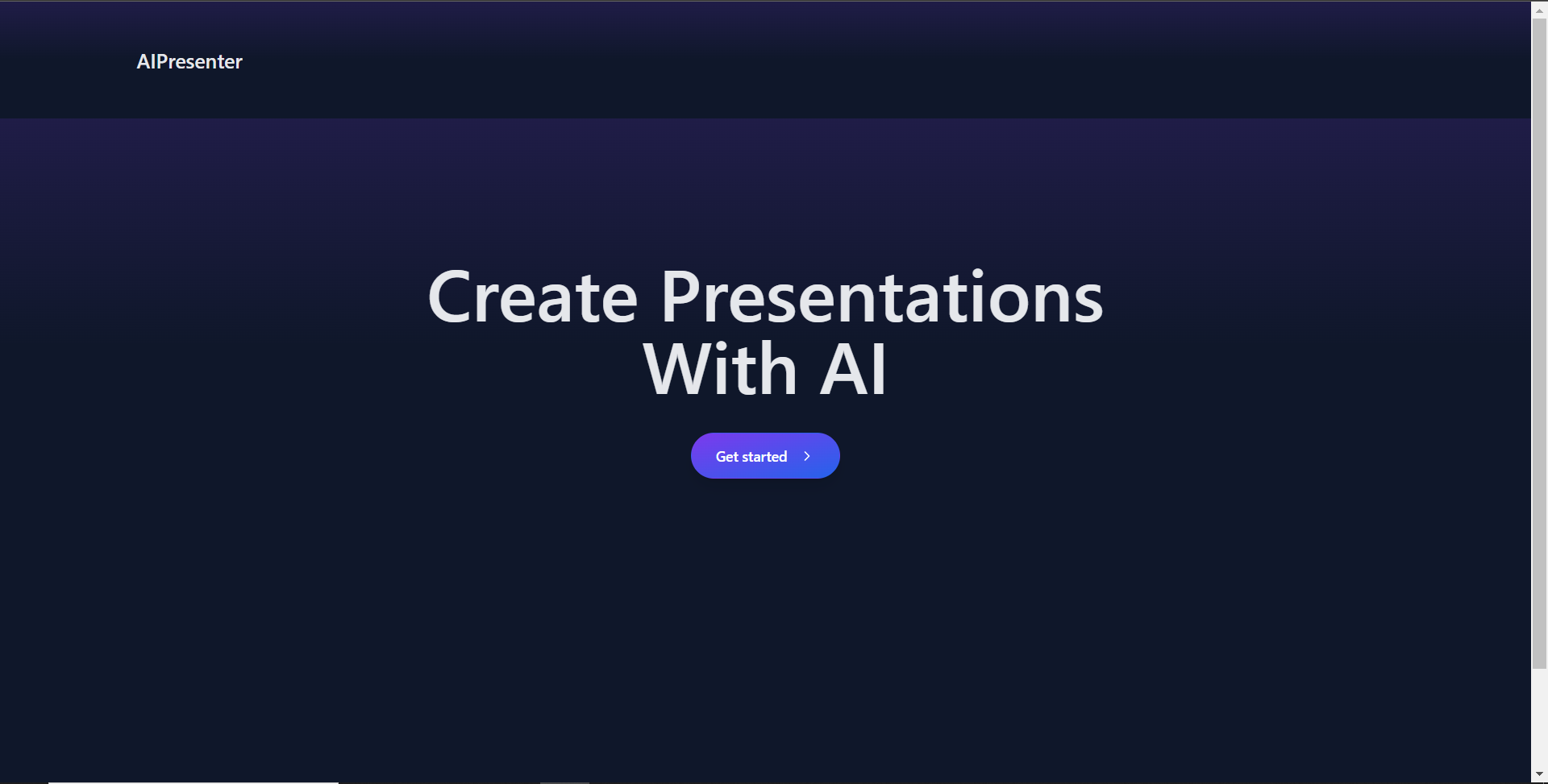 建立 PowerPoint 投影片功能 ------------------- 步驟 1:前往**`/[root]/src/app/components`** ,並建立一個名為`present.tsx`的檔案。然後在文件頂部導入以下相依性。 ``` "use client"; import { useCopilotContext } from "@copilotkit/react-core"; import { CopilotTask } from "@copilotkit/react-core"; import { useMakeCopilotActionable, useMakeCopilotReadable, } from "@copilotkit/react-core"; import { useEffect, useState } from "react"; import "./../presentation/styles.css"; import Markdown from "react-markdown"; ``` 步驟 2:定義一個名為 Slide 的 TypeScript 接口,其中包含 PowerPoint 簡報投影片的標題和內容屬性。 ``` // Define slide interface interface Slide { title: string; content: string; } ``` 步驟 3:建立一個名為`Presentation`函數,並使用usestate 初始化名為`allSlides`和`currentSlideIndex`狀態變數`usestate.`變數`allSlides`將保存幻燈片陣列,而`currentSlideIndex`將保存目前幻燈片索引。 ``` export function Presentation (){ const [allSlides, setAllSlides] = useState<Slide[]>([]); const [currentSlideIndex, setCurrentSlideIndex] = useState<number>(0); } ``` 步驟 4:在`Presentation`函數中,使用`useMakeCopilotReadable`掛鉤新增投影片的`allSlides`陣列作為應用程式內聊天機器人的上下文。 ``` useMakeCopilotReadable("Powerpoint presentation slides: " + JSON.stringify(allSlides)); ``` 步驟 5:使用`useMakeCopilotActionable`掛鉤設定一個名為`createNewPowerPointSlide`操作,其中包含描述和更新`allSlides`和`currentSlideIndex`狀態變數的實作函數,如下所示。 ``` useMakeCopilotActionable( { name: "createNewPowerPointSlide", description: "create slides for a powerpoint presentation. Call this function multiple times to present multiple slides.", argumentAnnotations: [ { name: "slideTitle", type: "string", description: "The topic to display in the presentation slide. Use simple markdown to outline your speech, like a headline.", required: true, }, { name: "content", type: "string", description: "The content to display in the presentation slide. Use simple markdown to outline your speech, like lists, paragraphs, etc.", required: true }, ], implementation: async (newSlideTitle, newSlideContent) => { const newSlide: Slide = { title: newSlideTitle, content: newSlideContent}; const updatedSlides = [...allSlides, newSlide]; setAllSlides(updatedSlides); setCurrentSlideIndex(updatedSlides.length - 1); }, }, [], ); ``` 步驟6:定義一個名為`displayCurrentSlide`的函數,用於在前端顯示目前投影片索引。 ``` // Display current slide const displayCurrentSlide = () => { const slide = allSlides[currentSlideIndex]; return slide ? ( <div className="h-screen flex flex-col justify-center items-center text-5xl text-white bg-cover bg-center bg-no-repeat p-10 text-center" style={{ textShadow: "1px 1px 0 #000, -1px -1px 0 #000, 1px -1px 0 #000, -1px 1px 0 #000", }} > <Markdown className="markdown">{slide.title}</Markdown> <Markdown className="markdown">{slide.content}</Markdown> </div> ) : ( <div className="h-screen flex flex-col justify-center items-center text-5xl text-white bg-cover bg-center bg-no-repeat p-10 text-center"> No Slide To Display </div> ); }; ``` 步驟 7: 定義一個名為 addSlide 的函數,該函數包含一個名為 CopilotTask 的類別。 CopilotTask 類別定義新增投影片的功能。 ``` // Add new slide function const addSlide = new CopilotTask({ instructions: "create a new slide", actions: [ { name: "newSlide", description: "Make a new slide related to the current topic.", argumentAnnotations: [ { name: "title", type: "string", description: "The title to display in the presentation slide.", required: true, }, { name: "content", type: "string", description: "The title to display in the presentation slide.", required: true, }, ], implementation: async (newSlideTitle,newSlideContent,) => { const newSlide: Slide = {title: newSlideTitle,content: newSlideContent,}; const updatedSlides = [...allSlides, newSlide]; setAllSlides(updatedSlides); setCurrentSlideIndex(updatedSlides.length - 1); }, }, ], }); const context = useCopilotContext(); const [randomSlideTaskRunning, setRandomSlideTaskRunning] = useState(false); ``` 步驟 8:定義兩個函數 goBack 和 goForward。 goBack 函數定義導覽到上一張投影片的功能,而 goForward 函數定義導覽到下一張投影片的功能。 ``` // Button click handlers for navigation const goBack = () => setCurrentSlideIndex((prev) => Math.max(0, prev - 1)); const goForward = () => setCurrentSlideIndex((prev) => Math.min(allSlides.length - 1, prev + 1)); ``` 步驟9:傳回一個呼叫displayCurrentSlide函數的元件,並包含呼叫addSlide、goBack和goForward函數的按鈕。 ``` return ( <div> {displayCurrentSlide()} <button disabled={randomSlideTaskRunning} className={`absolute bottom-12 left-0 mb-4 ml-4 bg-blue-500 text-white font-bold py-2 px-4 rounded ${randomSlideTaskRunning ? "opacity-50 cursor-not-allowed" : "hover:bg-blue-700"}`} onClick={async () => { try { setRandomSlideTaskRunning(true); await addSlide.run(context); } finally { setRandomSlideTaskRunning(false); } }} > {randomSlideTaskRunning ? "Loading slide..." : "Add Slide +"} </button> <button className={`absolute bottom-0 left-0 mb-4 ml-4 bg-blue-500 text-white font-bold py-2 px-4 rounded ${randomSlideTaskRunning ? "opacity-50 cursor-not-allowed" : "hover:bg-blue-700"}`} onClick={goBack}>Prev</button> <button className={`absolute bottom-0 left-20 mb-4 ml-4 bg-blue-500 text-white font-bold py-2 px-4 rounded ${randomSlideTaskRunning ? "opacity-50 cursor-not-allowed" : "hover:bg-blue-700"}`} onClick={goForward}>Next</button> </div> ); ``` 步驟10:在Presentation資料夾中,將以下程式碼加入page.tsx檔案。 ``` "use client"; import { CopilotKit } from "@copilotkit/react-core"; import { CopilotSidebar } from "@copilotkit/react-ui"; import {Presentation} from "../components/present"; import "./styles.css"; let globalAudio: any = undefined; let globalAudioEnabled = false; const Demo = () => { return ( <CopilotKit url="/api/copilotkit/openai"> <CopilotSidebar defaultOpen={true} labels={{ title: "Presentation Copilot", initial: "Hi you! 👋 I can give you a presentation on any topic.", }} clickOutsideToClose={false} onSubmitMessage={async (message) => { if (!globalAudioEnabled) { globalAudio.play(); globalAudio.pause(); } globalAudioEnabled = true; }} > <Presentation/> </CopilotSidebar> </CopilotKit> ); }; export default Demo; ``` 步驟11:導覽至http://localhost:3000/,點擊「開始」按鈕,您將被重定向到與聊天機器人整合的演示頁面,如下所示。 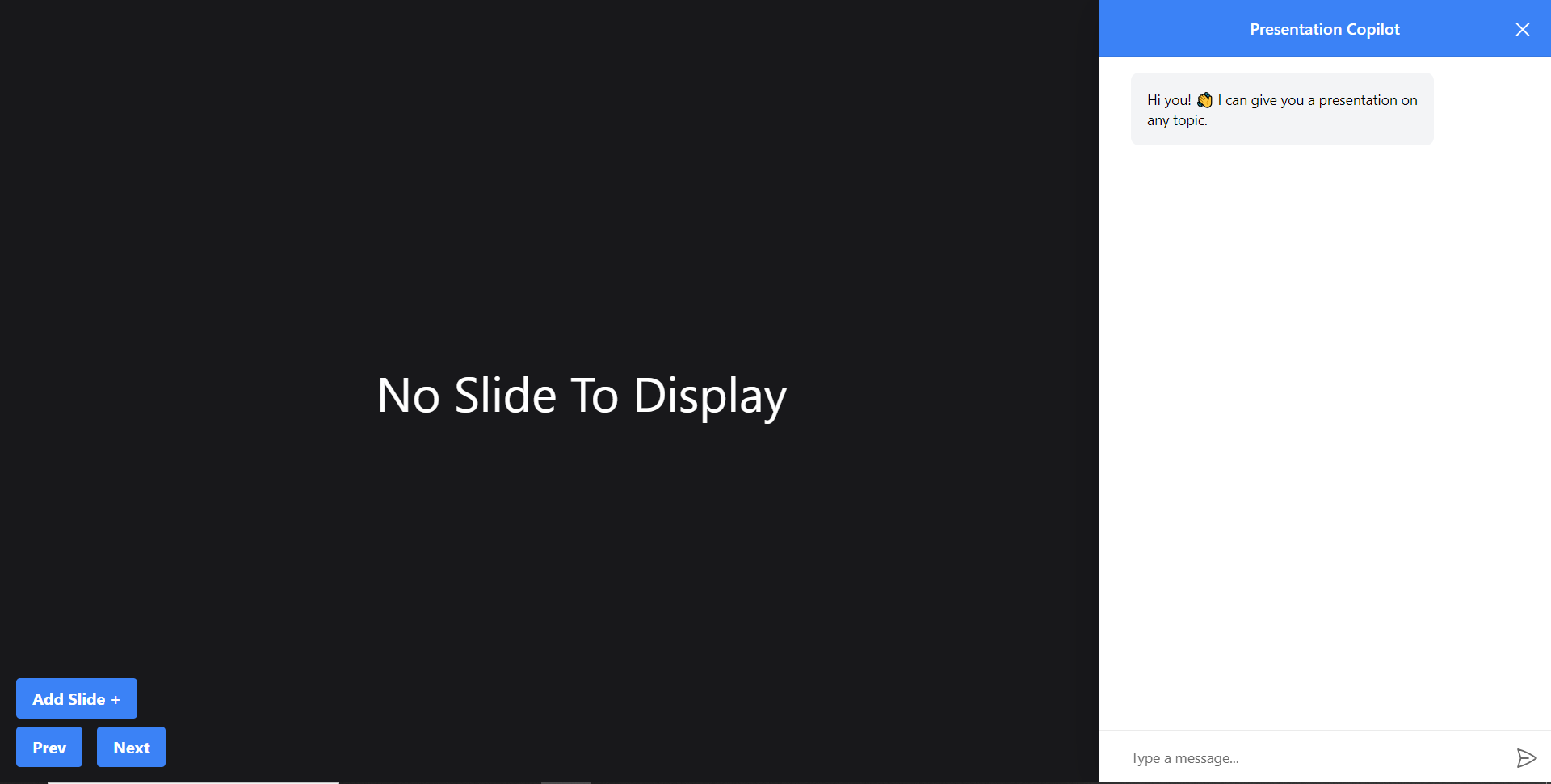 步驟12:給右側的聊天機器人一個提示,例如「在TypeScript上建立PowerPoint簡報」聊天機器人將開始產生回應,完成後,它將在頁面左側顯示產生的PowerPoint投影片,如下圖所示 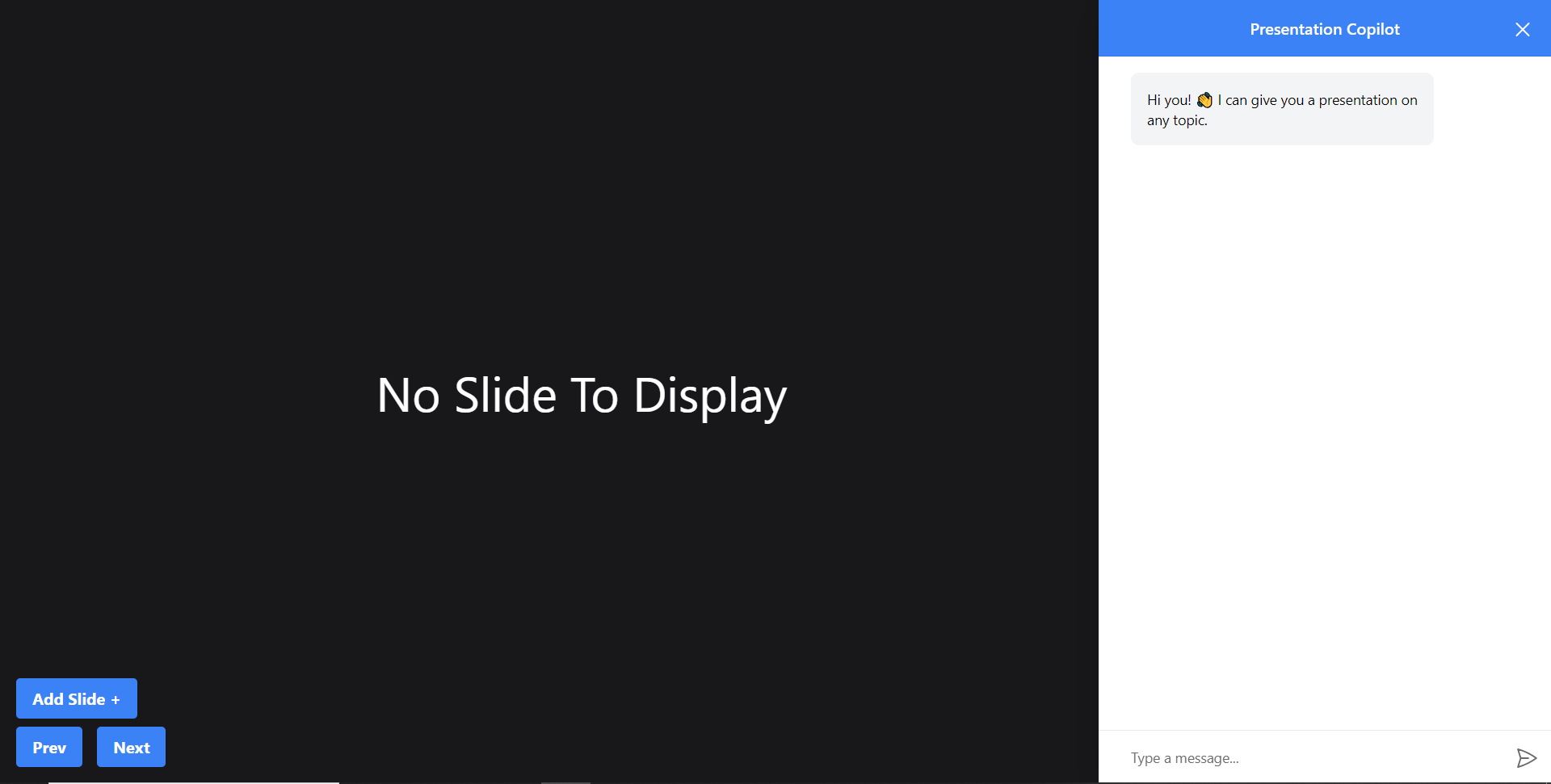 步驟 13:關閉聊天機器人窗口,然後按一下新增投影片 + 按鈕將新投影片新增至 PowerPoint 簡報中,如下所示。 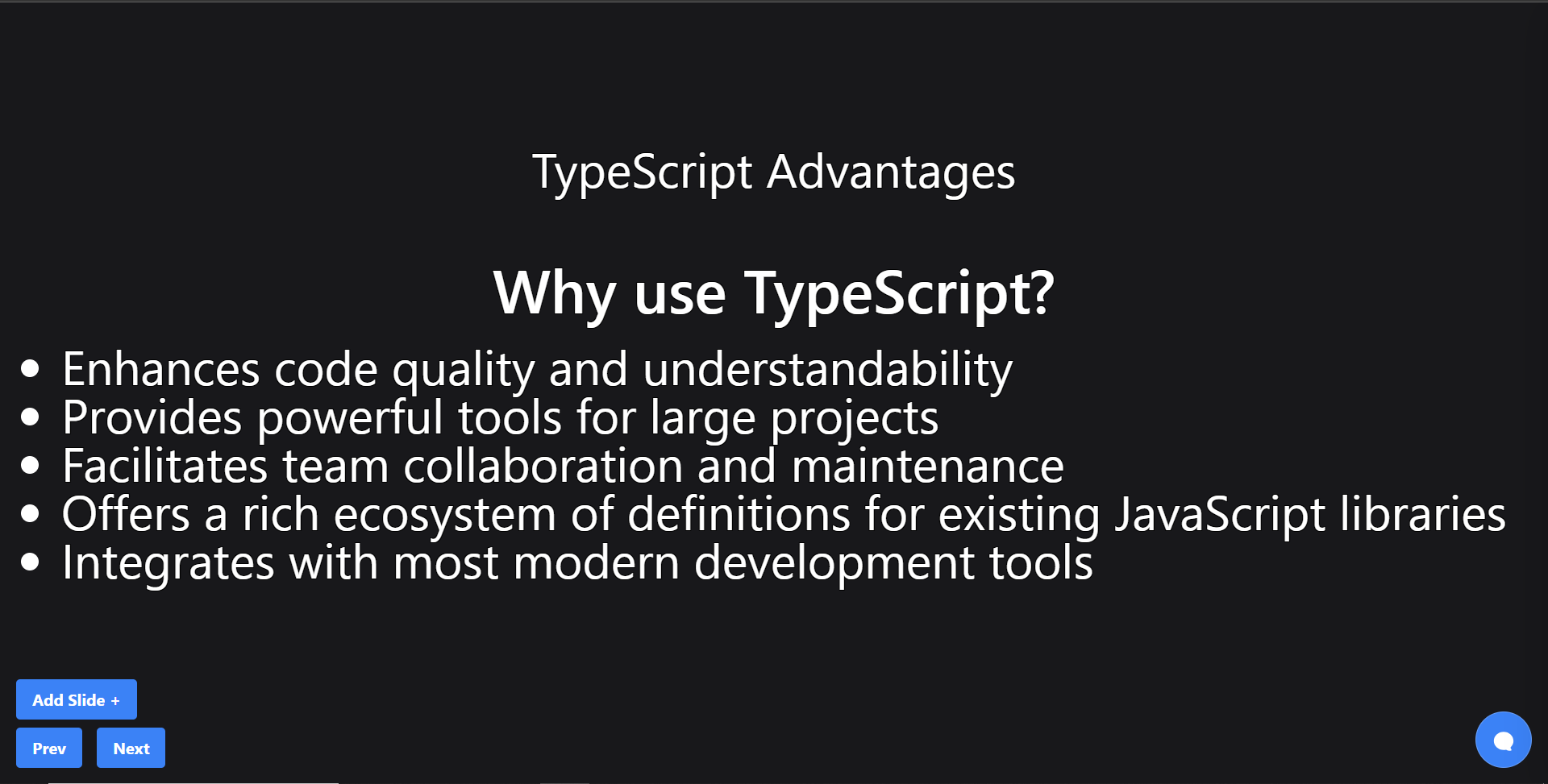 第 14 步:按一下「上一張」按鈕,您將導覽至上一張投影片。如果您按一下「下一步」按鈕,您將導覽至下一張投影片。 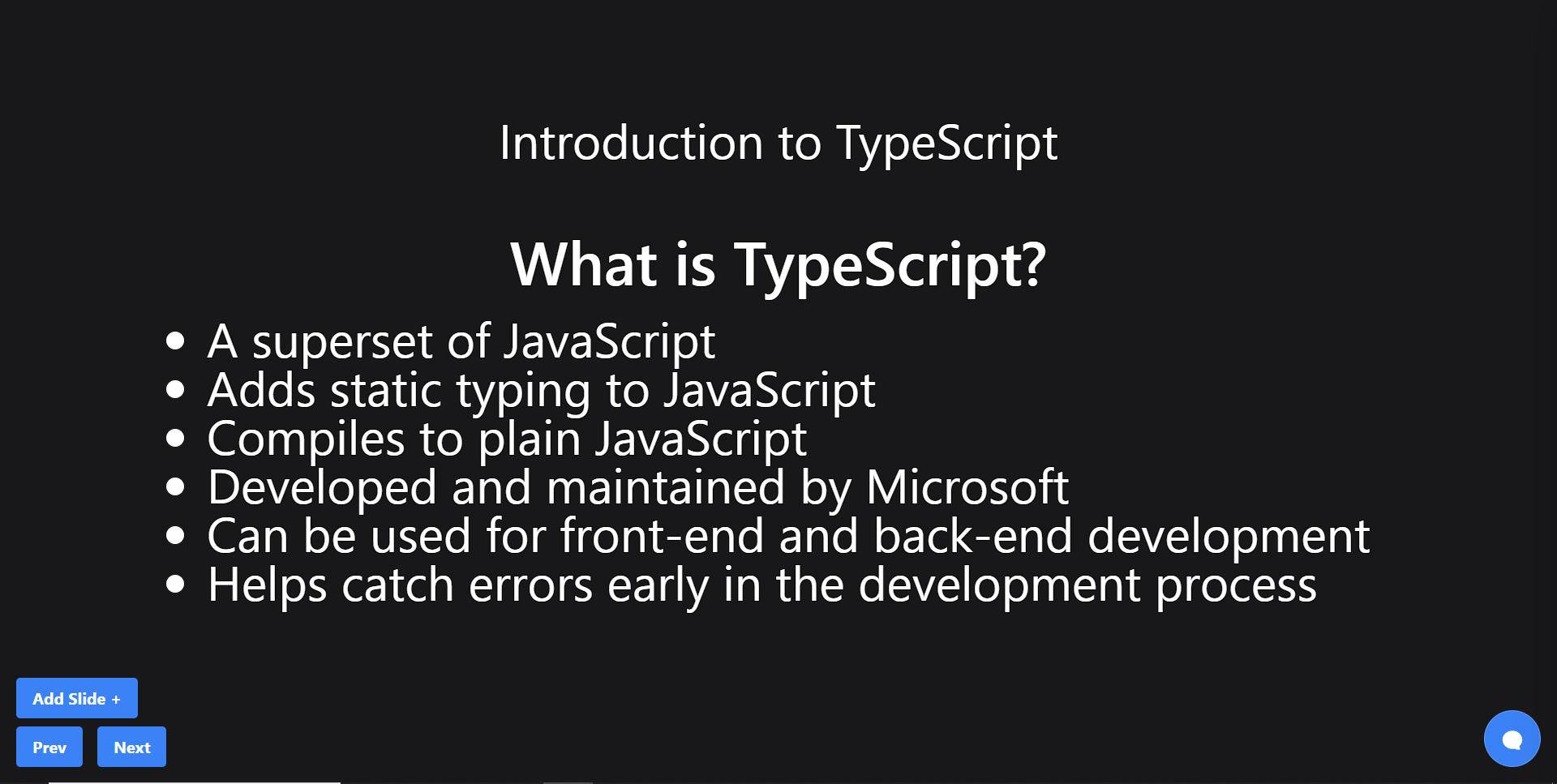 建立 PowerPoint 投影片 自動語音功能 ------------------------ 步驟1:在`present.tsx`檔案中,宣告一個名為`globalAudio`的變數,如下所示。 ``` let globalAudio: any = undefined; ``` 步驟2:在`Presentation`元件中,宣告一個`useEffect`鉤子,用一個新的**`Audio`**物件初始化**`globalAudio`** ,如下所示。 ``` useEffect(() => { if (!globalAudio) { globalAudio = new Audio(); } }, []); ``` 步驟 3:更新 useMakeCopilotActionable 掛鉤,透過 API 將 PowerPoint 幻燈片文字轉換為語音,如下所示。 ``` useMakeCopilotActionable( { name: "createNewPowerPointSlide", description: "create slides for a powerpoint presentation. Call this function multiple times to present multiple slides.", argumentAnnotations: [ { name: "slideTitle", type: "string", description: "The topic to display in the presentation slide. Use simple markdown to outline your speech, like a headline.", required: true, }, { name: "content", type: "string", description: "The content to display in the presentation slide. Use simple markdown to outline your speech, like lists, paragraphs, etc.", required: true }, { name: "speech", type: "string", description: "An informative speech about the current slide.", required: true, }, ], implementation: async (newSlideTitle, newSlideContent, speech) => { const newSlide: Slide = { title: newSlideTitle, content: newSlideContent }; const updatedSlides = [...allSlides, newSlide]; setAllSlides(updatedSlides); setCurrentSlideIndex(updatedSlides.length - 1); const encodedText = encodeURIComponent(speech); const url = `/api/tts?text=${encodedText}`; globalAudio.src = url; await globalAudio.play(); await new Promise<void>((resolve) => { globalAudio.onended = function () { resolve(); }; }); await new Promise((resolve) => setTimeout(resolve, 500)); }, }, [], ); ``` 步驟 4:更新 addSlide 函數,透過 API 將新的 PowerPoint 投影片文字轉換為語音,如下所示。 ``` // Add new slide function const addSlide = new CopilotTask({ instructions: "create a new slide", actions: [ { name: "newSlide", description: "Make a new slide related to the current topic.", argumentAnnotations: [ { name: "title", type: "string", description:"The title to display in the presentation slide.", required: true, }, { name: "content", type: "string", description:"The title to display in the presentation slide.", required: true, }, { name: "speech", type: "string", description: "An informative speech about the current slide.", required: true, }, ], implementation: async (newSlideTitle, newSlideContent, speech) => { const newSlide: Slide = { title: newSlideTitle, content: newSlideContent }; const updatedSlides = [...allSlides, newSlide]; setAllSlides(updatedSlides); setCurrentSlideIndex(updatedSlides.length - 1); const encodedText = encodeURIComponent(speech); const url = `/api/tts?text=${encodedText}`; globalAudio.src = url; await globalAudio.play(); await new Promise<void>((resolve) => { globalAudio.onended = function () { resolve(); }; }); await new Promise((resolve) => setTimeout(resolve, 500)); }, } ] }); ``` 步驟 5: 再次向聊天機器人發出「在 TypeScript 上建立 PowerPoint 簡報」提示,您應該會聽到簡報投影片的聲音。 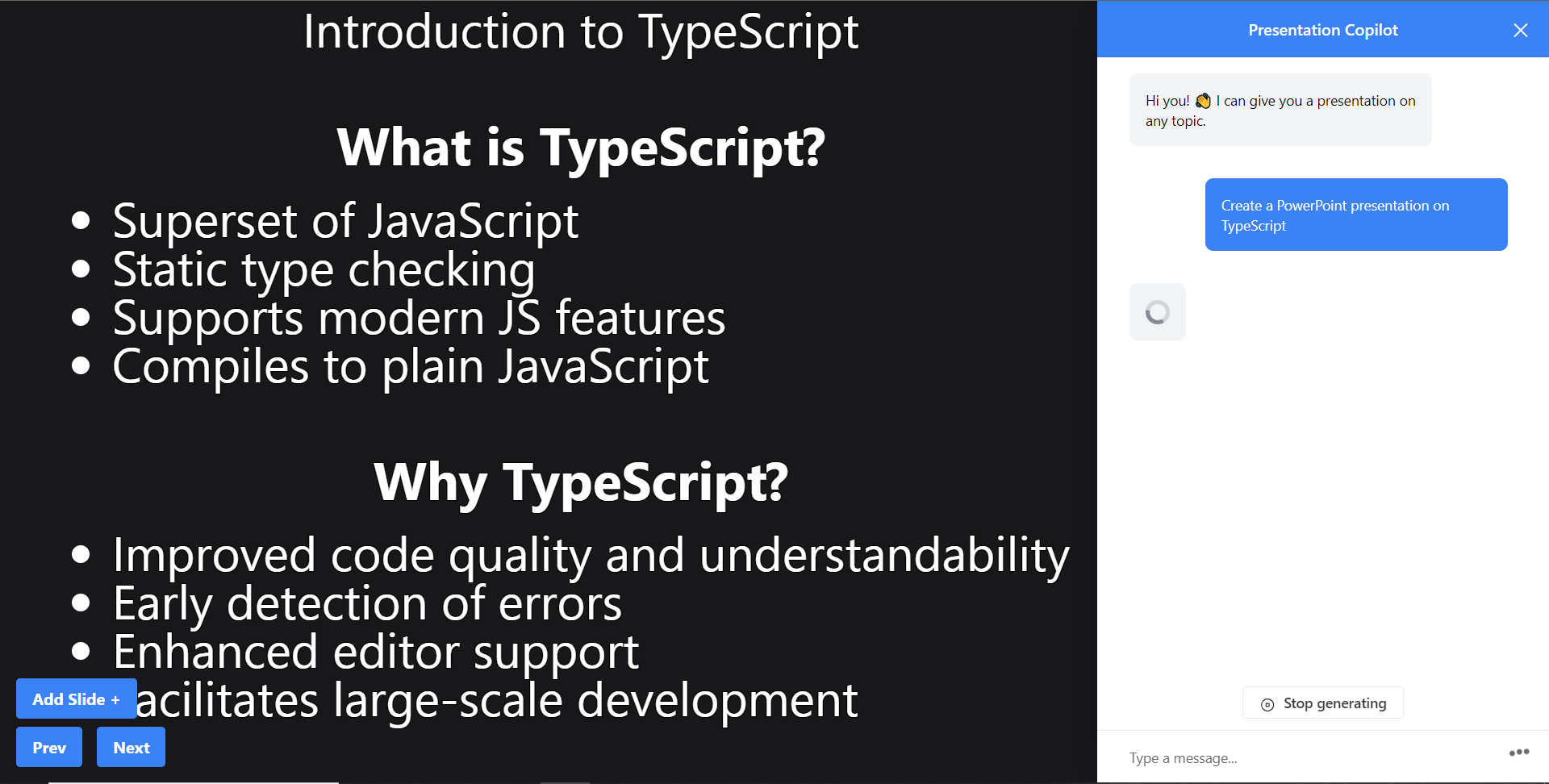 建立圖像生成功能 -------- 步驟1:在present.tsx檔案中,新增一個名為backgroundImage的新屬性來鍵入介面Slide,如下所示。 ``` // Define slide interface interface Slide { title: string; content: string; backgroundImage: string; } ``` 步驟 2:更新 useMakeCopilotActionable 掛鉤以產生 PowerPoint 簡報投影片的圖片。 ``` useMakeCopilotActionable( { name: "createPowerPointSlides", description: "create slides for a powerpoint presentation. Call this function multiple times to present multiple slides.", argumentAnnotations: [ { name: "slideTitle", type: "string", description: "The topic to display in the presentation slide. Use simple markdown to outline your speech, like a headline.", required: true, }, { name: "content", type: "string", description: "The content to display in the presentation slide. Use simple markdown to outline your speech, like lists, paragraphs, etc.", required: true }, { name: "backgroundImage", type: "string", description: "What to display in the background of the slide (i.e. 'dog' or 'house').", required: true, }, { name: "speech", type: "string", description: "An informative speech about the current slide.", required: true, }, ], implementation: async (newSlideTitle, newSlideContent, newSlideBackgroundImage, speech) => { const newSlide: Slide = { title: newSlideTitle, content: newSlideContent, backgroundImage: newSlideBackgroundImage }; const updatedSlides = [...allSlides, newSlide]; setAllSlides(updatedSlides); setCurrentSlideIndex(updatedSlides.length - 1); const encodedText = encodeURIComponent(speech); const url = `/api/tts?text=${encodedText}`; globalAudio.src = url; await globalAudio.play(); await new Promise<void>((resolve) => { globalAudio.onended = function () { resolve(); }; }); await new Promise((resolve) => setTimeout(resolve, 500)); }, }, [], ); ``` 步驟 2:更新 addSlide 函數以產生新的 PowerPoint 簡報投影片的圖片。 **步驟3:**更新`slide.tsx`檔案中的`Slide`元件以透過[`unsplash.com`](http://unsplash.com/)產生映像 ``` // Add new slide function const addSlide = new CopilotTask({ instructions: "create a new slide", functions: [ { name: "newSlide", description: "Make a new slide related to the current topic.", argumentAnnotations: [ { name: "title", type: "string", description:"The title to display in the presentation slide.", required: true, }, { name: "content", type: "string", description:"The title to display in the presentation slide.", required: true, }, { name: "backgroundImage", type: "string", description: "What to display in the background of the slide (i.e. 'dog' or 'house').", required: true, }, { name: "speech", type: "string", description: "An informative speech about the current slide.", required: true, }, ], implementation: async (newSlideTitle, newSlideContent, newSlideBackgroundImage, speech) => { const newSlide: Slide = { title: newSlideTitle, content: newSlideContent, backgroundImage: newSlideBackgroundImage }; const updatedSlides = [...allSlides, newSlide]; setAllSlides(updatedSlides); setCurrentSlideIndex(updatedSlides.length - 1); const encodedText = encodeURIComponent(speech); const url = `/api/tts?text=${encodedText}`; globalAudio.src = url; await globalAudio.play(); await new Promise<void>((resolve) => { globalAudio.onended = function () { resolve(); }; }); await new Promise((resolve) => setTimeout(resolve, 500)); }, } ] }); ``` 步驟 3:更新 displayCurrentSlide 函數以將背景圖像新增至 PowerPoint 簡報投影片中。 ``` // Display current slide const displayCurrentSlide = () => { const slide = allSlides[currentSlideIndex]; return slide ? ( <div className="h-screen flex flex-col justify-center items-center text-5xl text-white bg-cover bg-center bg-no-repeat p-10 text-center" style={{ backgroundImage: 'url("https://source.unsplash.com/featured/?' + encodeURIComponent(allSlides[currentSlideIndex].backgroundImage) + '")', textShadow: "1px 1px 0 #000, -1px -1px 0 #000, 1px -1px 0 #000, -1px 1px 0 #000", }} > <Markdown className="markdown">{slide.title}</Markdown> <Markdown className="markdown">{slide.content}</Markdown> </div> ) : ( <div className="h-screen flex flex-col justify-center items-center text-5xl text-white bg-cover bg-center bg-no-repeat p-10 text-center"> No Slide To Display </div> ); }; ``` **步驟 4:**前往 Web 應用程式,您應該會看到背景圖像已新增至 PowerPoint 投影片中。 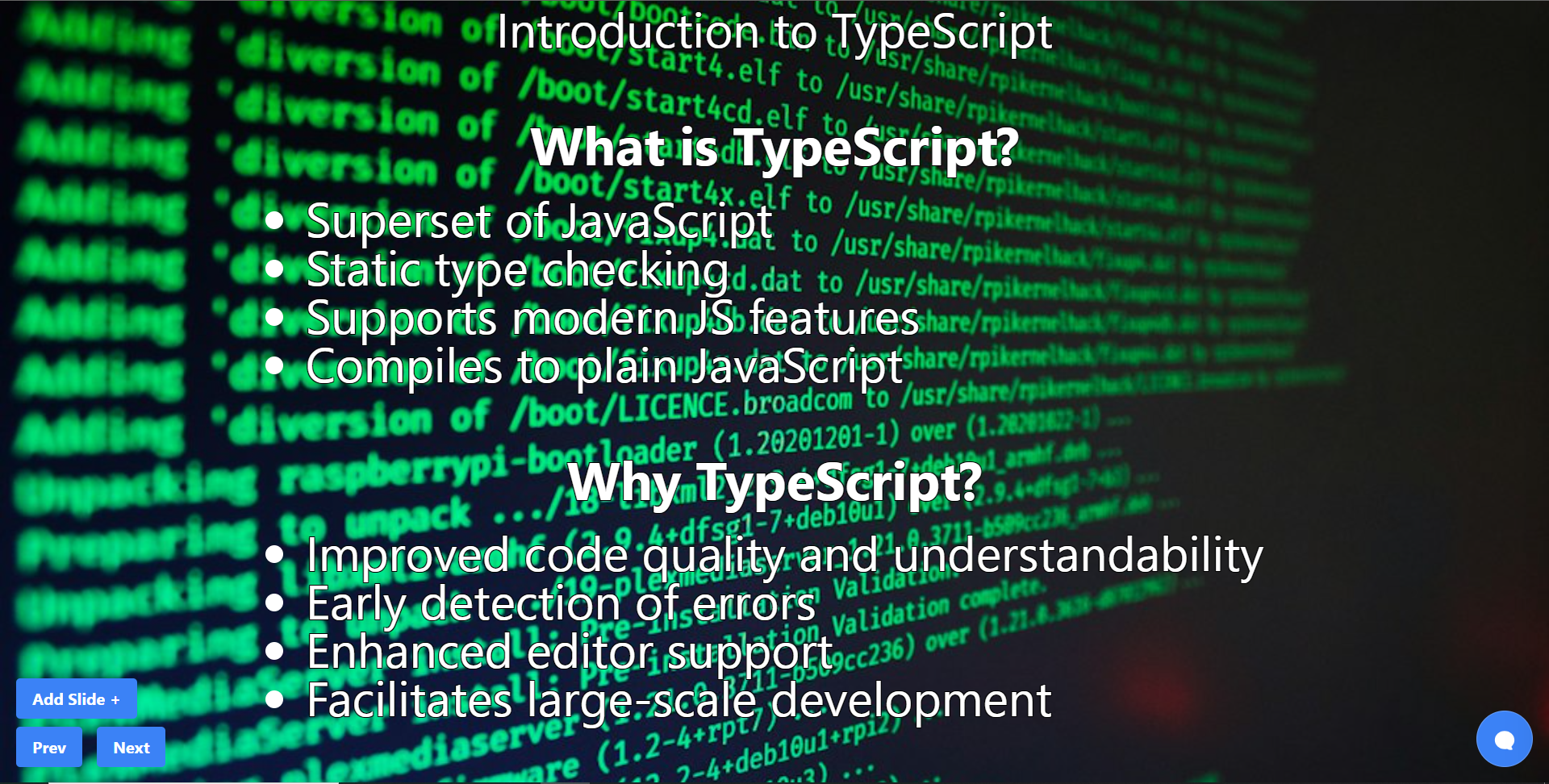 結論 -- 總而言之,您可以使用 CopilotKit 建立應用內 AI 聊天機器人,該機器人可以查看當前應用程式狀態並在應用程式內執行操作。 AI 聊天機器人可以與您的應用程式前端、後端和第三方服務對話。 筆記: - 告訴聊天機器人要寫什麼 - 建立包含文字、圖片和自動語音的幻燈片。 這是全部實作程式碼: https://github.com/CopilotKit/CopilotKit/blob/mme/tools/CopilotKit/examples/next-openai/src/app/helloworld/page.tsx 你可以拿程式碼寫文章,一定要截圖。 確保按照邏輯實現的順序寫文章: - 首先,外部 React 元件( `page.tsx`中的`HelloWorld`元件) ``` - cover `CopilotKit` and `CopliotSidebar` ``` - 然後覆蓋`Presentation`反應元件而不加入 Copilot 功能 ``` - include the `Slide` react component ``` - 最後,在建立基本的 React 應用程式後,加入描述 Copilot 特定功能的部分( `useMakeCopilotReadable`和`useMakeCopilotActionable` ) - 最後,介紹生成音訊+影像的函數。保持描述非常簡短,只需說“我們透過瀏覽器audio-gen API產生音訊”和“我們透過[`unsplash.com`](http://unsplash.com/)產生圖像” 執行演示: - 請參閱文件/貢獻指南,以了解如何執行 CopilotKit 儲存庫中包含的範例應用程式:https://docs.copilotkit.ai/contribute/quickstart-contribute - 執行 - 前往`/helloworld`頁面 --- 結論 -- 總而言之,您可以使用 CopilotKit 建立應用內 AI 聊天機器人,該機器人可以查看當前應用程式狀態並在應用程式內執行操作。 AI 聊天機器人可以與您的應用程式前端、後端和第三方服務對話。 對於完整的源程式碼: https://github.com/TheGreatBonnie/aipoweredpresentation 感謝@theGreatBonnie 在本文中所做的出色工作。 別忘了...  {% cta https://github.com/CopilotKit/CopilotKit %} Star CopilotKit ⭐️ {% endcta %} --- 原文出處:https://dev.to/copilotkit/how-to-build-ai-powered-powerpoint-app-nextjs-openai-copilotkit-ji2
介紹 -- 2024 年即將到來,我們努力為新的一年做計劃,思考來年我們可以做或學到的事情。現在是在新的一年中尋找要學習的框架、了解它們的功能並找出它們的特別之處的最佳時機。我們查看了 2023 年[JS 新星](https://risingstars.js.org/2023/en)名單以獲取指導,並試圖盡可能客觀。**對於每個特色框架,我們重點介紹了它們最大的優點,以便您可以了解它們的優點以及哪些可以讓您親自嘗試!** HTMX - 回到基礎🚲 ------------ 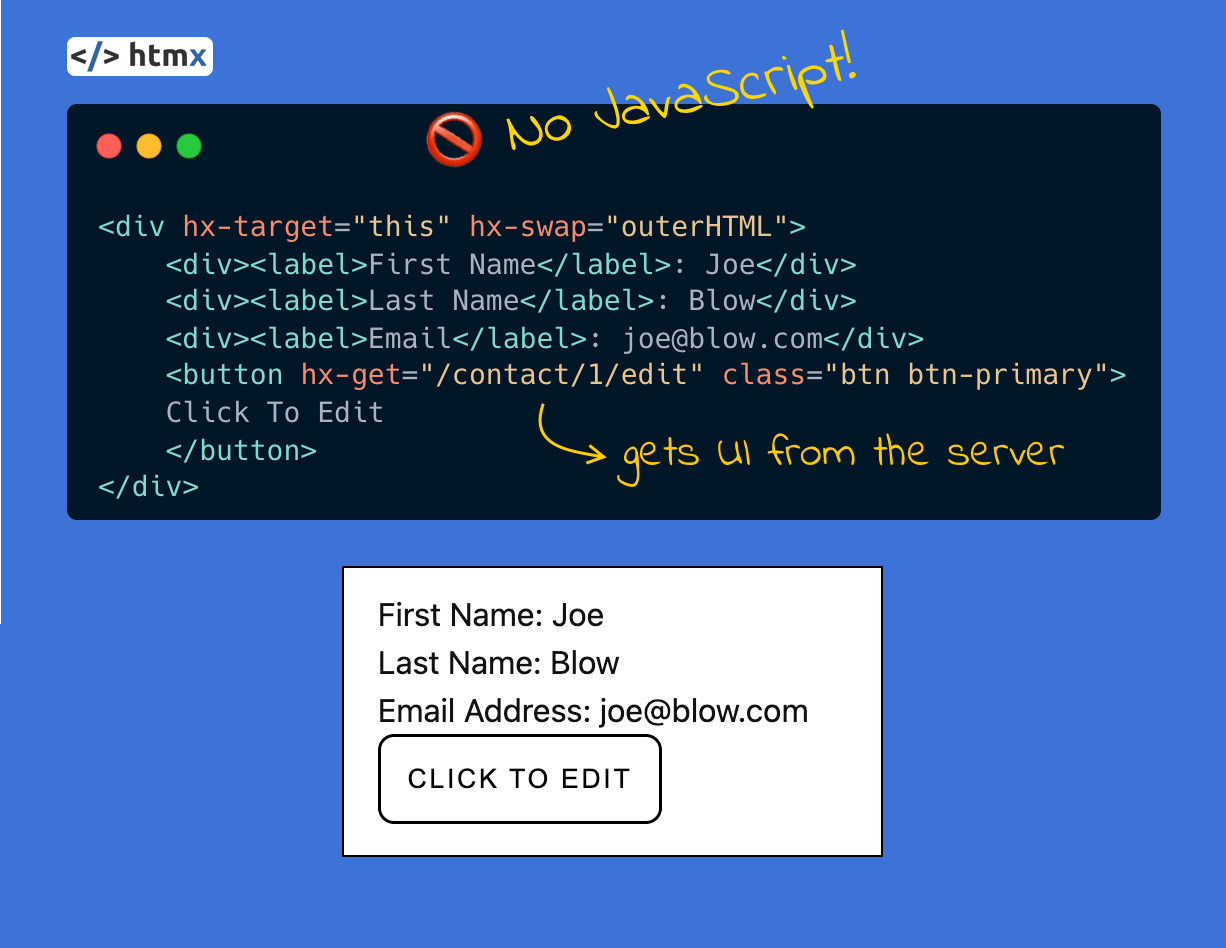 這是給誰的: - 你想少寫 JavaScript - 您想要更簡單、以超媒體為中心的程式碼 如果不從那些自詡為和平前端庫的東西入手,那將是一種罪。 HTMX 在 2023 年人氣飆升,在過去一年中獲得了大部分 GitHub 明星。 HTMX 不是普通的 JS 框架。如果您在[HTMX](https://htmx.org/)工作,您將把大部分時間花在超媒體世界中,與我們通常以 JS 為重的現代 Web 開發觀點相比,您會以完全不同的眼光來看待 Web 開發。 **HTMX 利用 HATEOAS(超媒體作為應用程式狀態引擎)概念的力量,使開發人員能夠直接從 HTML 存取瀏覽器功能,而不是使用 Javascript** 。 這也證明您可以透過發布精彩的迷因並將口碑作為主要行銷來源來獲得知名度和認可。不僅如此,你還可以成為HTMX的[CEO](https://htmx.ceo/) !它吸引了許多開發人員嘗試這種建立網站的方法並重新思考他們當前的做法。所有這些都讓 2024 年該圖書館的未來變得令人興奮。 Wasp - 全棧,開箱即用🚀 ---------------  這是給誰的: - 您想快速發布全端應用程式 - 您希望在一個出色的一體化解決方案中繼續使用 React 和 Node.js,而不需要手動選擇堆疊的每個部分 - 您想要一個用於 React 和 Node.js 的免費 saas 模板,其中所有內容都已預先配置 - [Open SaaS](https://github.com/wasp-lang/open-saas) 對於那些希望該工具簡單輕鬆地完全控制其堆疊的人來說,別再猶豫了! [Wasp](https://github.com/wasp-lang/wasp)是一個固執己見的全端框架,它利用其編譯器以快速、簡單的方式為您的應用程式建立資料庫、後端和前端。**它使用 React、Node.js 和 Prisma,這些都是全端 Web 開發人員正在使用的最著名的工具。** Wasp 的核心是 main.wasp 文件,它可以滿足您的大多數需求。在那裡,您可以定義: - 全端認證 - 資料庫結構定義 - 非同步作業,無需額外的基礎設施 - 部署簡單且靈活 - 全端類型安全 - 電子郵件發送(Sendgrid、MailGun、SMTP 伺服器...) - 和更多… 最酷的事?在您的 Wasp 應用程式完成編譯步驟後,輸出是標準的 React + Vite 前端、Node.js 後端和 PostgreSQL 資料庫。從那裡,您可以使用單一命令輕鬆地將所有內容部署到[Fly.io](http://Fly.io)等。 儘管有些人可能認為 Wasp 固執己見的立場是一件消極的事情,但它是 Wasp 眾多全端功能背後的驅動力。借助 Wasp,為單一開發人員或小型團隊啟動全端專案變得更加容易,特別是如果您使用預製模板或[OpenSaaS](https://github.com/wasp-lang/open-saas)之一作為 SaaS 啟動器。由於專案的核心定義明確,因此很容易開始專案,並有可能在幾天內建立您自己的全端 SaaS! **同樣很酷的是,大多數 Web 開發人員的大部分現有知識仍然適用於此,因為 Wasp 所使用的技術已經建立**。 Solid.js - 一流的反應性 ↔️ -------------------- 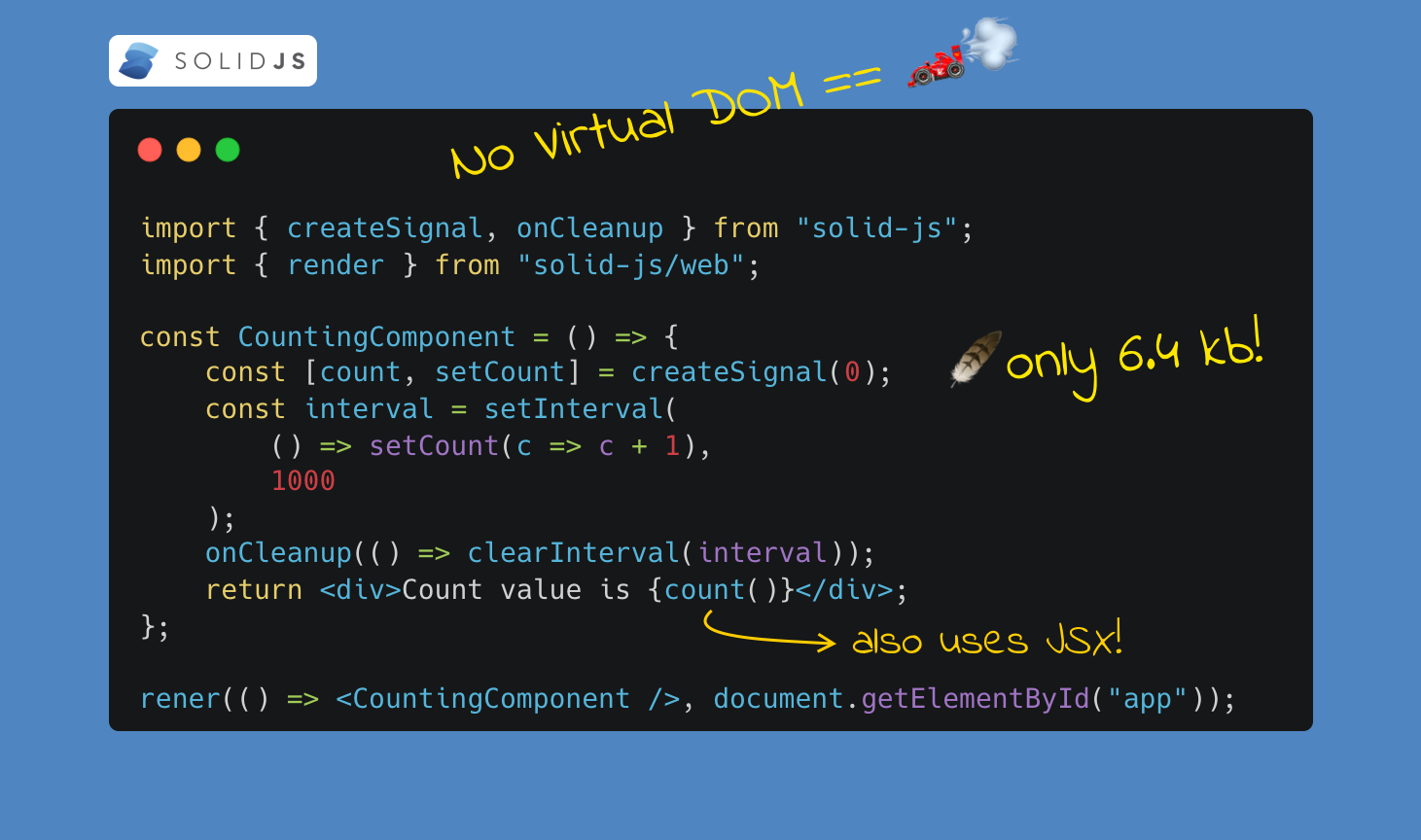 這是給誰的: - 如果你想要高反應性程式碼 - 現有的 React 開發人員想要嘗試一些低學習曲線的高效能東西 [Solid.js](https://www.solidjs.com/)是一個非常高效能的 Web 框架,與 React 有一些相似之處。例如,兩者都使用 JSX,利用基於函數的元件方法,**但它不使用 Virtual DOM,而是將程式碼轉換為 vanilla JS** 。儘管如此,它更出名的是利用信號、備忘錄和效果來實現細粒度反應的方法。儘管如此,訊號仍然是 Solid 中最簡單和最著名的原語。它們包含值及其 getter 和 setter 函數,允許框架根據需要在 DOM 中的確切位置觀察和更新更改,這與 React 不同,React 會重新渲染整個元件。 Solid.js 不僅使用 JSX,還對其進行了增強。它提供了一些很酷的新功能,例如 Show 元件,它可以啟用 JSX 元素的條件渲染,而 For 元件則允許更輕鬆地迭代 JSX 中的集合。另一個重要的事情是,它還有一個名為Solid Start(目前處於測試階段)的元框架,使用戶能夠根據自己的偏好,使用基於文件的路由、操作、API 路由和中間件等,以不同的方式呈現應用程式特徵。 Astro - 靜態網站之王👑 --------------- 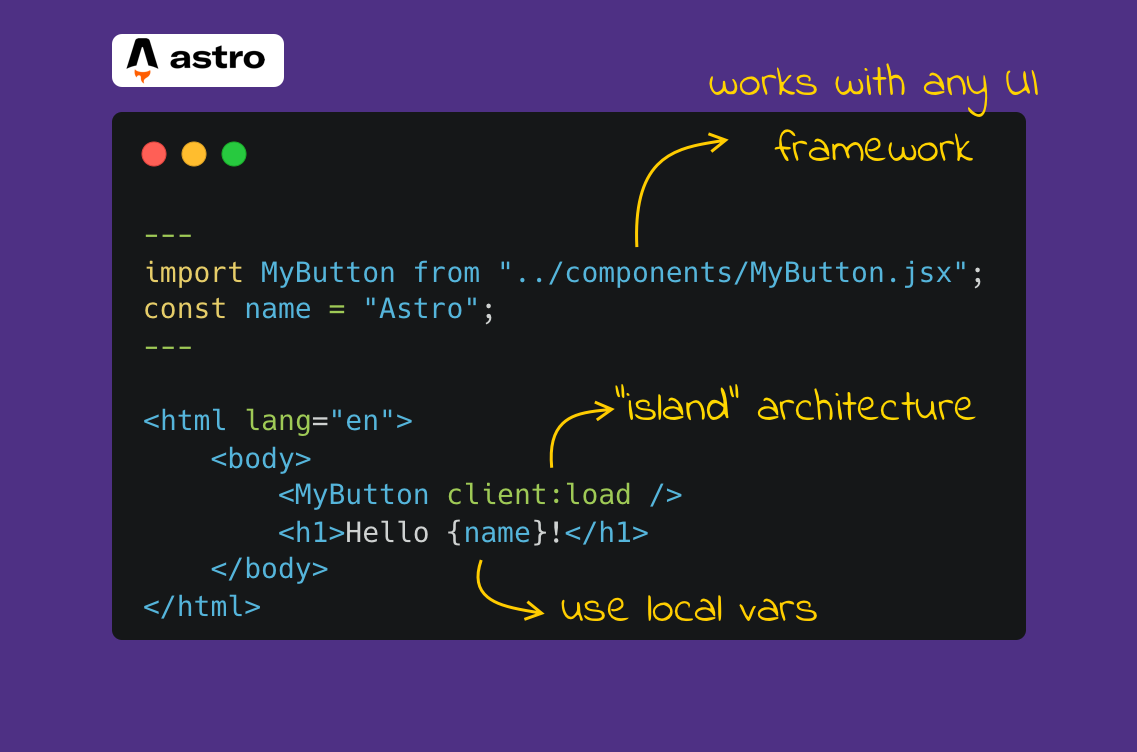 這是給誰的: - 如果您想要一款適用於部落格、CMS 網站的優秀工具 - 一個可以整合其他函式庫和框架的框架 如果您在 2023 年建立了一個內容驅動的網站,那麼您很有可能使用[Astro](https://astro.build/)作為您選擇的框架來實現它! Astro 是另一個使用不同架構概念來脫穎而出的框架。對 Astro 來說,它是島嶼建築。在 Astro 的上下文中,島嶼是頁面上的任何互動式 UI 元件,從靜態內容的海洋中脫穎而出。一個頁面可以有任意數量的島嶼,因為它們彼此隔離執行,但它們也可以共享狀態並相互通信,這非常有用。 Astro 的另一個有趣的事情是,他們的方法使用戶能夠使用[不同的前端框架,](https://docs.astro.build/en/guides/integrations-guide/)例如 React、Vue、Solid 來製作他們的網站。因此,開發人員可以輕鬆地根據他們目前的知識建立網站,並利用可以整合到 Astro 網站中的現有元件。 Svelte - 簡單而有效🎯 --------------- 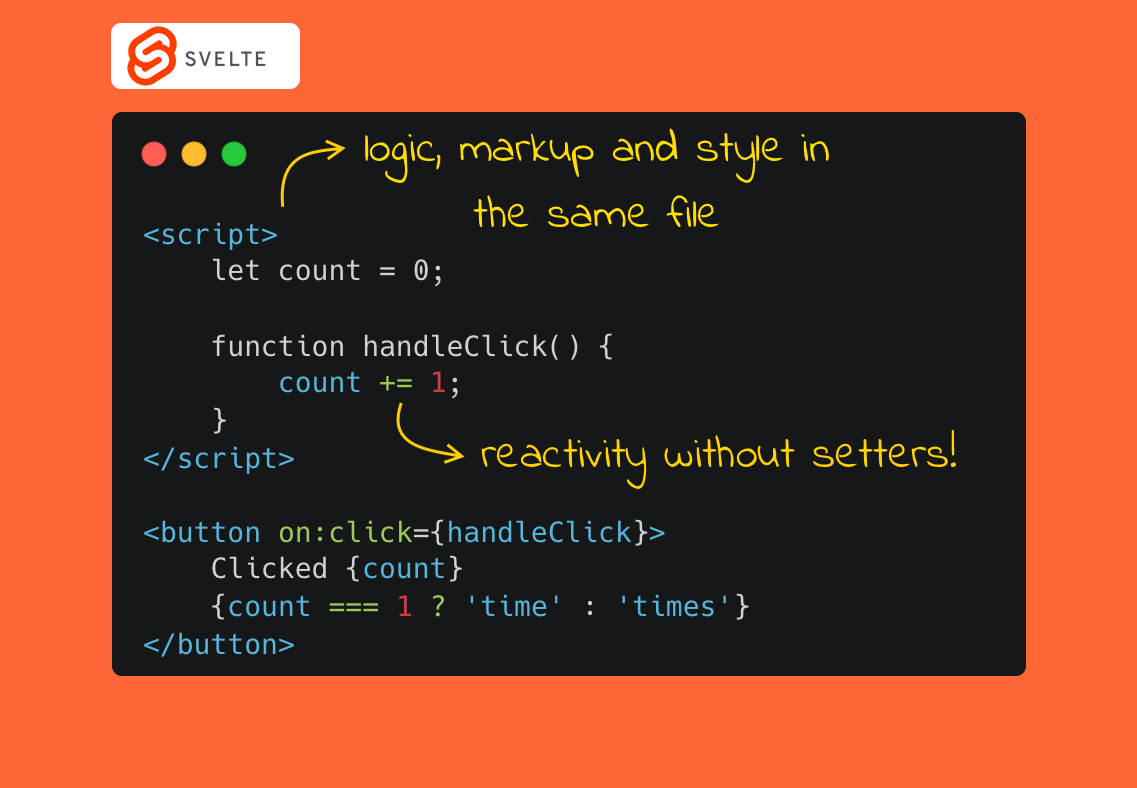 這是給誰的: - 你想要一個容易學習的框架 - 編寫簡單且程式碼執行速度快 **[Svelte](https://www.notion.so/Web-frameworks-we-are-most-excited-for-in-2024-35cfadc282ab4d28904b0fe4adf231d4?pvs=21)是另一個框架,它試圖透過盡可能簡單和對初學者友好來簡化和加速 Web 開發**。這是一個非常簡單的學習框架,因為要擁有響應式屬性,您必須聲明它並在 HTML 模板中使用它。每當 Javascript 中的值以程式設計方式更新時(例如,透過觸發 onClick 事件按鈕),它將反映在 UI 上,反之亦然。 Svelte 的下一步將是引入符文。 Runes 將成為 Svelte 處理反應性的方式,以便更輕鬆地處理大型應用程式。類似於 Solid.js 的訊號,符文提供了一種透過使用類似函數的語句來利用應用程式的反應狀態的直接方法。與 Svelte 目前的工作方式相比,它們將允許使用者精確定義整個腳本的哪些部分是反應性的,以便元件具有更高的效能。與 Solid 和 Solid Start 類似,Svelte 也有自己的框架,稱為 SvelteKit。 SvelteKit 為使用者提供了一種快速啟動由 Vite 支援的 Svelte 應用程式的方法。它提供路由器、建置優化、不同的渲染和預渲染方式、影像優化等。 Qwik - 很快🚤 ---------- 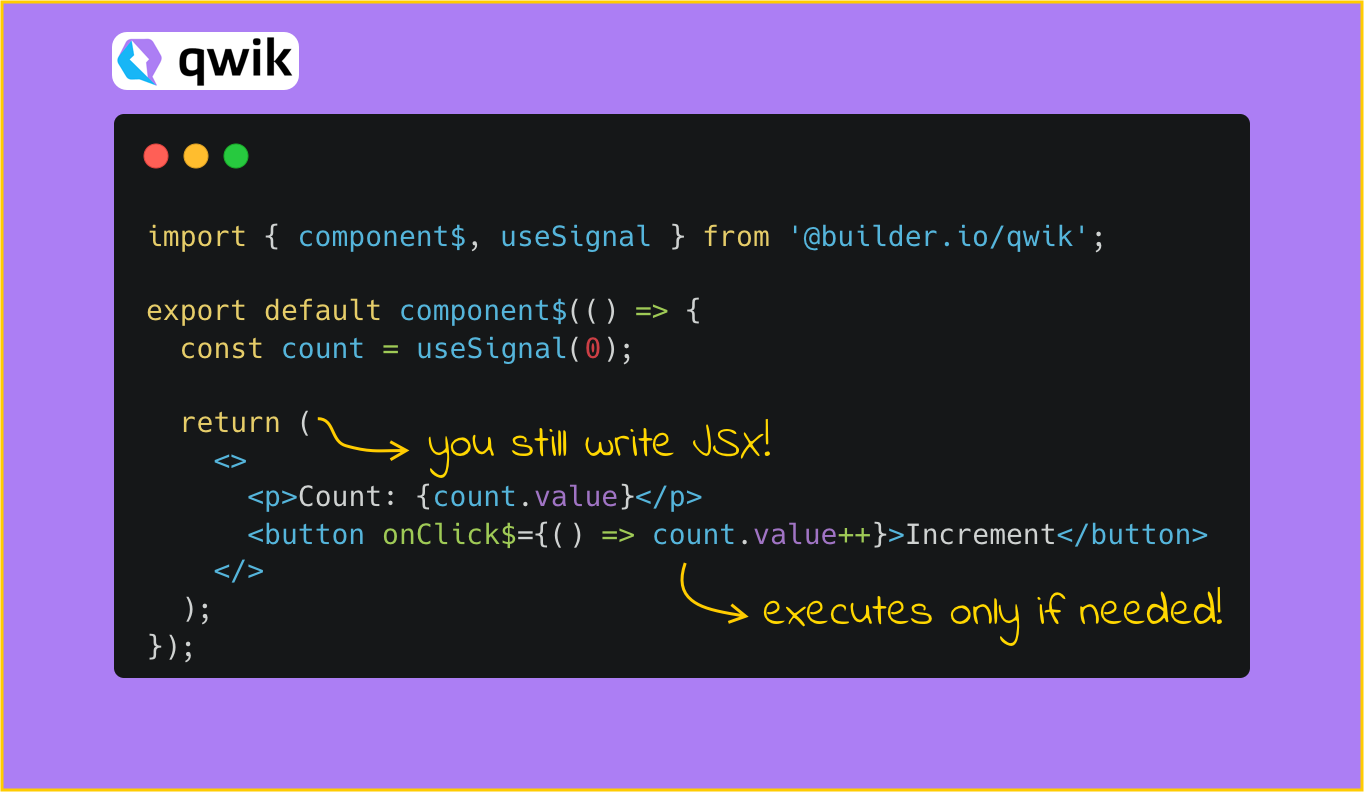 這是給誰的: - 如果您想要一個高效能的網頁應用程式 - 現有的 React 開發人員想要嘗試一些低學習曲線的高效能東西 此列表中最後但並非最不重要的框架是[Qwik](https://qwik.builder.io/) 。 Qwik 是另一個利用 JSX 和功能元件的框架,類似於 Solid.js 的做法,為基於 React 的開發人員提供熟悉的環境,以便盡快上手。顧名思義, **Qwik 的主要重點是實現應用程式的最高效能和執行速度**。 Qwik 透過利用可恢復性的概念來實現其速度。簡而言之,可恢復性是基於暫停伺服器上的執行並在客戶端上恢復執行的思想,而無需重播和下載所有應用程式邏輯。這種行為是透過延遲 JavaScript 程式碼的執行和下載來實現的,除非有必要處理用戶交互,這是一件很棒的事情。它既可以提高整體速度,又可以將頻寬量降低到絕對最小值,從而實現近乎即時的載入。 結論 -- 我們提到的所有這些框架和庫之間最大的共同點是熟悉度。**每個人都尋求以一種基於他們當前知識的方式來接觸潛在的新開發人員,而不是做一些全新的事情,這是一個非常酷的概念**。 當然,這裡可能還有更多未在全文中提及的函式庫和框架,但至少值得一提。例如,我們有 Angular,除了新的徽標和文件之外,它還包括訊號和新的控制流。還有 Remix 新增了對 Vite、React Server Components 和新的 Remix SPA 模式的支援。最後,我們不能忘記 Next.js,它在過去幾年中成為了 React 開發人員的預設選項,為新的 React 功能鋪平了道路。 --- 原文出處:https://dev.to/wasp/web-frameworks-we-are-most-excited-for-in-2024-4d15
你的轉職路上,還缺少一份自學作業包!寫完這幾包,直接拿作品去面試上班!
本論壇另有附設一個 LINE 新手發問&交流群組!歡迎加入討論!